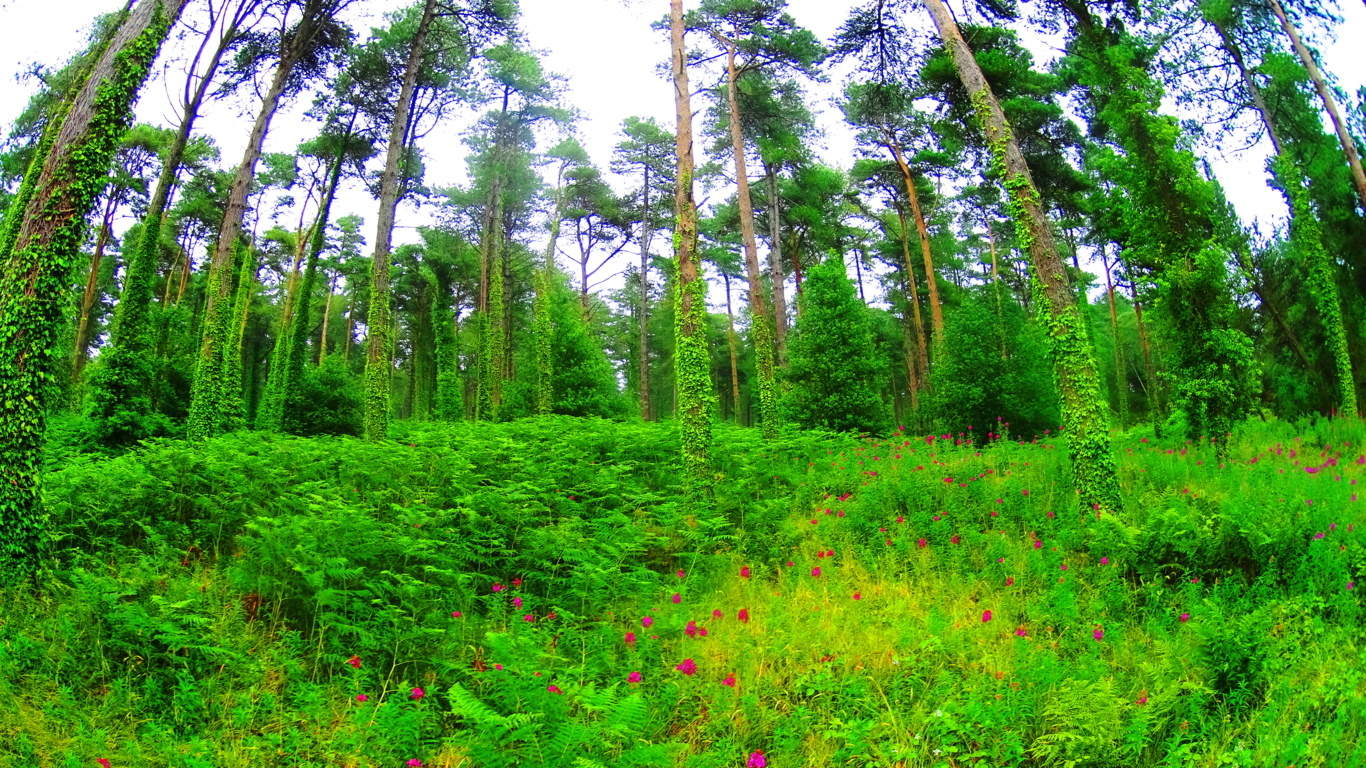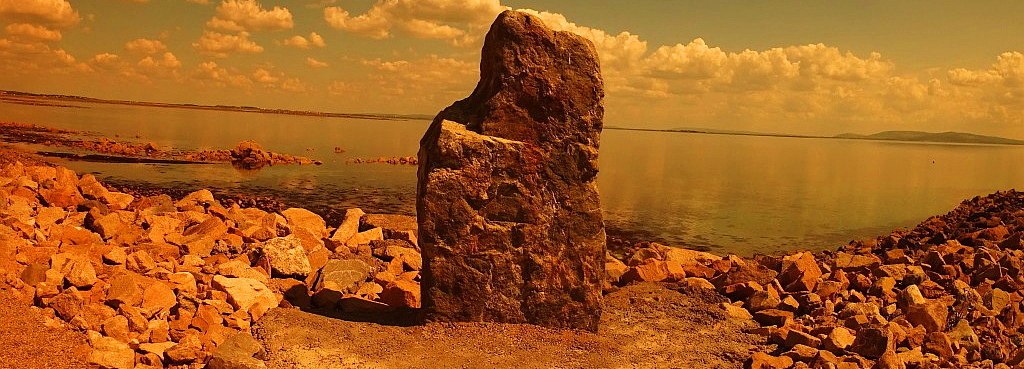New Grange
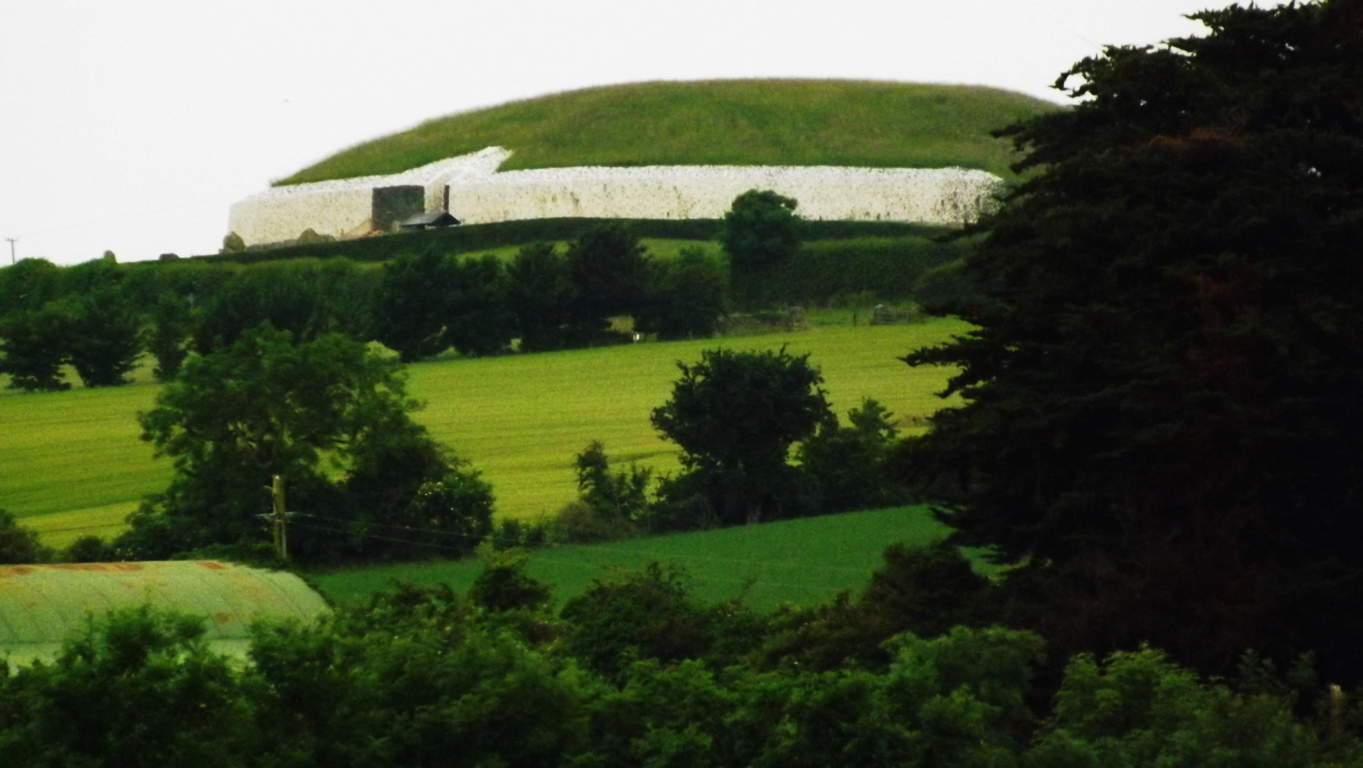
Location: County Meath, Ireland
Note: Every so often, with a little luck and determination, you come across things that give cosmic pause. This article is dedicated to those rare moments rather than the beautiful trails to be found in Ireland that are usually reviewed. Hiking starts to take on a next-level significance when you stumble upon practically impossible things. Sometimes they are small things, like perfectly circular concentric rings imprinted on a stone, high above the Black Valley in Killarney.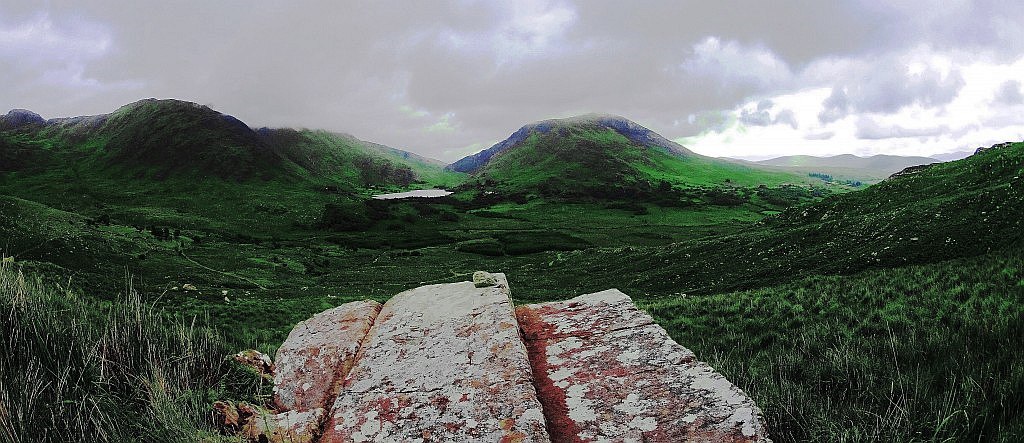 (Image/Below) Sometimes they are jaw-dropping big things, like the balancing Capstone on a giant-sized ‘Proleek Dolmen’ on the boarders of the Mourne Mountains, north of Dublin. (Image/Below) This Dolmen is one of the most massive and well hidden miraculous secrets in all of Ireland, with a 40 ton capstone standing at roughly 15 feet high! Incredible. And yet this pales in comparison to the temple at New Grange.
(Image/Below) Sometimes they are jaw-dropping big things, like the balancing Capstone on a giant-sized ‘Proleek Dolmen’ on the boarders of the Mourne Mountains, north of Dublin. (Image/Below) This Dolmen is one of the most massive and well hidden miraculous secrets in all of Ireland, with a 40 ton capstone standing at roughly 15 feet high! Incredible. And yet this pales in comparison to the temple at New Grange.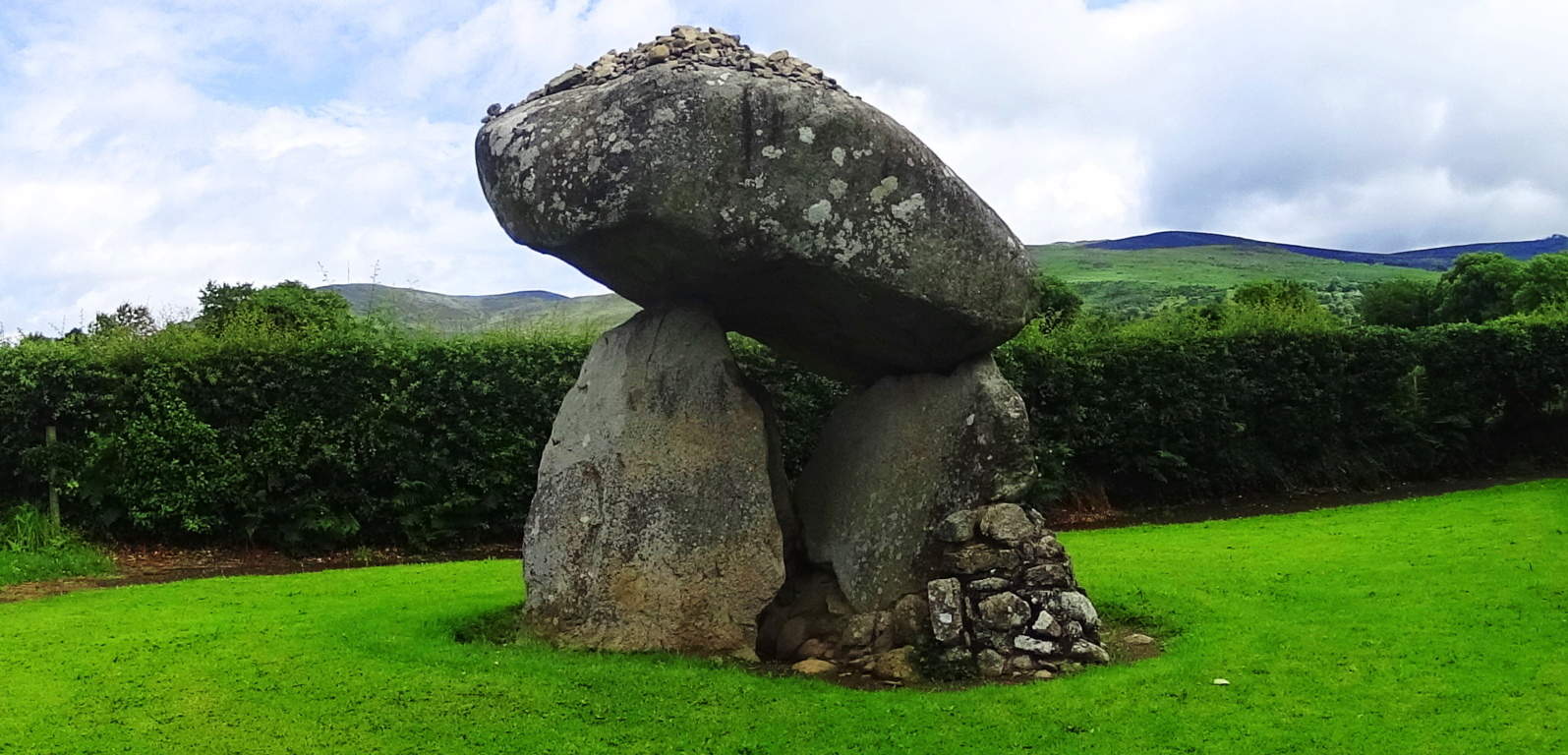 The more you look at that specific area north of Dublin, the more amazing mystery you will find. Just as Egypt’s mystical culture was birthed out of the Nile river, and Babylon’s from the Tigris and Euphrates, Ireland’s incredible spiritual origins were born along the Boyne-River-Valley. Although the Boyne-River-Valley culture was most likely not featured in your mandatory History 2.0 undergraduate course requirements, it definitely should’ve been. Egypt has the Great Pyramid; Babylon had it’s great Tower, and Ireland has the incomprehensible, magical, mystical, temple of New Grange, literally tucked into a curvature above the Boyne River.(Image/Below) New Grange also sponsors other megalithic masterpieces like Knowth, which is an incredible megalithic chamber also located on these grounds.
The more you look at that specific area north of Dublin, the more amazing mystery you will find. Just as Egypt’s mystical culture was birthed out of the Nile river, and Babylon’s from the Tigris and Euphrates, Ireland’s incredible spiritual origins were born along the Boyne-River-Valley. Although the Boyne-River-Valley culture was most likely not featured in your mandatory History 2.0 undergraduate course requirements, it definitely should’ve been. Egypt has the Great Pyramid; Babylon had it’s great Tower, and Ireland has the incomprehensible, magical, mystical, temple of New Grange, literally tucked into a curvature above the Boyne River.(Image/Below) New Grange also sponsors other megalithic masterpieces like Knowth, which is an incredible megalithic chamber also located on these grounds. 
The hedgy river-road that runs along the Boyne River from the hamlet of Rosnaree, just a mile south of New Grange, is the best, and only way to get there. New Grange sits on the highest elevation above the solitary hedge rows and roads without names. You can walk these practically fictional looking hedge-row-paths for days if you are looking to get some trekking in before seeing the Temple, but beware, it would be easy to get lost in this green labyrinth of fields and cart-roads with no names, so make sure you have your device on you to at least navigate at all times. 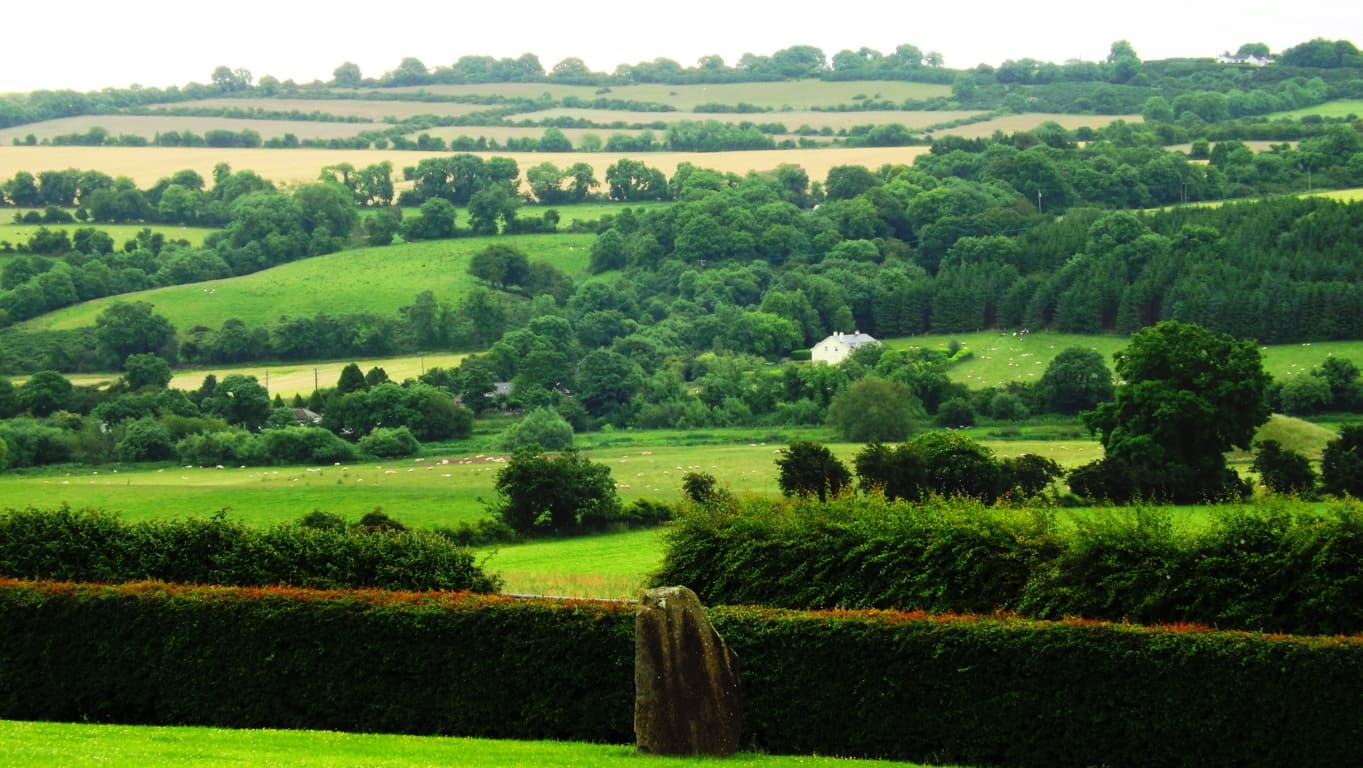
If you are ready to go directly to the Monument go to the Bru-na-Boinne Vistors Center along Staleen Road. Here you will find a ticketed bus line which will take you there. The ride is only 10 minutes, through the hedgy maze. When you arrive at the top of the hill you will be looking at nothing less than a Temple which has stood 2000 years before Moses climbed Mount Sinai. New Grange is older than Stonehenge, The Great Pyramid, and The Parthenon, which puts it in the running for the the oldest Temple on Earth. 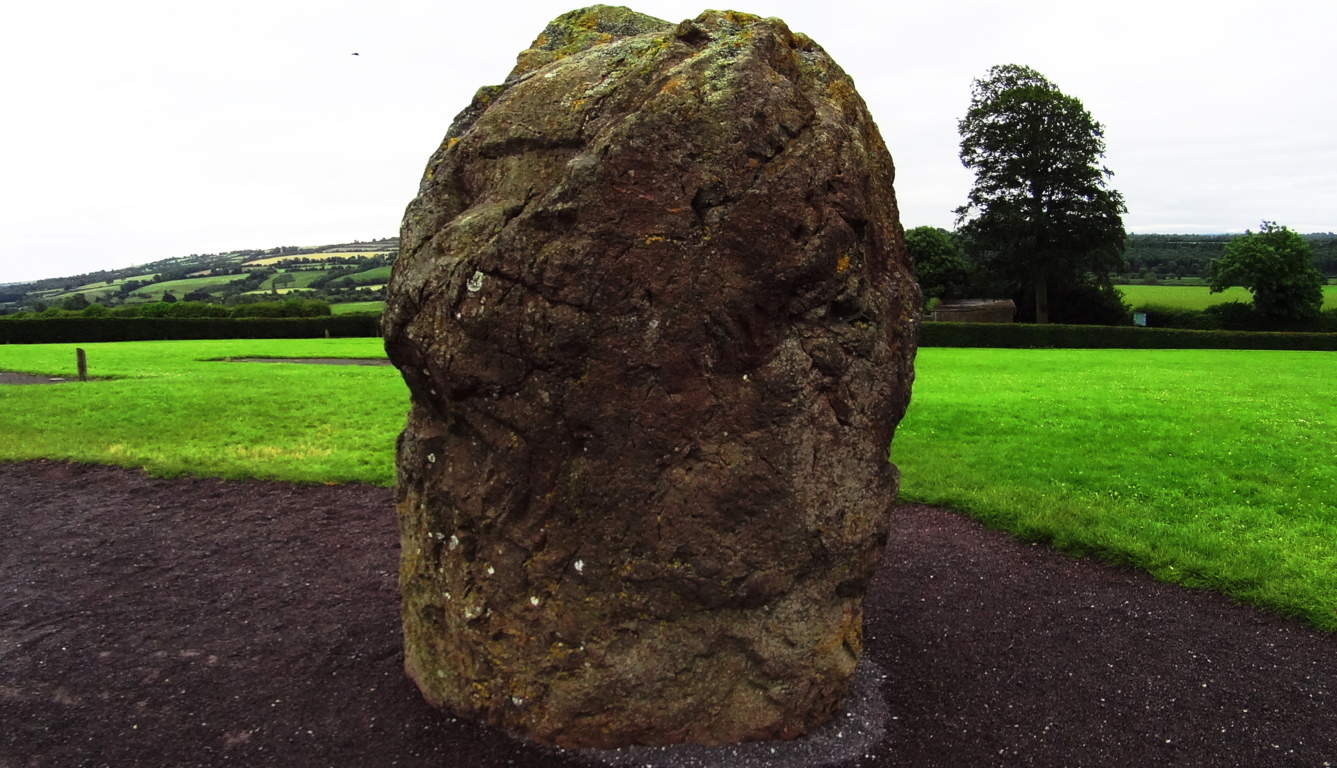 That’s quite a title. The way history has been explained in recent years, you might think that the oldest temple on Earth would look fairly primitive, as human history is generally thought to have gone from basic abilities to very complex ones, but the actual fact appears to be the utter opposite. The construction of New Grange is a study of the highest levels of engineering and accomplishment, bordering on the impossible for a culture not yet capable of using metal tools!? This is a circular mound centered on a main-chamber pathway constructed of roughly 34 level megalithic slabs, each weighing roughly 10 tons (20,000 pounds). Imagine 30 Proleek Dolmens lined perfectly together! Some of the slabs came all the way from the Mourne Mountains to the north, as well as other far off sacred zones. These facts alone start the mind reeling on the impossible story of the stones, which were moved from afar, and finally fit in dry-laid corbel fashion with such perfection that the light of the Solstices shines straight to the heart of the chamber two times a year. This Temple is a celestially connected megalithic miracle. It is surrounded by several massive Standing Stones which are roughly 15-20 tons, and most of them are over 8 feet in height. Moving these stones alone, to what is the highest elevation in this small River Valley, is hard to imagine.
That’s quite a title. The way history has been explained in recent years, you might think that the oldest temple on Earth would look fairly primitive, as human history is generally thought to have gone from basic abilities to very complex ones, but the actual fact appears to be the utter opposite. The construction of New Grange is a study of the highest levels of engineering and accomplishment, bordering on the impossible for a culture not yet capable of using metal tools!? This is a circular mound centered on a main-chamber pathway constructed of roughly 34 level megalithic slabs, each weighing roughly 10 tons (20,000 pounds). Imagine 30 Proleek Dolmens lined perfectly together! Some of the slabs came all the way from the Mourne Mountains to the north, as well as other far off sacred zones. These facts alone start the mind reeling on the impossible story of the stones, which were moved from afar, and finally fit in dry-laid corbel fashion with such perfection that the light of the Solstices shines straight to the heart of the chamber two times a year. This Temple is a celestially connected megalithic miracle. It is surrounded by several massive Standing Stones which are roughly 15-20 tons, and most of them are over 8 feet in height. Moving these stones alone, to what is the highest elevation in this small River Valley, is hard to imagine. 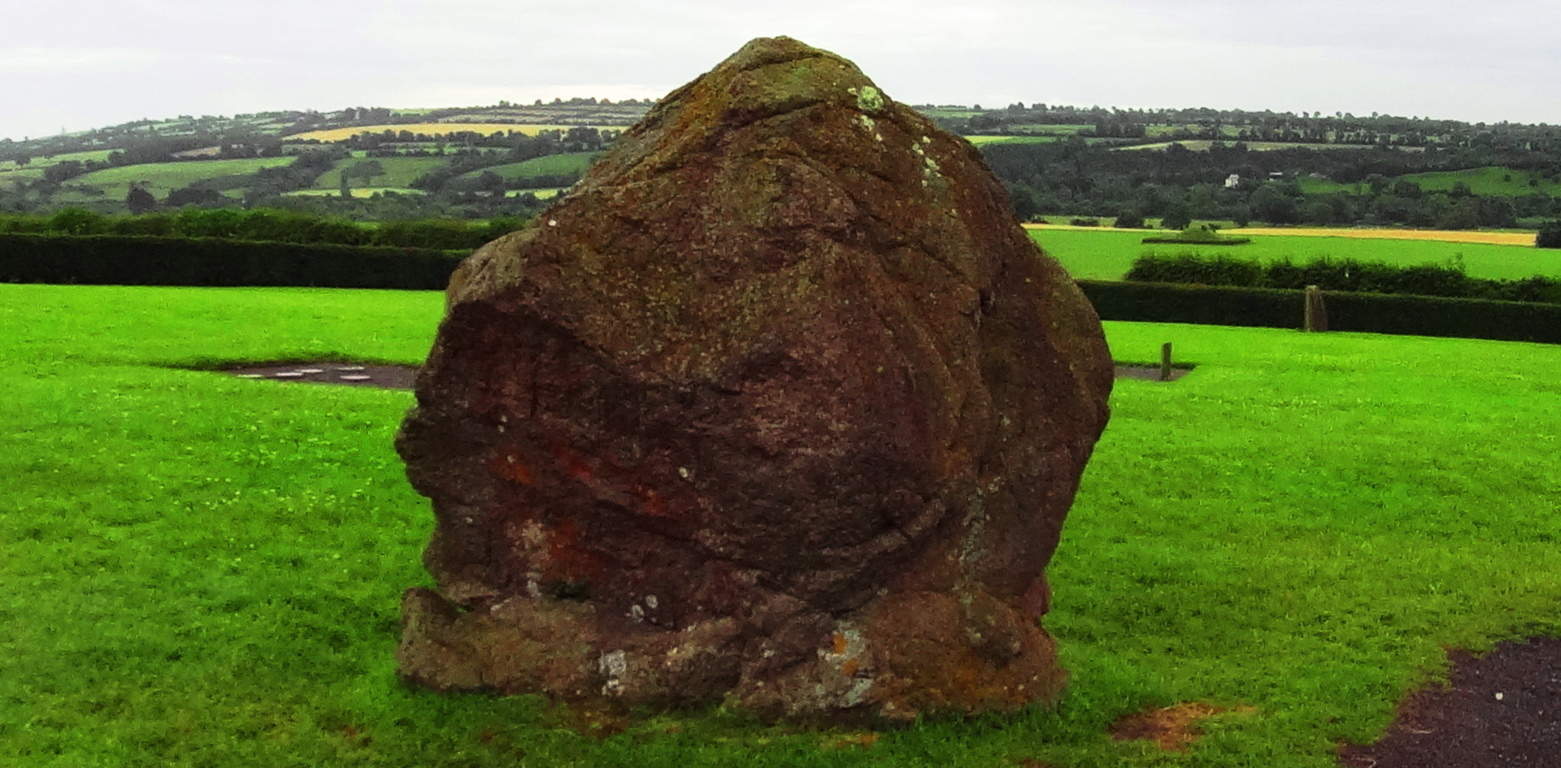 These Standing Stones are territorial markers, and once upon a time, if you passed by these Standing Stones without permission it would certainly have cost you your life. The larger the Standing Stone, the more serious the warning, and sacred the place. In this regard, you will realize that you are standing on truly holy ground.
These Standing Stones are territorial markers, and once upon a time, if you passed by these Standing Stones without permission it would certainly have cost you your life. The larger the Standing Stone, the more serious the warning, and sacred the place. In this regard, you will realize that you are standing on truly holy ground.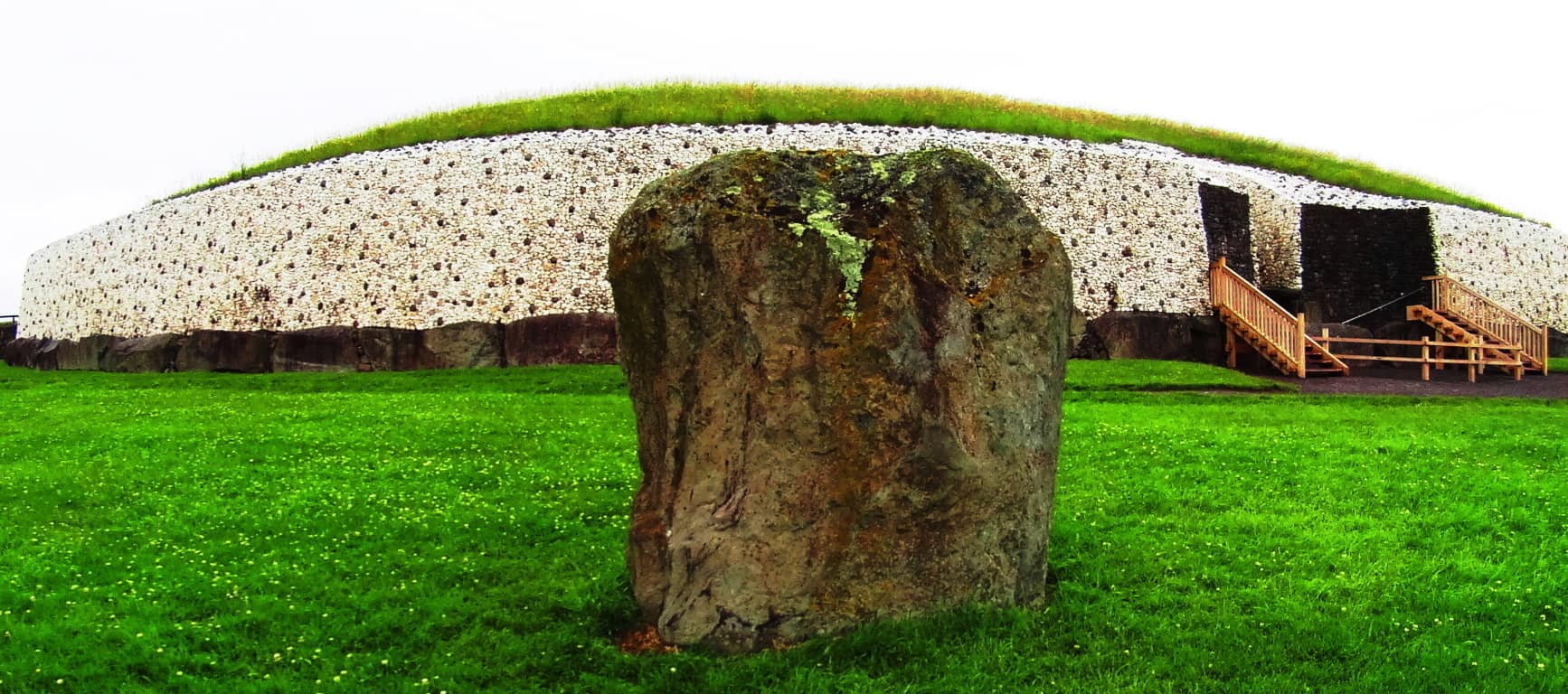 The exterior of the Temple is now lined in a modern white-quartz stone ring. The original Temple was much more concealed and blended into the hill for strategic reasons. It was literally part of the valley. The monumental stone slab at the entrance is one of the most important Celtic relics in the world, with gorgeous iconic Celtic rings imprinted into the megalith. This iconic stone is laid-out in a protective fashion, guarding the entrance, but is also clearly a display. It is a truly magical statement from the beginning of time. Imagine a solitary bean of light on the solstice day shining for only half a minute above this beautiful stone, making it glow, and continuing into the heart of the chamber! It just doesn’t get any better than this. And what’s more, the chambers in New England frequently have the same precise solstice feature. The connections between Celtic and New England antiquity cultures just grows from here, literally.
The exterior of the Temple is now lined in a modern white-quartz stone ring. The original Temple was much more concealed and blended into the hill for strategic reasons. It was literally part of the valley. The monumental stone slab at the entrance is one of the most important Celtic relics in the world, with gorgeous iconic Celtic rings imprinted into the megalith. This iconic stone is laid-out in a protective fashion, guarding the entrance, but is also clearly a display. It is a truly magical statement from the beginning of time. Imagine a solitary bean of light on the solstice day shining for only half a minute above this beautiful stone, making it glow, and continuing into the heart of the chamber! It just doesn’t get any better than this. And what’s more, the chambers in New England frequently have the same precise solstice feature. The connections between Celtic and New England antiquity cultures just grows from here, literally.
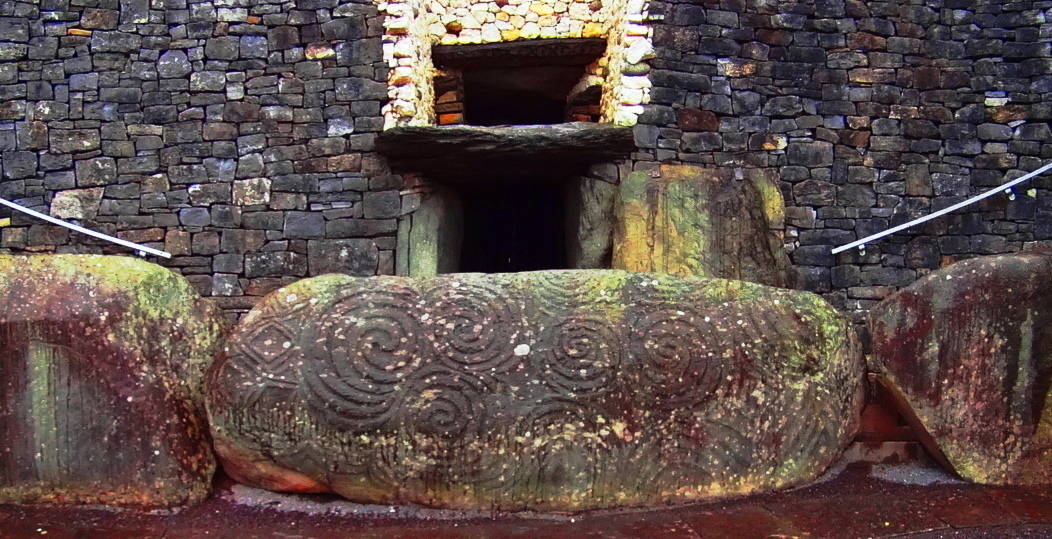
There are several other monumental stones with designs on them around the exterior of the Temple. with specific geometric features to observe on these stones, aside from the spirals. 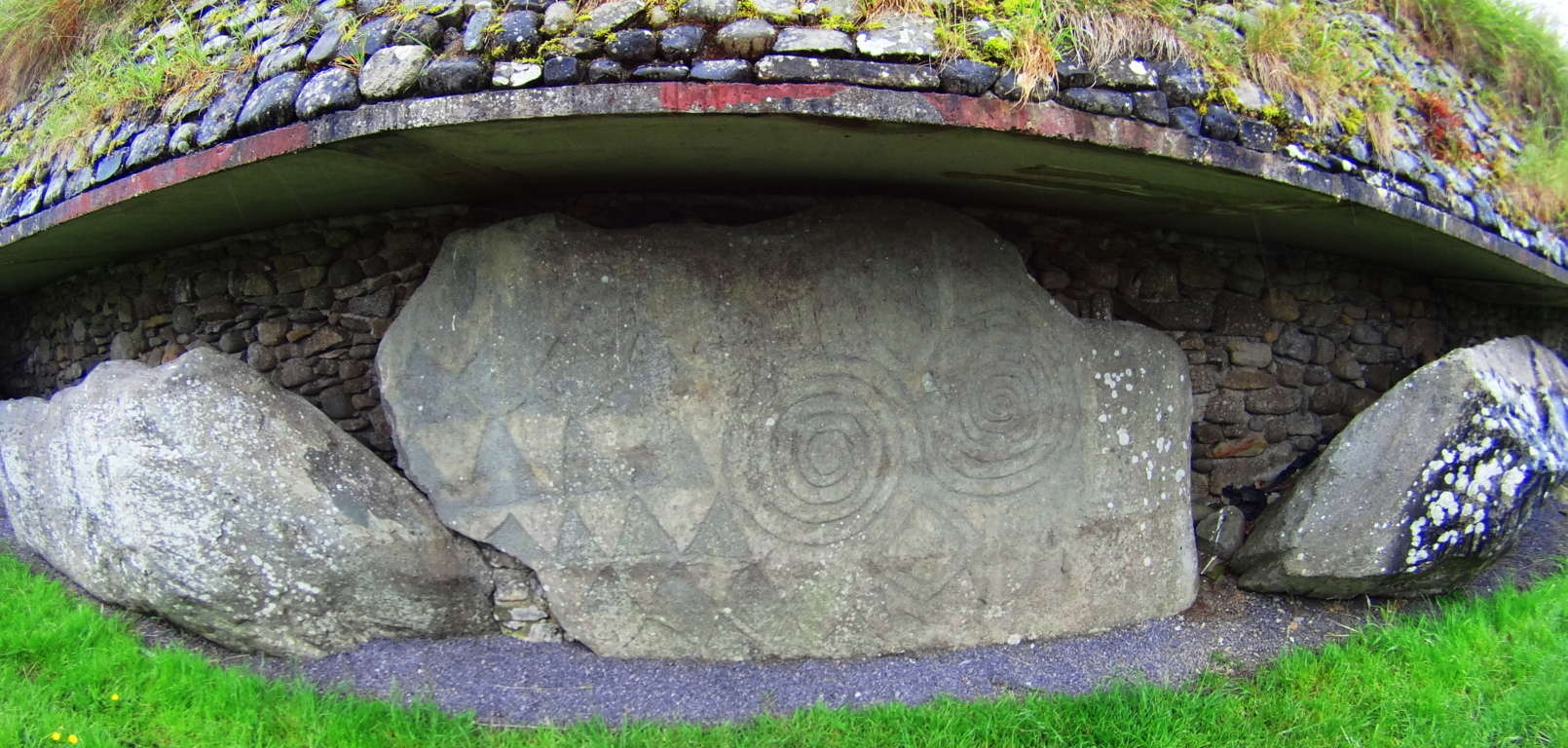 A closer look at this slab opposite the entrance reveals several iconic shapes, and more specifically, interconnected equilateral triangles, as well as mesmerizing Celtic spirals. These are not the only triangles to be found on the megaliths at New Grange. To see the others, we will need to step inside.
A closer look at this slab opposite the entrance reveals several iconic shapes, and more specifically, interconnected equilateral triangles, as well as mesmerizing Celtic spirals. These are not the only triangles to be found on the megaliths at New Grange. To see the others, we will need to step inside.
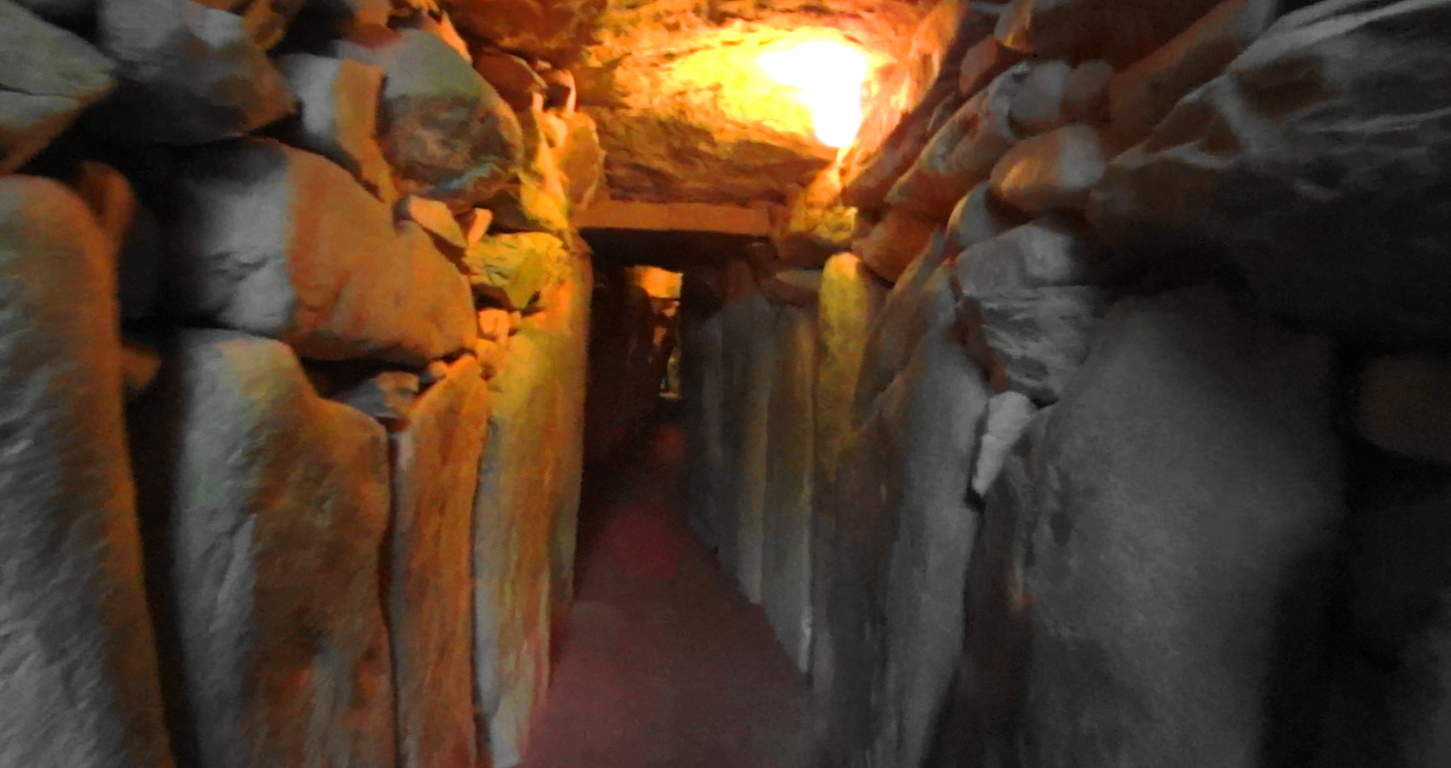 Welcome to the impossible. Here you are entering a chamber of what is the equivalent of 40 Dolmens in one corridor, all fit to perfection leading into a central chamber perfectly aligned to the stars, with a roughly 20 ft high corbel ceiling.
Welcome to the impossible. Here you are entering a chamber of what is the equivalent of 40 Dolmens in one corridor, all fit to perfection leading into a central chamber perfectly aligned to the stars, with a roughly 20 ft high corbel ceiling.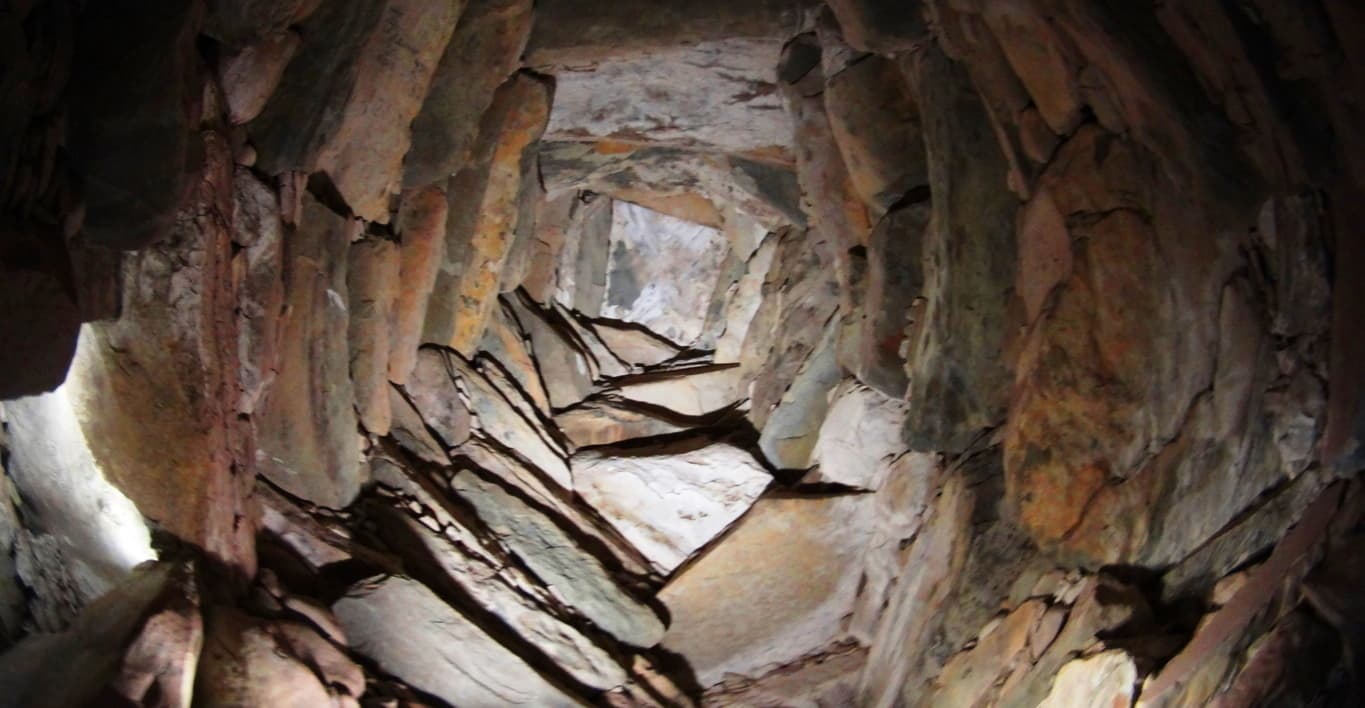 Imagine ancient Ireland, a land where giants roamed across the hills, and dangers unknown lurked beyond the next valley; and then imagine the absolute strength and safety you would feel walking through these impossible stone pillars. Here at least, in the ancient times, you were as safe as any Celt could be. The holistic benefits of living in a synergetic stone temple would most likely be wonderful, in comparison to the huts and wood fortresses of less fortunate clans. At the end of the long singular corridor from the entrance you will encounter stones with imprinted triangles and diamonds before entering the central chamber.
Imagine ancient Ireland, a land where giants roamed across the hills, and dangers unknown lurked beyond the next valley; and then imagine the absolute strength and safety you would feel walking through these impossible stone pillars. Here at least, in the ancient times, you were as safe as any Celt could be. The holistic benefits of living in a synergetic stone temple would most likely be wonderful, in comparison to the huts and wood fortresses of less fortunate clans. At the end of the long singular corridor from the entrance you will encounter stones with imprinted triangles and diamonds before entering the central chamber. 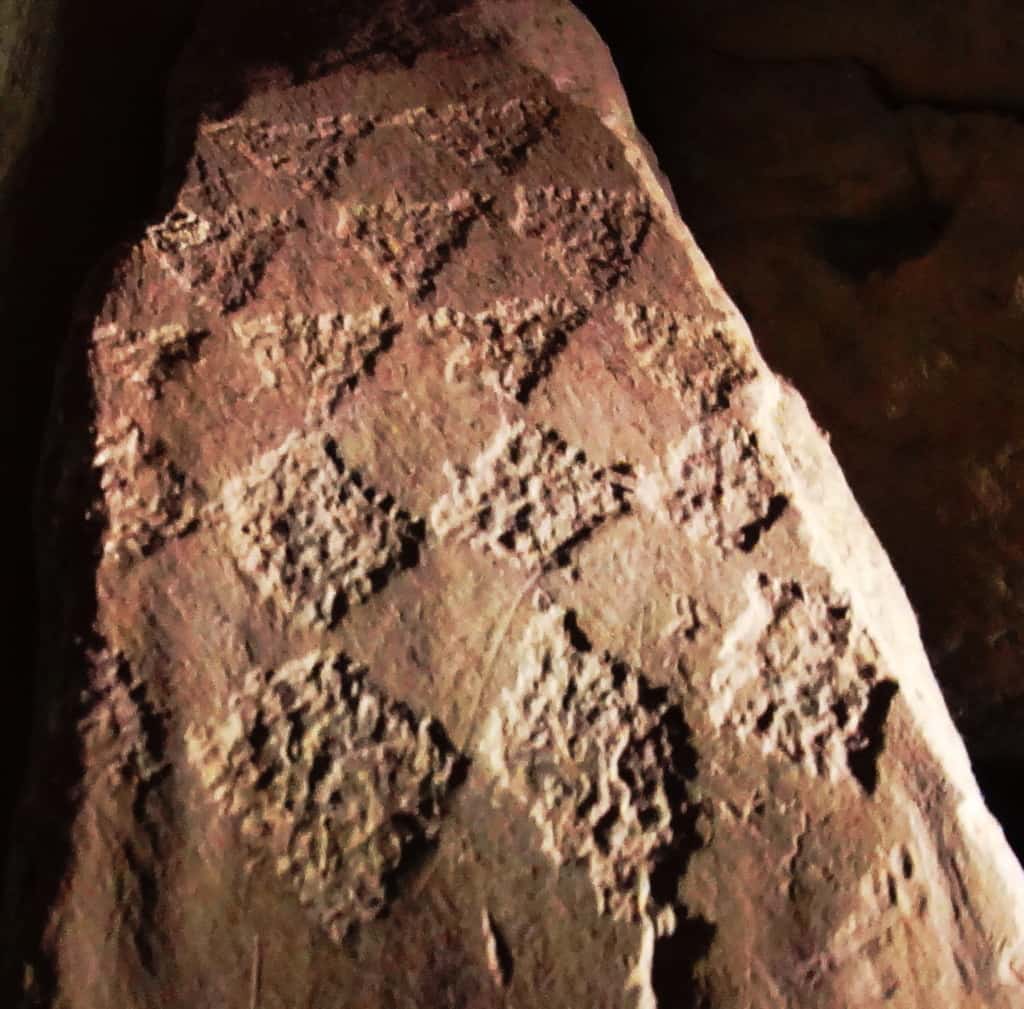
Imprinted on this entryway stone at the main-chamber are distinct equilateral triangles that are seemingly transitioning into diamond shapes. There is profound connection here to the megalithic sites in New England, which utilizes this exact same meme at practically all the megalithic sites. Specifically in New England, you will find equilateral triangles etched into granite by waterfalls, and massive diamond cut stones along ancient trail ways. This is the central megalithic meme in New England, and here are those very same shapes in the heart of the oldest megalithic chamber in the world. Here are some examples of New England megaliths cut exactly into triangles and diamonds.
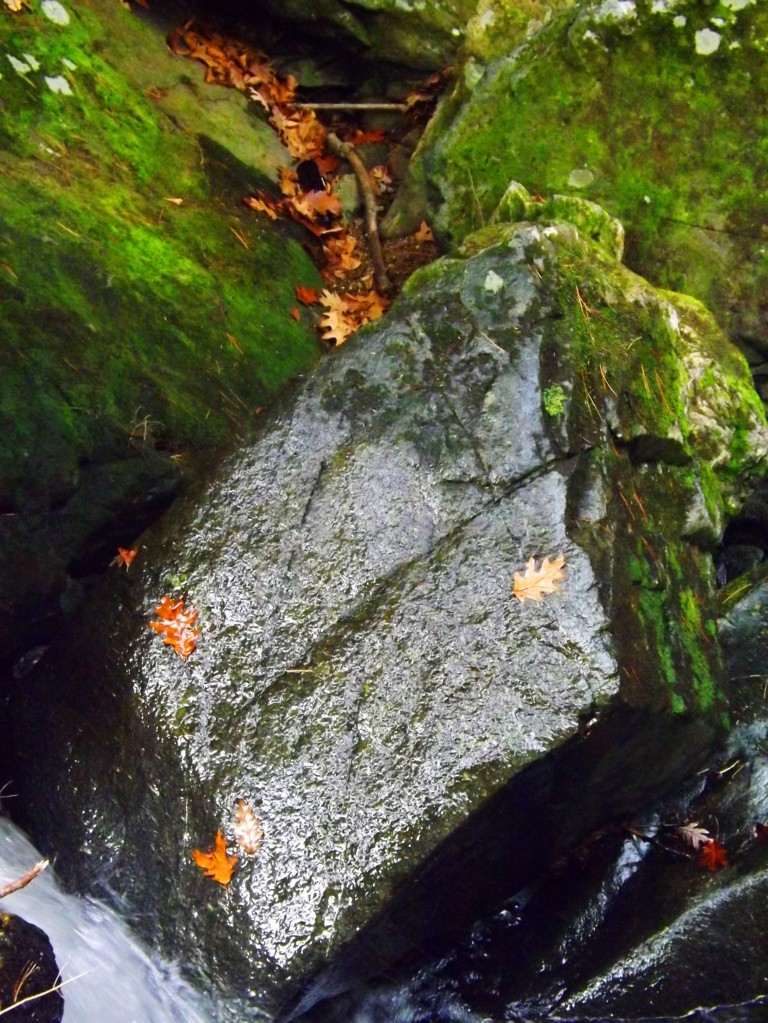
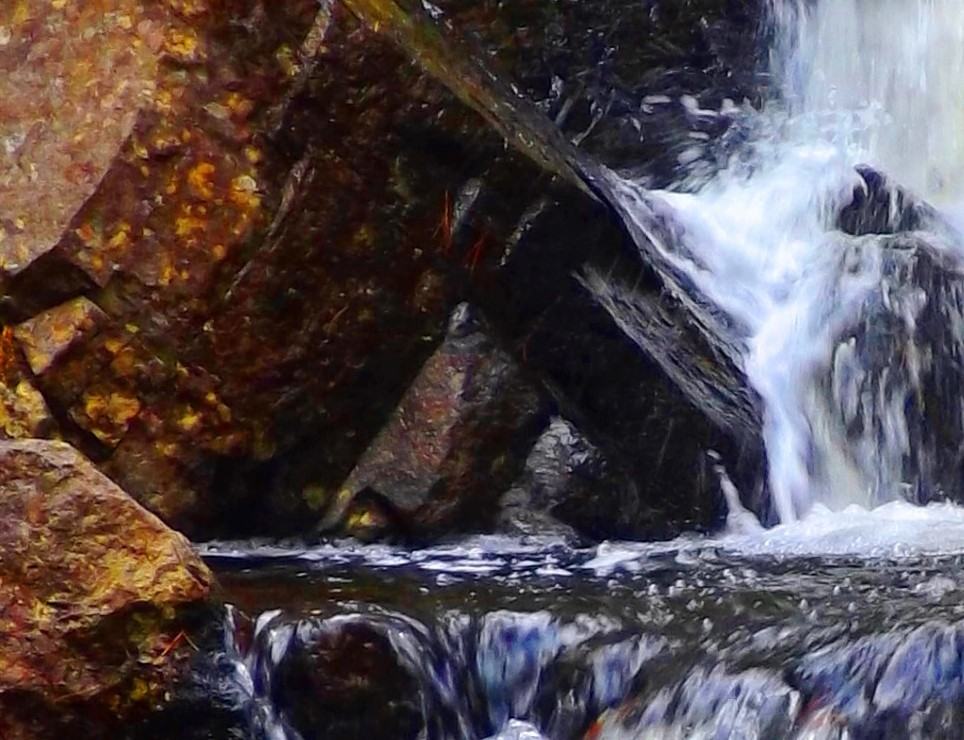

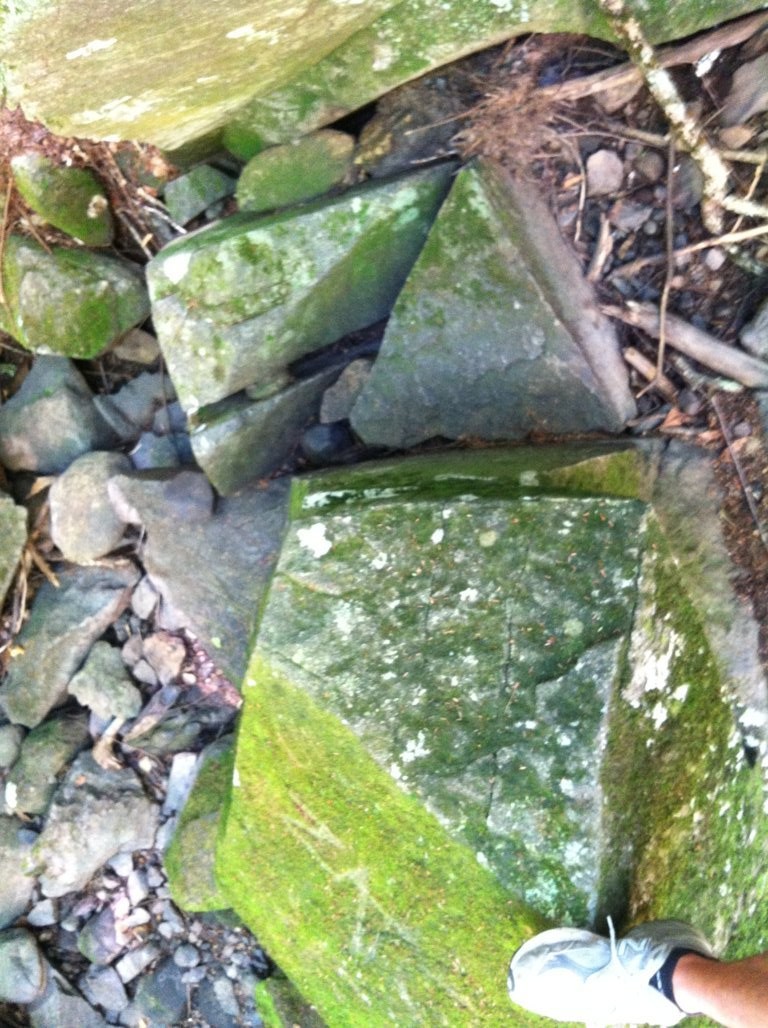
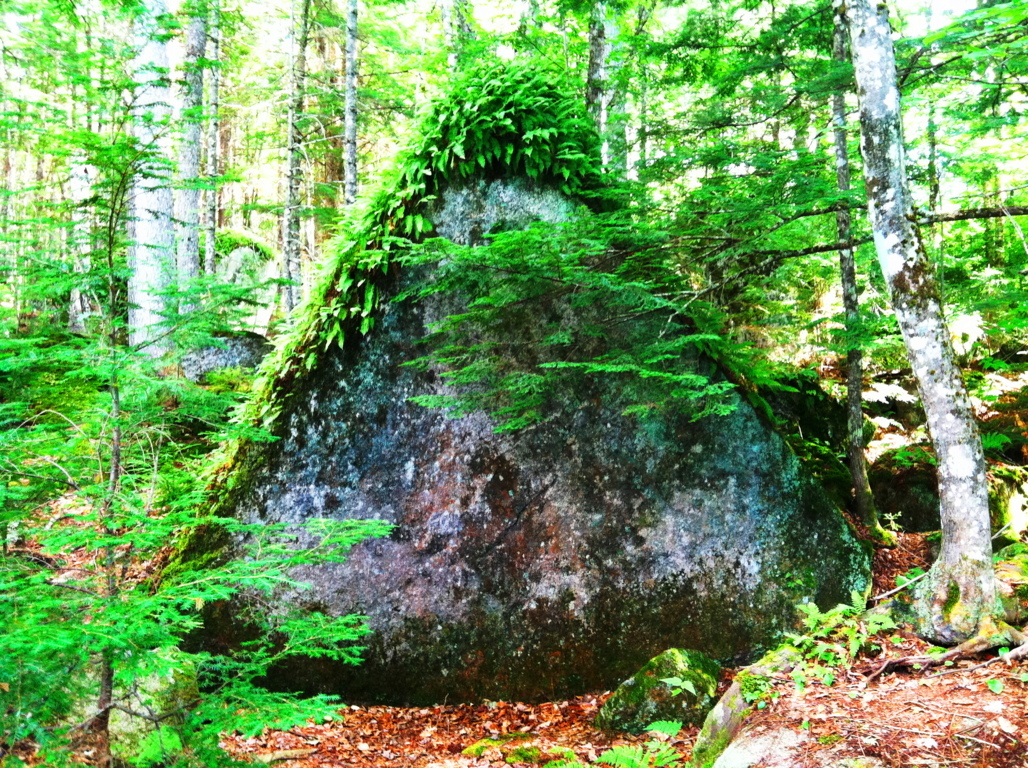
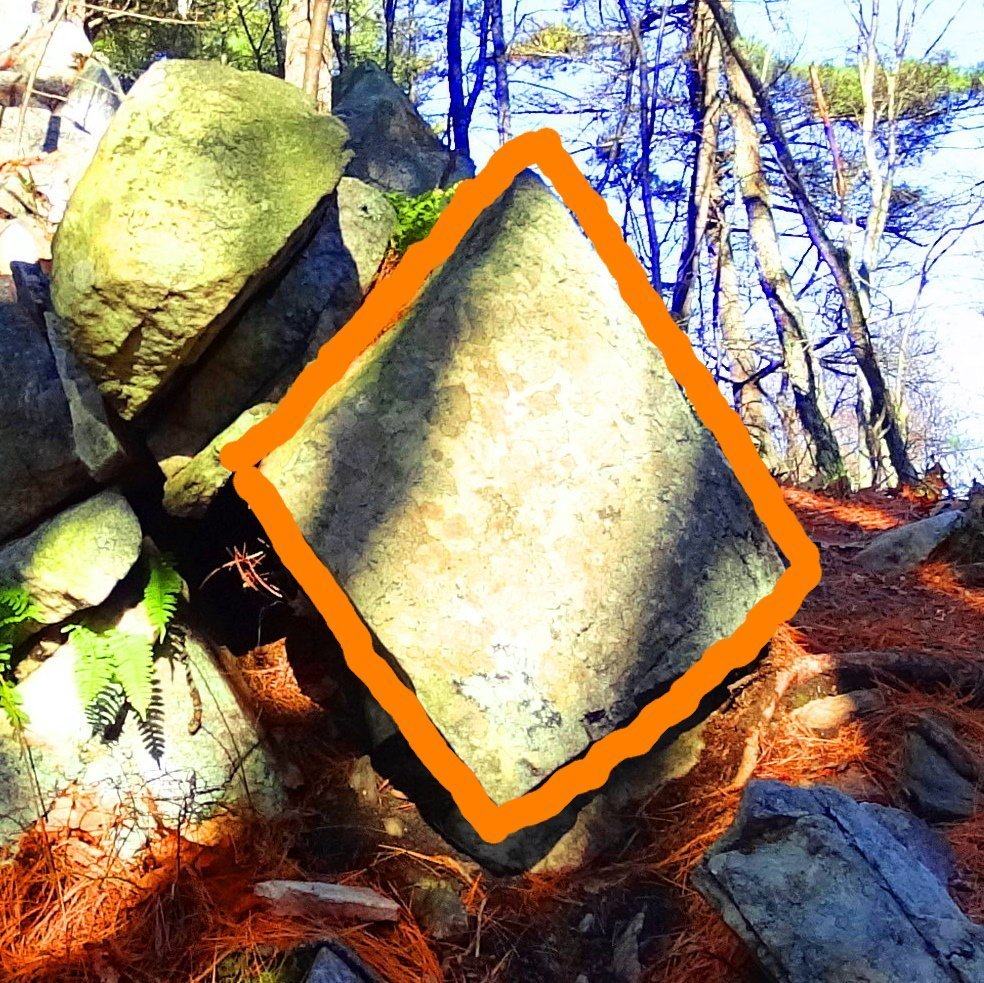
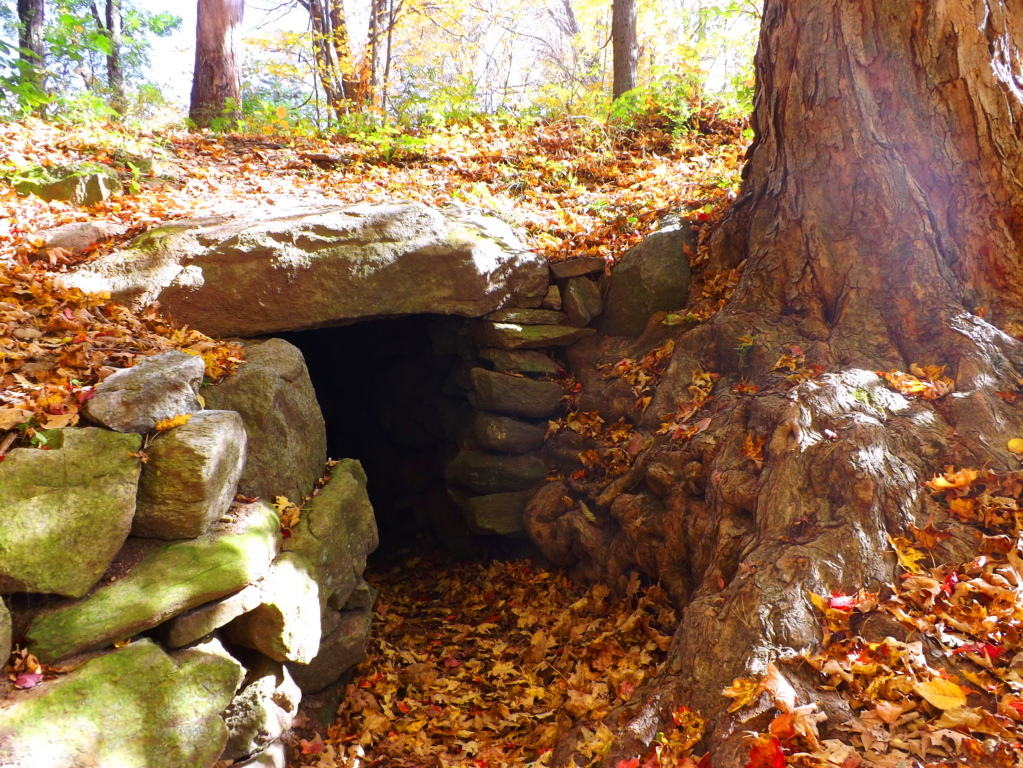
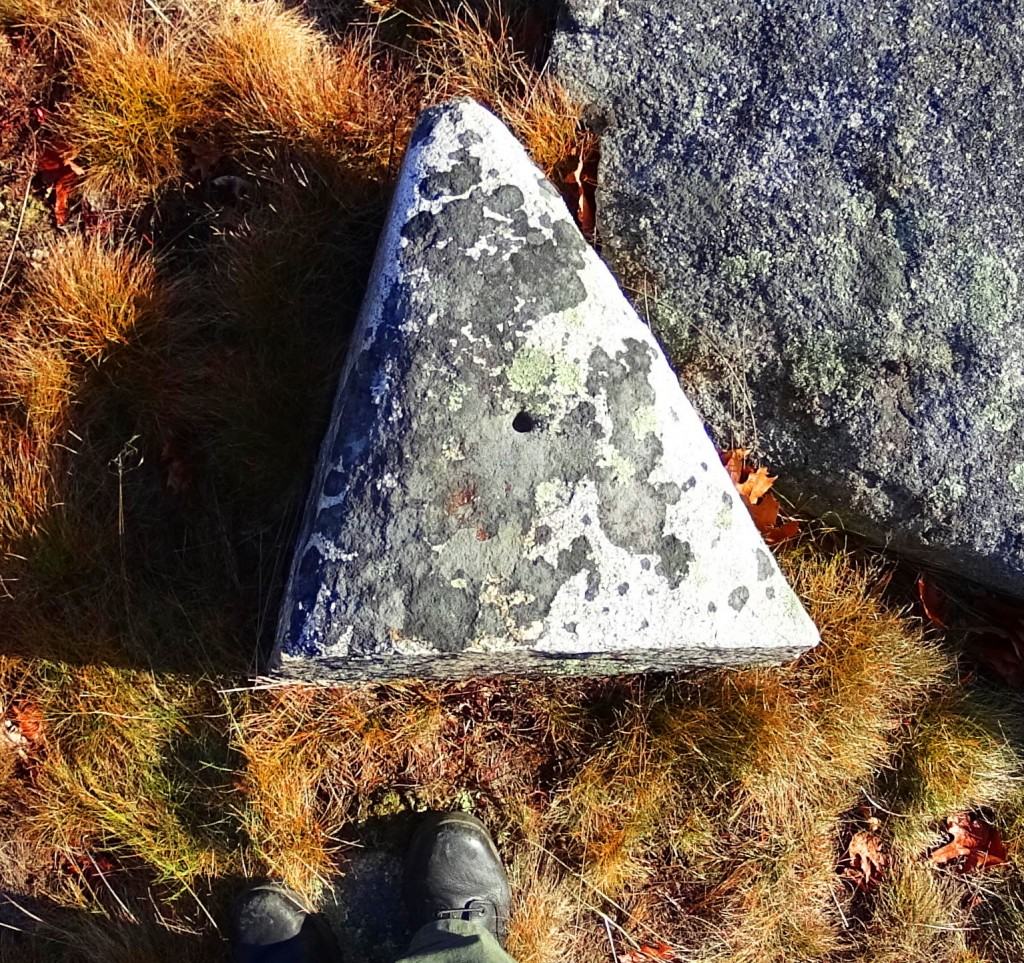
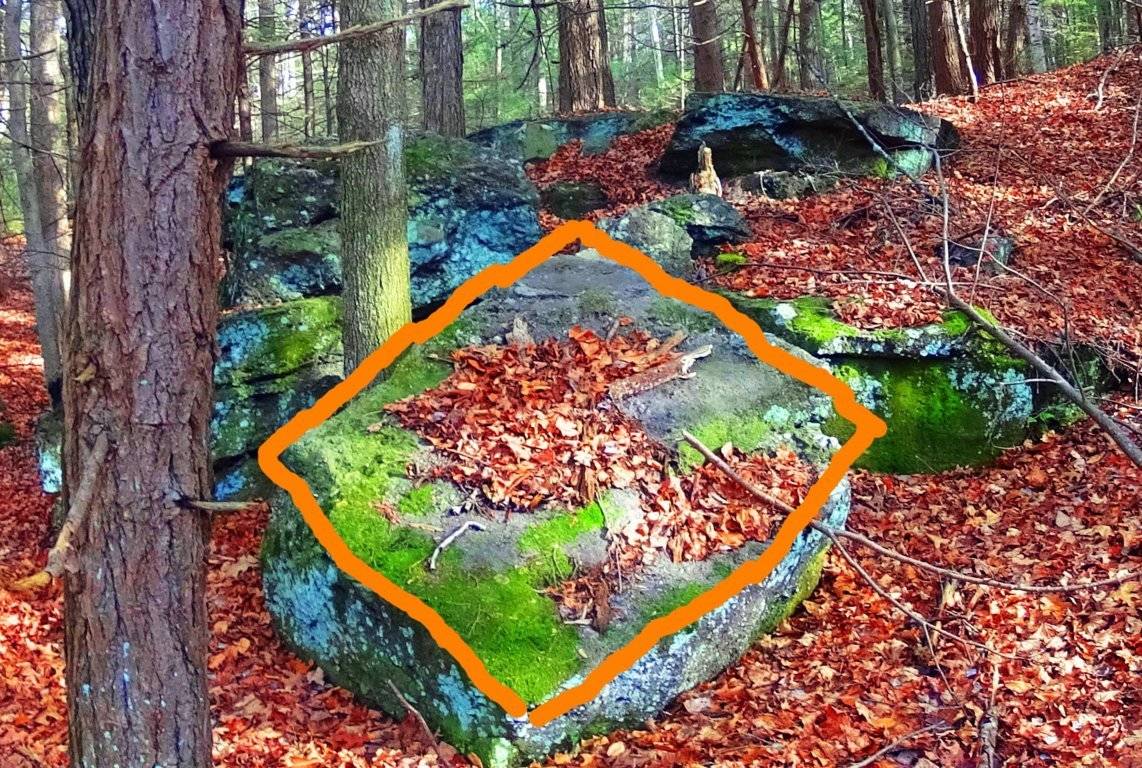
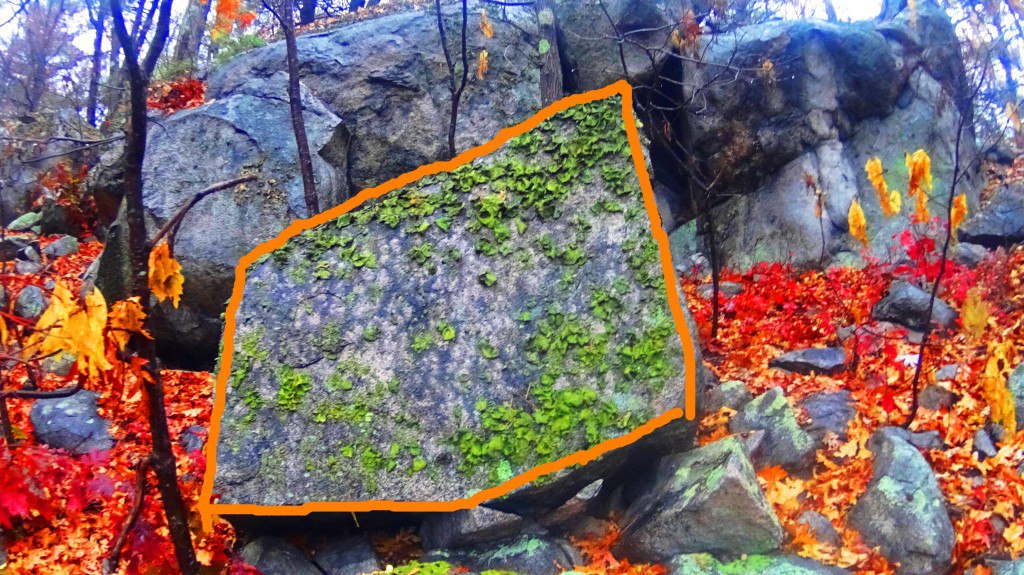
The evidence is too strong to dismiss. It seems highly likely that the megalithic culture that existed in Ireland had a relative culture across the Atlantic in New England. The question will arise: what is so important about triangles and diamond shapes? It might be that the Triangle is the first shape to develop from any linear set of points, and this culture was the first to develop in linear history, and so they claimed the Triangle as their calling card symbol. The ‘diamond’ is the result of the functionary crafting of cross-sections and equilaterals. If you cut a proper X into a stone, the result is four diamond shapes that are consistent with each other, and these utility cross-sections that create diamonds are found all over New England mountain trails. It as if the Neolithic culture were marking zones and territories as a warning to those passing through, and letting us know that the original culture once claimed this area.
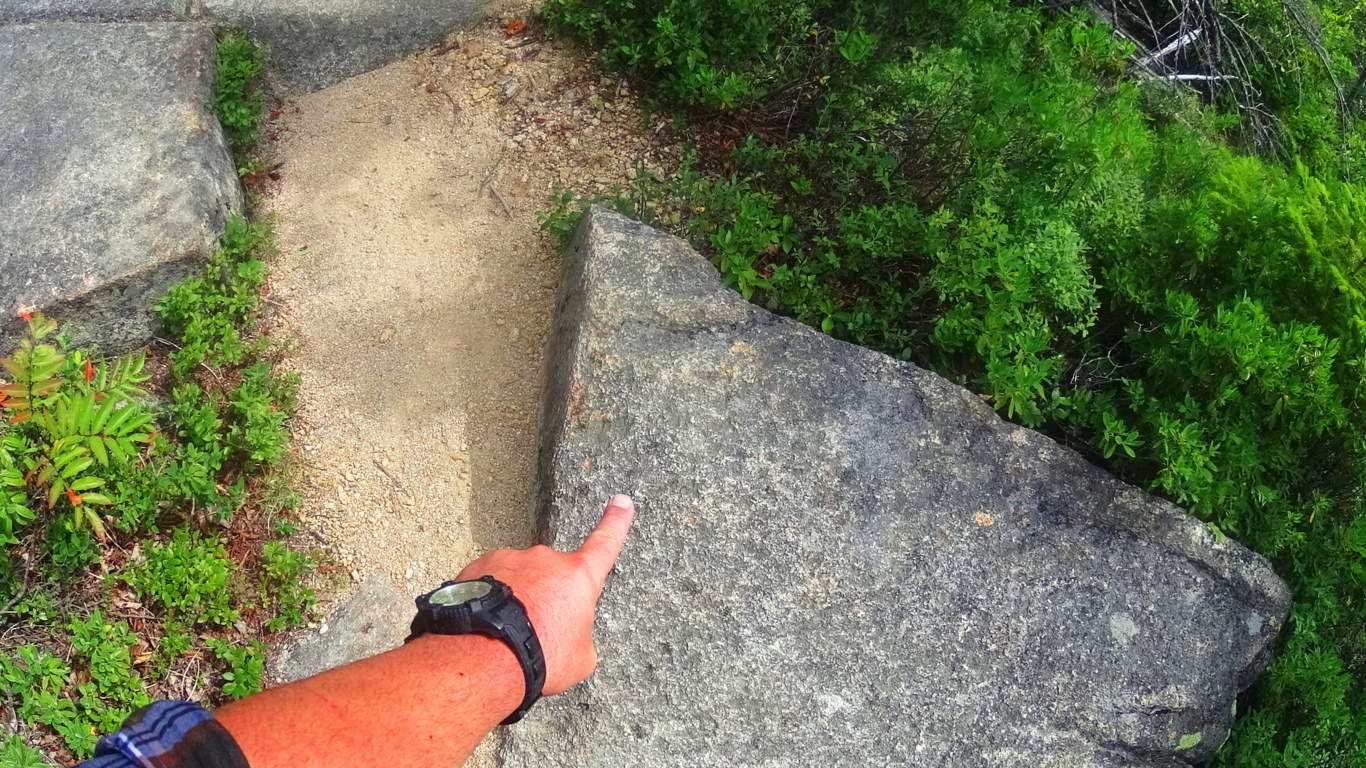
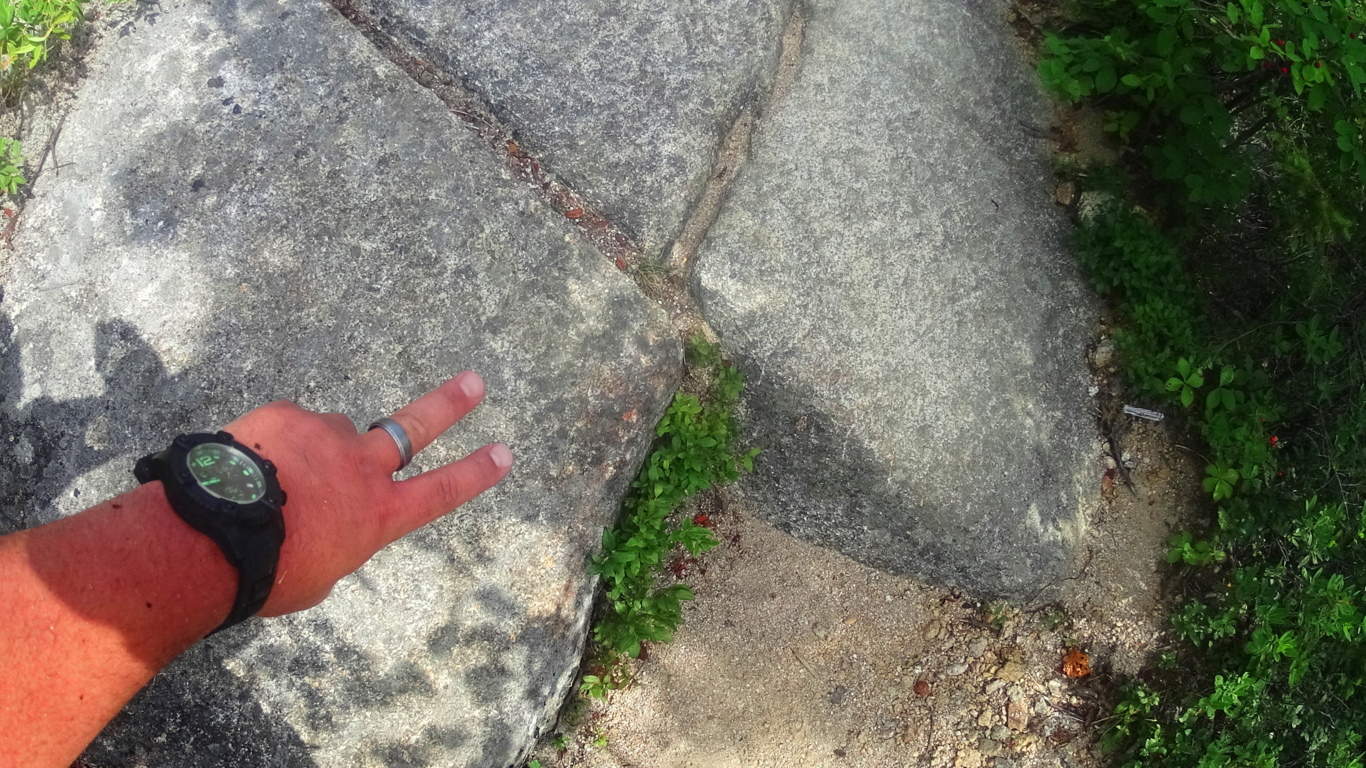
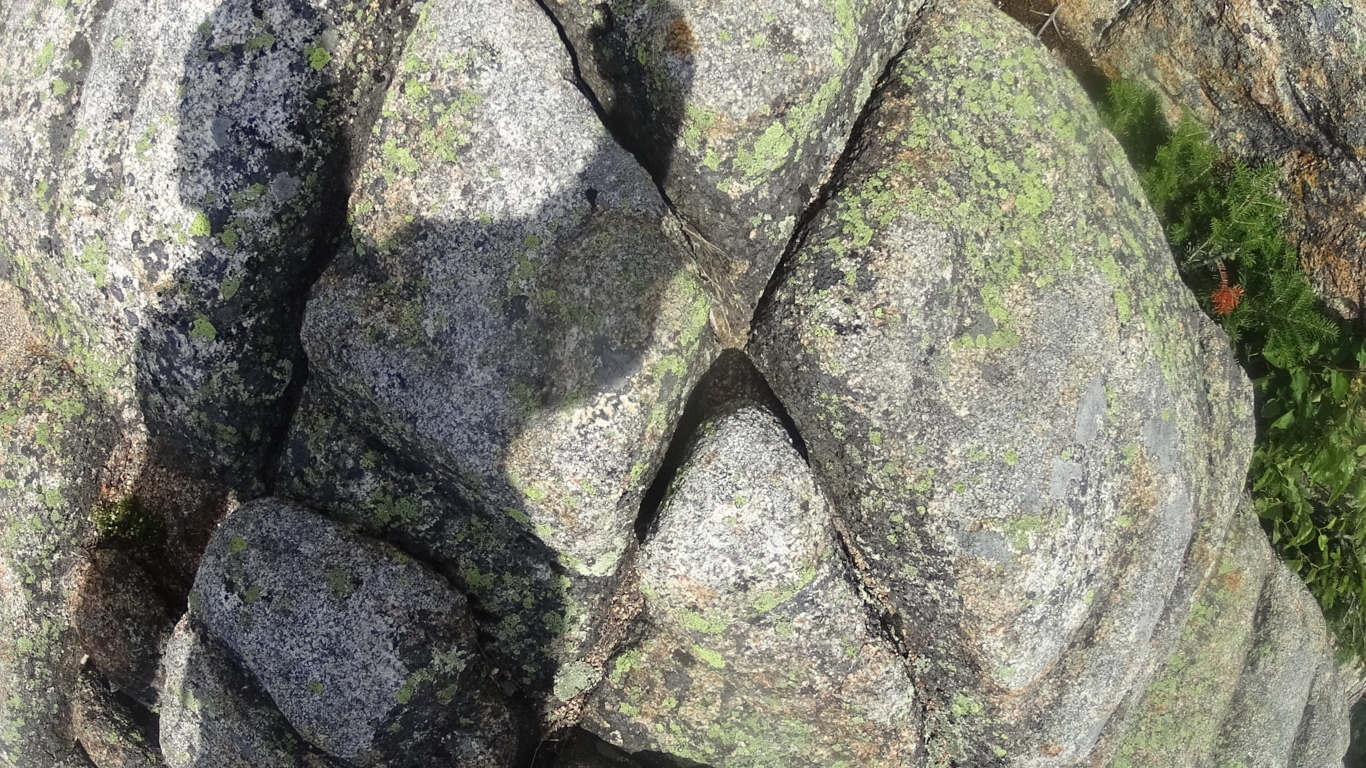
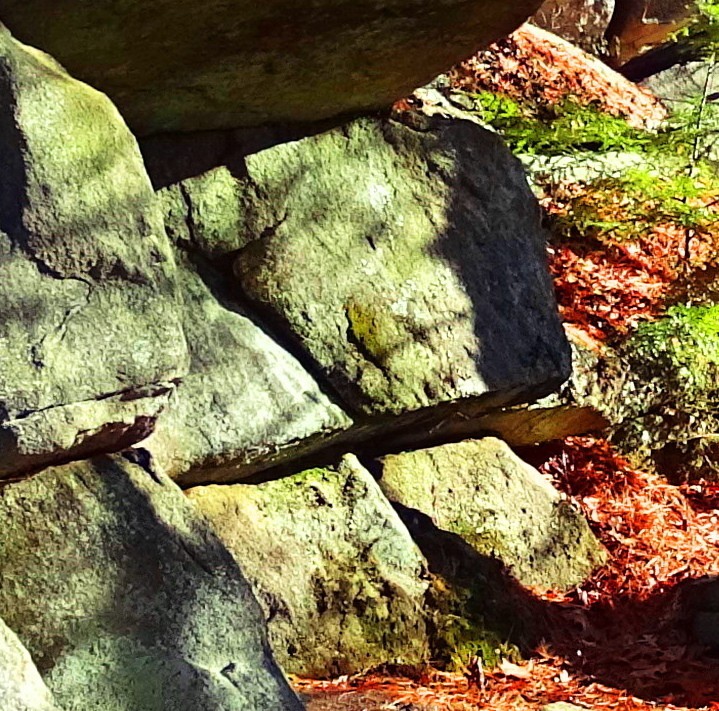
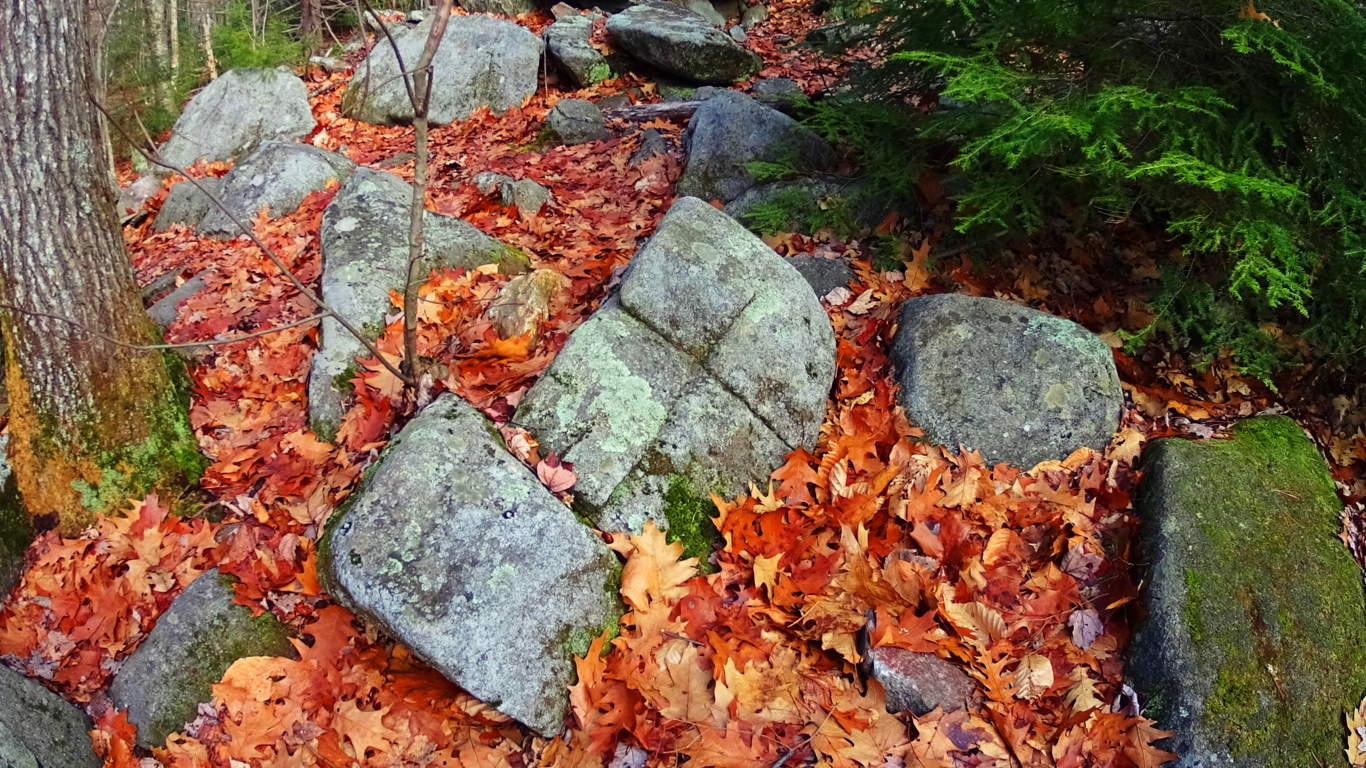
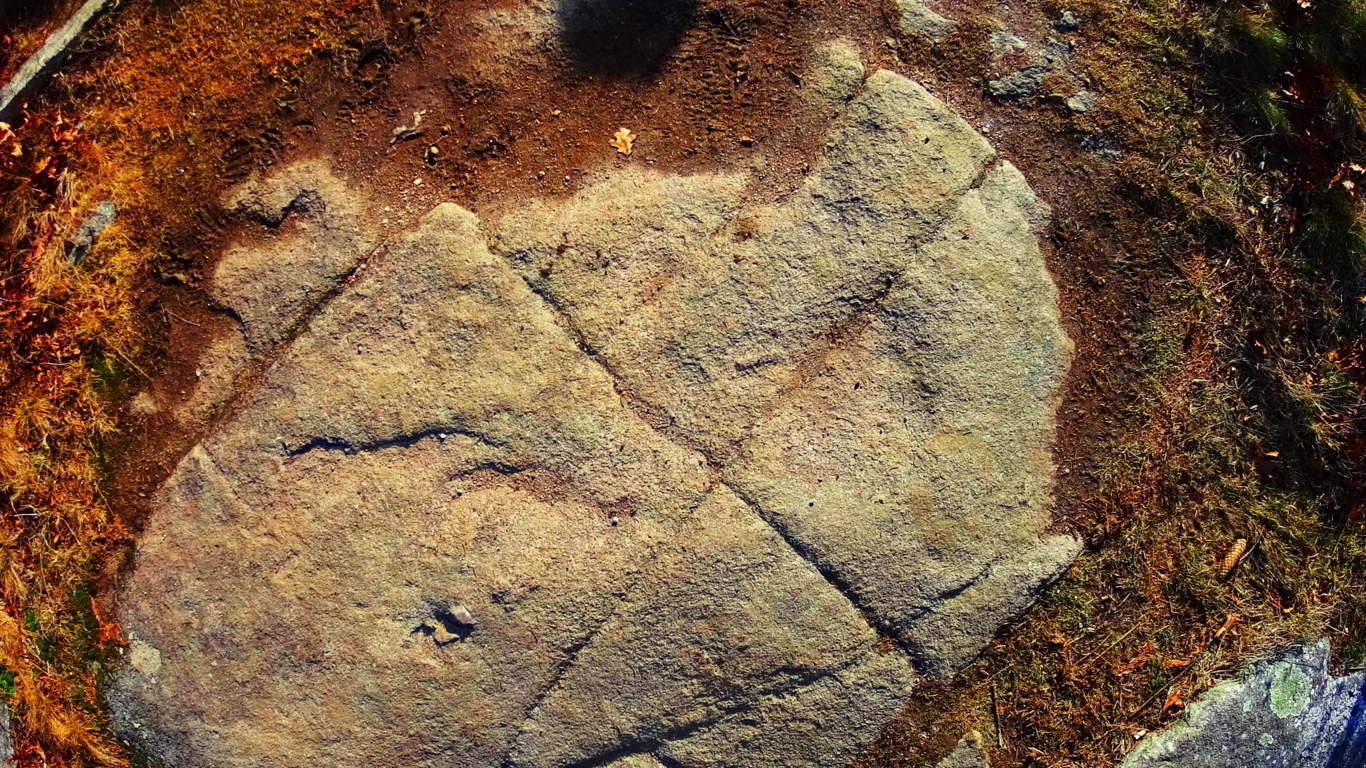
Anther stone in the interior of the chamber at New Grange displays dozens of whimsical triangles and diamonds cascading all over the stone. This just can’t be a coincidence; there must be some relation between New England’s and Ireland’s oldest cultures. 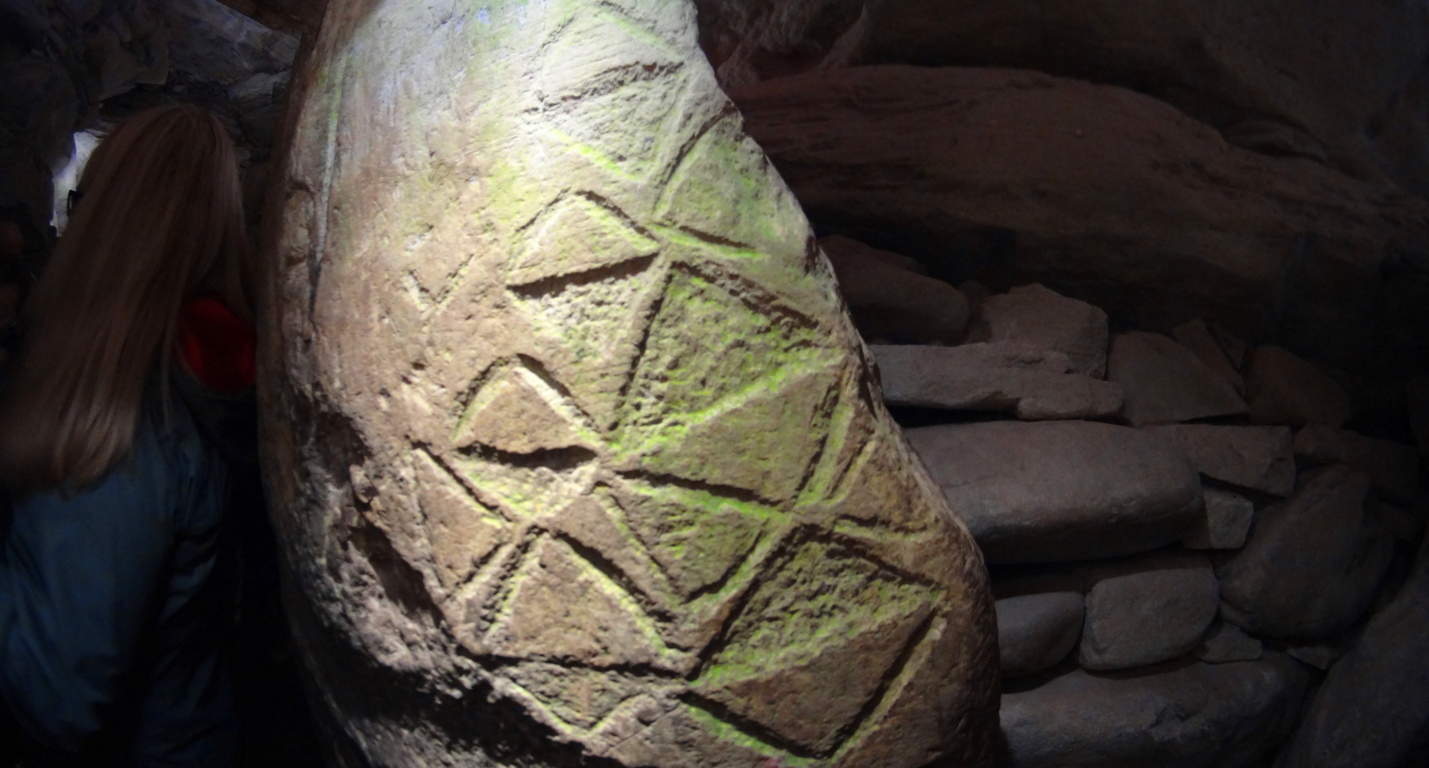 Neolithic Culture: Here is the part of the article that gets surreal and a bit ‘heady’. The history and chronology of how neolithic cultures relate, if they relate, must be found in their works. The works are obviously similar in structure, and also in symbolism. As New Grange is considered the oldest temple in the world, it seems logical that these geometric themes originated here, and spanned-out to the rest of the world. If this is true, then the pre-Celtic neolithic culture in Europe is the original ancestor of the neolithic culture that somehow crossed the Atlantic and ultimately made it’s way to New England. Their works are massive, beyond human in scale, like the Standing Stones outside New Grange.
Neolithic Culture: Here is the part of the article that gets surreal and a bit ‘heady’. The history and chronology of how neolithic cultures relate, if they relate, must be found in their works. The works are obviously similar in structure, and also in symbolism. As New Grange is considered the oldest temple in the world, it seems logical that these geometric themes originated here, and spanned-out to the rest of the world. If this is true, then the pre-Celtic neolithic culture in Europe is the original ancestor of the neolithic culture that somehow crossed the Atlantic and ultimately made it’s way to New England. Their works are massive, beyond human in scale, like the Standing Stones outside New Grange. There is also the philosophical aspect of the Triangle, which is a shape specifically relevant to consciousness and divine comprehension. Is the neolithic culture referencing a direct connection to God Itself, like the neolithic tribes of Genesis? This is an intense reference, but according to the Bible the first generation on earth was the ‘Nephilim, meaning: “those who fell from heaven”. The offspring of these angels came from their copulating with human women, and that offspring was said to be Giants. (Genesis: 6) It sounds like extreme science fiction, and yet that’s exactly what the biblical accounts say. Moreover, when the Israelites went into the Promise Land and Joshua scouted out the territory, he found tribes of Giants. Joshua says the tribes he encountered made him feel he was ‘the size of a grasshopper’. What is going there?
There is also the philosophical aspect of the Triangle, which is a shape specifically relevant to consciousness and divine comprehension. Is the neolithic culture referencing a direct connection to God Itself, like the neolithic tribes of Genesis? This is an intense reference, but according to the Bible the first generation on earth was the ‘Nephilim, meaning: “those who fell from heaven”. The offspring of these angels came from their copulating with human women, and that offspring was said to be Giants. (Genesis: 6) It sounds like extreme science fiction, and yet that’s exactly what the biblical accounts say. Moreover, when the Israelites went into the Promise Land and Joshua scouted out the territory, he found tribes of Giants. Joshua says the tribes he encountered made him feel he was ‘the size of a grasshopper’. What is going there?
With that in mind, you might eventually ask yourself: are these works the productions of these Giants in both Ireland and New England? Why are so many myths based upon Giants? The relations are there, and the relevant meaning of the chosen memes and symbols are there too.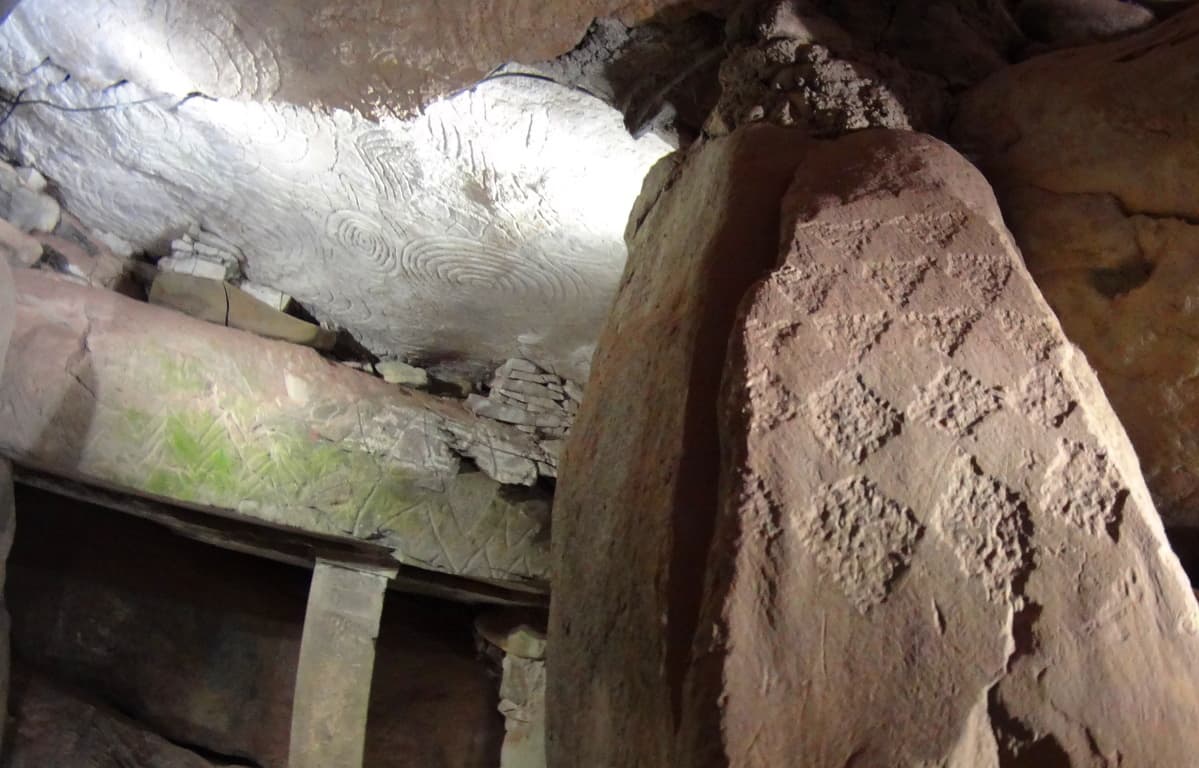 The hard part is, it utterly changes the current story of history, which is evolution based. New Grange is truly an otherworldly ancient temple that evokes wonder and humbling respect for the course of hallowed Time. Our particular modern era looks increasingly like ‘life in a controlled bubble’ when we look at the grand scheme of History. Almost all of our information is pre-packaged and funneled into specific themes, and if you disagree with them, you will be found to be disagreeable and ultimately failed in your assigned studies. The revised history that is given to our children is a set of theories sponsored by commercial academic institutions. The ‘technological era’ is a mere blip of 100 small years at the tail end of 40,000 years of human culture. When we look closely at what the antiquity suggest, it increasingly looks as if our culture is intentionally turning its back on the evidence in order to passively inject a more “convenient” theory of culture, based on erroneous assumptions. New Grange is one of the holiest places in the world, as a temple that has been here since the beginning of anthropological history, it is exquisitely rare. If we are truly sincere about going where the evidence leads us, then we must be prepared to challenge memes that don’t add up. Stonestrider.com isn’t a religious website; it’s about finding the best trails and photos you can, but it is impossible to deny that places like New Grange challenge so many things we assume about human progress. So, even if you are in Dublin just for a few days, plan a morning to visit New Grange. It is something, even with all our modern answers, we still don’t completely understand.
The hard part is, it utterly changes the current story of history, which is evolution based. New Grange is truly an otherworldly ancient temple that evokes wonder and humbling respect for the course of hallowed Time. Our particular modern era looks increasingly like ‘life in a controlled bubble’ when we look at the grand scheme of History. Almost all of our information is pre-packaged and funneled into specific themes, and if you disagree with them, you will be found to be disagreeable and ultimately failed in your assigned studies. The revised history that is given to our children is a set of theories sponsored by commercial academic institutions. The ‘technological era’ is a mere blip of 100 small years at the tail end of 40,000 years of human culture. When we look closely at what the antiquity suggest, it increasingly looks as if our culture is intentionally turning its back on the evidence in order to passively inject a more “convenient” theory of culture, based on erroneous assumptions. New Grange is one of the holiest places in the world, as a temple that has been here since the beginning of anthropological history, it is exquisitely rare. If we are truly sincere about going where the evidence leads us, then we must be prepared to challenge memes that don’t add up. Stonestrider.com isn’t a religious website; it’s about finding the best trails and photos you can, but it is impossible to deny that places like New Grange challenge so many things we assume about human progress. So, even if you are in Dublin just for a few days, plan a morning to visit New Grange. It is something, even with all our modern answers, we still don’t completely understand.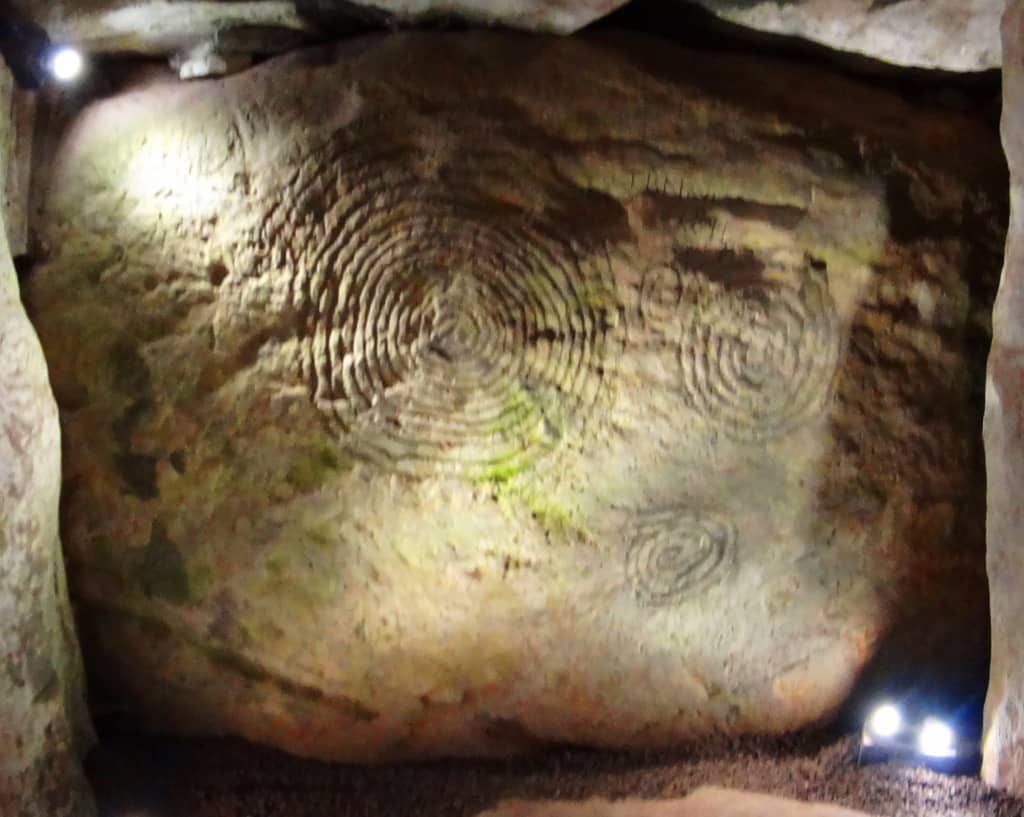 Something incredible, almost otherworldly, took place in antiquity in order to build this temple. Walking into it’s main chamber is like walking into a miracle. It just doesn’t get more sacred than this, and a hillside is sometimes so much more than a hillside, so keep hiking.
Something incredible, almost otherworldly, took place in antiquity in order to build this temple. Walking into it’s main chamber is like walking into a miracle. It just doesn’t get more sacred than this, and a hillside is sometimes so much more than a hillside, so keep hiking.
Donegal

Location: County Donegal/Ireland
Note 1: There are only so many places in the wide world that offer an approachable scene of mountains along with gorgeous coastline in the same incredible hikes. Some examples include exotic places like Santa Barbara/California, Monaco/France, or Whakatane/New Zealand. These epic places all carry that rare majesty of mountain-range combined with coastal experience. These areas, at minimum, are straight-up wonderlands. It pulls on our imaginations and taps our curiosity to even glimpse images of these places. There is yet another place though, no less profound, further up the northern hemisphere, that is so worthy of your attention. For the lucky trailblazers who have stood at the peak of Mount Errigal in County Donegal, Ireland, and turned their gaze North (Image/Below), it becomes scintillatingly clear that this is one of the most incredible mountainous/coastal regions on Earth. This is Donegal, Ireland. If you haven’t found your way there yet, then this is your chance to get a glimpse of this ancient place. Sometimes just a glimpse is all it takes to get you there, like falling in love at a glance. This is the overall goal of Stonestrider.com; not just to show you how beautiful a given place might be, but to give you enough visual substance to put you over the top, and get you to make the decision to get there… in real-time.
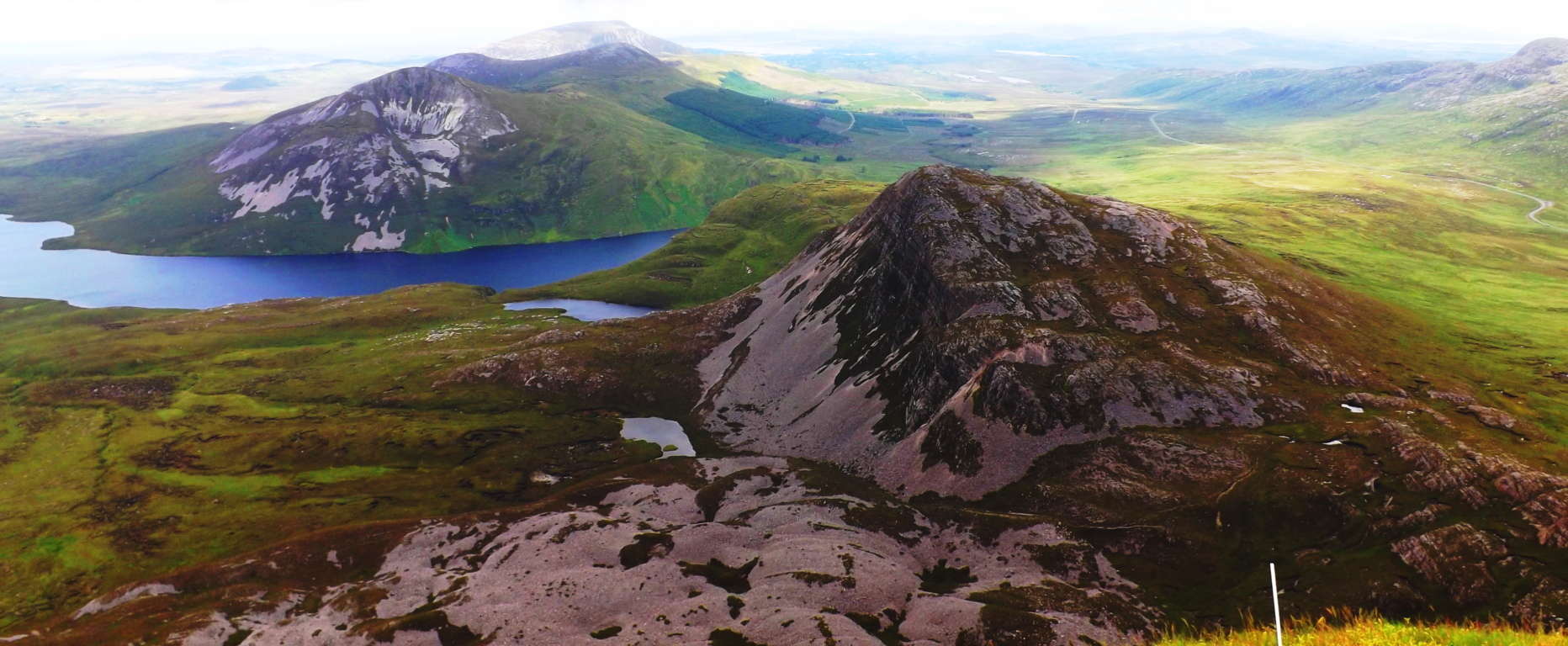 Donegal is a collection of every possible aspect of ancient Irish culture; from the Celtic tradition espousing tales of Giants and great kings, to the related Medieval Period and its dynamic history. In approaching Donegal, the boarder regions to the South and East will be looked at as well. Ireland is an interwoven tapestry of related Counties, and it becomes necessary to describe the beautiful sites that exist en-route to this beautiful northwest corner of the Emerald Isle, as well as Donegal proper. The history here is pretty much on-par with Game of Thrones. There are epic accounts of Viking-raids all over northern Ireland, mingled with Medieval relations between the great Houses that occupied the ancient castles of the region. Donegal Castle has many engaging stories throughout its haunting and epic history. (below/left). There are hundreds of other gorgeous castles dotting the landscape, contrasting the skyline atop cliffs; along crystalline lakes, and dark Atlantic coast.
Donegal is a collection of every possible aspect of ancient Irish culture; from the Celtic tradition espousing tales of Giants and great kings, to the related Medieval Period and its dynamic history. In approaching Donegal, the boarder regions to the South and East will be looked at as well. Ireland is an interwoven tapestry of related Counties, and it becomes necessary to describe the beautiful sites that exist en-route to this beautiful northwest corner of the Emerald Isle, as well as Donegal proper. The history here is pretty much on-par with Game of Thrones. There are epic accounts of Viking-raids all over northern Ireland, mingled with Medieval relations between the great Houses that occupied the ancient castles of the region. Donegal Castle has many engaging stories throughout its haunting and epic history. (below/left). There are hundreds of other gorgeous castles dotting the landscape, contrasting the skyline atop cliffs; along crystalline lakes, and dark Atlantic coast.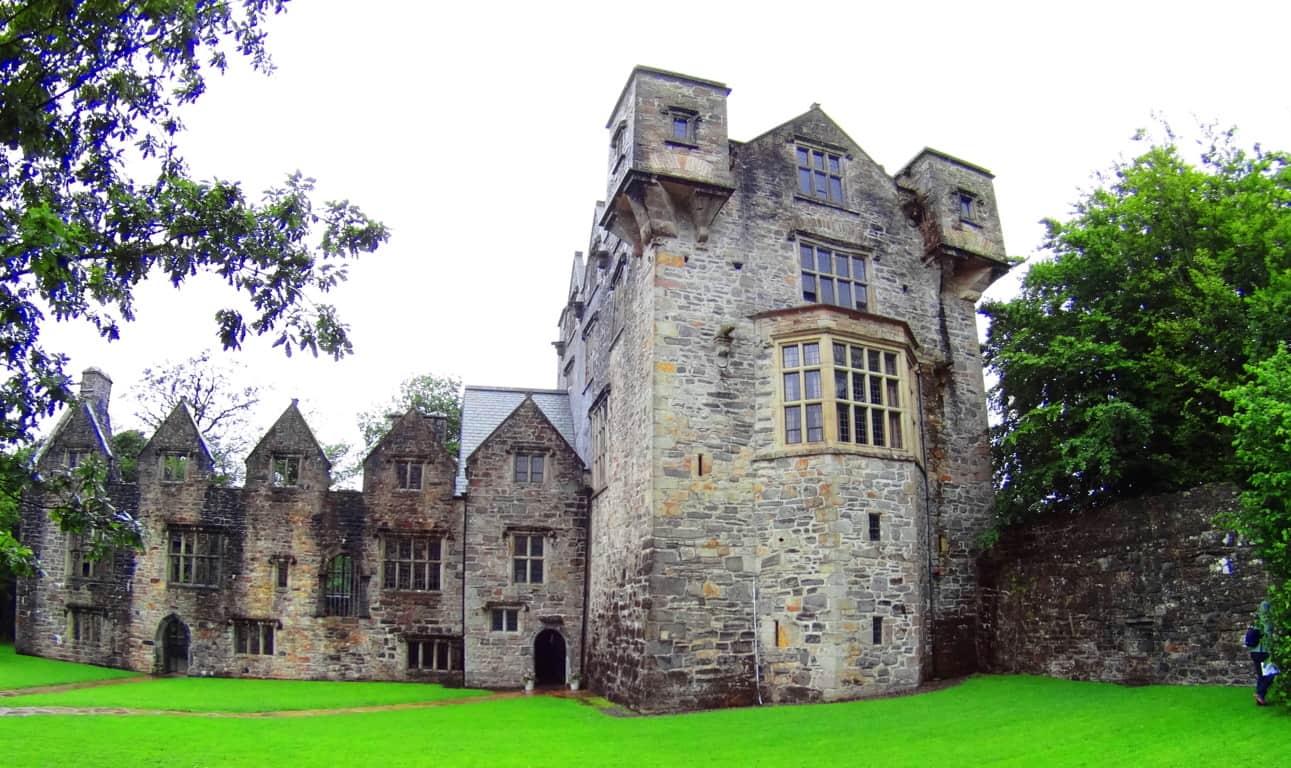 There are Dolmens in the heights and forests; Dolmens which are aged 4000 to 6000 years. Stone Circles exist mystically in the fields of each county as well, and are no less significant. Donegal is a veritable soup of historical substance. There is a historical richness and mystical sustenance that locations like Santa Barbara and Whakatane’ just can’t provide. An adventure in Donegal is rich with tangible in-depth substance, true wonder, and every type of magical potential. O.k. Lets begin, to wander in…
There are Dolmens in the heights and forests; Dolmens which are aged 4000 to 6000 years. Stone Circles exist mystically in the fields of each county as well, and are no less significant. Donegal is a veritable soup of historical substance. There is a historical richness and mystical sustenance that locations like Santa Barbara and Whakatane’ just can’t provide. An adventure in Donegal is rich with tangible in-depth substance, true wonder, and every type of magical potential. O.k. Lets begin, to wander in…
The Region: Before entering the dimension that is Donegal, the logistic mystery that surrounds the area should definitely be addressed. Even describing the cartagraphical affiliations of the area creates a bit of a tongue-twister; colors can be used to describe the political designation of Donegal. Donegal is in the physical region of northern Ireland, and more specifically northwestern Ireland, and remains part of the nation of Ireland, which generally continues geographically South from Donegal. Donegal, however, is not in “the nation” of Northern Ireland, which is part of the U.K. The north-eastern part of the island is the U.K. Be aware of this national distinction if you travel anywhere due-north of Dublin, the proud people of this specified region most certainly are.
Note 2: The history of the northerly destinations of Ireland should definitely be looked at for a moment before thinking of traveling through. Deadly conflict has taken place around the area of Belfast due to the occupation of British forces. This controversial occupation extends far back in Time, even before Colonial times, into the Medieval period. Interaction between the British, Scottish, and Norse cultures, are interwoven into the overall ancient history of the region, with the British prevailing into this Modern period. Towns like Newcastle in the Mourne Mountain Range have a proud tradition of being part of the U.K, with hundreds of British flags often displayed in the old-town center, nestled into its beautiful coastal/mountain scene. (Image/Left)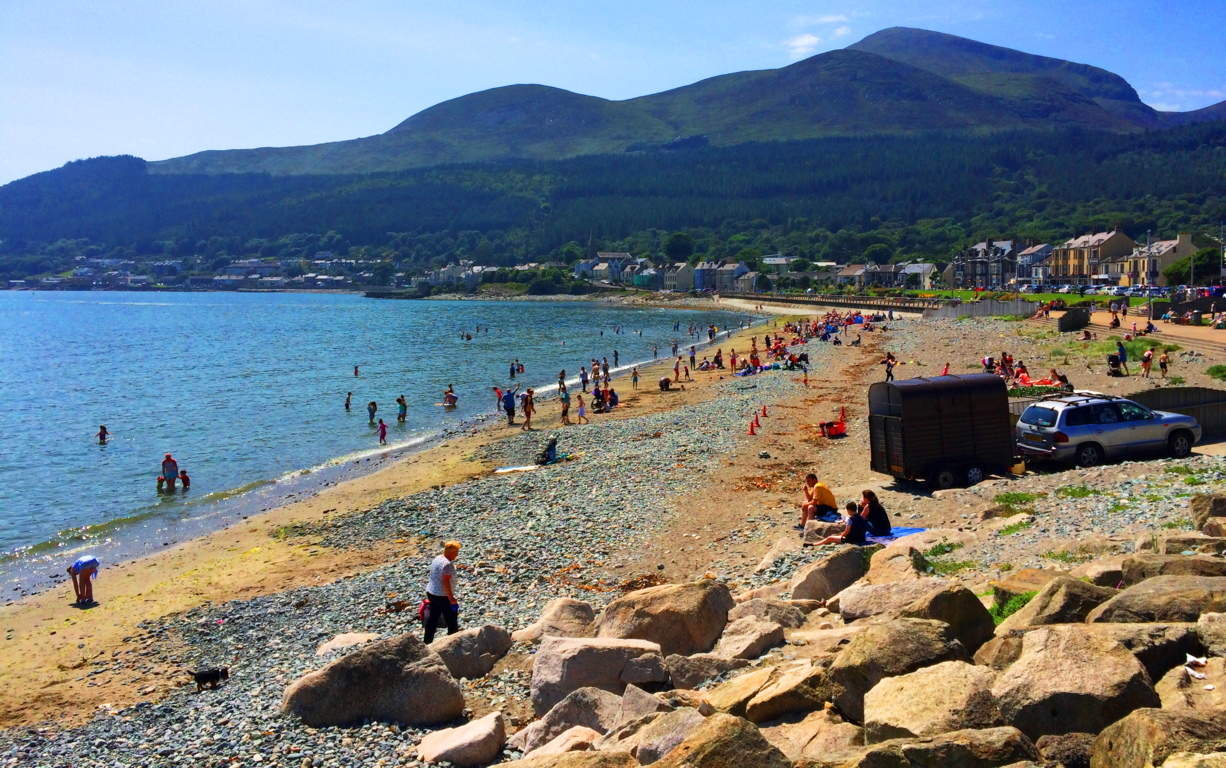 Travelers should know that there is no toll, or wall, separating the northeastern region from the rest of Ireland. The beautiful Irish landscape rolls through the entire Island unhindered, and you can pass from county to county freely, regardless of these modern distinctions.
Travelers should know that there is no toll, or wall, separating the northeastern region from the rest of Ireland. The beautiful Irish landscape rolls through the entire Island unhindered, and you can pass from county to county freely, regardless of these modern distinctions.
Note 3: A seekers approach to Donegal can definitely start with the Megaliths, among many other beautiful things from era’s past. The ancient monuments of Ireland, its Dolmens, Cairns, Standing Stones, Stone Temples, and Castles, are extremely important for trail-finders. Their initial quality of lending the deepest spiritual significance to the landscape is only the beginning of their impact; they also give hikers something significant to strive for, a goal beyond the typical tourist attractions i.e: places where the locals stare distantly from beyond the parking-lots. Often times, if you set your sights on a sacred site, those beautiful and impossible stones in the illusive distance, wonderful and unpredictable things will appear and happen along the way. An example of this is found on the wonderful trail high above Glenveagh Castle, in Glenveagh National Park. There is a totally unmarked Wedge Tomb in the most dramatic of places, right next to the elevated trail. Finding these relics is not only a natural rush, but it also supports the idea that someone lived in this specific area as far back as the Neolithic Period, and if you explore further, it is likely that you will find more magical anthropological statements, adding to the wonder and mystery of the scene. This Wedge Tomb had that special symmetry that so many Megaliths do (Image/Below)…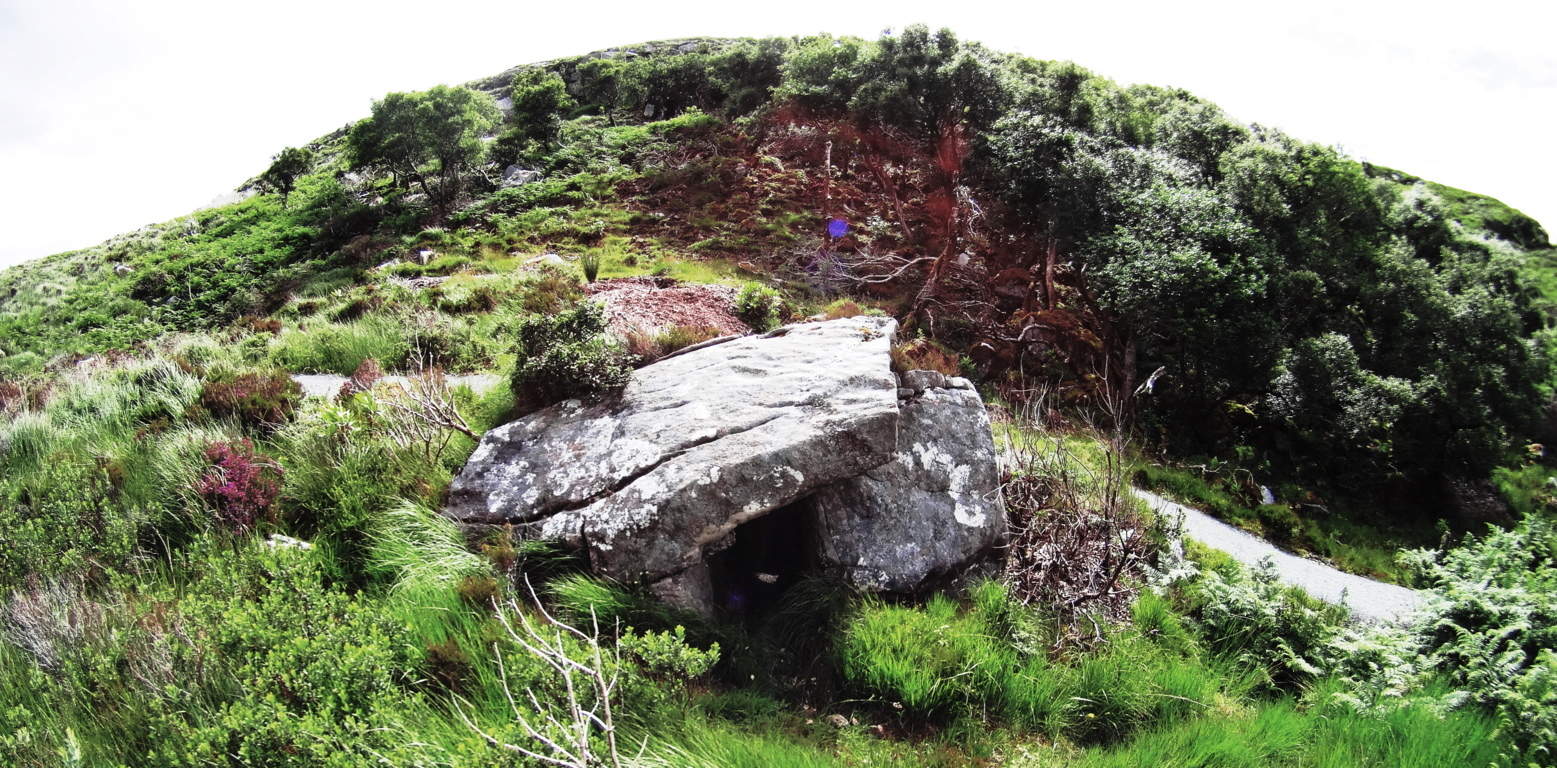 it is placed in the absolute center of the gully, and above an incredibly beautiful Glenveagh Lake. The view just 20 yards away from the Wedge Tomb, is truly spectacular with the Castle in the Frame. It is no wonder that an ancient group/culture found this spot to be a place worth living in, and claimed it with territorial stone statements. Incredible.
it is placed in the absolute center of the gully, and above an incredibly beautiful Glenveagh Lake. The view just 20 yards away from the Wedge Tomb, is truly spectacular with the Castle in the Frame. It is no wonder that an ancient group/culture found this spot to be a place worth living in, and claimed it with territorial stone statements. Incredible.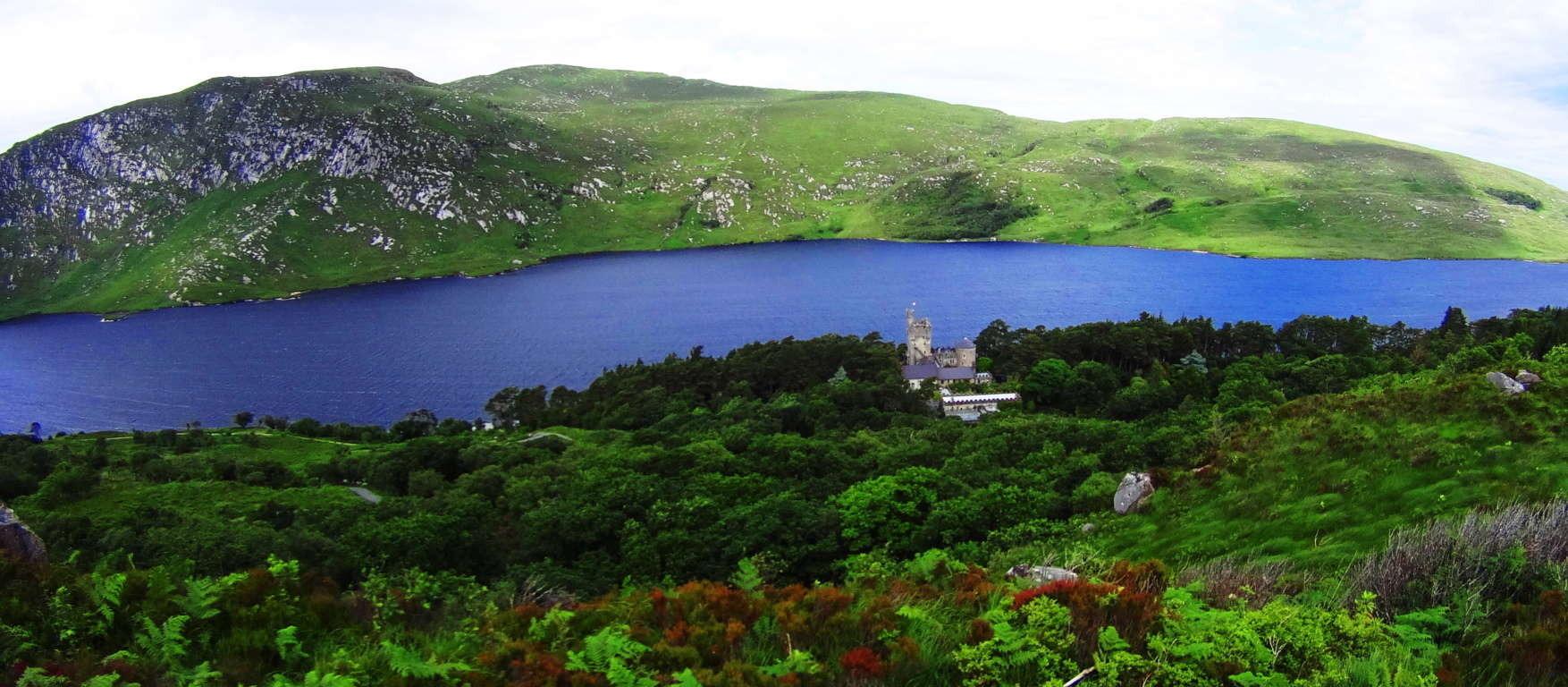 Other times, you can often be hiking and just around the next bend an incredible historic site will just appear practically out of nowhere, as Monea Castle did for me while hiking a roadside in Enniskillen on my way to Donegal.
Other times, you can often be hiking and just around the next bend an incredible historic site will just appear practically out of nowhere, as Monea Castle did for me while hiking a roadside in Enniskillen on my way to Donegal.
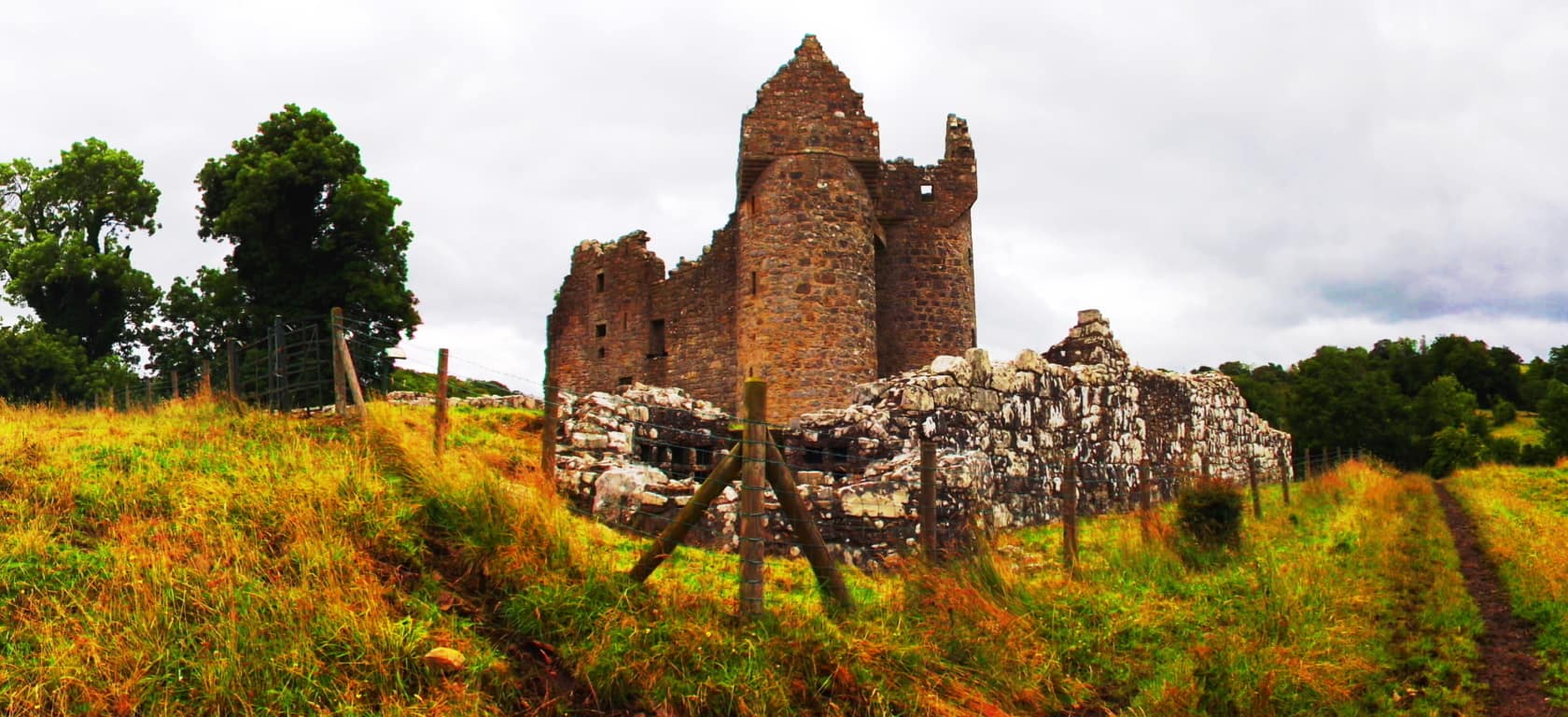 Walking towards a countryside castle like Monea is like wandering into a dream; often without another person for miles, with only the quiet stillness to picture the beautiful life-style that had taken place here hundreds of years ago. (Image/Above) Not far from this very same scene, continuing north on the A35 to enter Donegal from the South, you will discover the approach for Drumskinny Stone Circle. There is countryside for 15 miles in every direction when you arrive. The stillness is shocking. This is the epitome of Stones Circles in Ireland. Drumskinny is in a classic radial form, along with a linear extension of smaller stones, which are certainly worthy of a study beyond the scope of this article. Perhaps there is a celestial connection? Each stone is beautifully unique, like people, and yet the unify into one shape. These places of ancient ceremony have a vibe similar to that of visiting a relative over the landmark age of 100, that is: without words there is an amazing depth to the moment, however still and nearly silent the scene may be.
Walking towards a countryside castle like Monea is like wandering into a dream; often without another person for miles, with only the quiet stillness to picture the beautiful life-style that had taken place here hundreds of years ago. (Image/Above) Not far from this very same scene, continuing north on the A35 to enter Donegal from the South, you will discover the approach for Drumskinny Stone Circle. There is countryside for 15 miles in every direction when you arrive. The stillness is shocking. This is the epitome of Stones Circles in Ireland. Drumskinny is in a classic radial form, along with a linear extension of smaller stones, which are certainly worthy of a study beyond the scope of this article. Perhaps there is a celestial connection? Each stone is beautifully unique, like people, and yet the unify into one shape. These places of ancient ceremony have a vibe similar to that of visiting a relative over the landmark age of 100, that is: without words there is an amazing depth to the moment, however still and nearly silent the scene may be.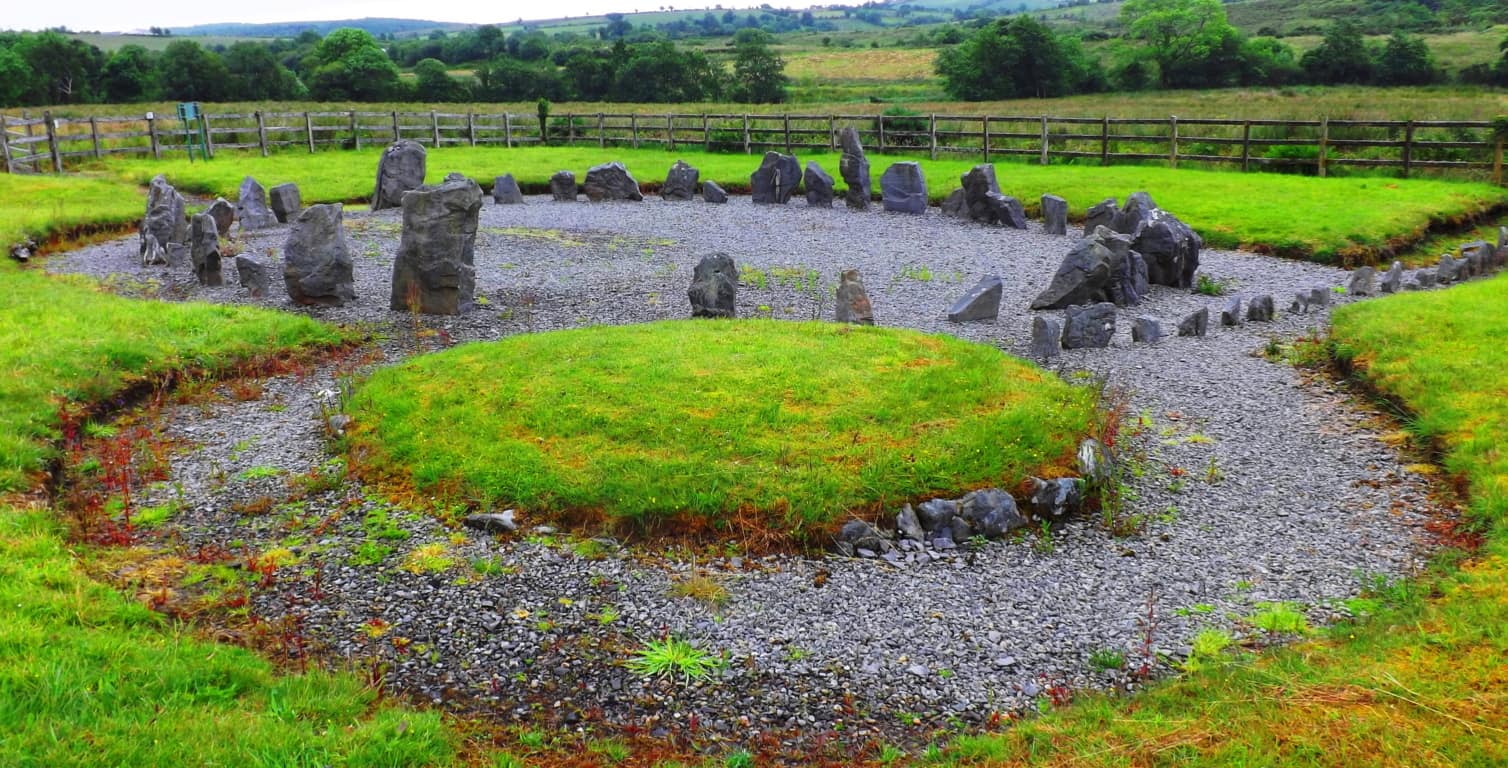 These are the places where the Celts had dwelt for centuries; generations of everyday farmers, householders, and small-business-owners are their descendants. They have survived countless struggles to remain connected to their homesteads. After visiting this beautiful place at the southern edge of Donegal, you will be ready to move North to a region where two Dolmens have stood since the beginning of History. Both the Gortnavern Dolmen, and the Kilclooney Dolmen, are located in County Donegal, and are fantastic options for a multifaceted adventures with a climactic focus.
These are the places where the Celts had dwelt for centuries; generations of everyday farmers, householders, and small-business-owners are their descendants. They have survived countless struggles to remain connected to their homesteads. After visiting this beautiful place at the southern edge of Donegal, you will be ready to move North to a region where two Dolmens have stood since the beginning of History. Both the Gortnavern Dolmen, and the Kilclooney Dolmen, are located in County Donegal, and are fantastic options for a multifaceted adventures with a climactic focus.
The Gortnavern Dolmen Excursion: The overall approach to reaching the Gortnavern Dolmen is just as significant as actually finding it. Major roads in Donegal are solitary and singular, while contrastingly, smaller roads often have no names, and lead to the farthest corners of enclosed hedges and fields that seem to go on forever. ‘Moneymore Road’ is a good example of the lessor road experience, located at the southern base of Mount Errigal. This little street gives a reclusive valley perspective of the entire enchanting area. An abandoned stone church sits in the shadow of the Mount Errigal beyond, a truly epic vision. The best and most beautiful approach to the Gortnavern Dolmen, is to pass by Mount Errigal, near Moneymore, and continue through Glenveagh National Park (Image/Below) along the incredible R251.
The best and most beautiful approach to the Gortnavern Dolmen, is to pass by Mount Errigal, near Moneymore, and continue through Glenveagh National Park (Image/Below) along the incredible R251.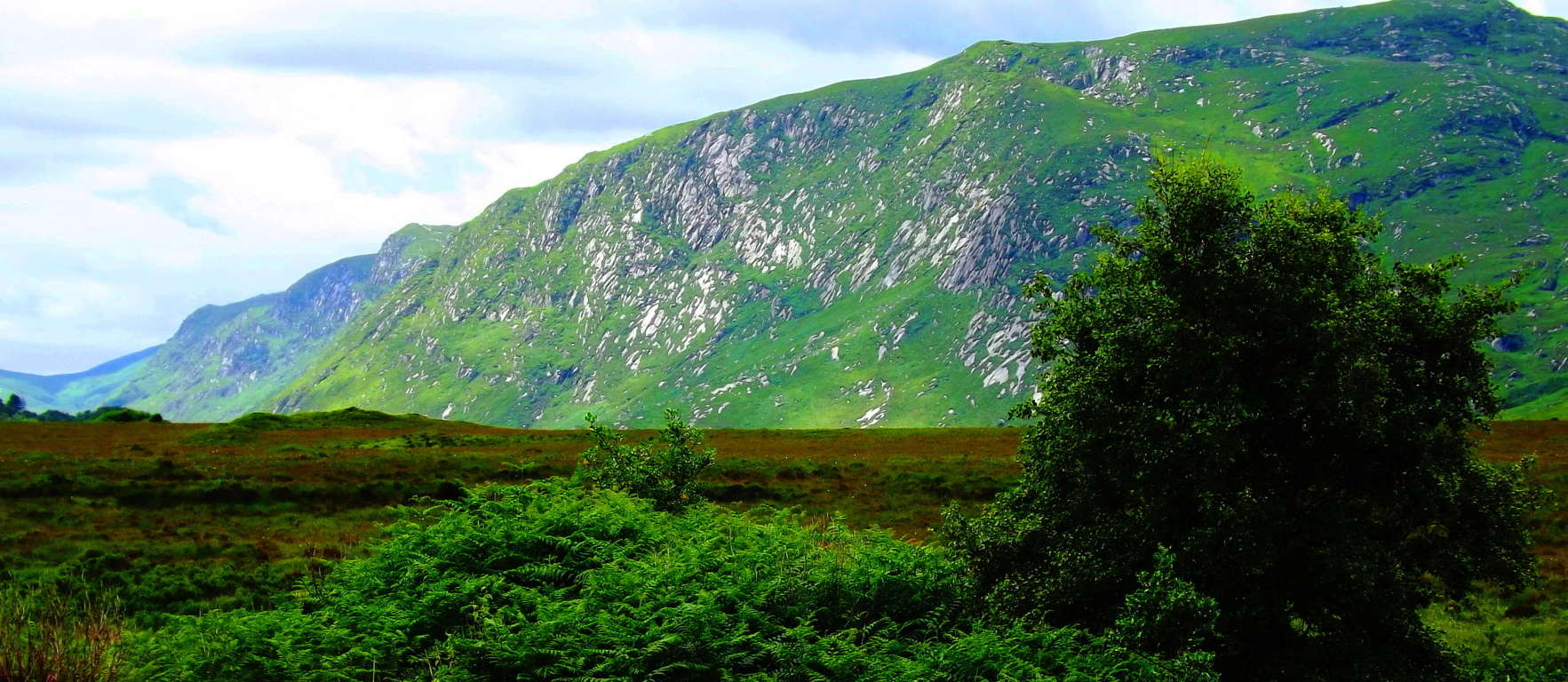 This is a once-in-a-lifetime-drive. From the Hamlet of Mullaghduff the entire R251 scene can be viewed. (Image/Below)
This is a once-in-a-lifetime-drive. From the Hamlet of Mullaghduff the entire R251 scene can be viewed. (Image/Below)
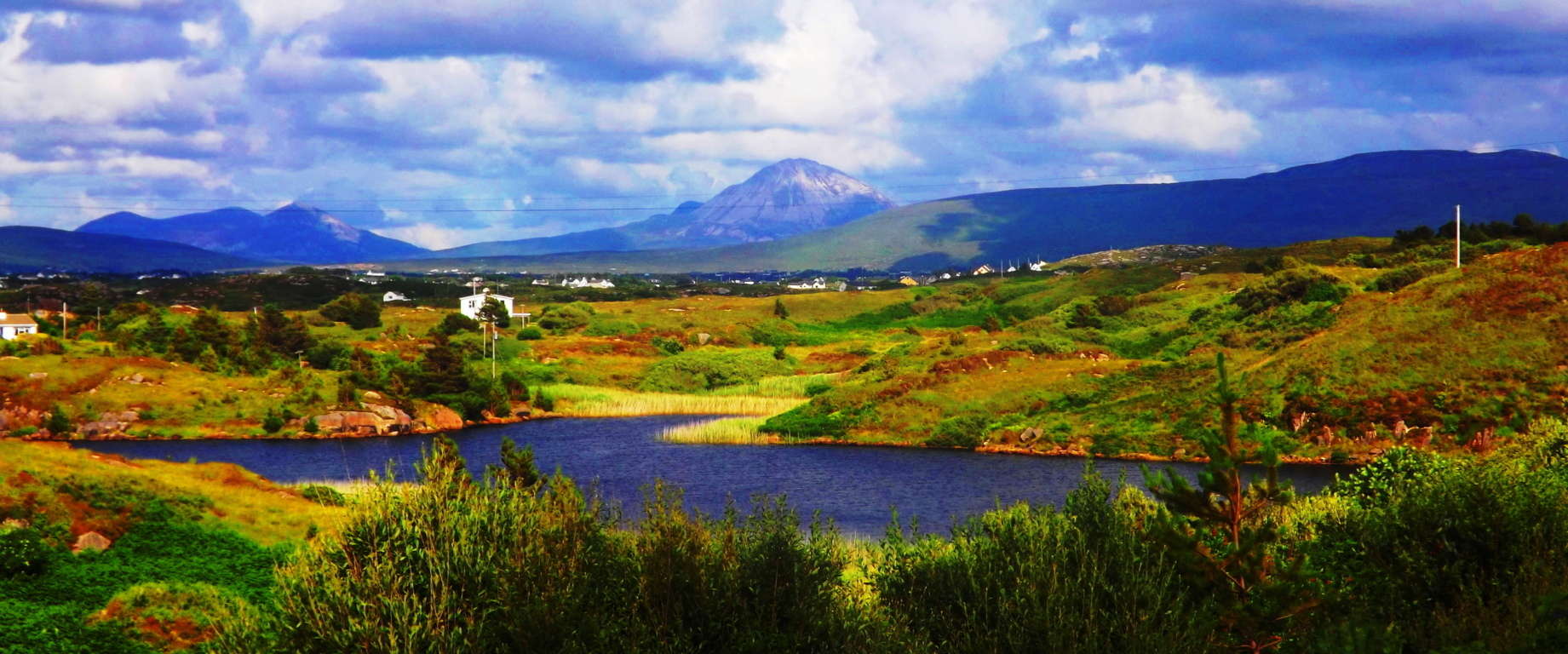 In hamlet of Mullaghduff there are beautiful free-standing boulders in gorgeous places (Image/Below), and incredible lowland waterfalls that are totally untouched, all in their original state.
In hamlet of Mullaghduff there are beautiful free-standing boulders in gorgeous places (Image/Below), and incredible lowland waterfalls that are totally untouched, all in their original state. This waterfall (Image/Below), just off the road, doesn’t even have a path or an approach; you simply have to wade through the hedges to get close. I believe that this is a megalithic altar from antiquity, and fully engineered. Look at the fixtures of the interlocked stones; they are clearly “cut-to-fit” and rounded to create a beautiful and massively harnessed release point for the flowing water. Incredible. The entire landscape is enchanted; it truly is.
This waterfall (Image/Below), just off the road, doesn’t even have a path or an approach; you simply have to wade through the hedges to get close. I believe that this is a megalithic altar from antiquity, and fully engineered. Look at the fixtures of the interlocked stones; they are clearly “cut-to-fit” and rounded to create a beautiful and massively harnessed release point for the flowing water. Incredible. The entire landscape is enchanted; it truly is.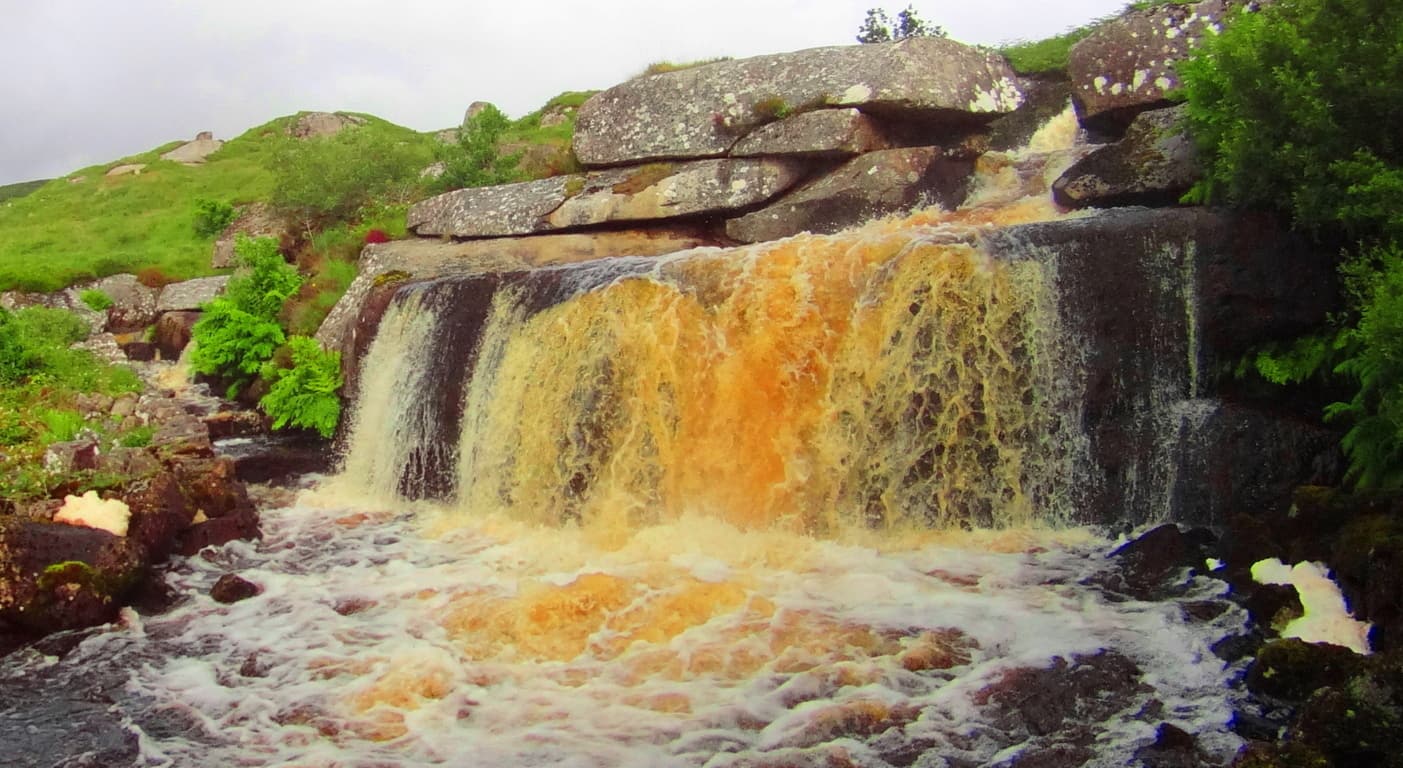 So bring your hiking gear/tall-boots, and be ready to trudge away in order to get close to something beautiful in Donegal. Continuing on, the Gortnavern Dolmen (Image/Below) is only 4 miles from the center of Kerrykeel.
So bring your hiking gear/tall-boots, and be ready to trudge away in order to get close to something beautiful in Donegal. Continuing on, the Gortnavern Dolmen (Image/Below) is only 4 miles from the center of Kerrykeel. Along the road to Kerrykeel there are local vegetable stands ( 2nd Image/Below/Left) and craft shops. Stop by and converse with these local people! The Irish of Donegal are a people who have lived on the distant northwestern edge of Europe’s continental crossroads for what is now thousands upon thousands of years; take a moment for these unique and amazing souls. Even the small things the Irish country-folk have to do and say, may strike you as rare subtle wisdom, especially when compared to the placative and manic normalities of American and European Post-Modern life. The Gortnavern Dolmen is tucked beautifully into an elevated set of hills, south of the darkly soiled ‘Mount Ranny.’ (You must follow a country road with a small sign for the Dolmen, and then a left onto another country road, above a farm/ i.e: exact instructions to get to the Dolmen are in the “Gortnavern” article of Stonestrider.com, in the ‘Ireland’ section)
Along the road to Kerrykeel there are local vegetable stands ( 2nd Image/Below/Left) and craft shops. Stop by and converse with these local people! The Irish of Donegal are a people who have lived on the distant northwestern edge of Europe’s continental crossroads for what is now thousands upon thousands of years; take a moment for these unique and amazing souls. Even the small things the Irish country-folk have to do and say, may strike you as rare subtle wisdom, especially when compared to the placative and manic normalities of American and European Post-Modern life. The Gortnavern Dolmen is tucked beautifully into an elevated set of hills, south of the darkly soiled ‘Mount Ranny.’ (You must follow a country road with a small sign for the Dolmen, and then a left onto another country road, above a farm/ i.e: exact instructions to get to the Dolmen are in the “Gortnavern” article of Stonestrider.com, in the ‘Ireland’ section)
This is a 4000 to 6000 year old Portal-Tomb with a massive Capstone which faces the gorgeous Gortnatraw Mountain.(Image/Above) It is a rugged hilltop tapestry; a tangible infinity of farms and hedges amazingly complimented by the intentional angles of these ancient stones; stones that I believe were built to tantalize our perspective.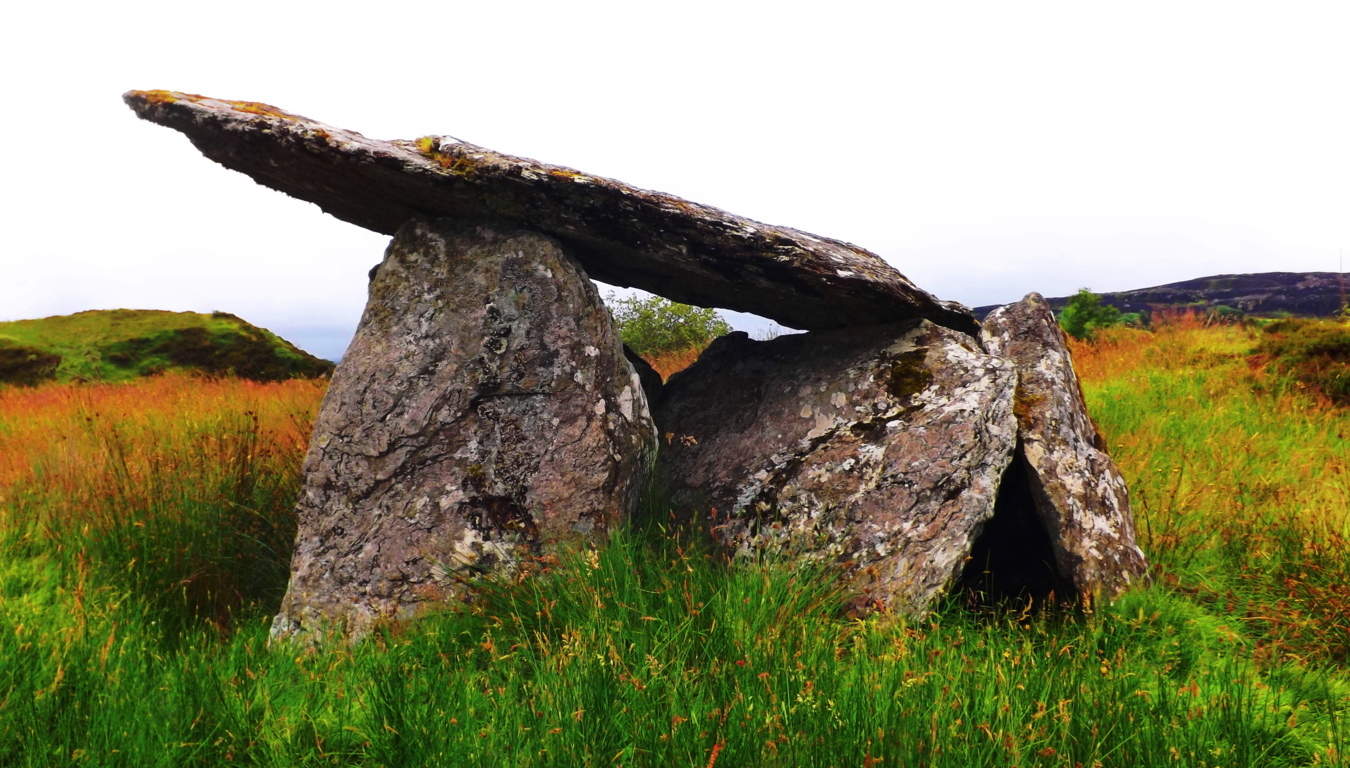 Perhaps 700 generations have passed since the construction of this monument. Dolmens, at this modern point in history, are more rare than any section of amazon forest; at greater risk of extinction than the Orca; and are as rare as a blue diamond. If you see a Dolmen you are truly touching something priceless.
Perhaps 700 generations have passed since the construction of this monument. Dolmens, at this modern point in history, are more rare than any section of amazon forest; at greater risk of extinction than the Orca; and are as rare as a blue diamond. If you see a Dolmen you are truly touching something priceless.  ( Again, for the more detailed instructions on how to get to the Gorntavern Dolmen please see the “Gortnavern” section in the ‘Ireland’ category of Stonestrider.com, or: https://stonestrider.com/2016/11/07/gortnavern/
( Again, for the more detailed instructions on how to get to the Gorntavern Dolmen please see the “Gortnavern” section in the ‘Ireland’ category of Stonestrider.com, or: https://stonestrider.com/2016/11/07/gortnavern/
Now let’s wander in an entirely different direction.
The Kilclooney Dolmen Excursion: Mount Errigal could be considered the epicenter of County Donegal. It helps to describe the many features of Donegal in reference to its beautiful white peak. The countryside to the East, which heads toward the Gortnavern Dolmen, is an inland scene of enchanted mountains and rolling valleys. The countryside to the South, which leads toward the Kilclooney Dolmen, is a different experience entirely, a coastal scene of cliffs, crescent beaches, rocky caverns, and an amazingly iconographic waterfall. From Errigal head South along the N56 to the R261. The R261 will take you to the Kilclooney Dolmen Centre, where you can take the short hike to the Dolmen. Not far from the Centre, at the farm house just up the road on R261, is an almost hidden, practically forgotten set of stones that was once a beautiful Wedge Tomb. It is unmarked by the side of the road, and clearly, once upon a time, a capstone was balanced above the supporting stones. Amazing. It is just an indicator that there are sacred things, seen, and unseen, all around you here. The entire landscape is a type of natural “temple”, a once synergized region accentuated by stone fixtures that we are still trying to understand in these late Modern times.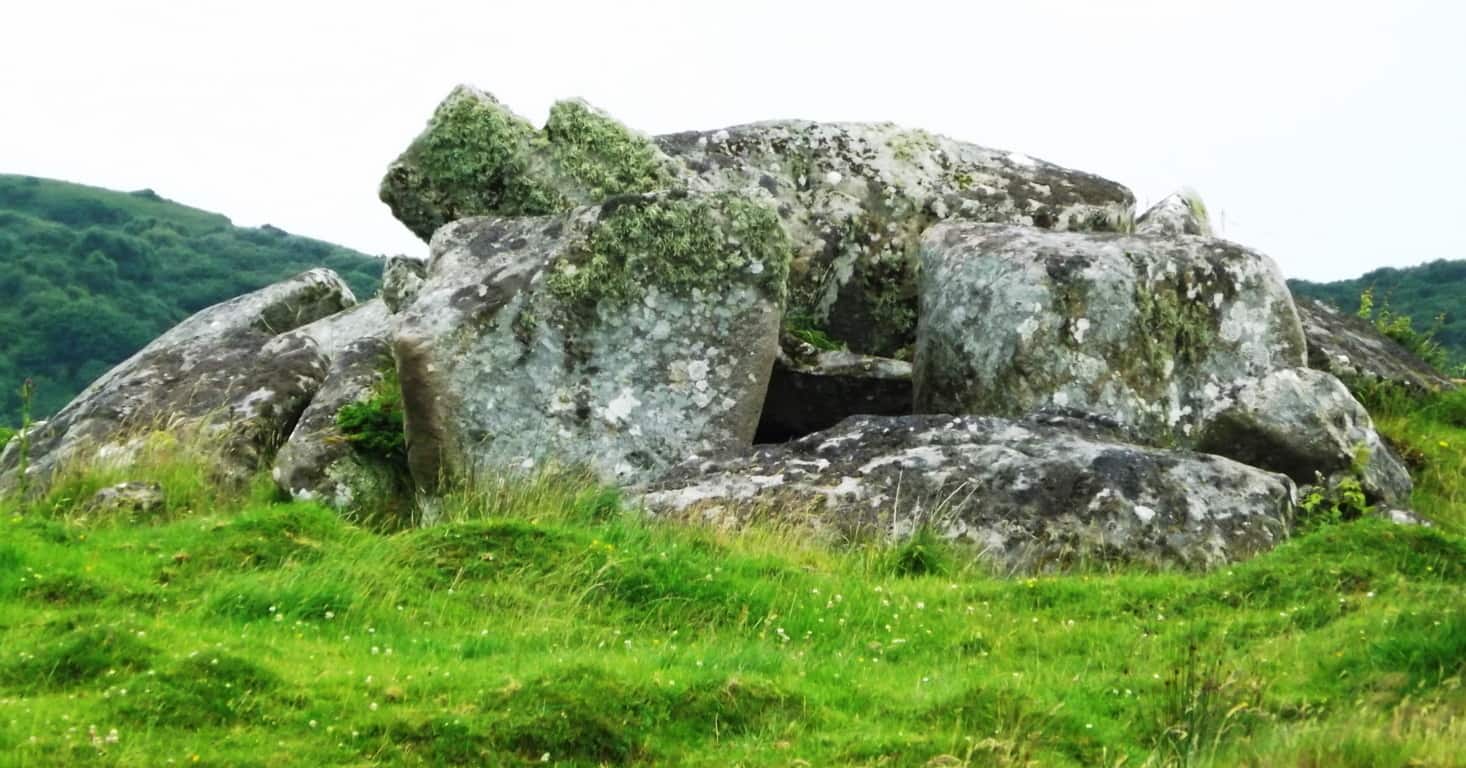 Before you start hiking here, wear ‘tall boots’! Having the right boots is the difference between a challenging experience, or something challengingly wonderful. As is the case with so many indigenous ancient sites, there is not a ‘standard path’ to the Megalith, you simply have to see the Dolmen about 150 yards behind the farmhouse and make your way towards it. For those who understand how wonderful this experience is, the non-commercial experience, the chance to laugh increases and releases with each and every Irish-as-hell step. These are truly special moments in a literally sacred Irish countryside. The terrain here is mossy, with brackish water mixed into tall-brush, and sandy dunes. Your ‘tall boots’ will make an easy walk through the terrain, right up to the ancient stone-lining which runs directly to the Dolmen and Wedge Tomb; they sit atop a small knoll covered with wildflowers and tough moss. Here is a prime example of how stones that look like a “wall” leading up to the Dolmen and Wedge Tomb, are certainly not a wall. These stones are a “Lining”; a veritable cable made of stones, which connects sacred site to sacred site, just like in New England. These stones were never, by definition, a “wall”. The stones of the Lining’ couldn’t stop a single thing passing through this country side, and it was never meant to. The Lining’ is part of an over all scene, all of the same Period, and most likely created by the same individual(s) as an “energy center” for the over-all scene.
Before you start hiking here, wear ‘tall boots’! Having the right boots is the difference between a challenging experience, or something challengingly wonderful. As is the case with so many indigenous ancient sites, there is not a ‘standard path’ to the Megalith, you simply have to see the Dolmen about 150 yards behind the farmhouse and make your way towards it. For those who understand how wonderful this experience is, the non-commercial experience, the chance to laugh increases and releases with each and every Irish-as-hell step. These are truly special moments in a literally sacred Irish countryside. The terrain here is mossy, with brackish water mixed into tall-brush, and sandy dunes. Your ‘tall boots’ will make an easy walk through the terrain, right up to the ancient stone-lining which runs directly to the Dolmen and Wedge Tomb; they sit atop a small knoll covered with wildflowers and tough moss. Here is a prime example of how stones that look like a “wall” leading up to the Dolmen and Wedge Tomb, are certainly not a wall. These stones are a “Lining”; a veritable cable made of stones, which connects sacred site to sacred site, just like in New England. These stones were never, by definition, a “wall”. The stones of the Lining’ couldn’t stop a single thing passing through this country side, and it was never meant to. The Lining’ is part of an over all scene, all of the same Period, and most likely created by the same individual(s) as an “energy center” for the over-all scene. 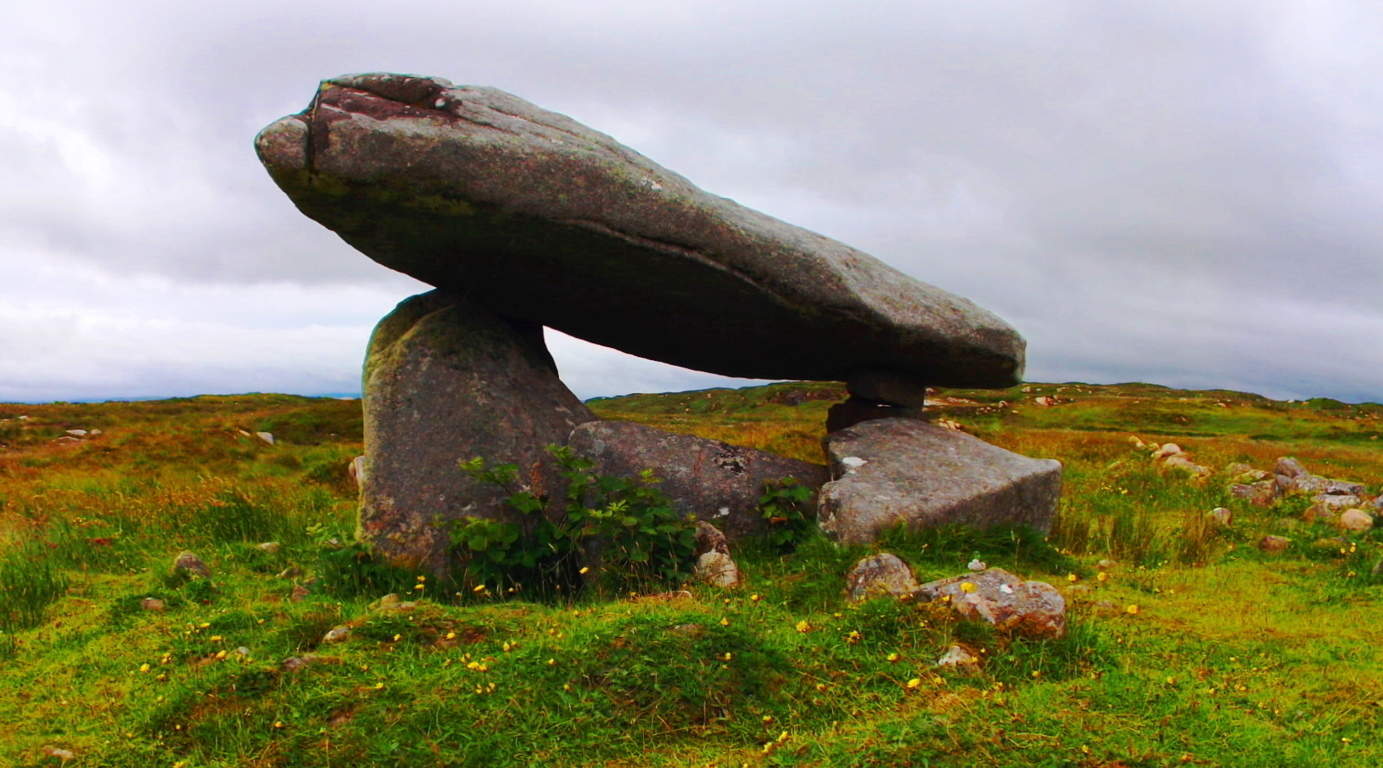 With the Atlantic Ocean only a mile or so beyond, the air here is medicinally salty. This “beach-day breeze” inundates everything, from the moss and grass, to the Dolmen’s very stones. This is an above average size Dolmen, with a massive “satellite-dish-like” 20 ton Capstone. This Capstone is balanced, and set roughly 5 feet above the ground. There is a slightly dilapidated Wedge Tomb with a 5 ton Cap-stone just ten yards away. This Wedge Tomb is no less priceless or significant in an archaeological sense, and certainly beautiful in its own right.
With the Atlantic Ocean only a mile or so beyond, the air here is medicinally salty. This “beach-day breeze” inundates everything, from the moss and grass, to the Dolmen’s very stones. This is an above average size Dolmen, with a massive “satellite-dish-like” 20 ton Capstone. This Capstone is balanced, and set roughly 5 feet above the ground. There is a slightly dilapidated Wedge Tomb with a 5 ton Cap-stone just ten yards away. This Wedge Tomb is no less priceless or significant in an archaeological sense, and certainly beautiful in its own right.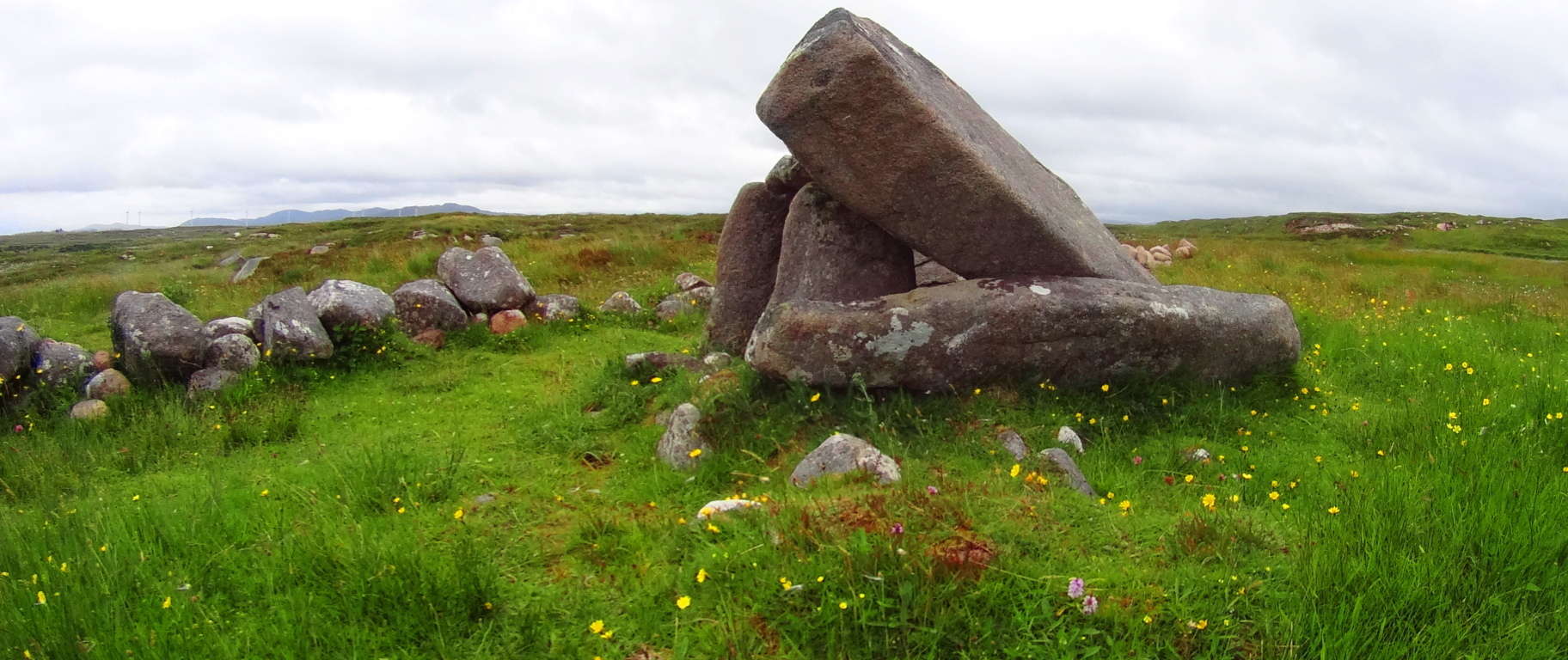 Again, like Gortnavern, Poulnabrone, and the dozen or so remaining in-situ Dolmens in Ireland, Kilclooney is roughly 4000 to 6000 years old, and a unique version of the classic Portal Tomb. This is a place to sit and contemplate the scope of Time, the magical possibilities implied by the Stones, and the luck of being alive to see them.
Again, like Gortnavern, Poulnabrone, and the dozen or so remaining in-situ Dolmens in Ireland, Kilclooney is roughly 4000 to 6000 years old, and a unique version of the classic Portal Tomb. This is a place to sit and contemplate the scope of Time, the magical possibilities implied by the Stones, and the luck of being alive to see them.
Assaranca Waterfall: Like so many highways in other countries, certain roads simply become other roads, or have two names. After taking in the experience of the Kilclooney Dolmen site, you should continue driving to see the beautiful Assaranca Waterfall on the R261 South, which simply becomes the N56. Not far passed “Northwest Sea Kayaking” business, along the N56, just passed a beautiful white house with a red door, is a road with no name. It is a right-turn road with signs that point and say: “Tra Strand”/Uaimh Caves/Eas’ Waterfall 6 km/: standing clearly for all to see. Take the Right onto this classic Irish road and enjoy the short drive to the beautiful Assaranca Waterfall.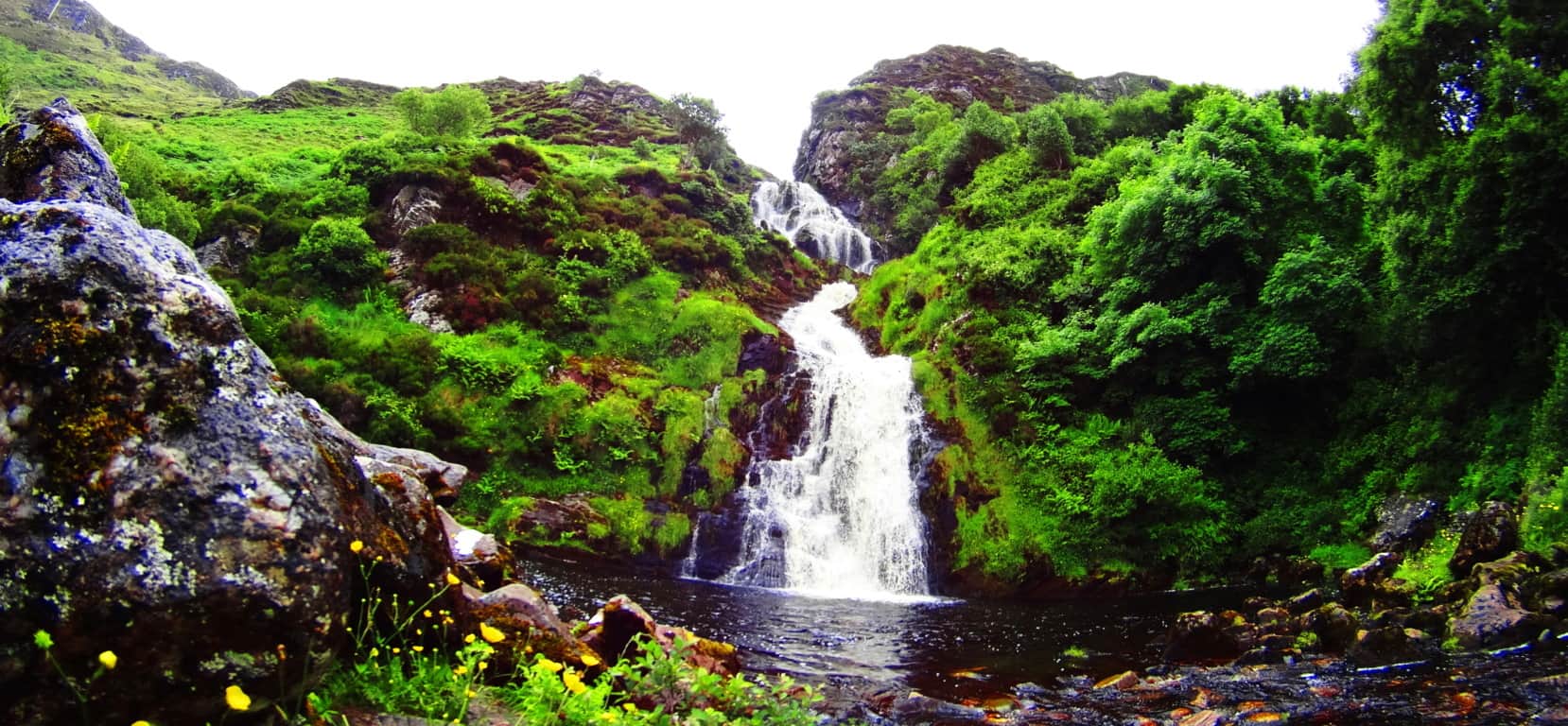 The roads here are the hiking trails. This gorgeous region is known as Lackaduff. You can park your car at the waterfall and begin a beautiful hike towards the massive caves within the beautifully looming cliffs, all about 2 miles further up the lane. Small mountains encompass this rugged bay-route pathway, with adorable homes and fields of wildflowers, along with flocks of sheep.
The roads here are the hiking trails. This gorgeous region is known as Lackaduff. You can park your car at the waterfall and begin a beautiful hike towards the massive caves within the beautifully looming cliffs, all about 2 miles further up the lane. Small mountains encompass this rugged bay-route pathway, with adorable homes and fields of wildflowers, along with flocks of sheep. 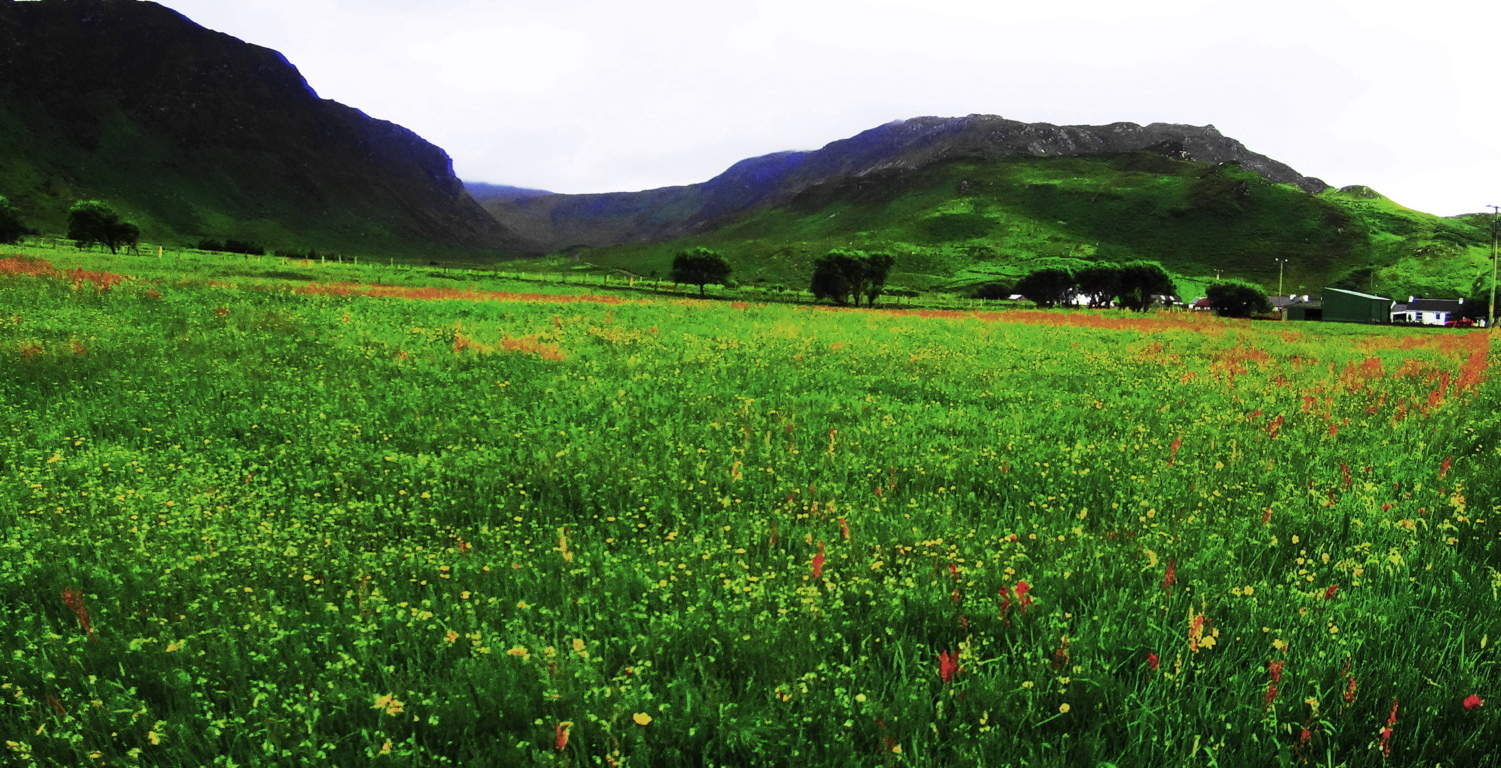 These are working farmers and fisherman in the area; they are not on vacation, so please be kind to those you meet, whoever that may be. Soon you will arrive to the beach…
These are working farmers and fisherman in the area; they are not on vacation, so please be kind to those you meet, whoever that may be. Soon you will arrive to the beach…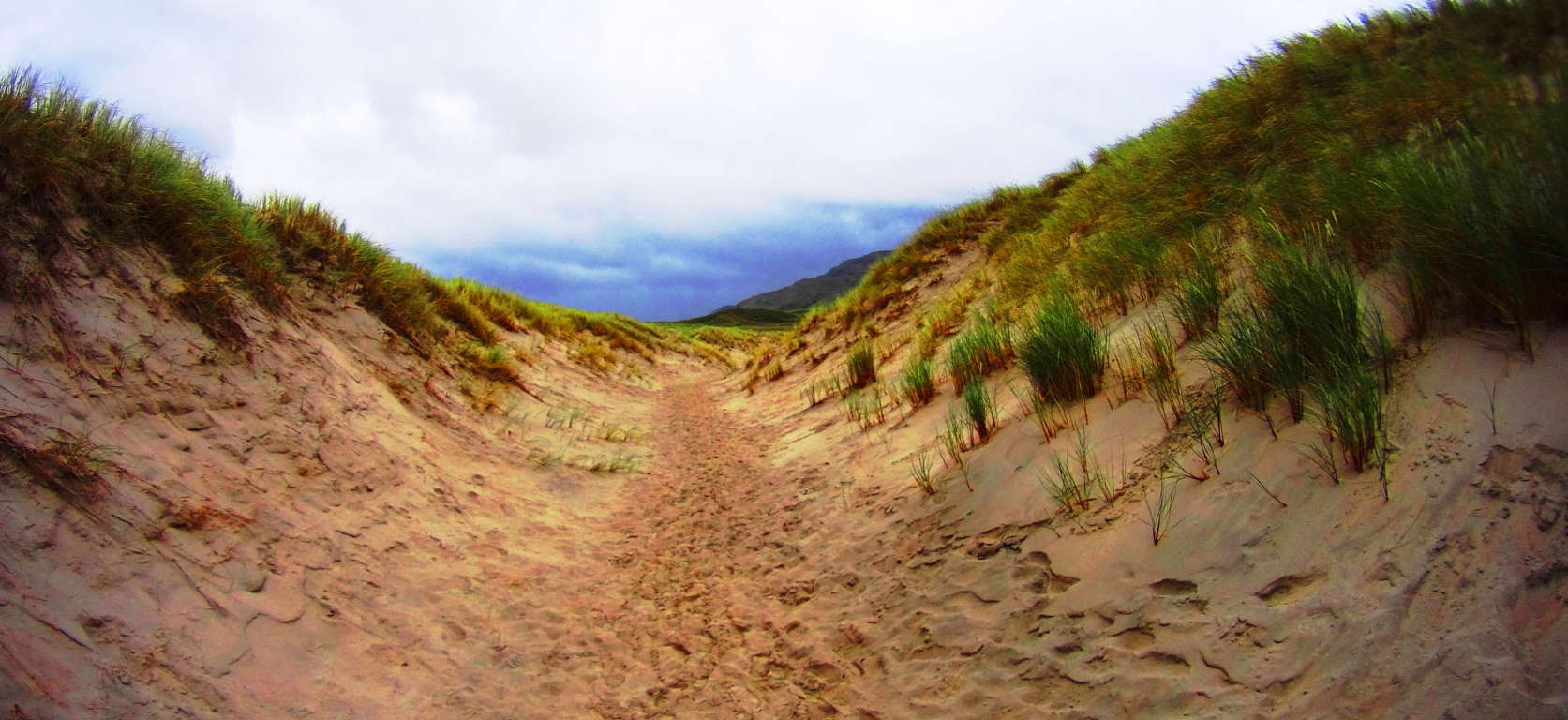 When you arrive take the path into the sand-dunes just at the end of the lane, and head out to the beach toward the caves (on the left.) As other places have been described in Stonestrider.com, this place looks like the perfect Jedi hideaway, perhaps to be found only by the most devout of disciples.
When you arrive take the path into the sand-dunes just at the end of the lane, and head out to the beach toward the caves (on the left.) As other places have been described in Stonestrider.com, this place looks like the perfect Jedi hideaway, perhaps to be found only by the most devout of disciples.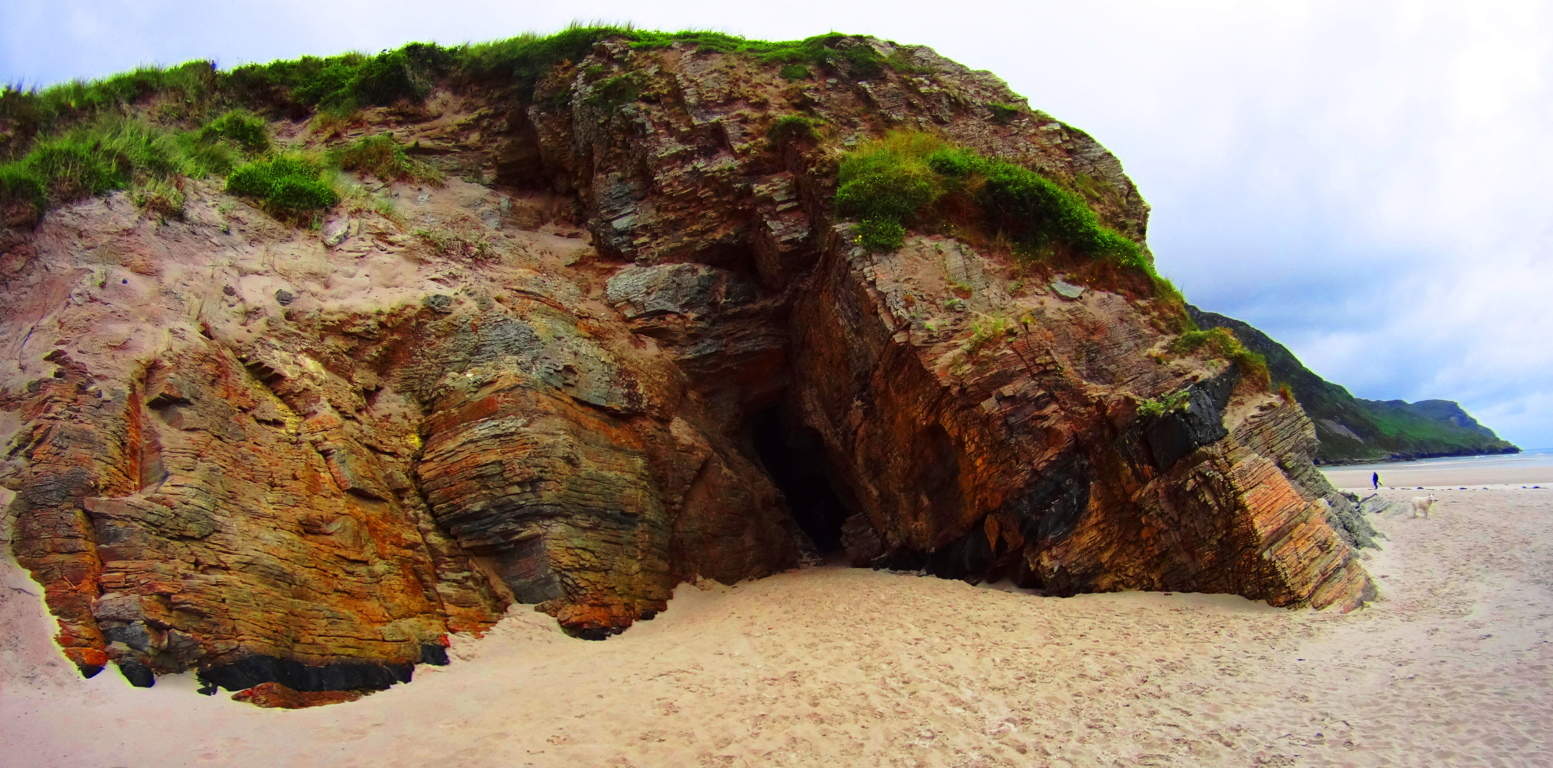 The colors here; the glassy Atlantic Ocean against the super-fine sand; the cliffs and caves under a cloud-sized blanket of green; they create a living canvas that just pours out an absolutely radiating beauty.
The colors here; the glassy Atlantic Ocean against the super-fine sand; the cliffs and caves under a cloud-sized blanket of green; they create a living canvas that just pours out an absolutely radiating beauty. 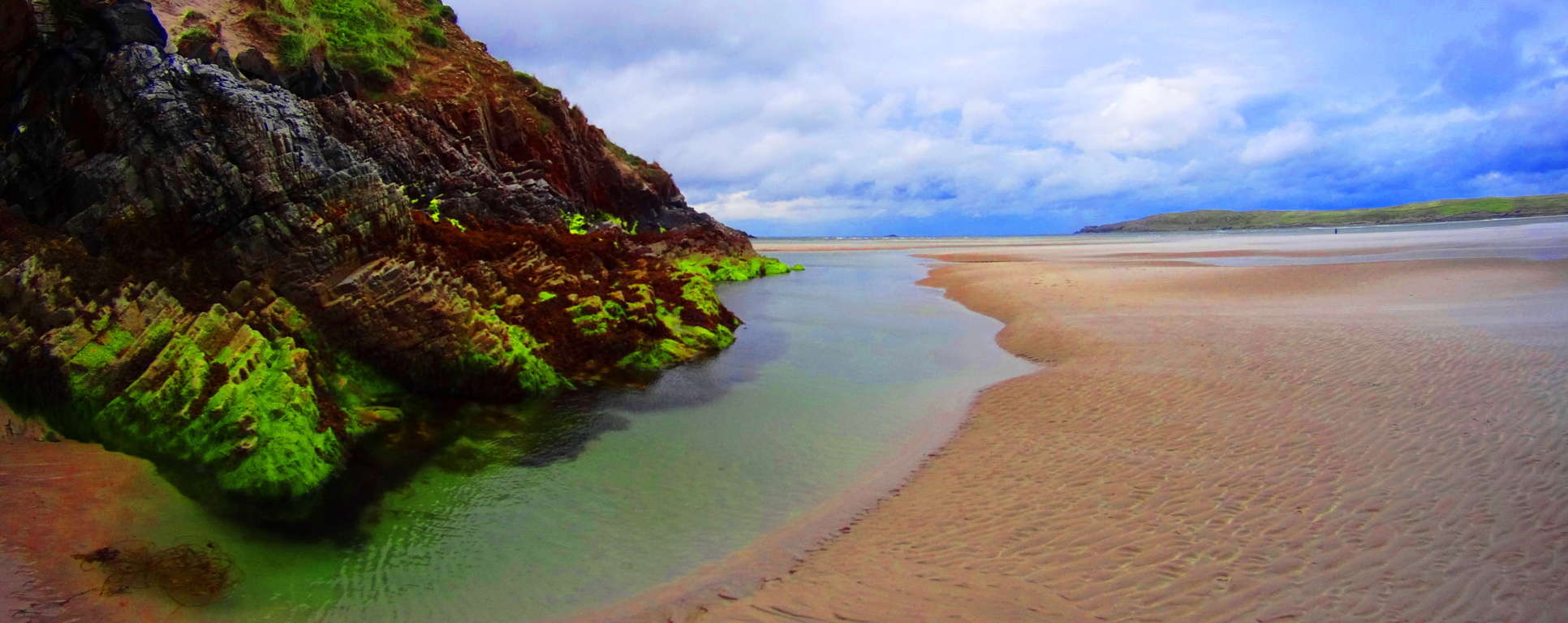
Last Note: Donegal is both rugged and radiant in one. There are striking scenes of mountains that just cut the sky with white stone peaks; there are rolling green ranges of mountain after mountain, after mountain.
 Eventually these mountains slam into a crystalline Atlantic Ocean. The Dolmens in Donegal indicate that the culture of the region is as old as Time itself. Wandering into this County is equivalent to wading into a Celtic Tsunami. The beauty is overwhelming. In every direction there is a pastoral dimension which is vividly painted in every possible variation of green.
Eventually these mountains slam into a crystalline Atlantic Ocean. The Dolmens in Donegal indicate that the culture of the region is as old as Time itself. Wandering into this County is equivalent to wading into a Celtic Tsunami. The beauty is overwhelming. In every direction there is a pastoral dimension which is vividly painted in every possible variation of green.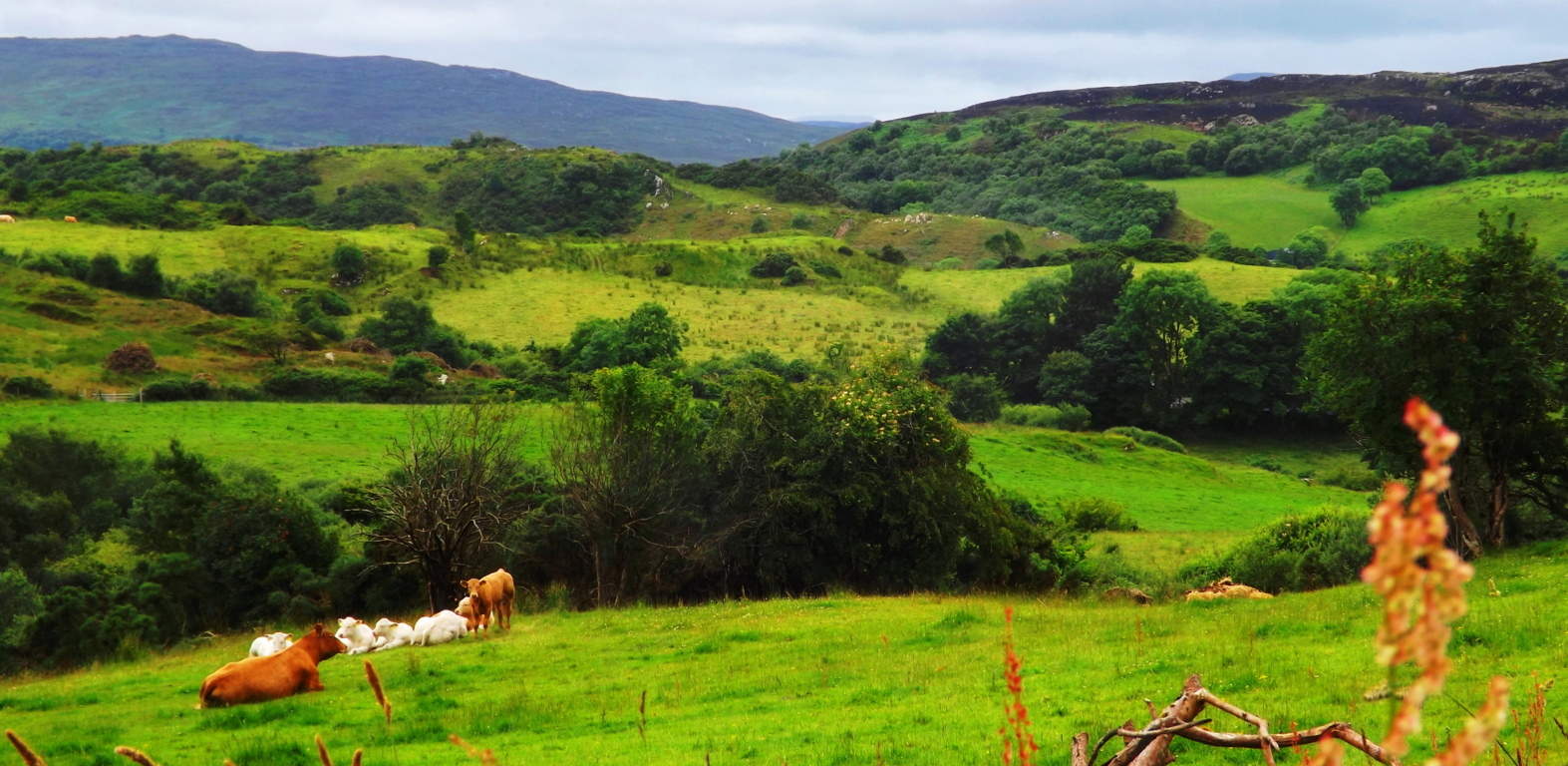
Donegal is so connected to the land, that the entire region is a ‘trail’. You don’t look for “the trail” at ‘Ranny’, the little dark mountain (Image/Below) which sits a valley away from the Gortnavern Dolmen; you simply climb the mountain. The mountain IS THE TRAIL.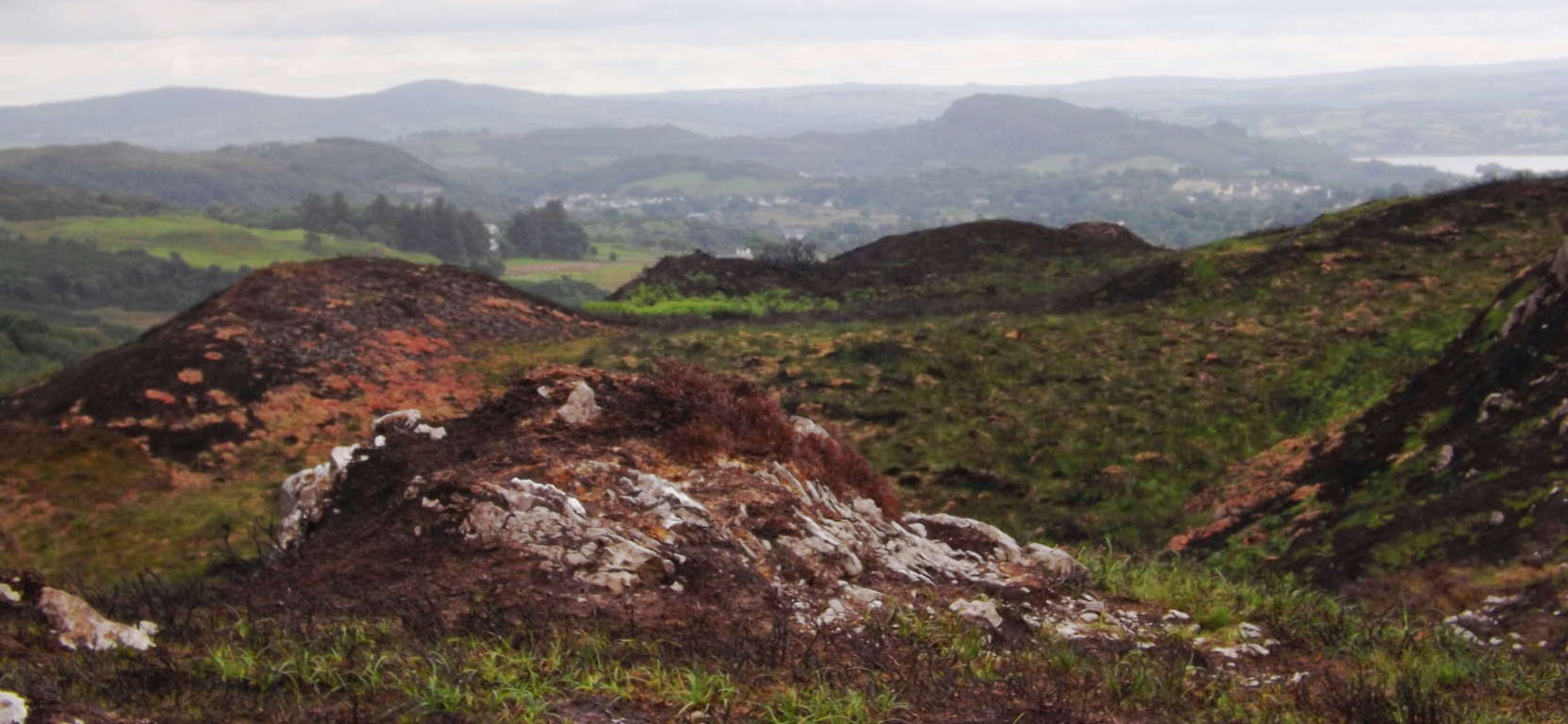 Donegal feels like the landscape that never told a lie. It is the last European coastline upon the vast Atlantic Ocean which cuts jagged jade cliffs into what was for centuries the edge of the known world. Come out and stand on the edge. Seek and Find.
Donegal feels like the landscape that never told a lie. It is the last European coastline upon the vast Atlantic Ocean which cuts jagged jade cliffs into what was for centuries the edge of the known world. Come out and stand on the edge. Seek and Find.
Mount Bearnagh
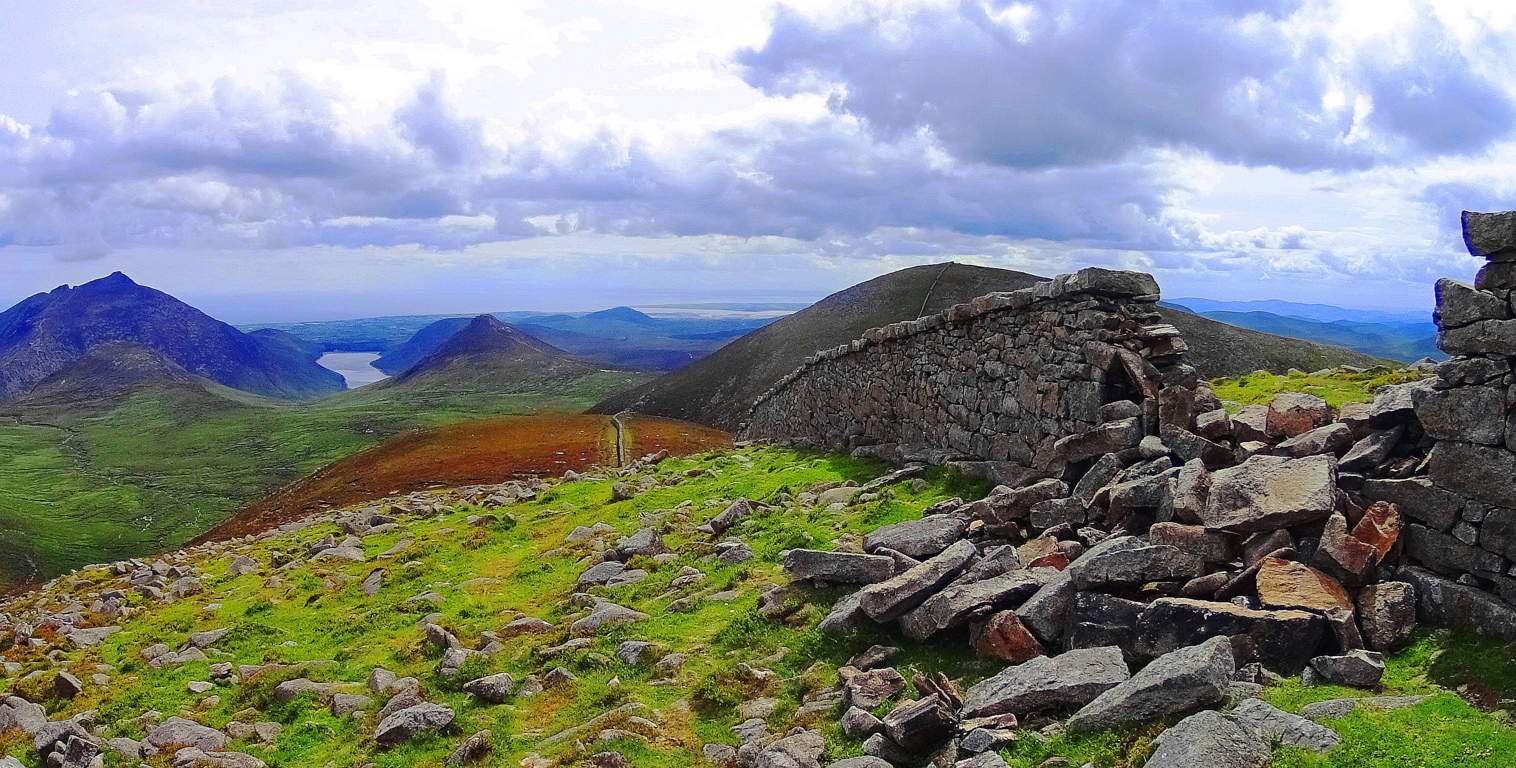
Location: Newry/Northern Ireland/U.K
Elevation: 2,385 ft
Note: In an almost hidden pocket of Northern Ireland, several hours drive north of Dublin, along the Irish Sea, sits the majestic Mourne Mountain Range. This is a region of beautiful mid-size peaks with approaches that are for everyone, not just the highly trained. The hike here includes a 4000 year old stone pathways which elevates steadily and comfortably into the heights. These ancient trails run beside wide streams and ledges that roll playfully down from the rocky mountain passes, and feel cool and comfortable in this northern latitude. In the heights of the mountains are cinematically continuous stone walls which stretch surreally from peak to peak, like a “Rangers Highway”. There are stunning ancient stone statements here as well. Original stoneworks here date back to the first culture, a culture which left its mark on this hauntingly beautiful place, perhaps 6000 years ago, or more. The southern face of Mount Bearnagh has a distinct ‘top porch’ which is level at the peak, with similarly sloping sides, giving the entire face a symmetrical feel. If you look close at the image below you may think its hard to find me in such a massive space; but redirect your eye to the exact center of the overall mountain, then follow that center line down to the stream, and you will see me standing at that exact center line of the scene. I am leaning a little to my right just enough to put my right eye along that center line; indicating that its possible to see potential symmetries in even the grandest spots.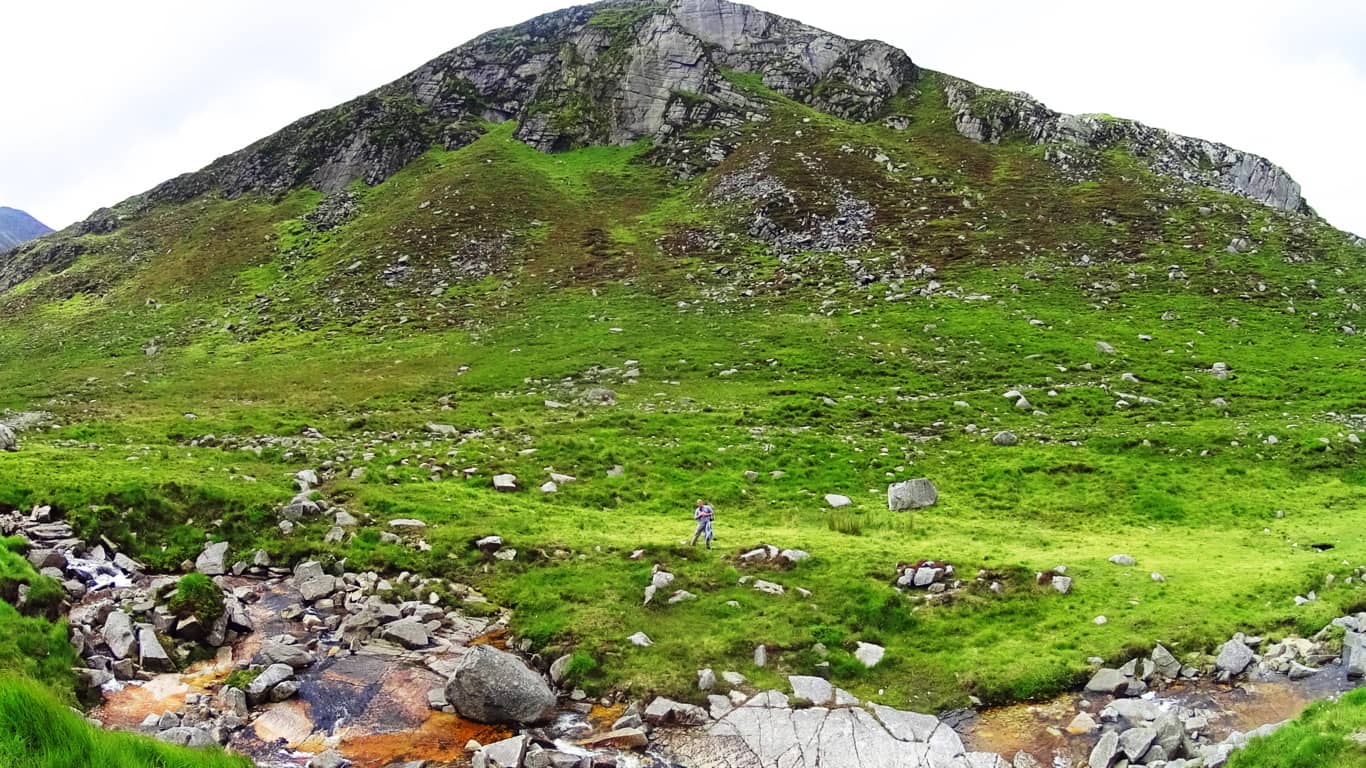
I did the same thing at the ‘center point’ of Bear’s Den Fall’s in Massachusetts (See Bear’s Den/New England/Stonestrider.com), in order to illustrate the central alignment at a specially engineered site, which in this instance is easier to see from close range. The reason for leaning on the ‘center lines’ of potentially symmetrical scenes is to acknowledge the possibility of a mathematical consideration of the overall space, which often leads to real breakthroughs in identifying Neolithic statements. The works of Neolithic craftsman reveal that they were absolutely aware of geometric principles and symmetries. Like Feng Shui, Neolithic symmetries, and spacial statements, create beauty and tranquility in any type of scene. Mount Bearnagh is part of majestically enchanted Range where Neolithic statements continue to increase the further up the valley you go.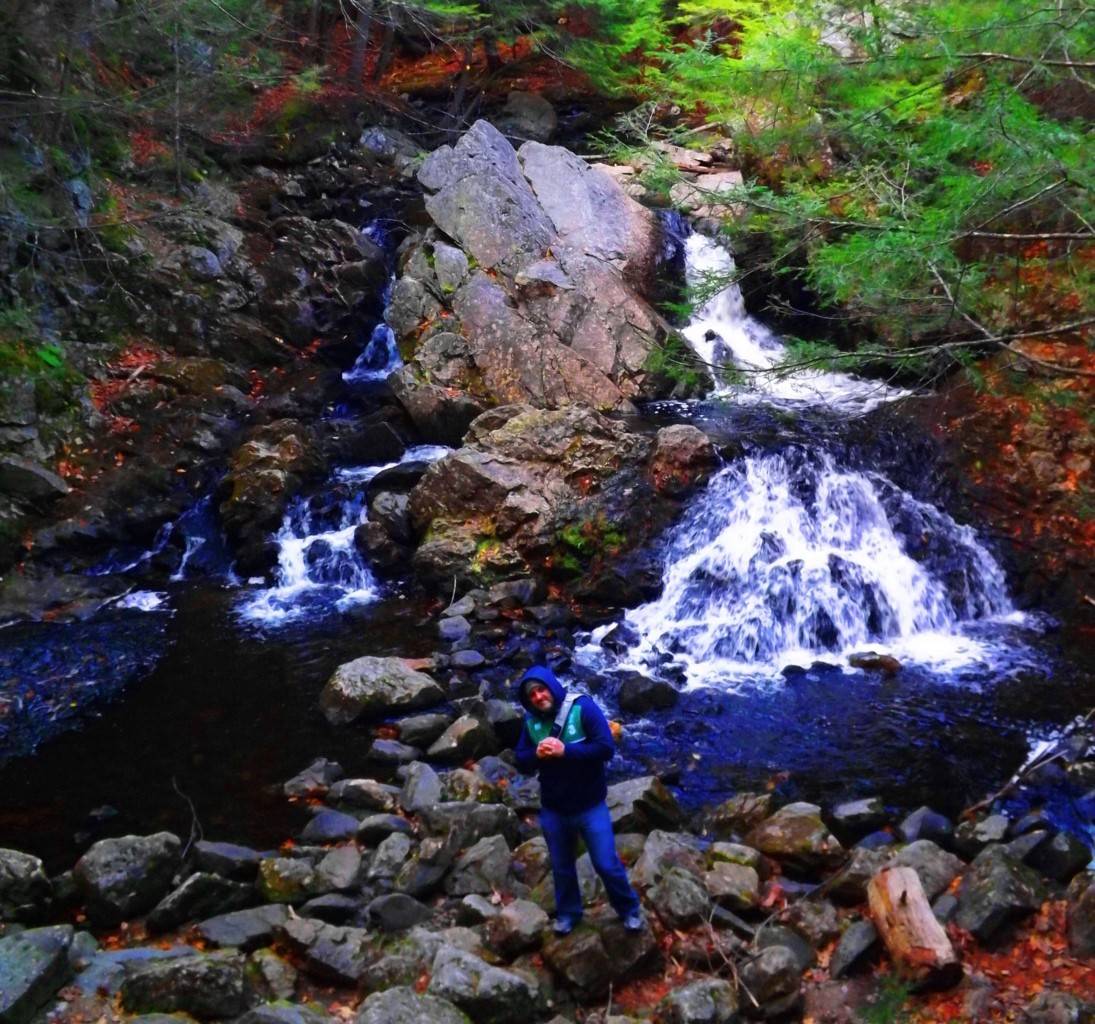
Trail: The approach at Mount Bearnagh is practically flawless. It is everything you could want in a day hike. This is a comfortable set of pathways, trails, ancient roads, and riverside runs that steadily progress, first to the Pass, then to the Peak. To the southwest of Bearnagh is a great hiking station and parking plaza with a cafeteria and campgrounds which can be found on-line. Plan your excursion before arriving for best results. Here Irish school-age children set up tents, along with international hikers, in the shadow of the gorgeous southern Mourne Range. Below is a look at the farmers road headed directly out of the Mourne towards the station. 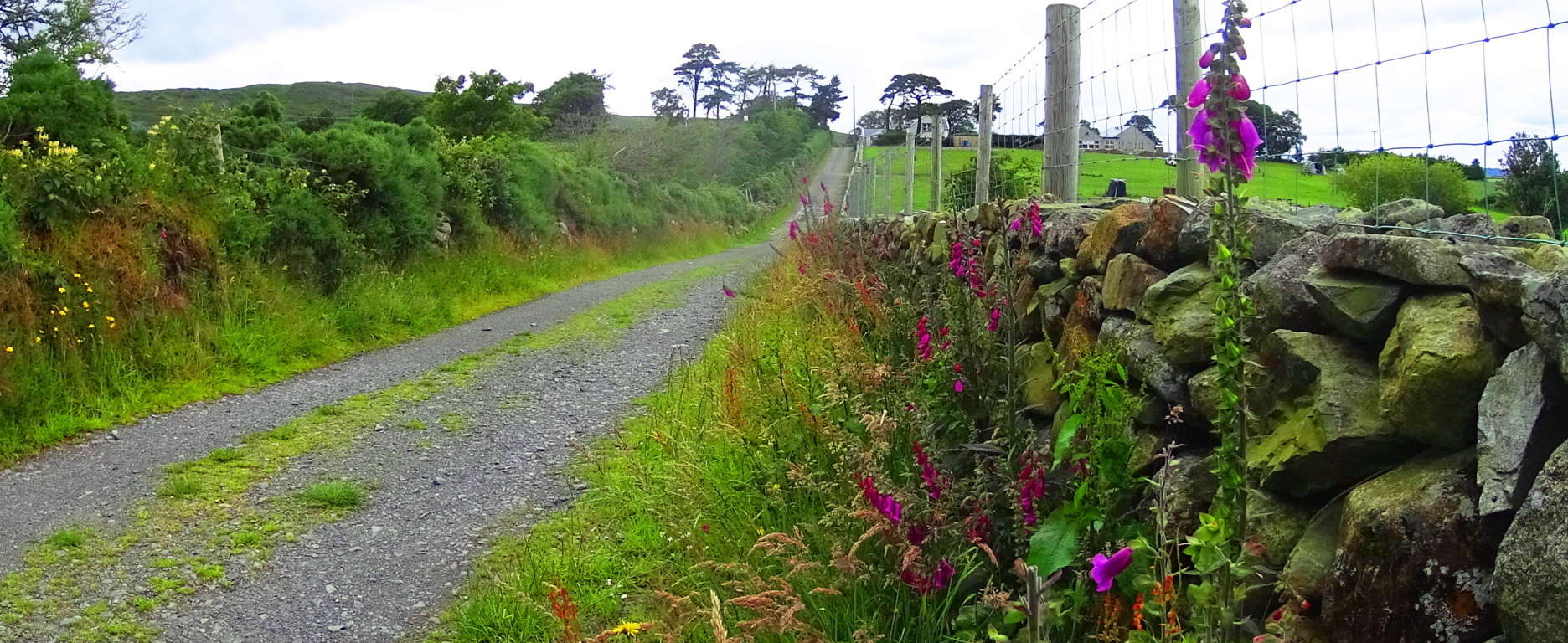
From this simple tractor path you will begin your trek into the Mourne. After about 150 yards you will emerge out of the hedge to find a rocky path. Turn left, heading west along this rocky path for roughly 200 yards. Carefully cross over small streams, fairy pools, and massive stones to eventually come to the main wide valley trail, which is a wide rocky path turning blatantly north. Mount Bearnagh will be directly to your right as you begin to ascend what can only be described as an ancient Celtic road, all the way to the top of the valley 3.5 miles beyond. Roads like these are so ancient that we can only guess as to who built them, and are most often associated with the Celts, although that may not necessarily the case.
Mount Bearnagh will be directly to your right as you begin to ascend what can only be described as an ancient Celtic road, all the way to the top of the valley 3.5 miles beyond. Roads like these are so ancient that we can only guess as to who built them, and are most often associated with the Celts, although that may not necessarily the case.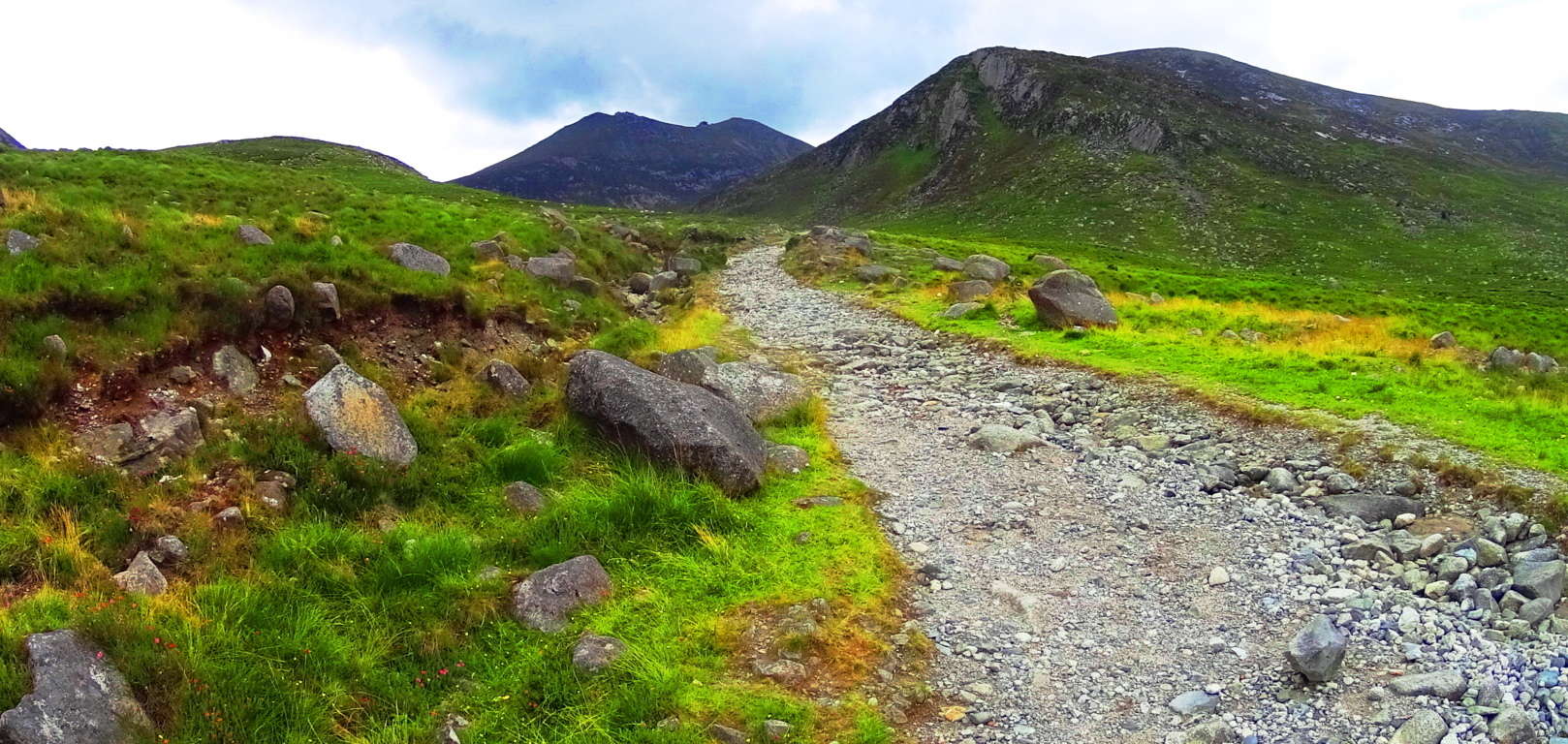
With an entire mountain range before you, and a beautiful rocky stream gushing along to your right, you can steadily make your way up to the Pass. At about 1.5 miles into this part of the trail wildflowers begin to emerge, along with boulders that seem centered on the peaks above. The feeling of rarity and dimensionality sets in; like you’ve stepped into another time. 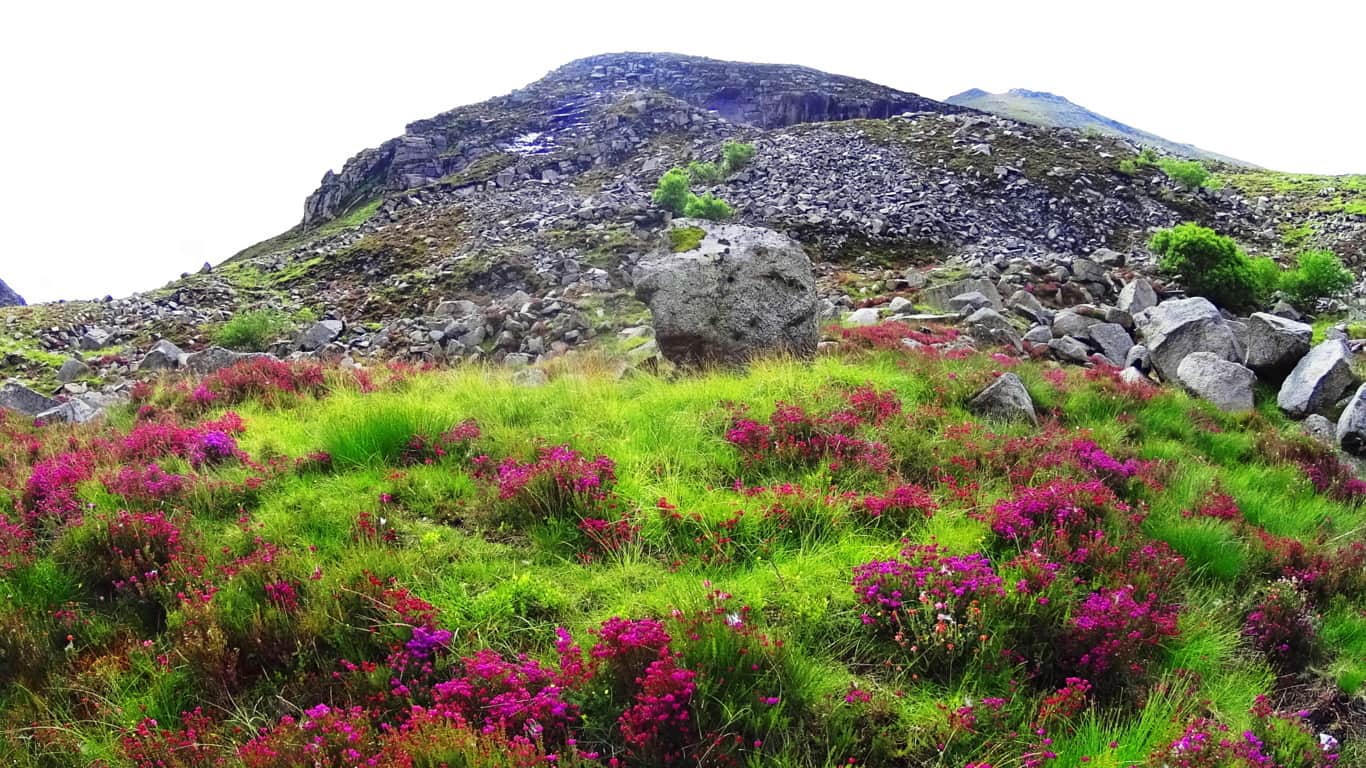 Rising into the area of about 1500 feet above sea level vast amounts of uniquely shaped and colossal crafted stones begin to emerge all around the trail. Often times what looks like arbitrarily placed glacial stones are actually quite the OPPOSITE. A closer look at the inundation of stones all about the valley reveals incredible and strange fixtures of stacked, quarried, and interlocking stones.
Rising into the area of about 1500 feet above sea level vast amounts of uniquely shaped and colossal crafted stones begin to emerge all around the trail. Often times what looks like arbitrarily placed glacial stones are actually quite the OPPOSITE. A closer look at the inundation of stones all about the valley reveals incredible and strange fixtures of stacked, quarried, and interlocking stones.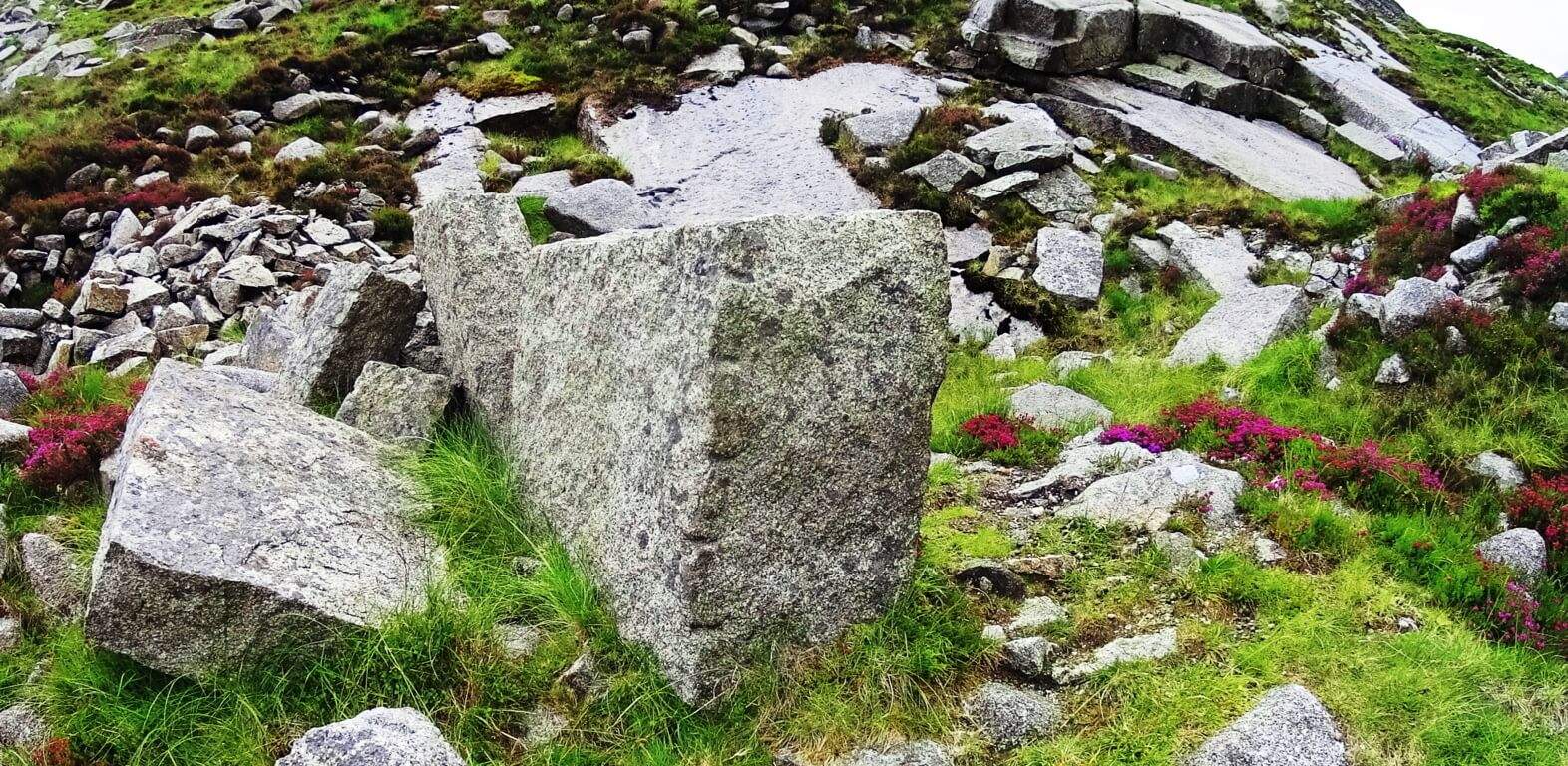 About 3 miles into the trail a beautifully carved and truly amazing megalithic boulder that is encircled by smaller stones. This embracing of smaller stones lends this boulder a certain significance. Looking at this “seat” you cannot help but feel that this stone was created for exactly that purpose, as a “seat” for viewing the valley below. Obviously the amount of work it would take to move this stone is remarkable. Who would do such a thing 1000 feet above the valley?
About 3 miles into the trail a beautifully carved and truly amazing megalithic boulder that is encircled by smaller stones. This embracing of smaller stones lends this boulder a certain significance. Looking at this “seat” you cannot help but feel that this stone was created for exactly that purpose, as a “seat” for viewing the valley below. Obviously the amount of work it would take to move this stone is remarkable. Who would do such a thing 1000 feet above the valley?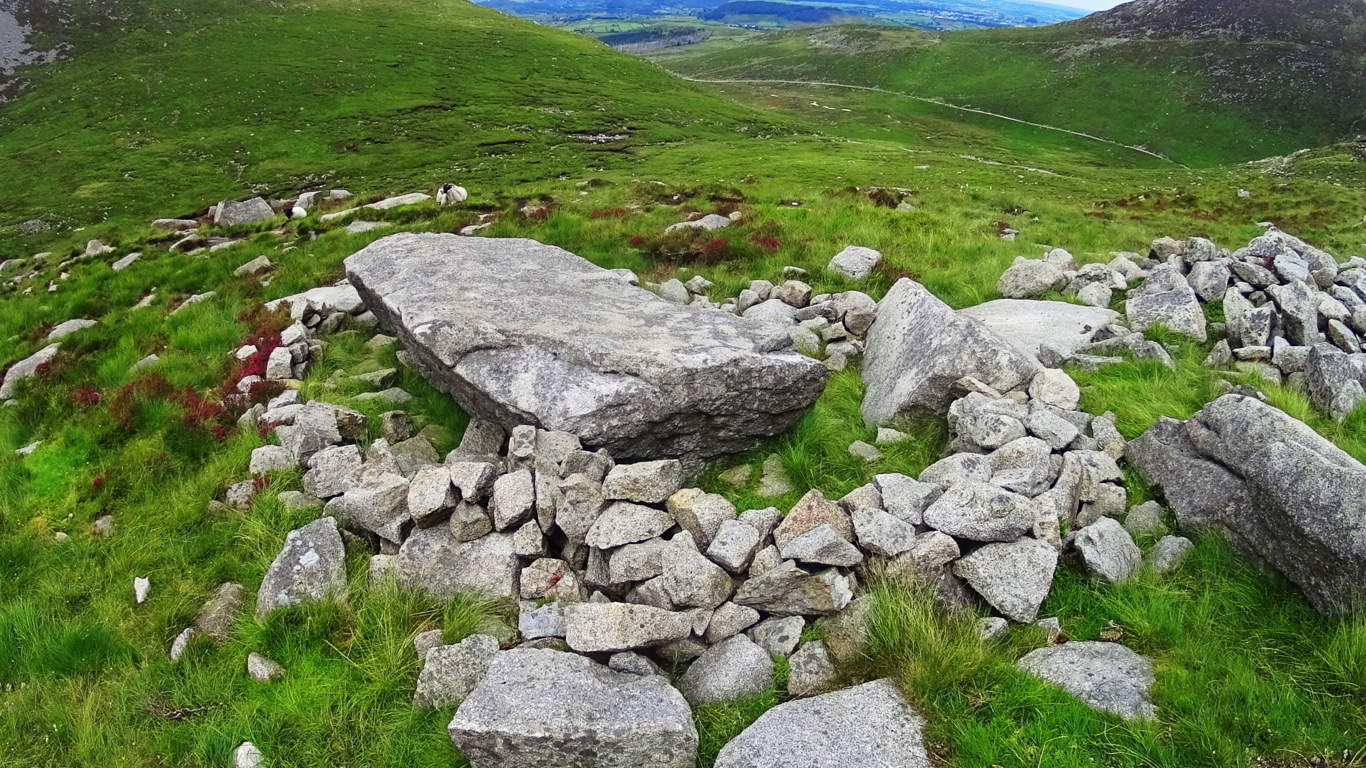
Beyond this amazing “seat” the trail becomes a wonderful stone path veering to the north-east. A heart warming view of the valley below becomes more dramatic with each step. These pathways look like something out of a fairy tale.
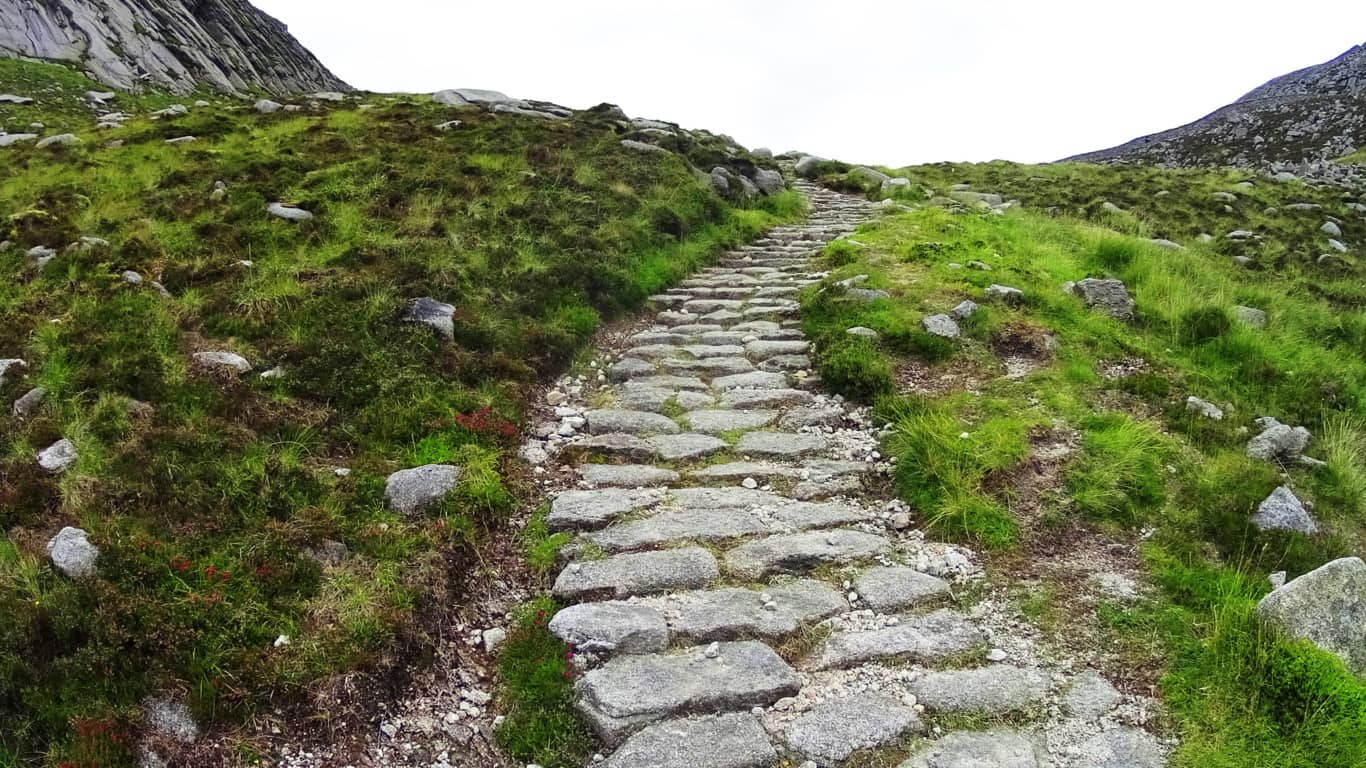 The Pass at Mount Bearnagh will be a short distance ahead from here, with stone walls from two utterly different era’s guarding the top of the valley.
The Pass at Mount Bearnagh will be a short distance ahead from here, with stone walls from two utterly different era’s guarding the top of the valley.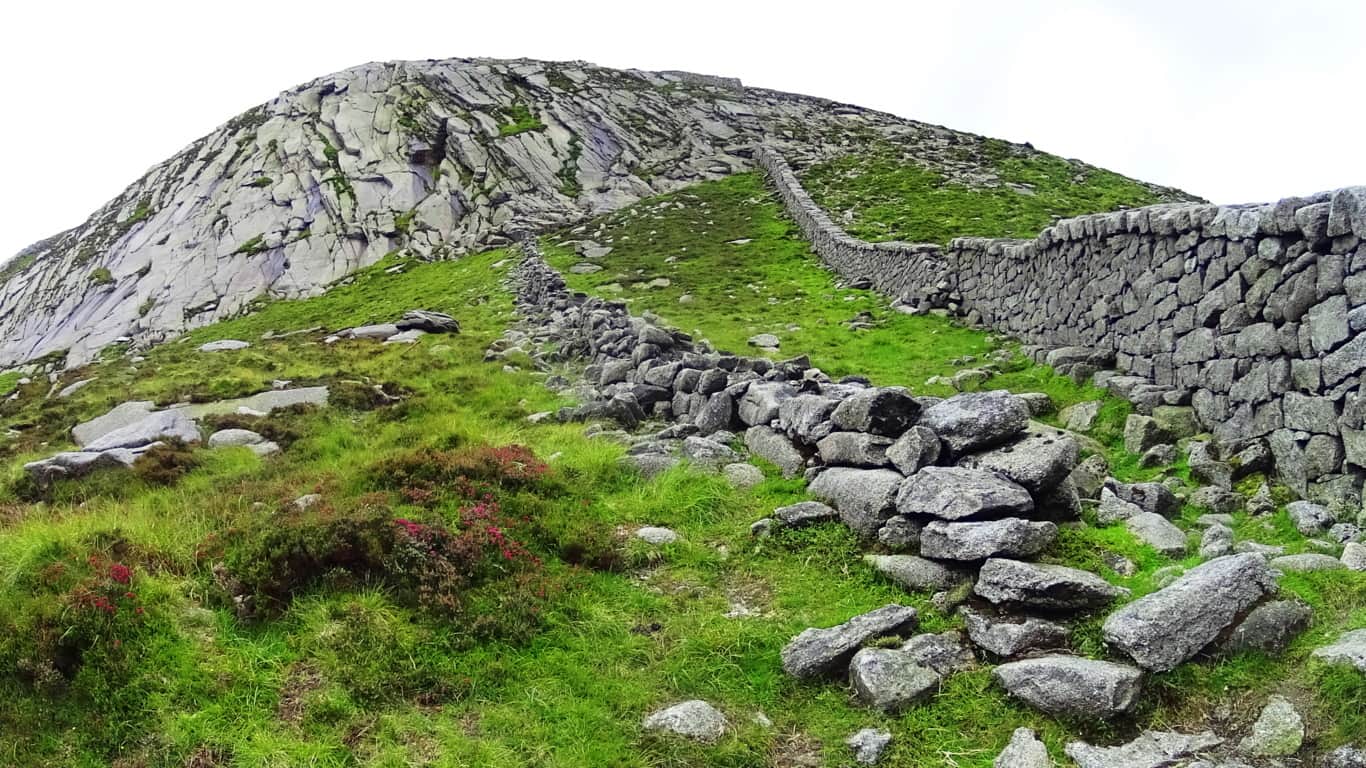
The image above of the Pass at Bearnagh is of two stone structures with a somewhat important historic meaning to convey; we should pause for a moment to consider this. The more modern wall, built in the early 1800’s, can be seen to the right. This is an actual ‘wall’ used to keep farmers flocks from crossing over into the next valley. The structure to the left is not a ‘wall’, but a 4000 to 6000 year old ‘stone-Lining’ that serves an entirely different function. This ‘Lining’ could never restrict the movements of anything in the valley, and was not intended to. Yet it was untouched by the builders of the wall next to it? This Lining could easily have been deconstructed as the most convenient possible supply of stone for the modern wall, some 1800 feet above the valley; why was it untouched? The reason it is preserved is that it is absolutely sacred and has been at this Pass as long as anyone can remember. The Irish have a profound respect for the ancient stones within its borders, and for thousands of years, no one dared touch these stones. So what is the Linings purpose? One hint about its purpose is in the ‘Linings’ positioning. If you will notice, this ‘Lining’ runs straight to the center point of the peak beyond, extending into strange ‘stacks’ running directly up the mountain to the center of the peak. I believe these ‘Linings’ are a type of ‘stone-cable’ that run from peak to peak, cabling subtle energies which run up through the mountain to ultimately culminate at the peak, like a capstone on a pyramid. These same Linings can be found connecting peaks in the small mountains and forests of New England, and is consistent with a pattern of Neolithic engineering found in hundreds of places, and perhaps world wide. In places like this, it feels as if the higher up you go the more strange the stones become. Just 35 yards away from the Lining at the Pass is a type of Cairn, a specific style of which can be found in areas with sacred stones. This type of Cairn has a square ‘roof slab’, with an emblematic looking side stone which stands like a sign in support of the long roof. This creates a kind of temperate storage compartment within the stones, which is what I believe was its use.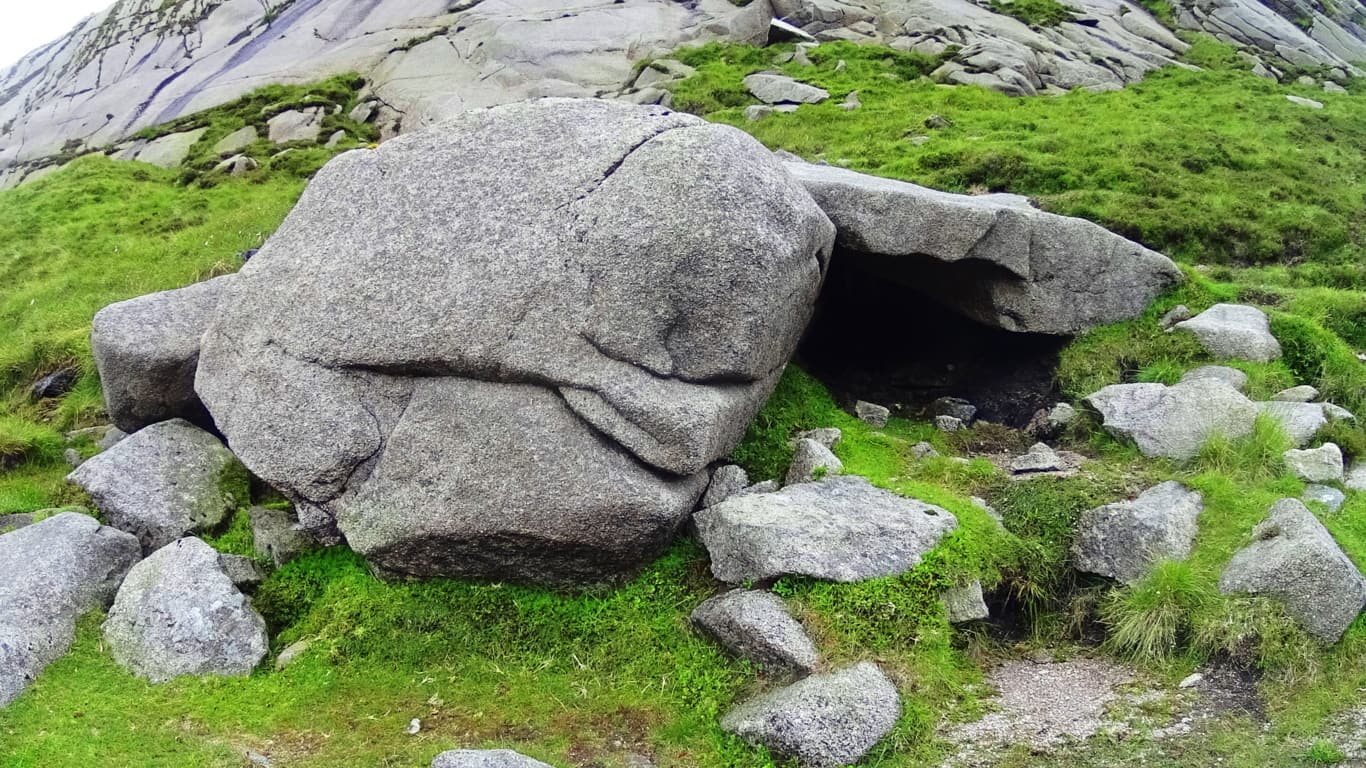 2000 miles away, hidden in the forests of Massachusetts, is a very similar Cairn located in Purgatory Chasm, a rare miniature canyon in the American northeast (featured on Stonestrider.com/Image Below, Left). Another Cairn of this specific style can be found at the highest point of the trail behind Glenveagh Castle in Donegal, Ireland (Image Below, Right).
2000 miles away, hidden in the forests of Massachusetts, is a very similar Cairn located in Purgatory Chasm, a rare miniature canyon in the American northeast (featured on Stonestrider.com/Image Below, Left). Another Cairn of this specific style can be found at the highest point of the trail behind Glenveagh Castle in Donegal, Ireland (Image Below, Right). 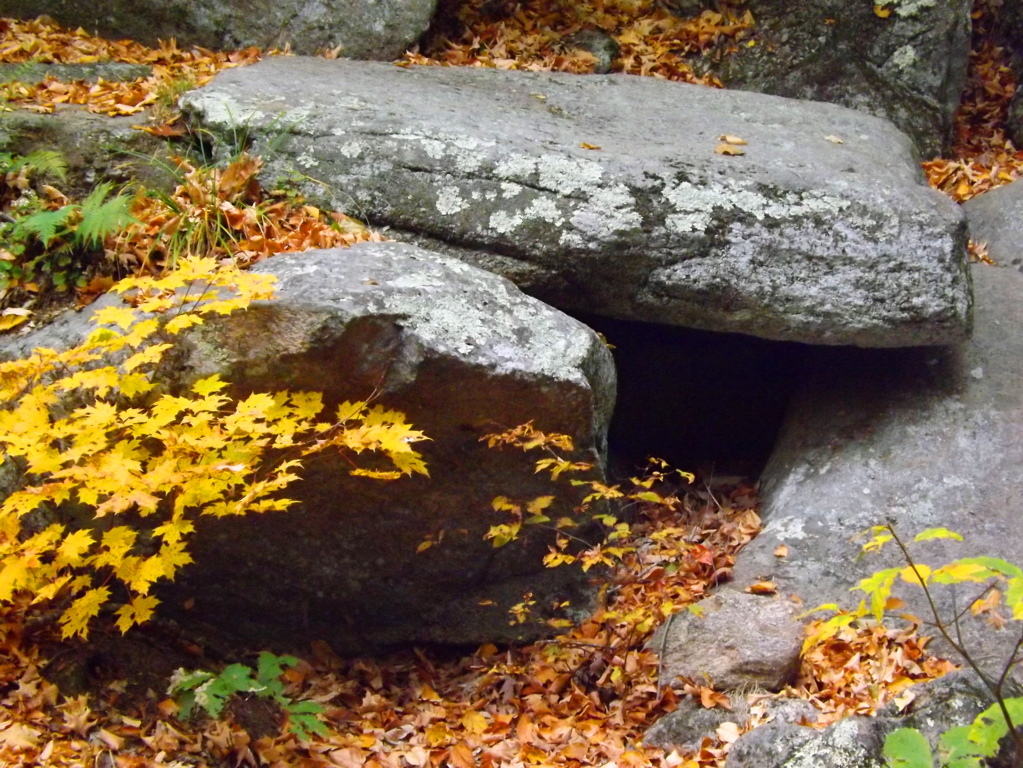
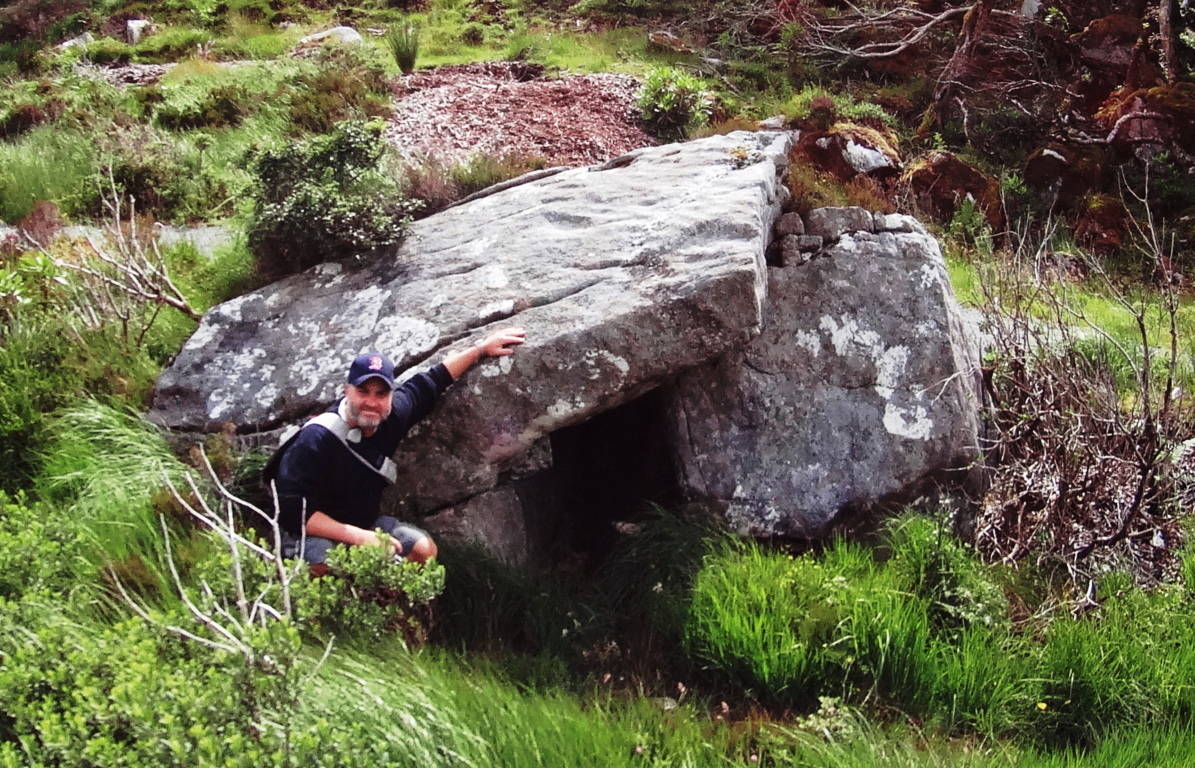
A 20 ton stone about 100 yards down the valley looks to have been somehow sculpted to match the slope of the base of the valley. (Image/Below). This raises all sorts of questions about the earliest culture to inhabit this region. Many of the stones seem to have this reflective quality on the landscape, mimicking features beyond, imitating valleys, building connectors between peaks; who does this? It has an artistic quality, as well as raw ability to build and move massive rock sculptures. Mysterious. And it just gets more mysterious the further up you go.
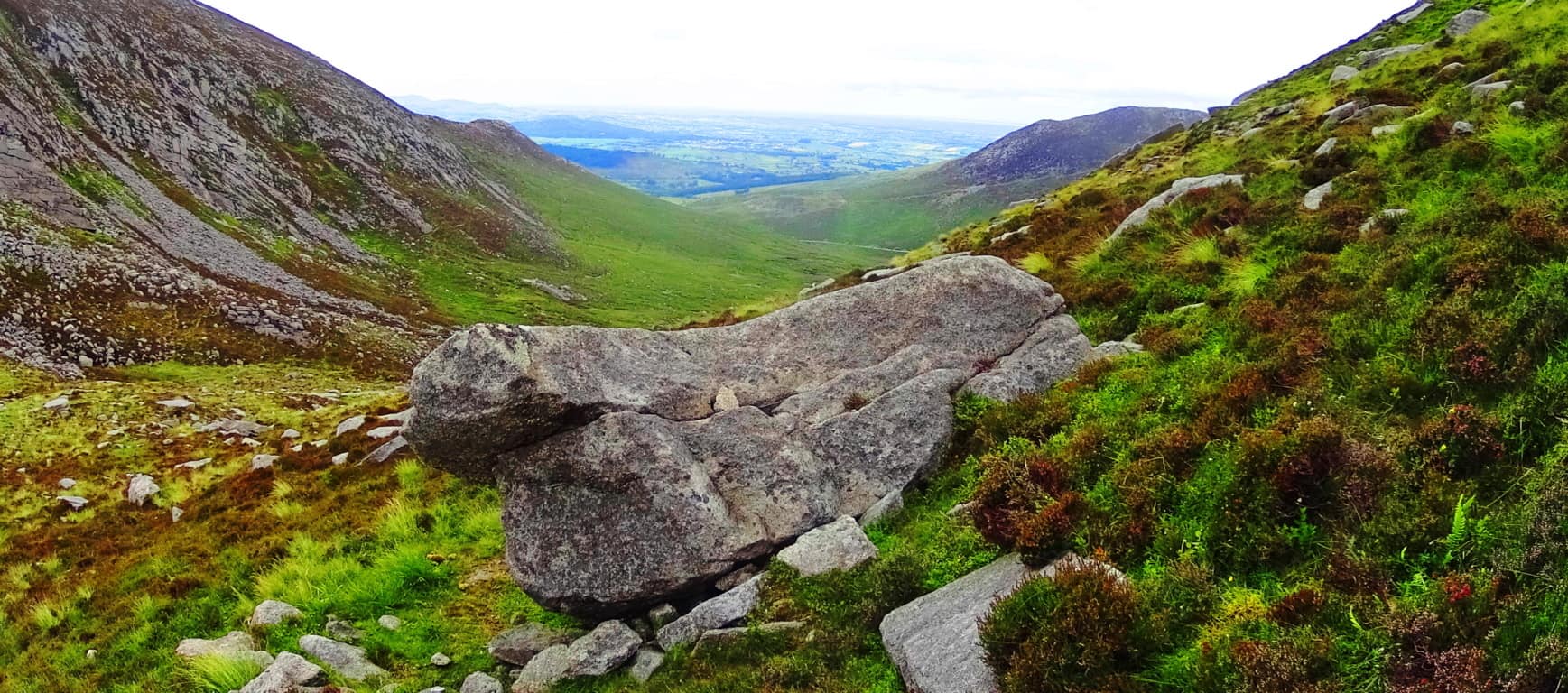 The final phase of the ascent at Mount Bearnagh is a solid challenge, but breathtaking.
The final phase of the ascent at Mount Bearnagh is a solid challenge, but breathtaking.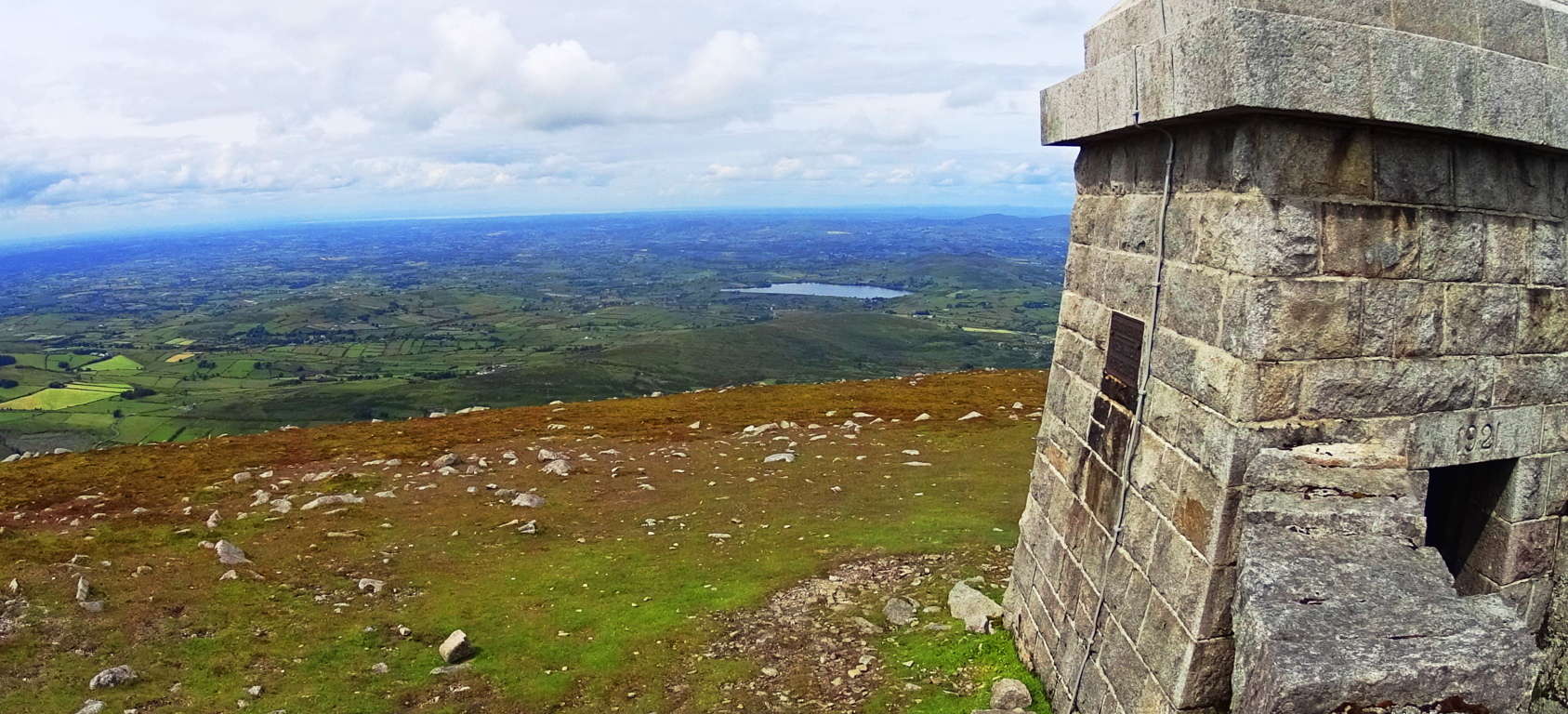 Here you will turn right and follow the modern wall directly up the side of the mountain for about another 3/4 of a mile to the small tower sitting above the Range.
Here you will turn right and follow the modern wall directly up the side of the mountain for about another 3/4 of a mile to the small tower sitting above the Range.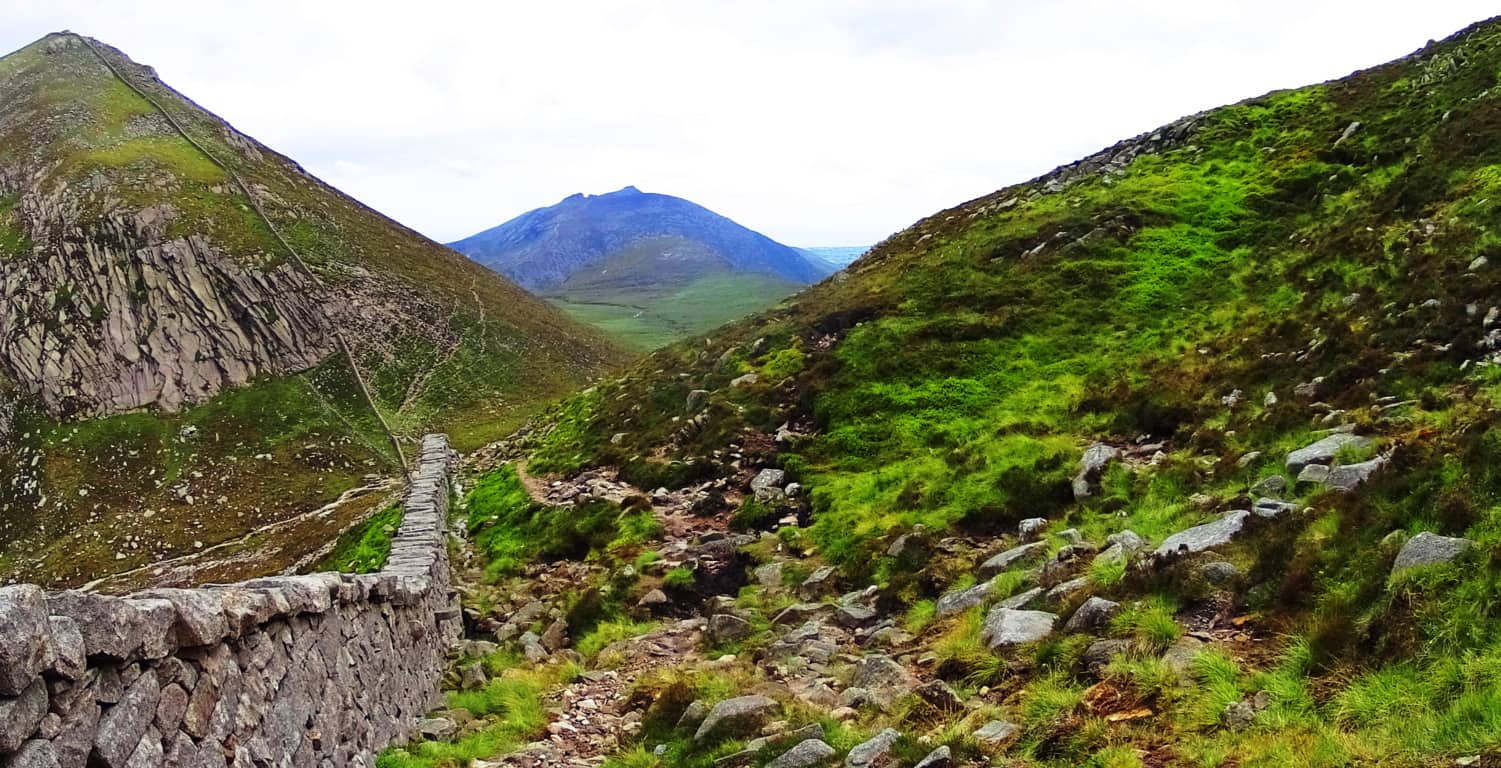 In this most elevated region the mountainside becomes inundated with dramatic sections of stone, much of which has been marked, measured, and cut into curious fixtures. While hiking you can look closely at some of the stone statements that are totally distinct. Below is an example of spirally stacked stones that are mingled with pieces that are clearly marked, measured, and cut. This piece I’m pointing at in the image below contains a stone with three equidistant measured markings for cutting along its side; it was obviously intentional.
In this most elevated region the mountainside becomes inundated with dramatic sections of stone, much of which has been marked, measured, and cut into curious fixtures. While hiking you can look closely at some of the stone statements that are totally distinct. Below is an example of spirally stacked stones that are mingled with pieces that are clearly marked, measured, and cut. This piece I’m pointing at in the image below contains a stone with three equidistant measured markings for cutting along its side; it was obviously intentional. 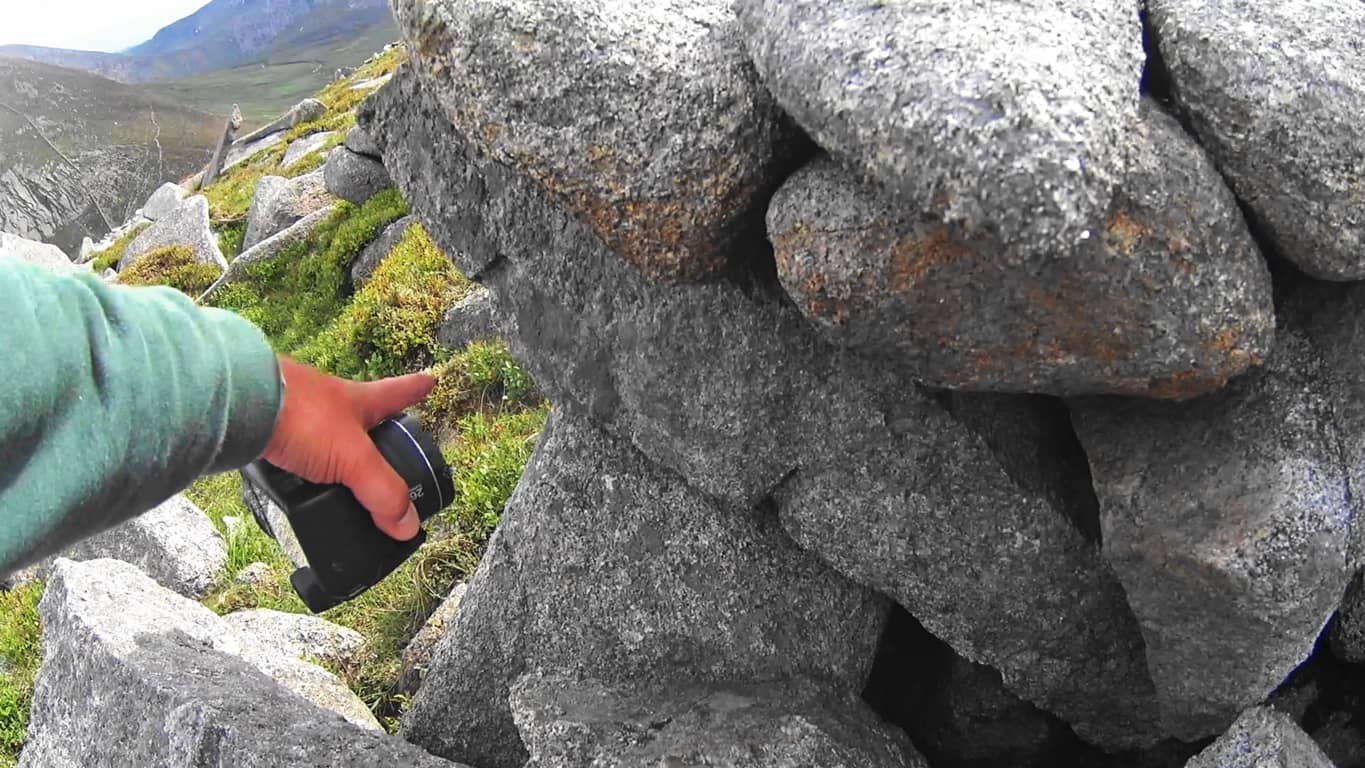
There are hundreds, if not thousands, of crafted stones to be found here, all utterly undocumented artifacts. What are they doing at 2,200 feet above the valley? Here again is another set of stones which look to have been specifically cut in order to mimic the slope of the mountains beyond. (Image Below) I noticed the boulder on the right side of the picture from over 50 yards away. It has been sliced, as you can see, and the angle of that slice imitates the slope of the eastern face of the mountain beyond,

The shape of the stones imitates a rock fixture nearly at the top of the opposite slope beyond. Notice also the thin rounded plate to the left which imitates the exact angle and roundness of the peaks on the left. These stones were absolutely placed this way to specifically mimic the opposite mountains. Unreal.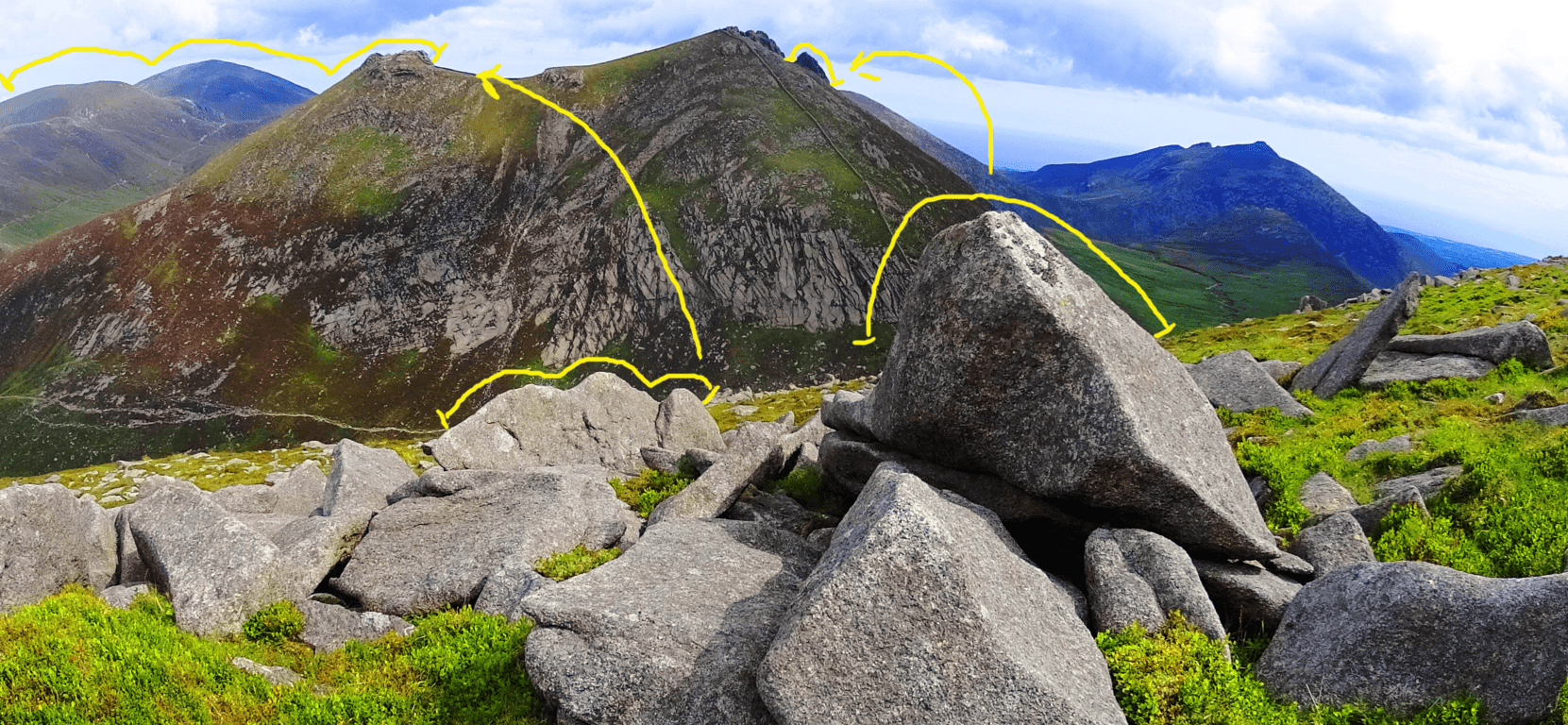 I am aware that this is a challenge for people to accept; I too found it a challenge for years. But time and time again, similar expressions arise in challenging elevations that are begging to be noticed, both in Ireland, and New England (as well as the rest of the world). This is a form of megalithic expression that we are simply not accustom to acknowledging, as it has been mostly ignored by the academic community. The real question you should eventually ask is: “How could they ignore an entire mountainside of marked and positioned stones?” The logical questions that arise would challenge our picture of Neolithic history, and that looks to be what modern academia will not allow. Just beyond this magical fixture is the small tower, where a 360 degree view comes into full focus. On clear days you can see Wales on the other side of the Irish Sea! Below is the simple southern view from which your hike began.
I am aware that this is a challenge for people to accept; I too found it a challenge for years. But time and time again, similar expressions arise in challenging elevations that are begging to be noticed, both in Ireland, and New England (as well as the rest of the world). This is a form of megalithic expression that we are simply not accustom to acknowledging, as it has been mostly ignored by the academic community. The real question you should eventually ask is: “How could they ignore an entire mountainside of marked and positioned stones?” The logical questions that arise would challenge our picture of Neolithic history, and that looks to be what modern academia will not allow. Just beyond this magical fixture is the small tower, where a 360 degree view comes into full focus. On clear days you can see Wales on the other side of the Irish Sea! Below is the simple southern view from which your hike began.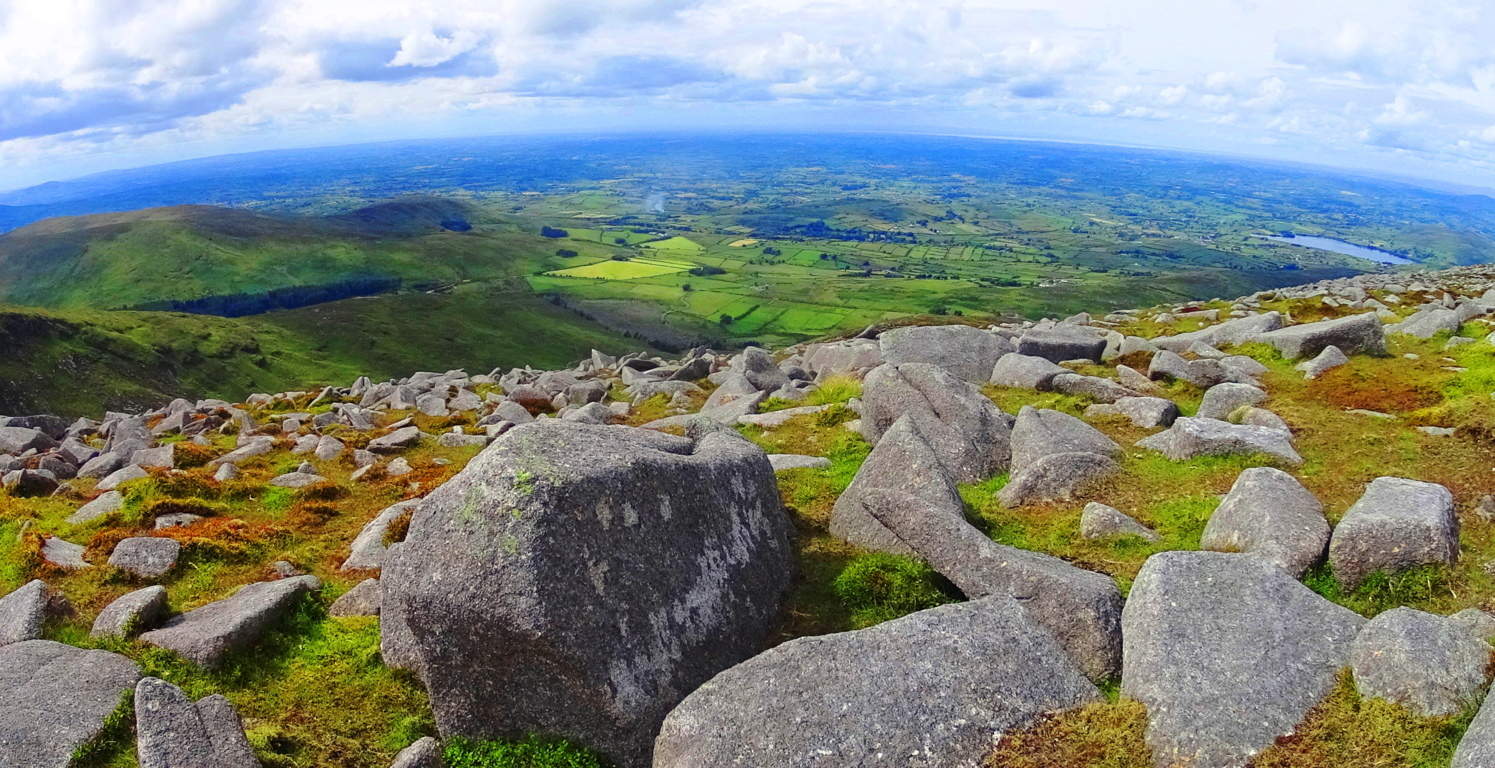 The modern stone wall continues along the elevated porch of the upper mountains, twisting surreally through the Mourne beautifully (Top Image of Article). Many hikers choose to continue hiking from small tower to small tower, while others, like myself, made the return descent back to the Pass and down the Valley.
The modern stone wall continues along the elevated porch of the upper mountains, twisting surreally through the Mourne beautifully (Top Image of Article). Many hikers choose to continue hiking from small tower to small tower, while others, like myself, made the return descent back to the Pass and down the Valley.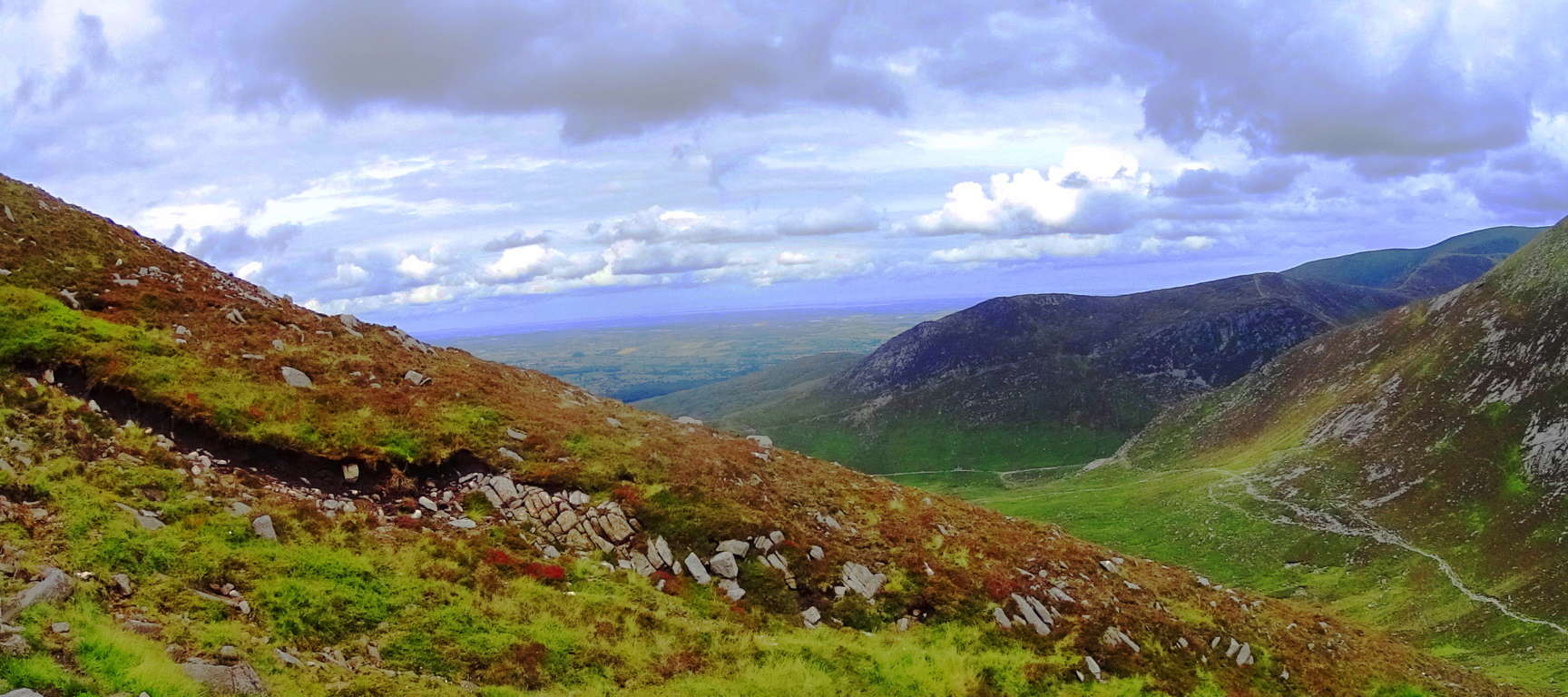
The colors here are a spongy mixture of rugged and rusty oranges mingled with profound jade and deep mossy green. The clouds play a pocketed game, with shafts of light seeping through the fast moving heavens; light arrives, sometimes in flashes over broad portions of the Mourne, while at other times appearing in prolonged beams of revelation. The air is cool and forgiving. If you have a small water purifier you could drink from the wide stream heading down the central portion of the valley back to the bottom. Enjoy the benefits of gravity assisting your 3.5 mile trek back to the station. This place has the potential to be one of the best day hikes you will ever have in your life. What more do I need to say about such a place? Find your way.
Giant’s Causeway
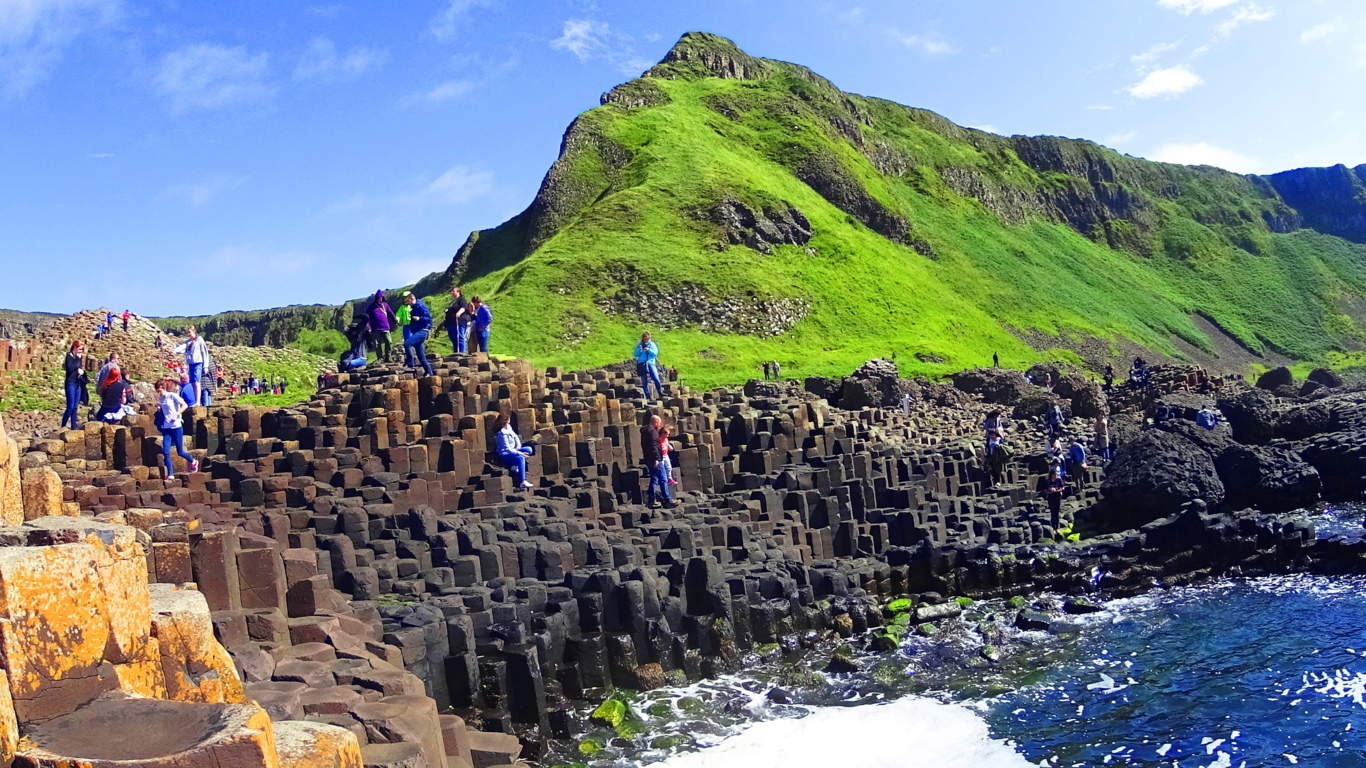 Location: Hamlet of Bushmills/County Antrim/Northern Ireland/(U.K)
Location: Hamlet of Bushmills/County Antrim/Northern Ireland/(U.K)
Note: Every so often a place emerges for trailblazers that is so mysterious, so utterly stunning, that a reactionary discussion is unavoidable. The simplest question emerges: “How did this happen?” Welcome to The Giant’s Causeway, the slightly golden, hexagonal stone courtyard on the absolute northernmost coastal point of the Emerald Isle. This is a gorgeous coastal trail, of roughly five amazing miles, that slowly elevates and bends around two gorgeous bays which cinematically ensconce one of the most mysterious sacred sites in the world.
Scientific Theories: The landscape of Ireland is not just a minor variation from the nearby nations of England, Scotland, and France, just across the Irish Sea; it is distinctly different. Take a look at the image above, along the bay of The Giant’s Causeway; the green coastline emerges like a Jurassic jade stone. It’s breathtaking. How does a landscape like this happen? How did Ireland happen? The answers come from all sides, and each is more challenging than the next. The author J.P Mallory in his book ‘The Origins of The Irish’ attributes Ireland’s unique glowing ‘green-colored-universe’ to the primordial history of it’s formation in the earliest periods of geological history. Get ready for this: Once upon a time, believe it or not, just after the breaking-up of the singular Pangaea Continent, Ireland was actually off the coast of… Australia.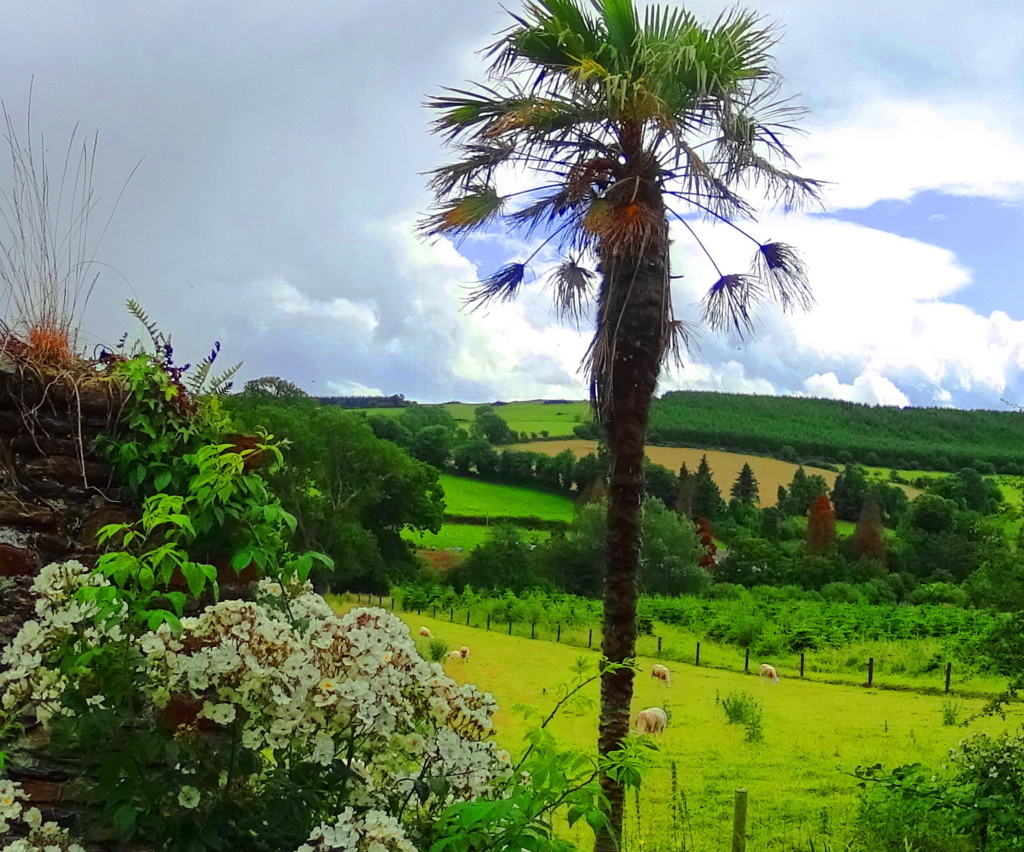 Ireland’s earliest tropical attributes come from this region. In an oversimplified explanation, Ireland slowly made its way (in what is scientifically called the ‘Ordovician Period‘) through extreme Ice Ages, Floods, and drastic Continental shifts, to reside at its preset position. That’s what scientists believe. Adding to that initial tropical origin, Ireland is at the glorious finish-line of the Atlantic Jet Stream, which is the warmest and largest tropical under-water-highway in the world, literally running from Jamaica to Ireland in it’s final phase. As result, Ireland’s southern coast (and England’s) is subtly marinated with Palm trees, something many people just don’t know. While hiking through Ireland you can easily begin to wonder what the actual story of this landscape is?
Ireland’s earliest tropical attributes come from this region. In an oversimplified explanation, Ireland slowly made its way (in what is scientifically called the ‘Ordovician Period‘) through extreme Ice Ages, Floods, and drastic Continental shifts, to reside at its preset position. That’s what scientists believe. Adding to that initial tropical origin, Ireland is at the glorious finish-line of the Atlantic Jet Stream, which is the warmest and largest tropical under-water-highway in the world, literally running from Jamaica to Ireland in it’s final phase. As result, Ireland’s southern coast (and England’s) is subtly marinated with Palm trees, something many people just don’t know. While hiking through Ireland you can easily begin to wonder what the actual story of this landscape is?
History and Religious Myth: It is hard to accept a theory that has Ireland’s earliest origin off the coast of Australia, but the uniqueness of Ireland’s semi-tropical south, and ‘thousand shades of green’, indicate something special. As noted before on Stonestrider.com, once, while hiking Kinnitty Mountain in the landlocked heart of Ireland, I found seashells on the mountain trail, about 2200 feet above sea level.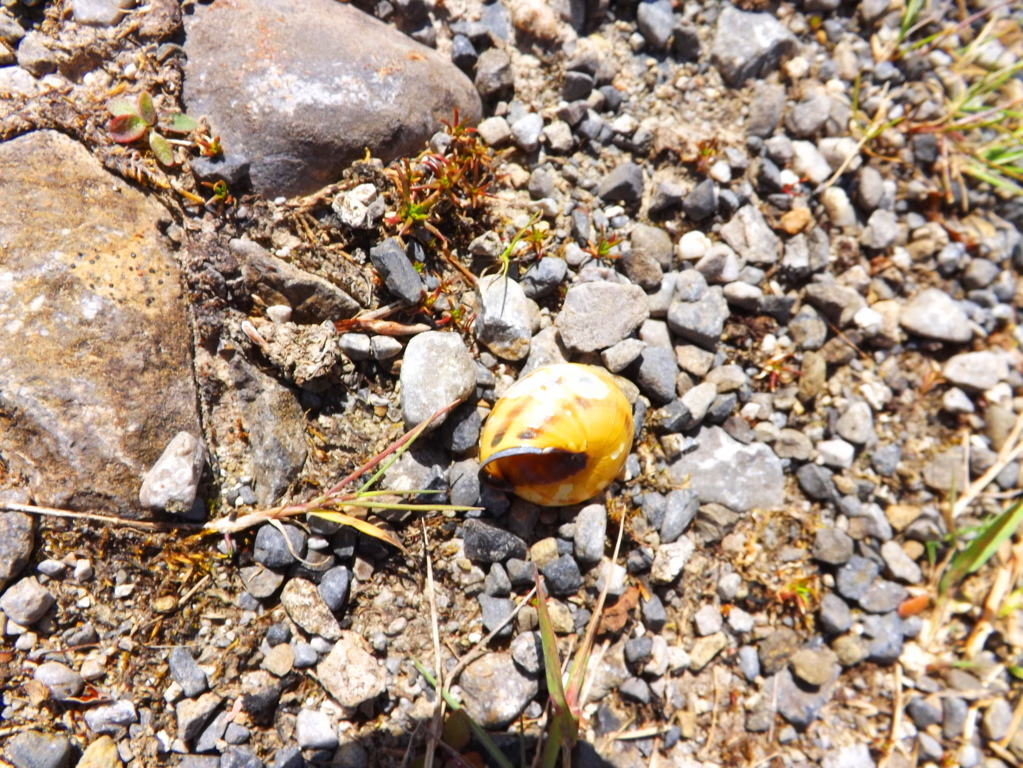 What were seashells doing at the top of a mountain? Ireland must have been covered by the ocean at one point or another, just as other landmasses, for this to happen; and more directly, this evidence would point to the last time it happened, meaning the Biblical Flood. For some people this is also hard to reconcile, and yet it is hardly less realistic than a theory transporting Ireland from the coast of Australia. To this point, in the southwest of Ireland, there is a magical view of the Gap of Dunloe from the N71 Road, that is so spongy, so filled with undulating vegetation, that picturing it at the bottom of the ocean seems uniquely possible. (Image/Below)
What were seashells doing at the top of a mountain? Ireland must have been covered by the ocean at one point or another, just as other landmasses, for this to happen; and more directly, this evidence would point to the last time it happened, meaning the Biblical Flood. For some people this is also hard to reconcile, and yet it is hardly less realistic than a theory transporting Ireland from the coast of Australia. To this point, in the southwest of Ireland, there is a magical view of the Gap of Dunloe from the N71 Road, that is so spongy, so filled with undulating vegetation, that picturing it at the bottom of the ocean seems uniquely possible. (Image/Below) 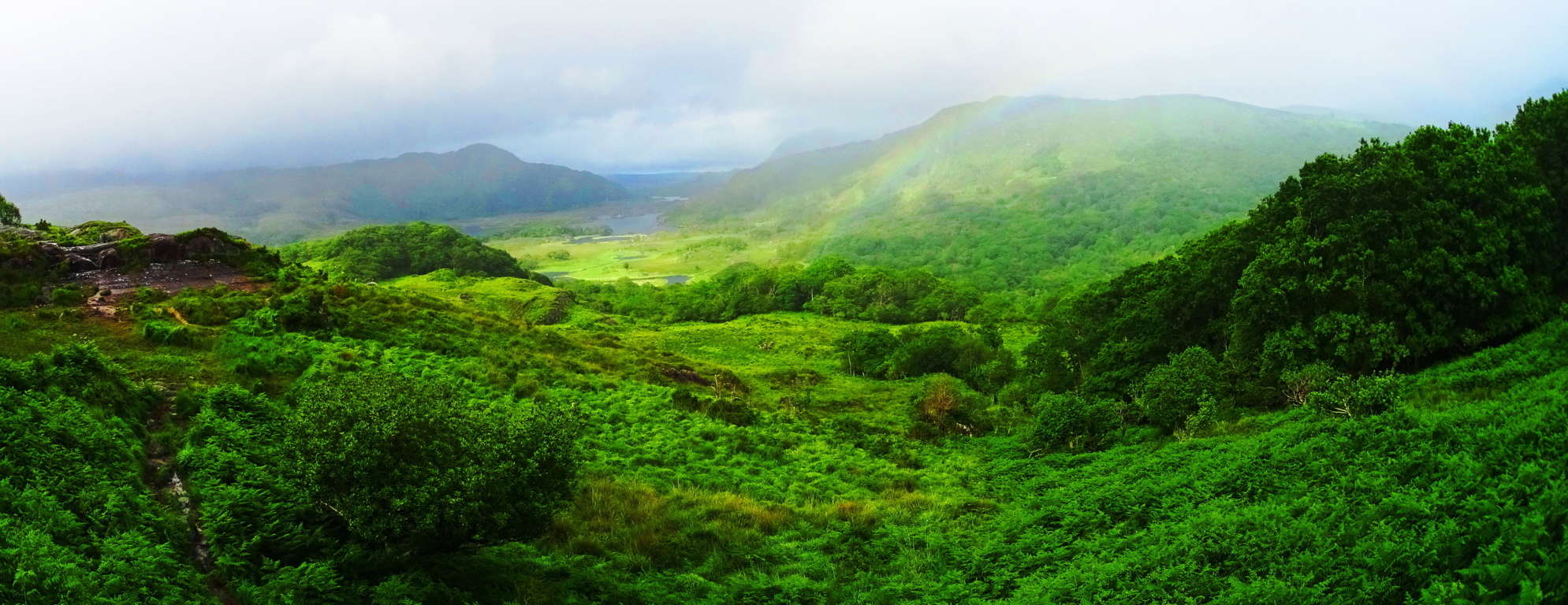 Like shells on mountaintops, or Palm trees growing in a northern European nation, The Causeway’ contains features that are compelling, and require some secondary consideration, to say the least. The first and most obvious of the features here are the small, but dense, golden hexagonal stone pillars lining this brilliant coastal cove.
Like shells on mountaintops, or Palm trees growing in a northern European nation, The Causeway’ contains features that are compelling, and require some secondary consideration, to say the least. The first and most obvious of the features here are the small, but dense, golden hexagonal stone pillars lining this brilliant coastal cove.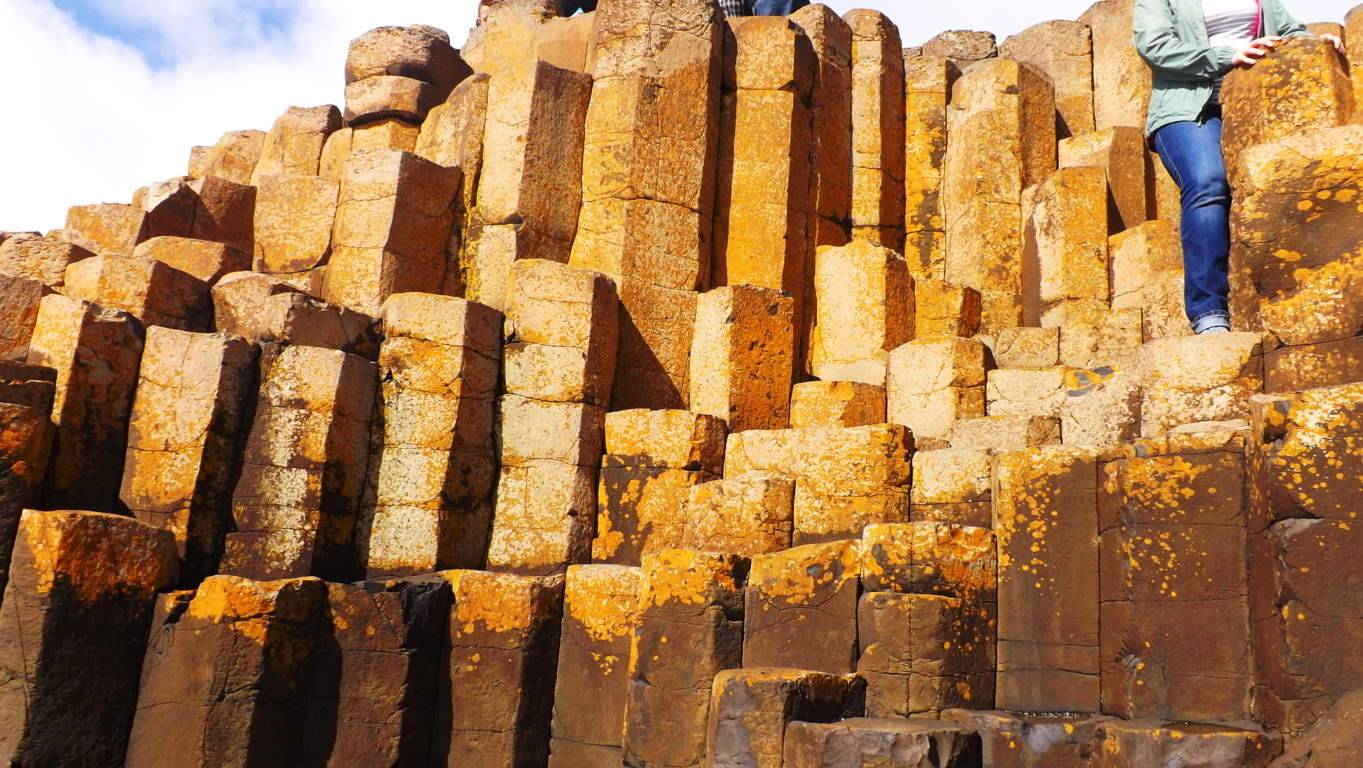 School-Age textbooks attribute the geometry of these stones to a process of volcanic lava being cooled and shaped by the ocean some 40 million years ago. For an impressionable ten year old child reading a fancy textbook this explanation might seem o.k, but for an educated, sentient adult, aware of logic and context, the explanation is almost insulting. Simply put, there are so many problems with the accepted theory. For example, in Hawaii this process of “lava cooling” is still taking place in real-time, and yet there is not a single hexagonal to be found. In fact, the lava-solids in Hawaii looks exactly as you would think; like grand layers of “syrup” slowly solidated into large round bulges of stone. These are strangely different results for two coastlines undergoing the exact same process. (Giant’s Causeway Hexagonals/Image/Below)
School-Age textbooks attribute the geometry of these stones to a process of volcanic lava being cooled and shaped by the ocean some 40 million years ago. For an impressionable ten year old child reading a fancy textbook this explanation might seem o.k, but for an educated, sentient adult, aware of logic and context, the explanation is almost insulting. Simply put, there are so many problems with the accepted theory. For example, in Hawaii this process of “lava cooling” is still taking place in real-time, and yet there is not a single hexagonal to be found. In fact, the lava-solids in Hawaii looks exactly as you would think; like grand layers of “syrup” slowly solidated into large round bulges of stone. These are strangely different results for two coastlines undergoing the exact same process. (Giant’s Causeway Hexagonals/Image/Below)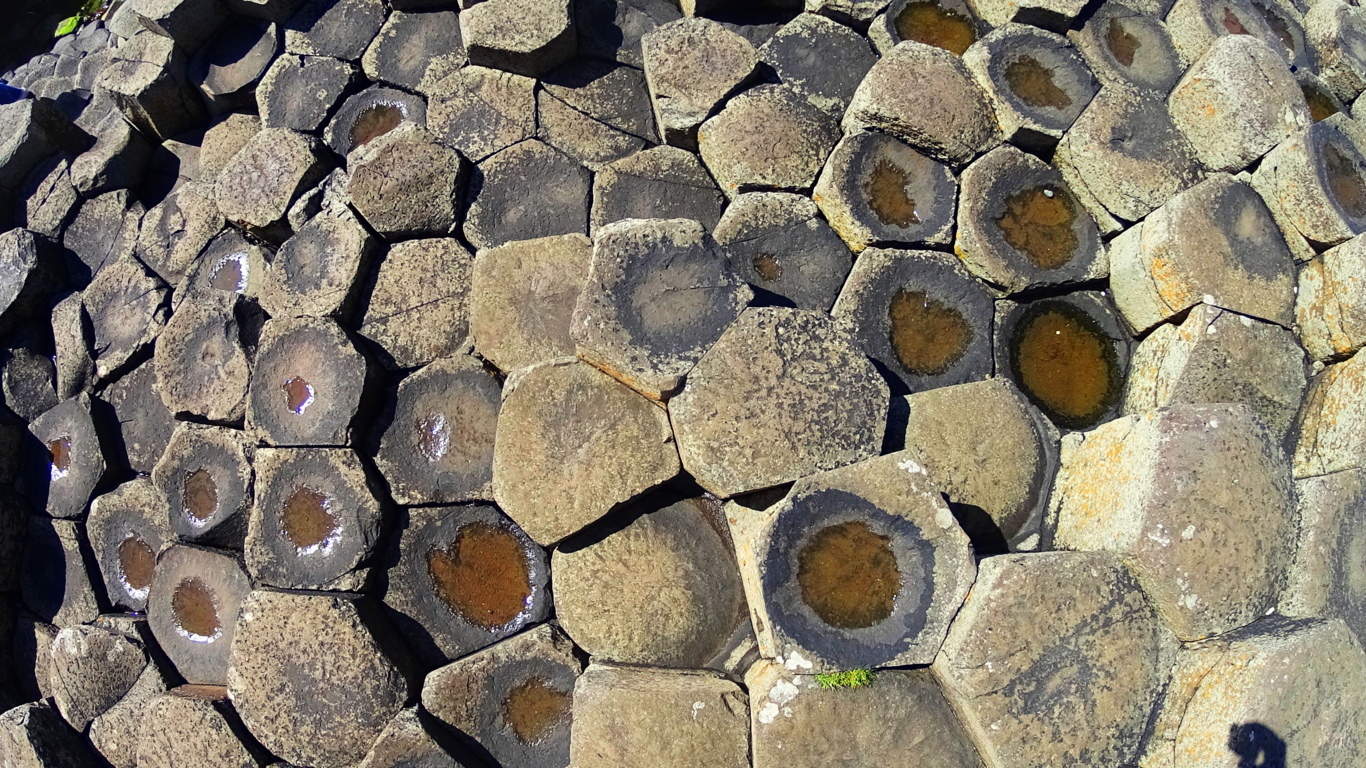 Furthermore, there are no hexagonals to be found anywhere else along the coast of Ireland; not a single one. That just doesn’t make sense for such a small national coast. There is also the apparently miraculous geographic placement of The Causeway’, set like a perfect northern gateway into Ireland from Scotland, which isn’t even 70 miles north across the inner Atlantic bay. It’s as if the area says: “Welcome to our side of the Sea”; a striking entry zone specifically facing the only other international land mass in the vicinity, Scotland/Wales.
Furthermore, there are no hexagonals to be found anywhere else along the coast of Ireland; not a single one. That just doesn’t make sense for such a small national coast. There is also the apparently miraculous geographic placement of The Causeway’, set like a perfect northern gateway into Ireland from Scotland, which isn’t even 70 miles north across the inner Atlantic bay. It’s as if the area says: “Welcome to our side of the Sea”; a striking entry zone specifically facing the only other international land mass in the vicinity, Scotland/Wales.
View From The Trail: As you might expect from a World Heritage Site, at the beginning of the trail is a busy commercial station and parking lot that requires payment. There is even a small bus line that will take physically challenged people to the The Causeway’. Don’t use the bus-line. Walk the 200 dramatic yards down the small road to the actual trail. From here the first full vantage of the northeasterly coastline pathway appears, and it couldn’t be more inviting. In the Sun, this scene looks like a Celtic northern California.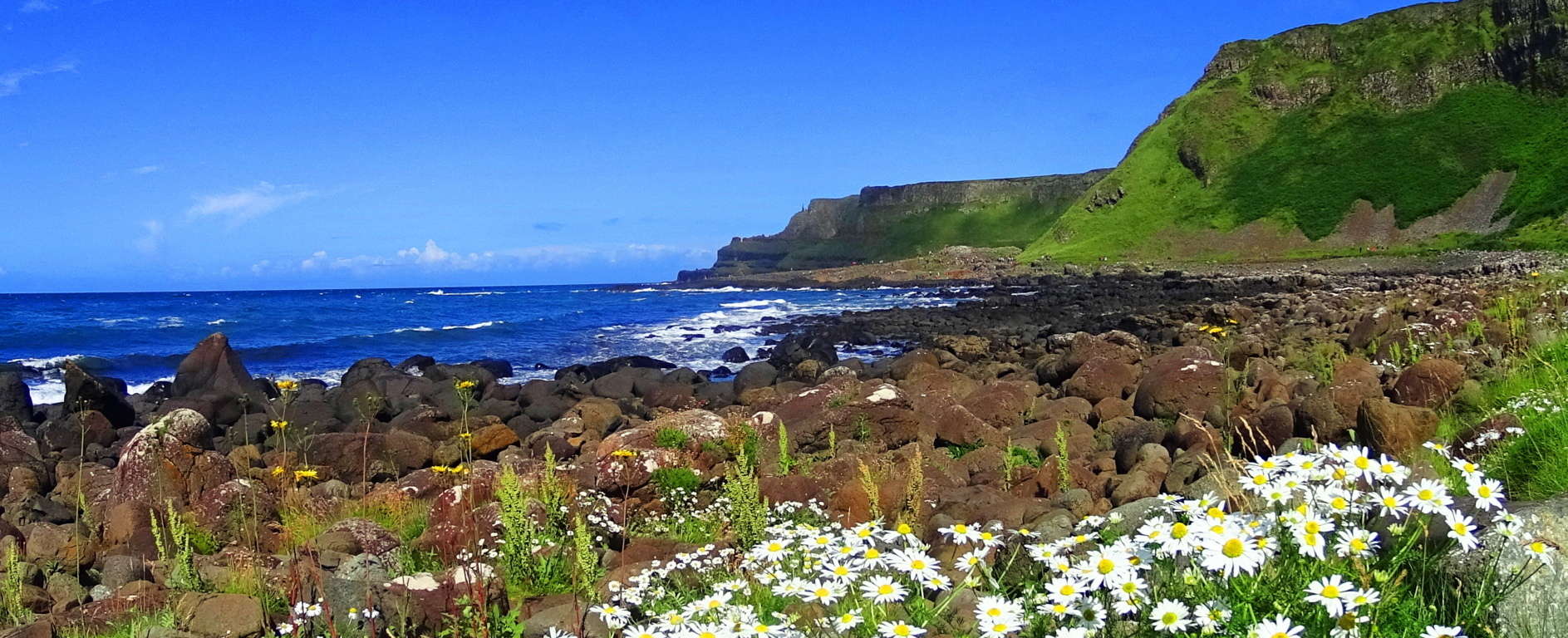
In this initial bay, before even arriving at the mysterious Causeway’, are massive stones and boulders that seem to have some kind of secret. Many of the large shapely boulders have names, and are famous in the area for their form (Image/Below). 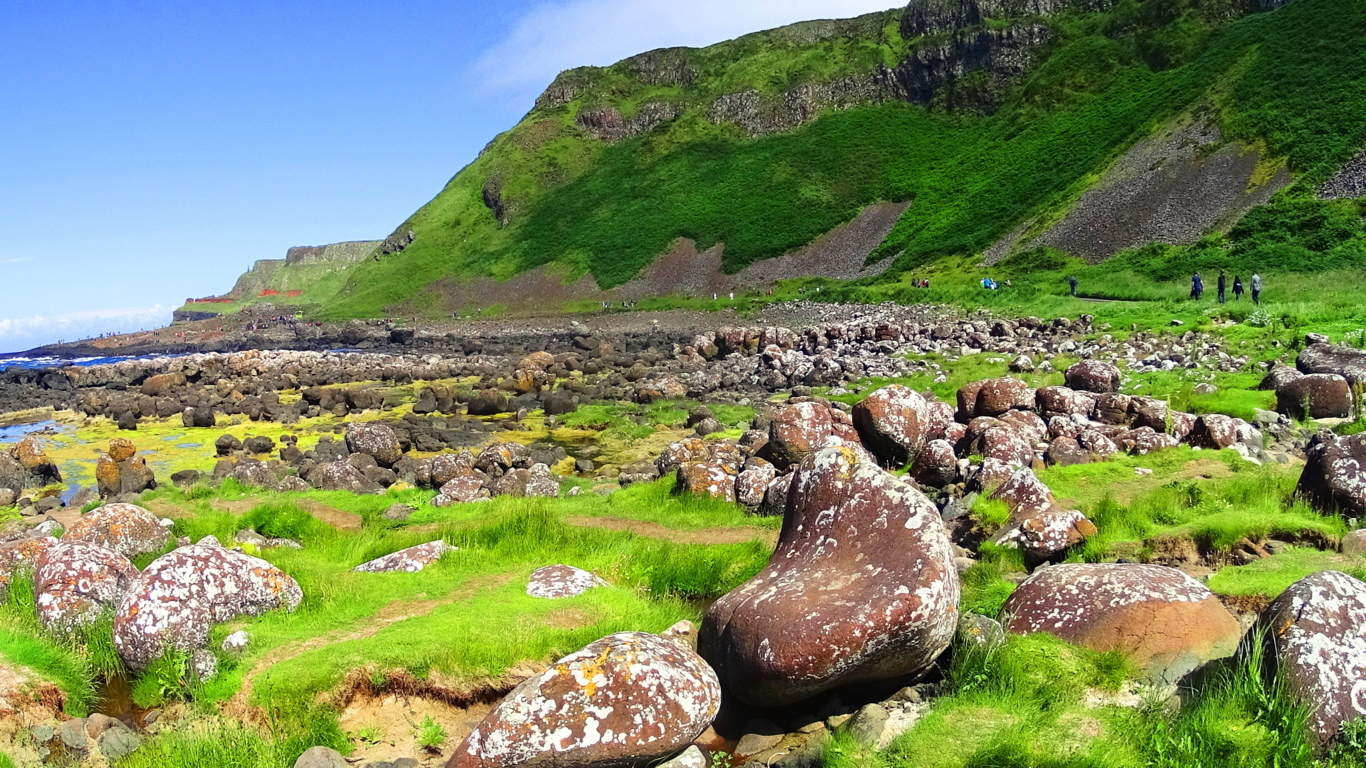 There are stones look to have been placed specifically as seats, with brilliant curvatures and character. Other stones are more stoic and classic in stature, looking like legitimate standing stones (Image/Below), fixed squarely into the rock beneath them. The entirety of this rocky opening scene, before arriving at the Causeway paints a picture of a ‘rock garden’ that reveals a small taste of the striking geomorphic strangeness taking place here.
There are stones look to have been placed specifically as seats, with brilliant curvatures and character. Other stones are more stoic and classic in stature, looking like legitimate standing stones (Image/Below), fixed squarely into the rock beneath them. The entirety of this rocky opening scene, before arriving at the Causeway paints a picture of a ‘rock garden’ that reveals a small taste of the striking geomorphic strangeness taking place here.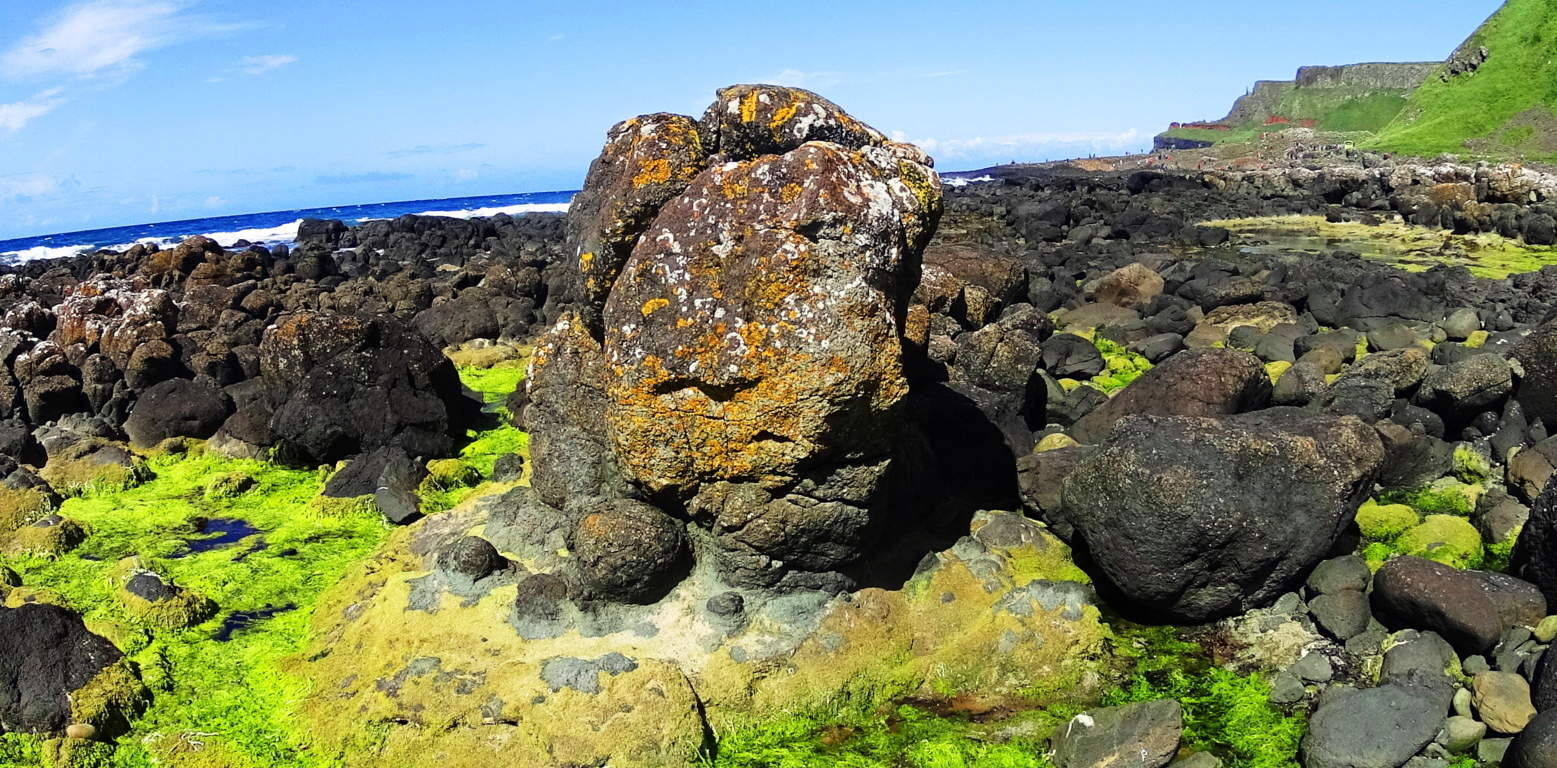 Continuing eastward along the trail the Causeway’ emerges, and not without what looks like playfully designed characteristics. At first glance, the leveling of the hexagonal stones in certain areas, combined with the orientation of this circular stone enclosure, give the impression that it was once perfectly carved-out to face the Sun, all while encapsulating water in a small protected ‘hot tub’ type space (Image/Below).
Continuing eastward along the trail the Causeway’ emerges, and not without what looks like playfully designed characteristics. At first glance, the leveling of the hexagonal stones in certain areas, combined with the orientation of this circular stone enclosure, give the impression that it was once perfectly carved-out to face the Sun, all while encapsulating water in a small protected ‘hot tub’ type space (Image/Below).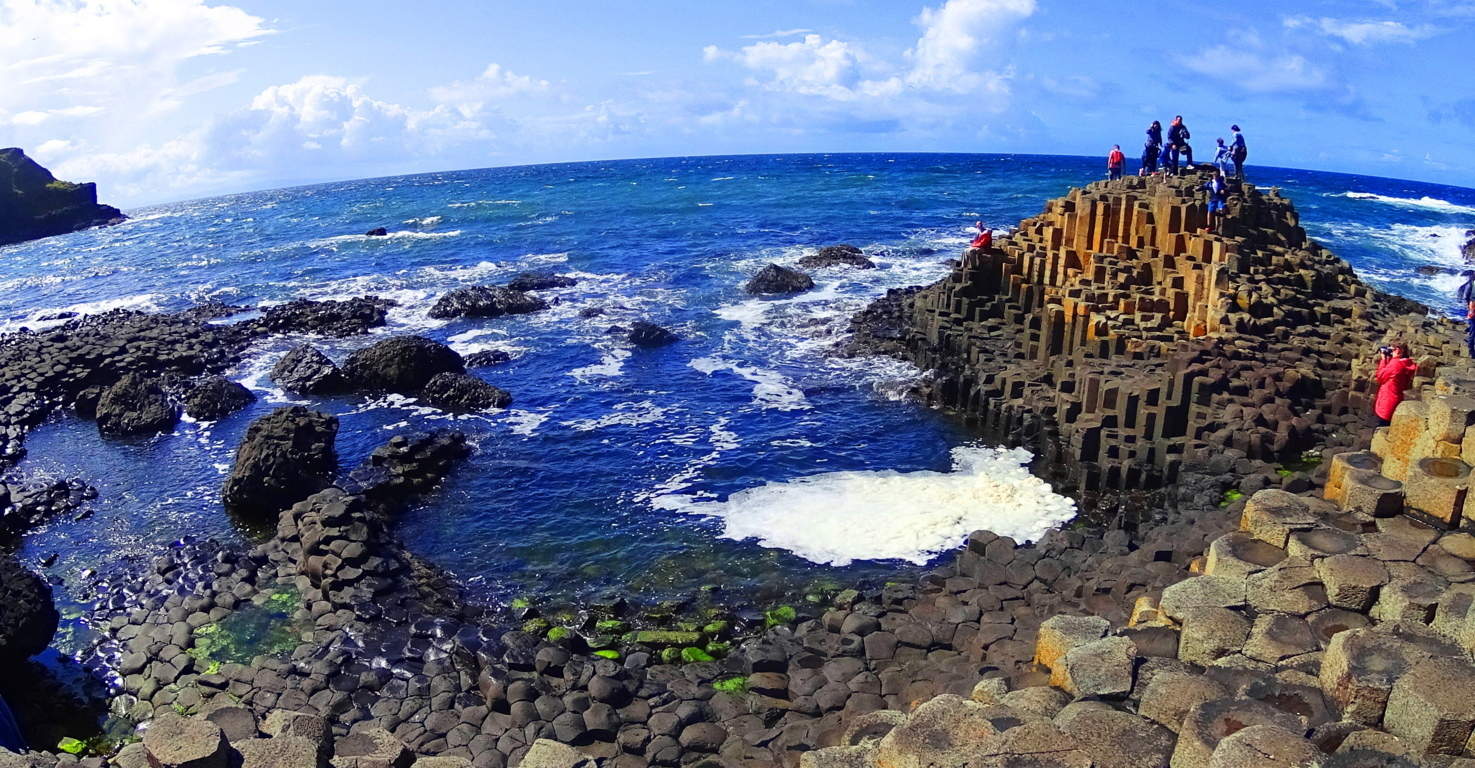 Taking a seat on the stones while the Sun shines overhead absolutely creates the feeling of a Spa. The area feels entirely functional and intentional, like many Neolithic places along waterfalls and mountainsides in New England, Wales, Scotland, and England. Continuing on the trail will bring you through a hexagonal stone gate, over a small hill, and then up the coastal path you go. As you begin the minor incline upward, yet another lessor-written-about feature is embedded perfectly into the coastal mountain face, and in only one specific area. How did lava quarry-out a perfectly squared set of evenly sectioned and leveled hexagonal stones inside the mountain? Why does the stone directly above these towering hexagonal shafts remain regular? Wouldn’t these stones have absolutely been affected by this magical lava flow which seems to pick and choose, even organize, specific sections of the coast for influence? Wouldn’t these shafts be spread at random, all over the scene, for miles perhaps? It just doesn’t make sense. And of course, these shafts are not published and written about in so many text books. Why? Because the logical questions they raise are too free of the authority of those who write the textbooks. Academics know that most of us will never see this place for ourselves. Stonestrider.com exists to inspire hikers, humble or affluent, to break through the paradigm and expectations of the individuals who are re-writing our histories, and see for themselves.
Taking a seat on the stones while the Sun shines overhead absolutely creates the feeling of a Spa. The area feels entirely functional and intentional, like many Neolithic places along waterfalls and mountainsides in New England, Wales, Scotland, and England. Continuing on the trail will bring you through a hexagonal stone gate, over a small hill, and then up the coastal path you go. As you begin the minor incline upward, yet another lessor-written-about feature is embedded perfectly into the coastal mountain face, and in only one specific area. How did lava quarry-out a perfectly squared set of evenly sectioned and leveled hexagonal stones inside the mountain? Why does the stone directly above these towering hexagonal shafts remain regular? Wouldn’t these stones have absolutely been affected by this magical lava flow which seems to pick and choose, even organize, specific sections of the coast for influence? Wouldn’t these shafts be spread at random, all over the scene, for miles perhaps? It just doesn’t make sense. And of course, these shafts are not published and written about in so many text books. Why? Because the logical questions they raise are too free of the authority of those who write the textbooks. Academics know that most of us will never see this place for ourselves. Stonestrider.com exists to inspire hikers, humble or affluent, to break through the paradigm and expectations of the individuals who are re-writing our histories, and see for themselves. 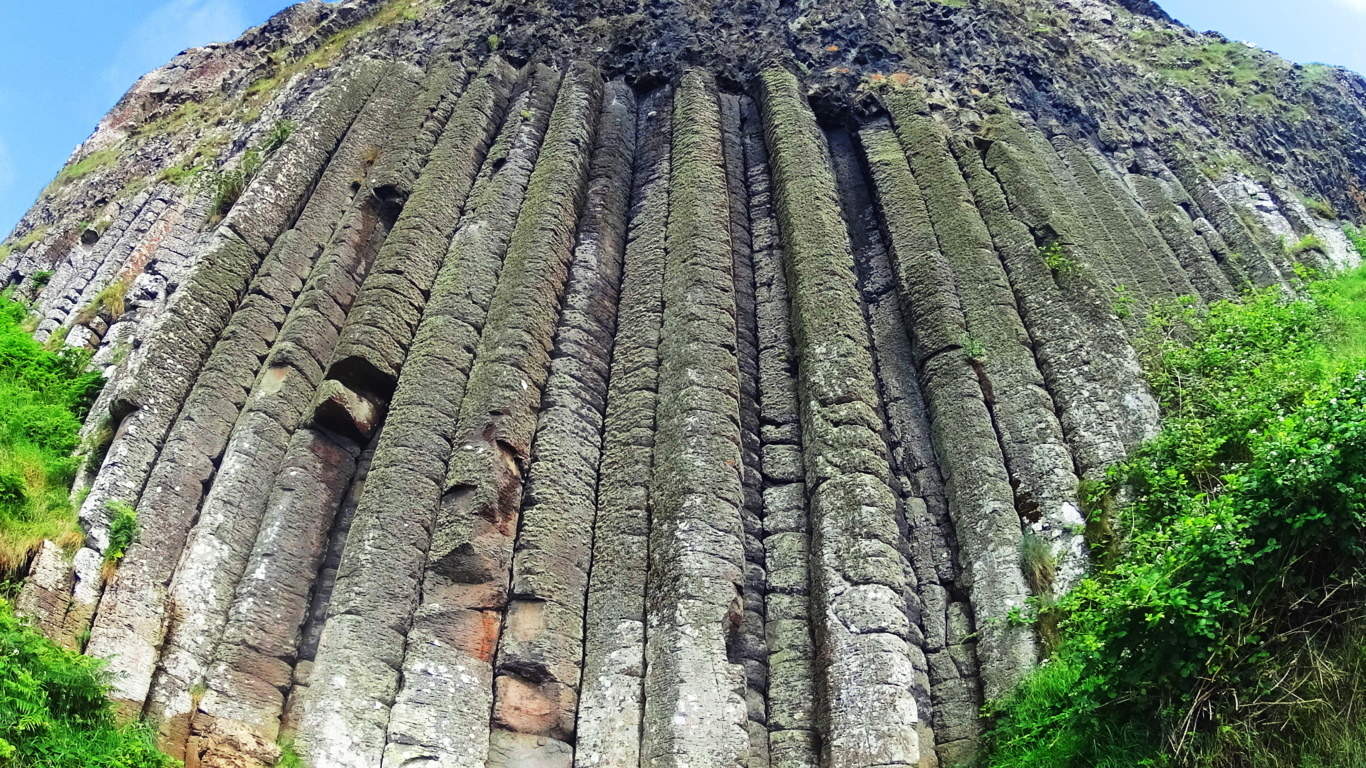
Continuing up this wonderful trail brings an endearing visual of the entire bay. It is no wonder that about 5 miles west, down the coast, sits Dunluce Castle, a gorgeous 13th century fortification built at the edge of a cliff, and practically the northern edge of Ireland. This castle was utilized and enhanced wonderfully in Game of Thrones, a well deserved compliment to the area. In its day, Dunluce must have been one of the most desired residences in all of Ireland. The grounds at Dunluce are open for walking, and it is certainly recommended to any sojourners to visit this incredible stone palace.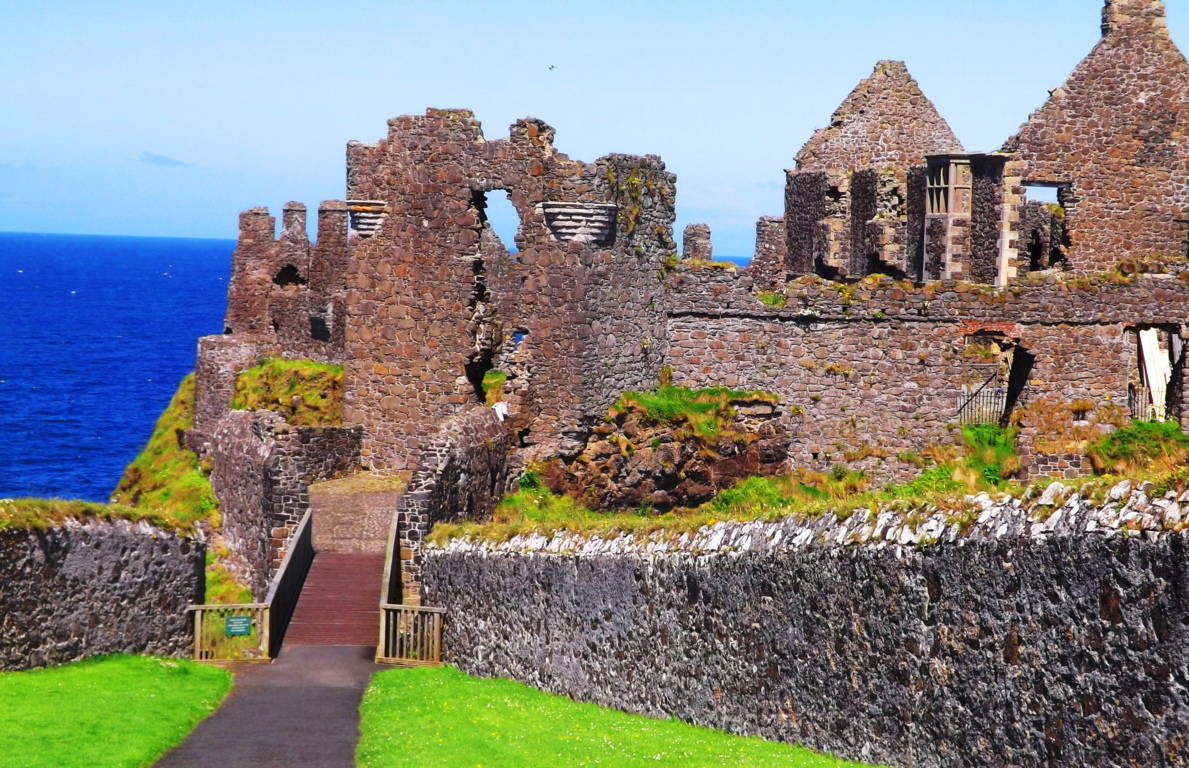 Returning to the easterly trail above the Causeway’, the elevation rises as you approach the edge of the bay. Why don’t the stones below the trail, which are much closer to any theoretical flow of lava which they say came up from the water, have hexagonals? How did the lava pass them over, and then cut into the specific stones above? Logically it just doesn’t hold up.
Returning to the easterly trail above the Causeway’, the elevation rises as you approach the edge of the bay. Why don’t the stones below the trail, which are much closer to any theoretical flow of lava which they say came up from the water, have hexagonals? How did the lava pass them over, and then cut into the specific stones above? Logically it just doesn’t hold up.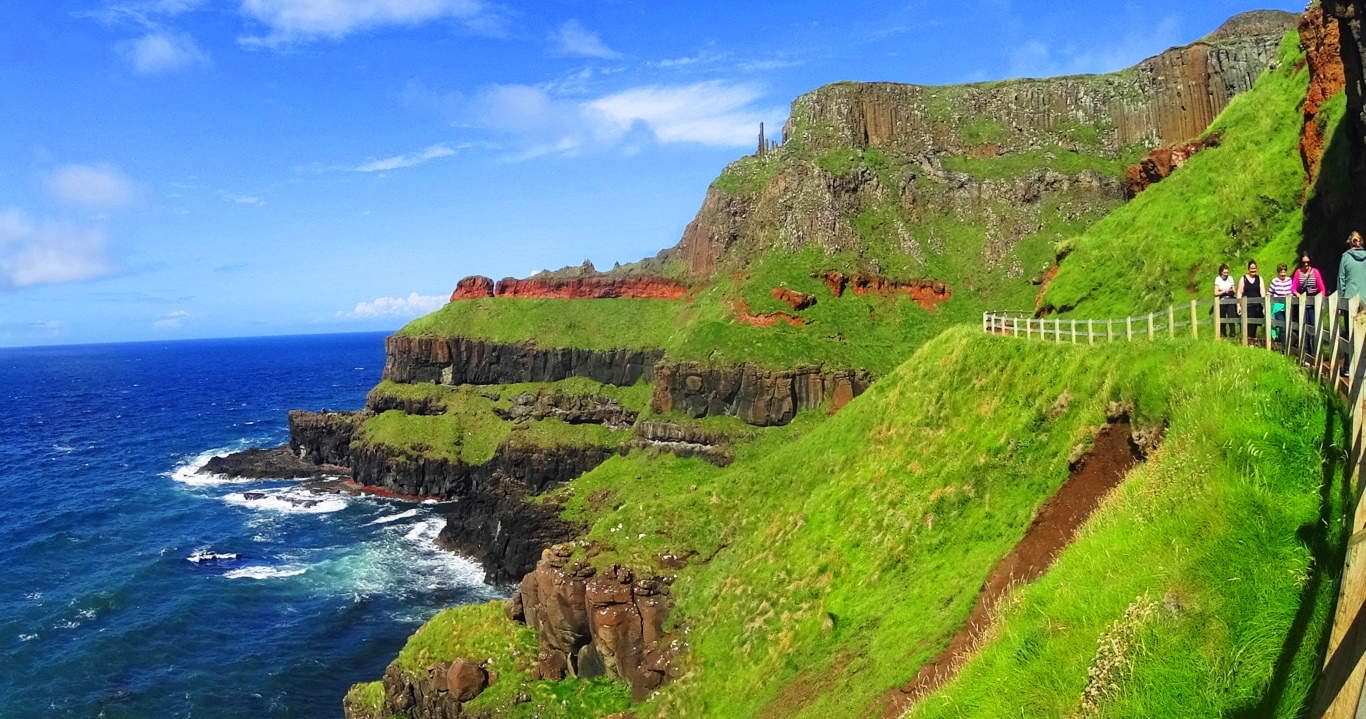 Just beyond, and above the trail, is another set of singular hexagonal stones, and in an even more specific position.
Just beyond, and above the trail, is another set of singular hexagonal stones, and in an even more specific position. 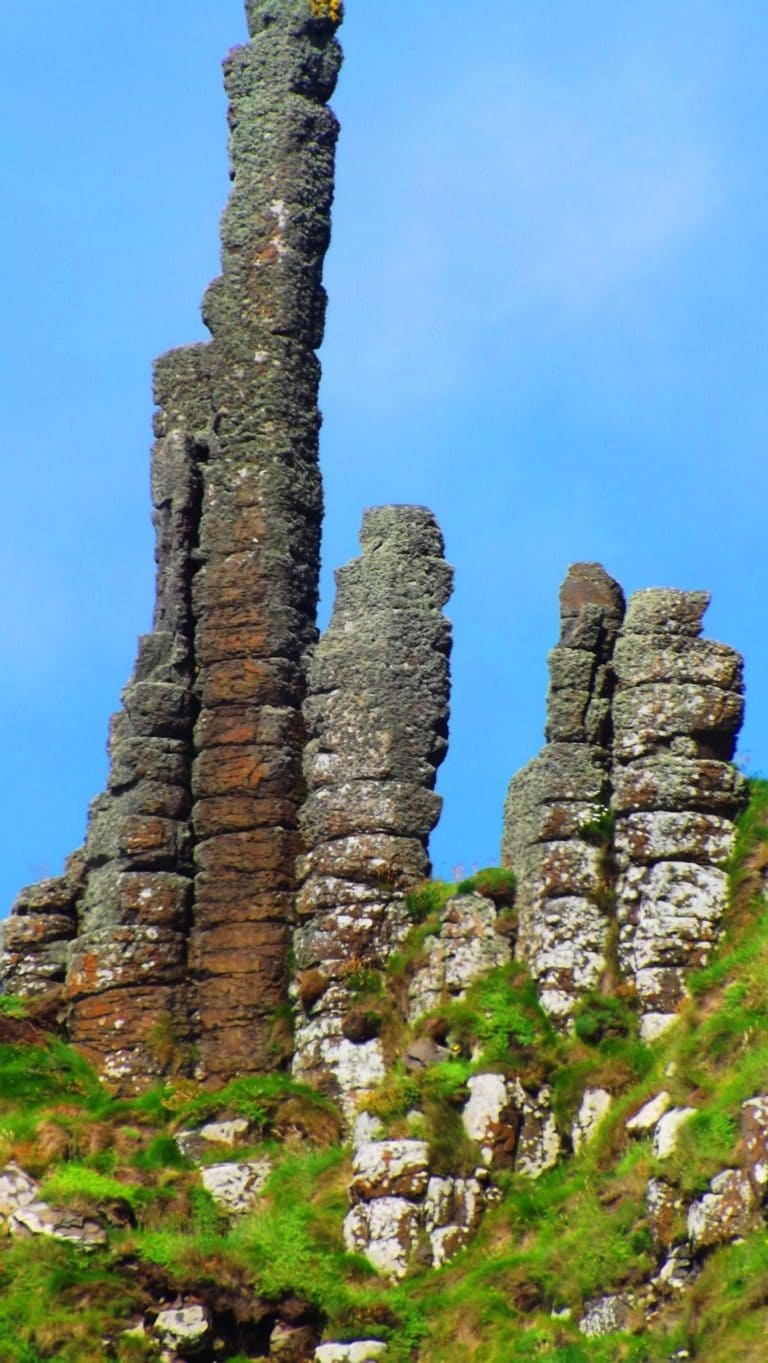 These stones mark the edge of The Giant’s Causeway, like a specific warning sign; it says someone skillful enough to create these picturesque pillars once occupied this place (Below/Left).
These stones mark the edge of The Giant’s Causeway, like a specific warning sign; it says someone skillful enough to create these picturesque pillars once occupied this place (Below/Left).
This beautiful trail bends around to the next grand cove, and up out of the coastal wall, continuing on the mainland, looping back to its start for another 1.5 miles. But the other coves do not contain the hexagonals; intact, no other coves do anywhere in Ireland, Many people simply walk back down the trail from the direction they came to get a last look at the Causeway’. Who could blame them? Passing through this place a hiker can see that there really is no logical way to explain what has taken place here. The magical aspect of hiking and trailblazing is palpable; stories about its origin have survived for century upon century. Just as the earliest Hebrew scriptures record the presence of Giants in the land, well before the tribes of mankind swept into their valleys, Ireland and England’s earliest tales are of giants. The name “Giant’s Causeway” is not without substance. It is here that Fin McCool, the most famous Giant in both Ireland and England, is said to have exacted tolls upon those wishing to enter Ireland from the north. There are stories of epic battles with other Giants from Scotland and England, and looking around the Causeway’ it is just impossible to ignore the possibility of Fin’s presence. Looking back on the entire scene would justify any fight in order to hold on to this beautiful and epic space.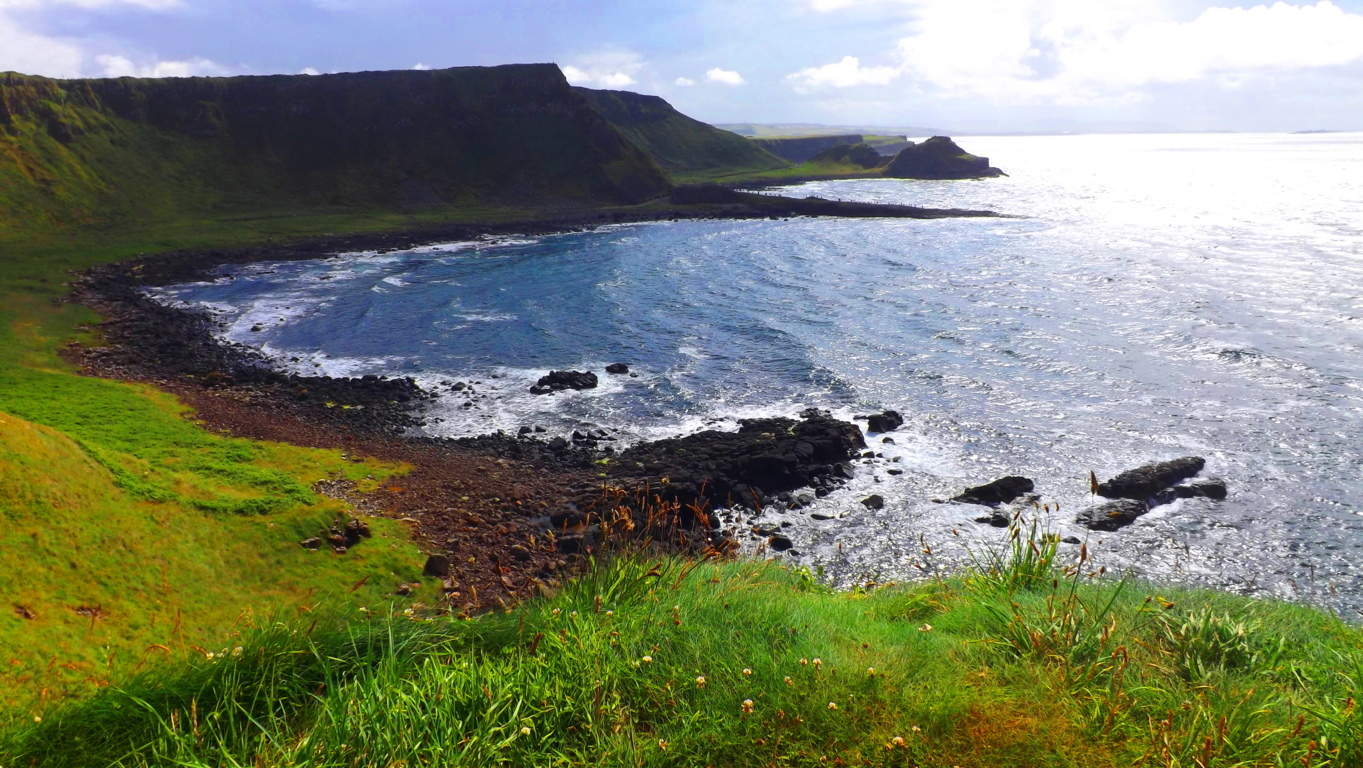 Hikers, anthropologists, story-tellers, and locals, are left to choose between stories or scientific theories, both of which stretch our imaginations, either in one direction or the other. Science seems no less ridiculous than myth, and our personal cognitive abilities are ultimately required to decipher places like this, which is a testament to its magical vibration. It would be a lot easier to dismiss the idea of Giants as ridiculous if they weren’t written about so clearly in ancient scripture, and embedded in literally every cultures deepest mythical roots. Hike the Causeway’ for yourself, it’s the only way to get just a little closer to what actually might be the case here. As a new Spring emerges, give yourself a worthy challenge and head to the beautiful northern Irish coast; it’s a “can’t miss”. And of course, may the road rise to meet you, until the cove of hexagonals greet you.
Hikers, anthropologists, story-tellers, and locals, are left to choose between stories or scientific theories, both of which stretch our imaginations, either in one direction or the other. Science seems no less ridiculous than myth, and our personal cognitive abilities are ultimately required to decipher places like this, which is a testament to its magical vibration. It would be a lot easier to dismiss the idea of Giants as ridiculous if they weren’t written about so clearly in ancient scripture, and embedded in literally every cultures deepest mythical roots. Hike the Causeway’ for yourself, it’s the only way to get just a little closer to what actually might be the case here. As a new Spring emerges, give yourself a worthy challenge and head to the beautiful northern Irish coast; it’s a “can’t miss”. And of course, may the road rise to meet you, until the cove of hexagonals greet you.
The Hen Mountain/Mourne Range/Ireland
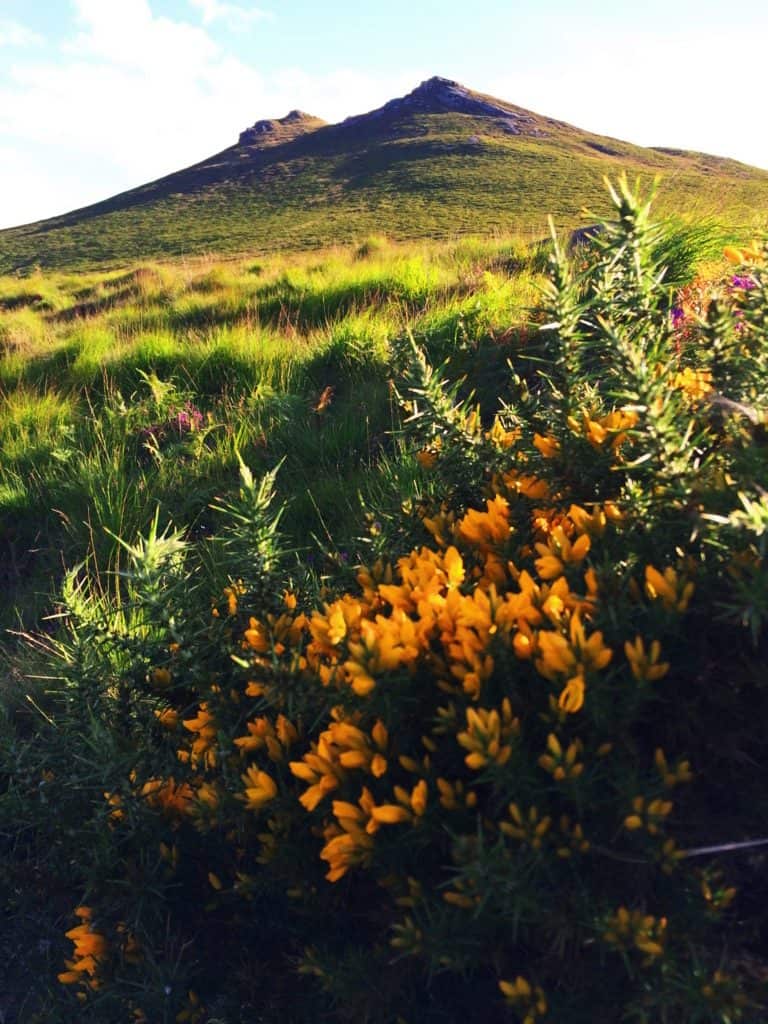 Location: Newry Ireland
Location: Newry Ireland
Elevation: 1653 ft/5o8m
The Hen Mountain sits at the northeastern extremity of the Mourne Mountain Range. It is the lessor elevated gateway to an area known nationally as a “place of outstanding beauty”, rolling east all the way to the harbor city of Newcastle, and the dreamy Irish Sea. The gorgeous hamlet of Hilltown sits just west of The Hen, which is the practically perfect jumping-off point for this small mountain. The main car park for The Hen Trail is off Sandbank Road, near the beautiful River Bann, which can easily be found. The Hen, with it’s classically Celtic treeless approach, is entirely welcoming. I was so drawn to the view of this small summit from my deck at Hilltown that I literally ran down to the River Bann, hopped the fence, crossed the rocky river bed, and started an ascent from the northwest with my sneakers on. The image on the left was taken while standing in my sneakers at the base of the Mountain. It was just that type of day. When the Sun comes out in Ireland the landscape becomes a vision. The wildflowers in the area glow in variations of gold, green, and velvet.The image below shows Mount Hen, second from the left, taken from my accommodations in Hilltown. This was exactly how I pictured J.R.R Tolkien’s “Shire”.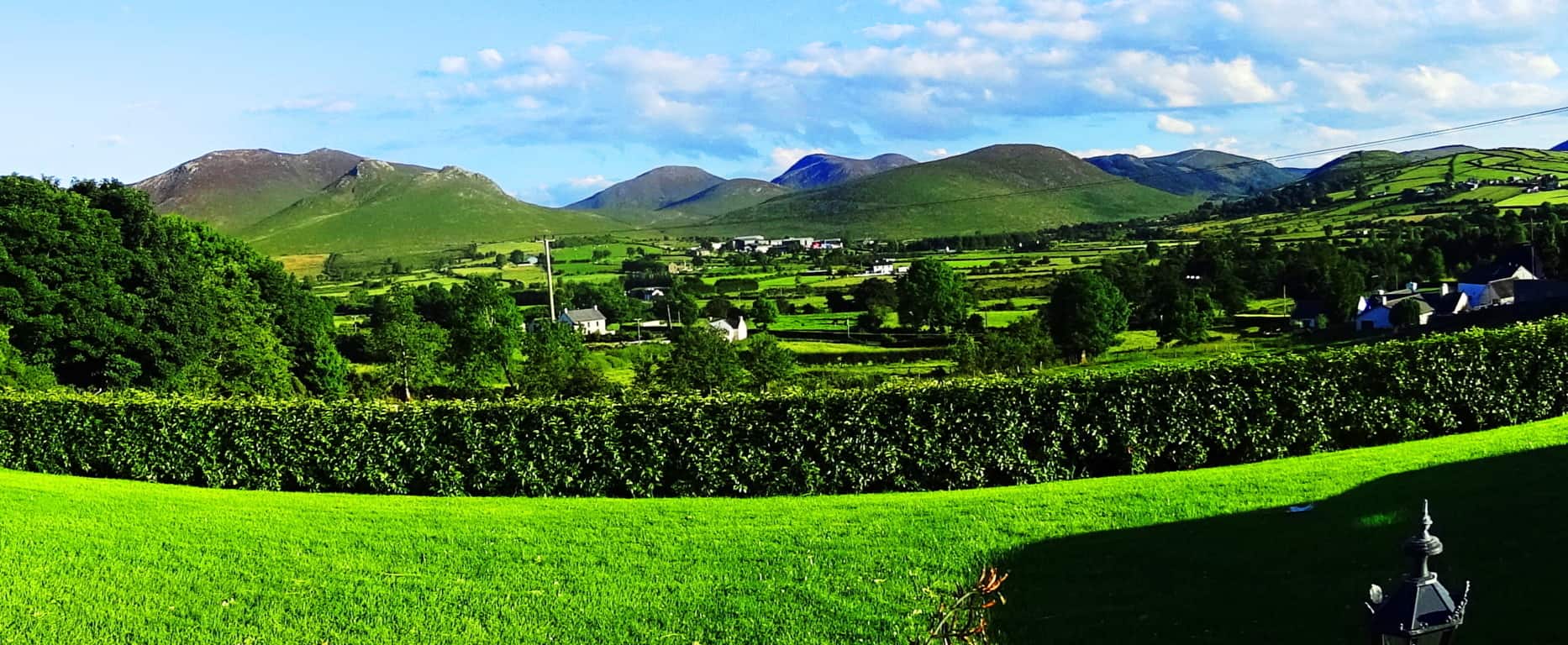
The River Bann reminded me of so many rocky streams in the Massachusetts hills, with several massive free-standing boulders lining the sides of the flowing stream. The scientific explanation for these boulders is, of course, glacial, but several of the larger stones look as if they had been cut and angled specifically, which is often found near sacred mountains in New England, and here in The Mourne. Additionally, coming from New England, where the forests are an overpowering aspect to any landscape, views like this, where not even a single Hawthorn tree can be seen on the horizon, are a constant surprise to the senses. It is truly surreal. The mountains are roughly the same scale as New England’s smaller ranges, but the peaks just look so much more stoic, without one single tree. 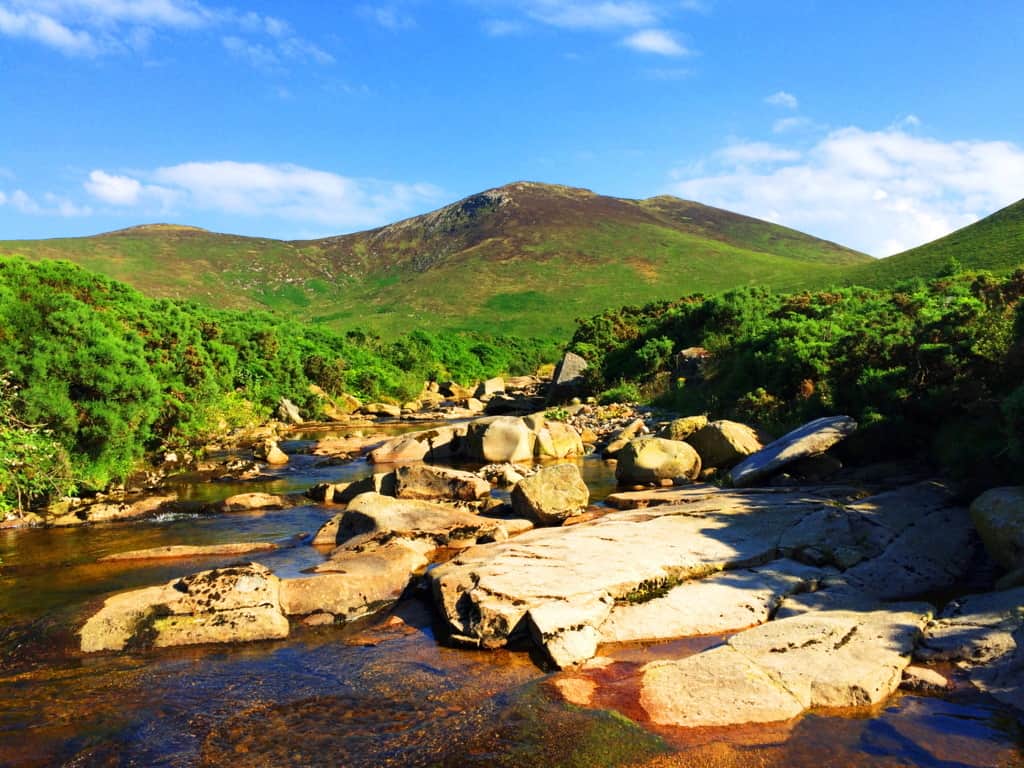 The Sandbank Trail is actually on the other side of the Mountain from this spot on the river, along the eastern face, about 400 yards away. In Celtic places the opportunity to wander should be embraced; there are no animals that could overpower you (like a Bear or Wolf), and the chances of stumbling upon Neolithic expressions are pretty good. And perhaps most importantly, this is one of the best places in the world to take out your camera(s).
The Sandbank Trail is actually on the other side of the Mountain from this spot on the river, along the eastern face, about 400 yards away. In Celtic places the opportunity to wander should be embraced; there are no animals that could overpower you (like a Bear or Wolf), and the chances of stumbling upon Neolithic expressions are pretty good. And perhaps most importantly, this is one of the best places in the world to take out your camera(s).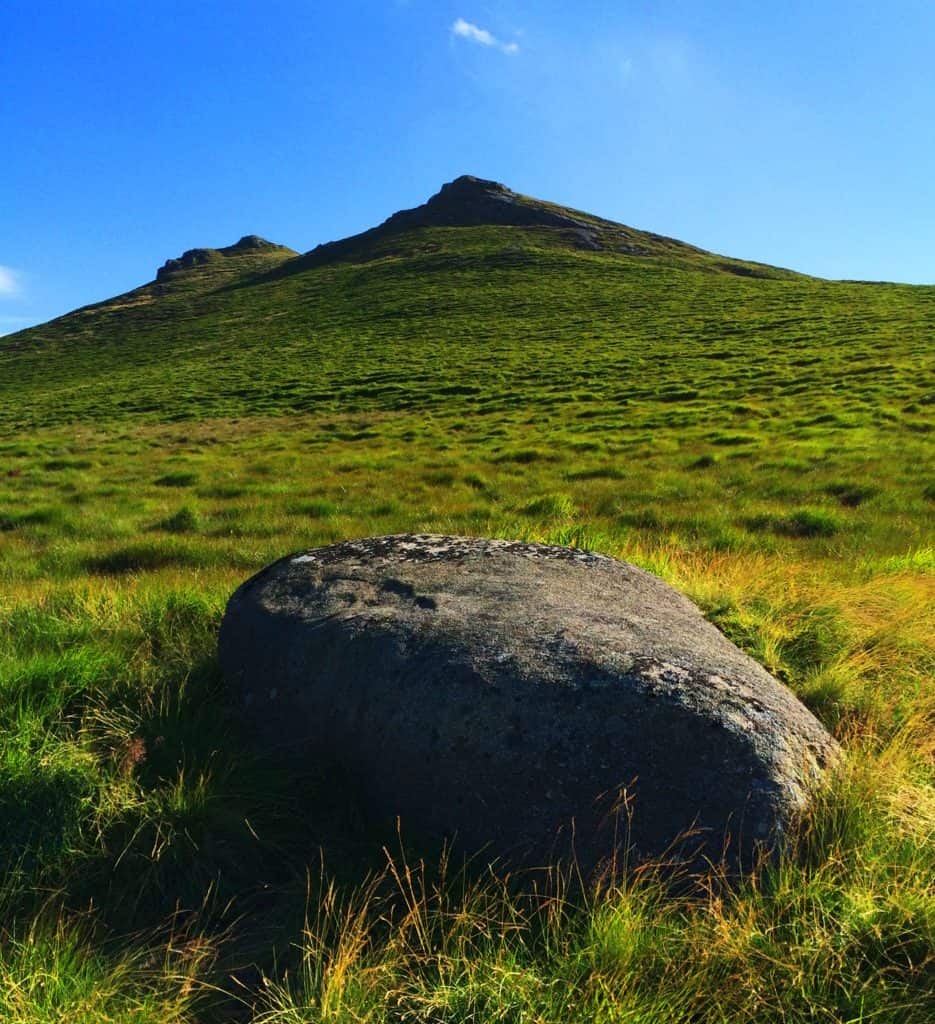
Heading directly up the mountainside from the river, climbing over the farmers fence, I came across this lonely boulder. It was a like seat for watching the lower valley.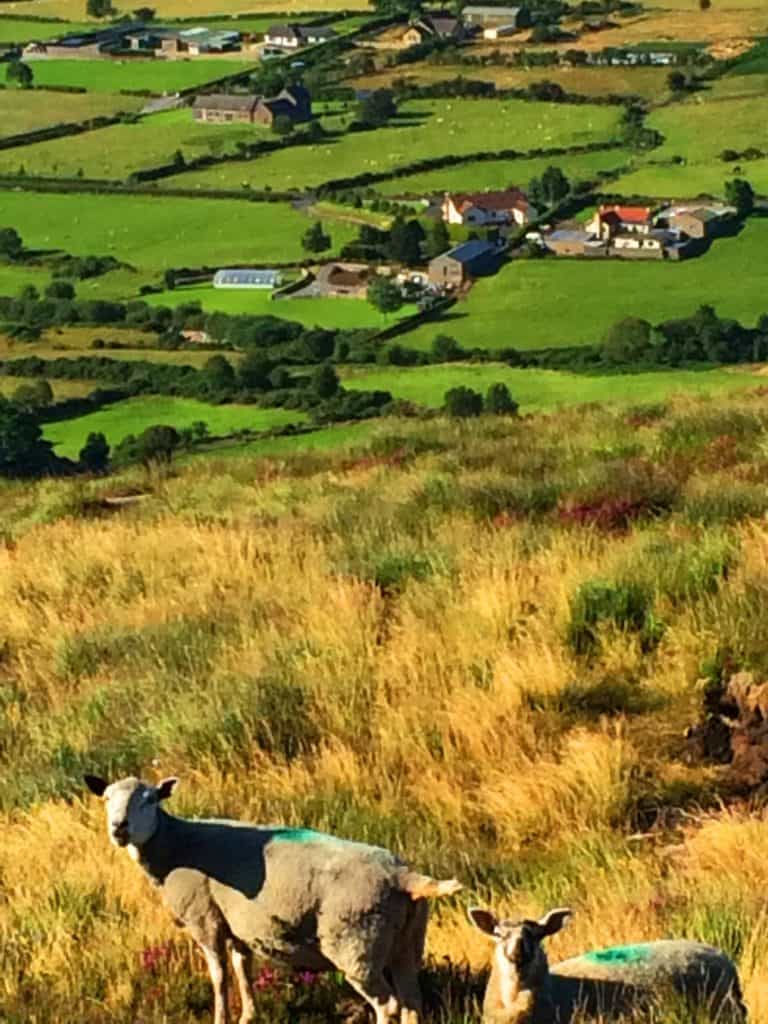 Flocks of sheep rove the hillside with farms in foreground, all bustling and interwoven into a rural tapestry that America has almost forgotten. Ireland remains one of the the most functionally rural European country’s, where men over the age of 70 can be seen in the tractors hauling hay, while the elderly in America linger in nursing homes. Experiencing a nation where the food is fresh, without preservatives and processing, can have your body feeling stronger and more awake, in a relatively short period of time. Here I will venture to share a rare introspective moment that took place from this beautiful scene. Things at times become incredibly clear while hiking, super-clear. I began to think about America, and it was perhaps a thought I had been waiting to have for some time. Americans are confronted with a universe of processed and artificial foods on a daily basis, wars, social movements, and scandals, and while hiking in the safety of a place like this, I simply could not help but wonder what the hell has been going on in the United States for the last 15 years, and how the rest of the world truly sees us. It is borderline embarrassing. Ironically, so many locals in Newcastle expressed their desire to be in Boston, where I was from, having little awareness of the truly challenging social experience America forces upon its citizens today. All of this crossed my mind as I made my climb. Turning and facing the peak the wildflowers ran concentrically in what felt like a spiraling parade of color, radiating down the ledge. These are the places to wade in, like wandering into a dream.
Flocks of sheep rove the hillside with farms in foreground, all bustling and interwoven into a rural tapestry that America has almost forgotten. Ireland remains one of the the most functionally rural European country’s, where men over the age of 70 can be seen in the tractors hauling hay, while the elderly in America linger in nursing homes. Experiencing a nation where the food is fresh, without preservatives and processing, can have your body feeling stronger and more awake, in a relatively short period of time. Here I will venture to share a rare introspective moment that took place from this beautiful scene. Things at times become incredibly clear while hiking, super-clear. I began to think about America, and it was perhaps a thought I had been waiting to have for some time. Americans are confronted with a universe of processed and artificial foods on a daily basis, wars, social movements, and scandals, and while hiking in the safety of a place like this, I simply could not help but wonder what the hell has been going on in the United States for the last 15 years, and how the rest of the world truly sees us. It is borderline embarrassing. Ironically, so many locals in Newcastle expressed their desire to be in Boston, where I was from, having little awareness of the truly challenging social experience America forces upon its citizens today. All of this crossed my mind as I made my climb. Turning and facing the peak the wildflowers ran concentrically in what felt like a spiraling parade of color, radiating down the ledge. These are the places to wade in, like wandering into a dream. The brush here is deep, knee high, and strenuous to climb. The Irish Sea is only about 7 miles away, and the hedges have a toughness to them, a saltiness just beneath the surface, perhaps carried on the wind. Complimenting this faint ocean breeze is a strong Sun which can be felt warmly on the skin. Although many people do not picture Ireland’s climate in this way, when the Sun is out, windburn is a real possibility in the heights; in The Mourne the body can be fooled by the wind, seeming cool while outside, but later revealing a burn when out of the breeze.
The brush here is deep, knee high, and strenuous to climb. The Irish Sea is only about 7 miles away, and the hedges have a toughness to them, a saltiness just beneath the surface, perhaps carried on the wind. Complimenting this faint ocean breeze is a strong Sun which can be felt warmly on the skin. Although many people do not picture Ireland’s climate in this way, when the Sun is out, windburn is a real possibility in the heights; in The Mourne the body can be fooled by the wind, seeming cool while outside, but later revealing a burn when out of the breeze. 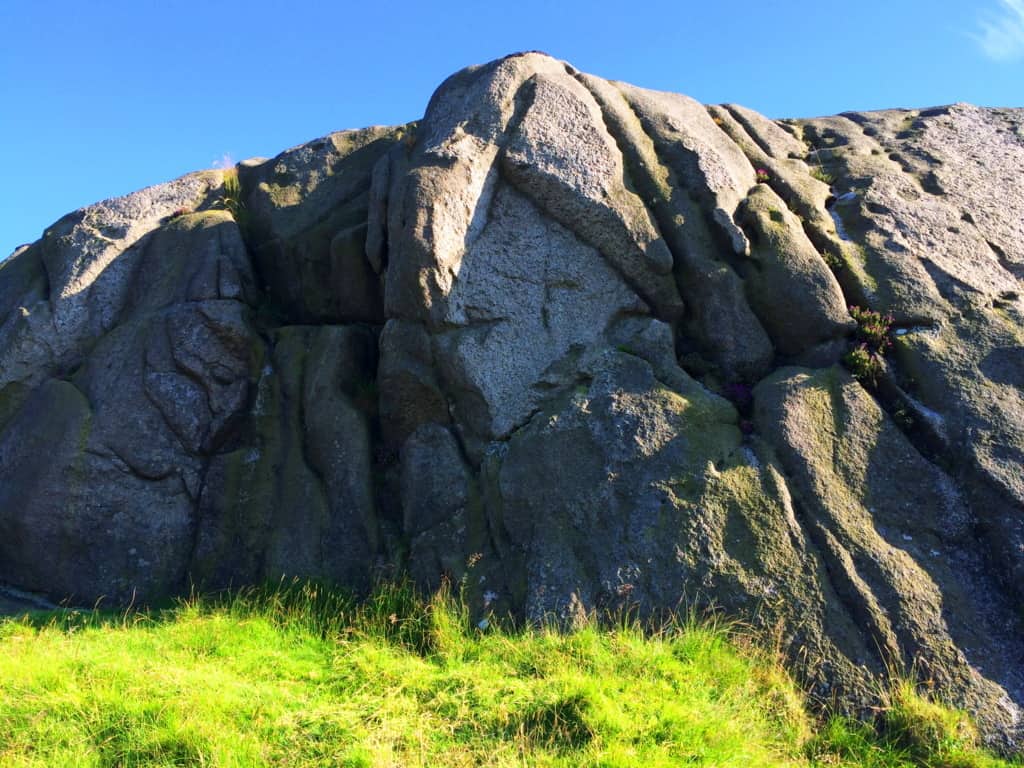
It is said by Hebrew texts, that the fall of 300 angels took place, once upon a time, upon Mount Hermon, in Lebanon. While hiking in the heights of many mountains this is a story that has crossed my mind many times, especially while approaching peaks. If this story were true, than this culture of fallen angels would have claimed the high places first, coming from above, however surreal it sounds. And what we find in so many of the high places, in mountain ranges all across the world, are megalithic statements of impossibly large, but crafted stones. Hen Mountain’s peak is capped in solid rock, with indents and fixtures that are seemingly crafted into it. The anthropological side of hiking takes place as you explore the rocky ledges in the heights, and turn to see the beauty of the valley below. Simply put, the rocks tell a story, and a well trained eye can read that story. There are lineations in the rocky peak that are hard to describe. These parallel streaks look to have been burned, or smelted into the stone. These streaks look eerily like they were made to mimic the rippling landscape beyond, all at the top of the mountain.
Simply put, the rocks tell a story, and a well trained eye can read that story. There are lineations in the rocky peak that are hard to describe. These parallel streaks look to have been burned, or smelted into the stone. These streaks look eerily like they were made to mimic the rippling landscape beyond, all at the top of the mountain.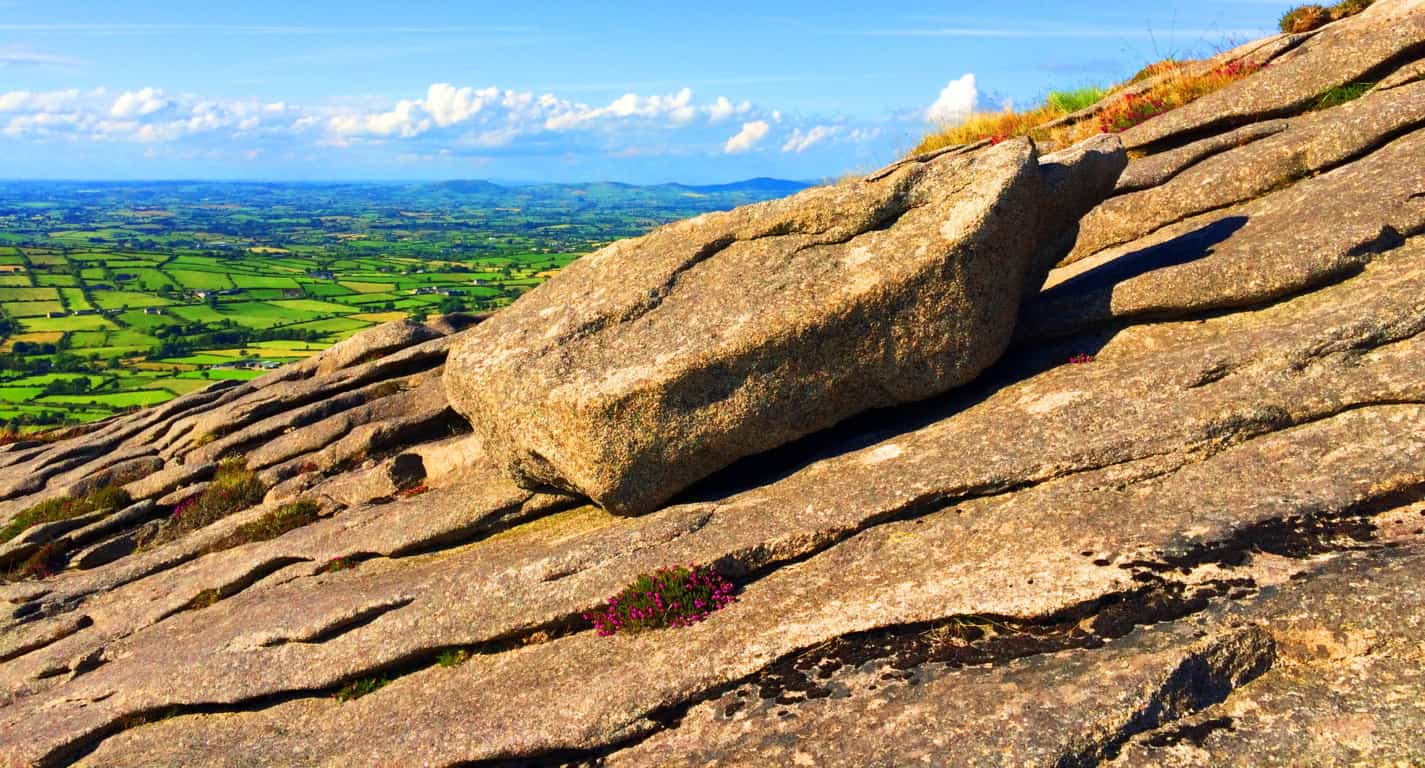 Here at the peak, this single 1 ton stone sat freely and in complete coherence with the parallel streaks beneath it. There were no other stones like it. With the scruffy wildflowers that somehow spurt out of the crags in the rock, and the layers of green beyond, this feels like the precipice of another world, however small the mountain truly is. This is the game that the peaks of mountains play, no matter what part of the world you find yourself in. At only 1,653 feet the feeling on Hen Mountain is still ‘top of the world’, as the Celtic landscape rolls nakedly away into the horizon.
Here at the peak, this single 1 ton stone sat freely and in complete coherence with the parallel streaks beneath it. There were no other stones like it. With the scruffy wildflowers that somehow spurt out of the crags in the rock, and the layers of green beyond, this feels like the precipice of another world, however small the mountain truly is. This is the game that the peaks of mountains play, no matter what part of the world you find yourself in. At only 1,653 feet the feeling on Hen Mountain is still ‘top of the world’, as the Celtic landscape rolls nakedly away into the horizon.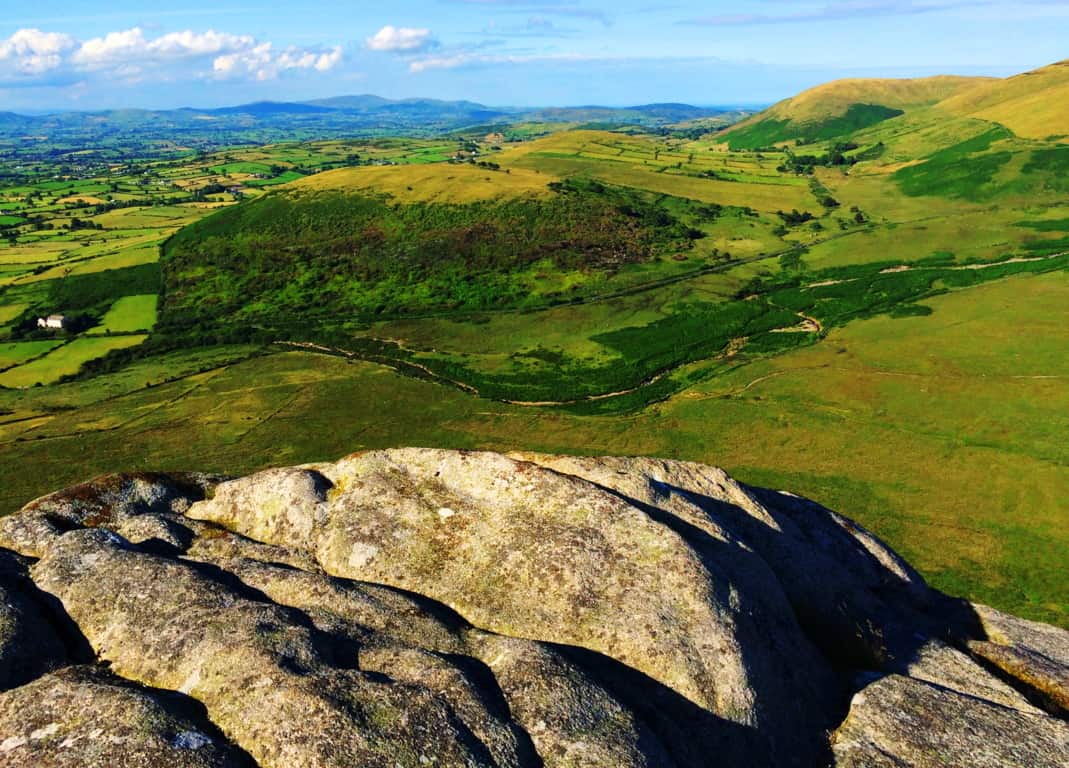
Facing to east at the peak Sandbank Trail can be seen approaching an elevated knoll at about 1200 feet, just below. The view beyond this “porch” is stunning, leading all the way to across the Mourne to Newcastle at the coast. In this spot there are two distinct rocky fixtures that sit like ‘gates’ as the trail passes through, and between these two fixtures is a free standing boulder that I believe was placed here as a kind of ‘marker’. A closer look at this rocky “gateway” and boulder revealed a compelling case for megalithically cultural craftsmanship.
In this spot there are two distinct rocky fixtures that sit like ‘gates’ as the trail passes through, and between these two fixtures is a free standing boulder that I believe was placed here as a kind of ‘marker’. A closer look at this rocky “gateway” and boulder revealed a compelling case for megalithically cultural craftsmanship.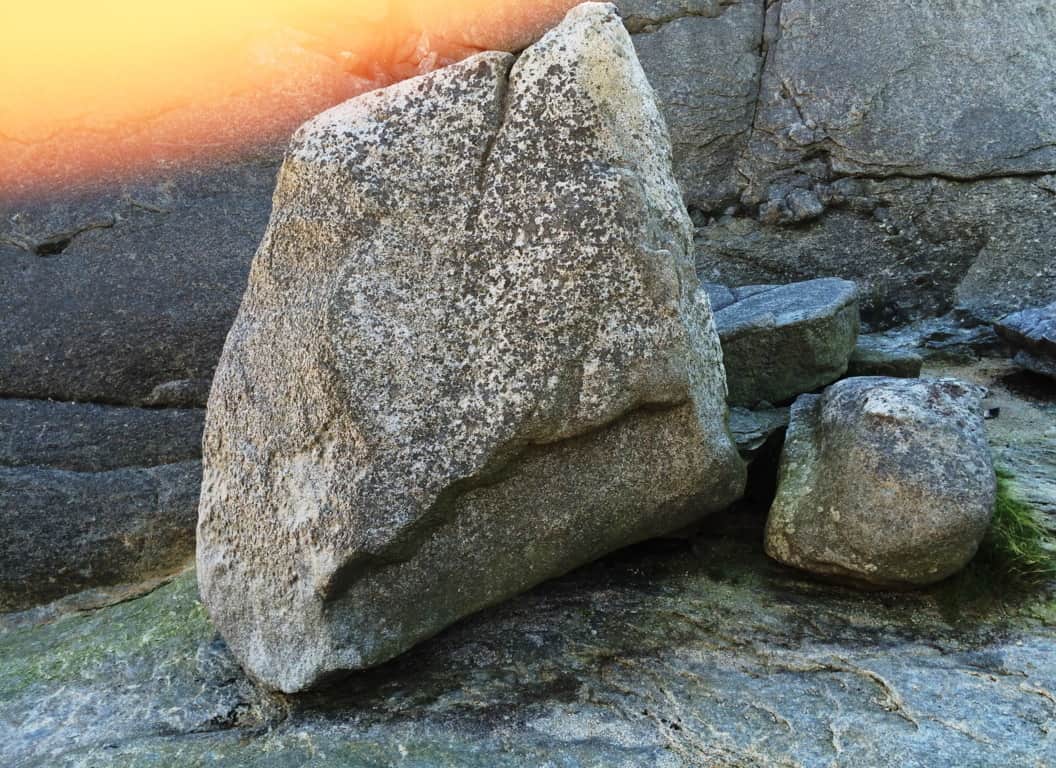 This boulder stood perfectly square at roughly 8 feet high, and 3 feet thick, upon level rock beneath. The indentation of the lower portion of the boulder, again, had the look of ‘smelted’ rock, of a design, like a cherished chair. What is more compelling about this megalith, is the exact spot upon which stands, in a beautiful gateway on the northeastern edge of the entire Mourne range, as if to say “Welcome to The Mourne, enter!” Beyond this very spot is every other mountain in the region, including Bearnagh Mountain, which contains some of the most ancient roads, and cultural stones, in the entire world.
This boulder stood perfectly square at roughly 8 feet high, and 3 feet thick, upon level rock beneath. The indentation of the lower portion of the boulder, again, had the look of ‘smelted’ rock, of a design, like a cherished chair. What is more compelling about this megalith, is the exact spot upon which stands, in a beautiful gateway on the northeastern edge of the entire Mourne range, as if to say “Welcome to The Mourne, enter!” Beyond this very spot is every other mountain in the region, including Bearnagh Mountain, which contains some of the most ancient roads, and cultural stones, in the entire world.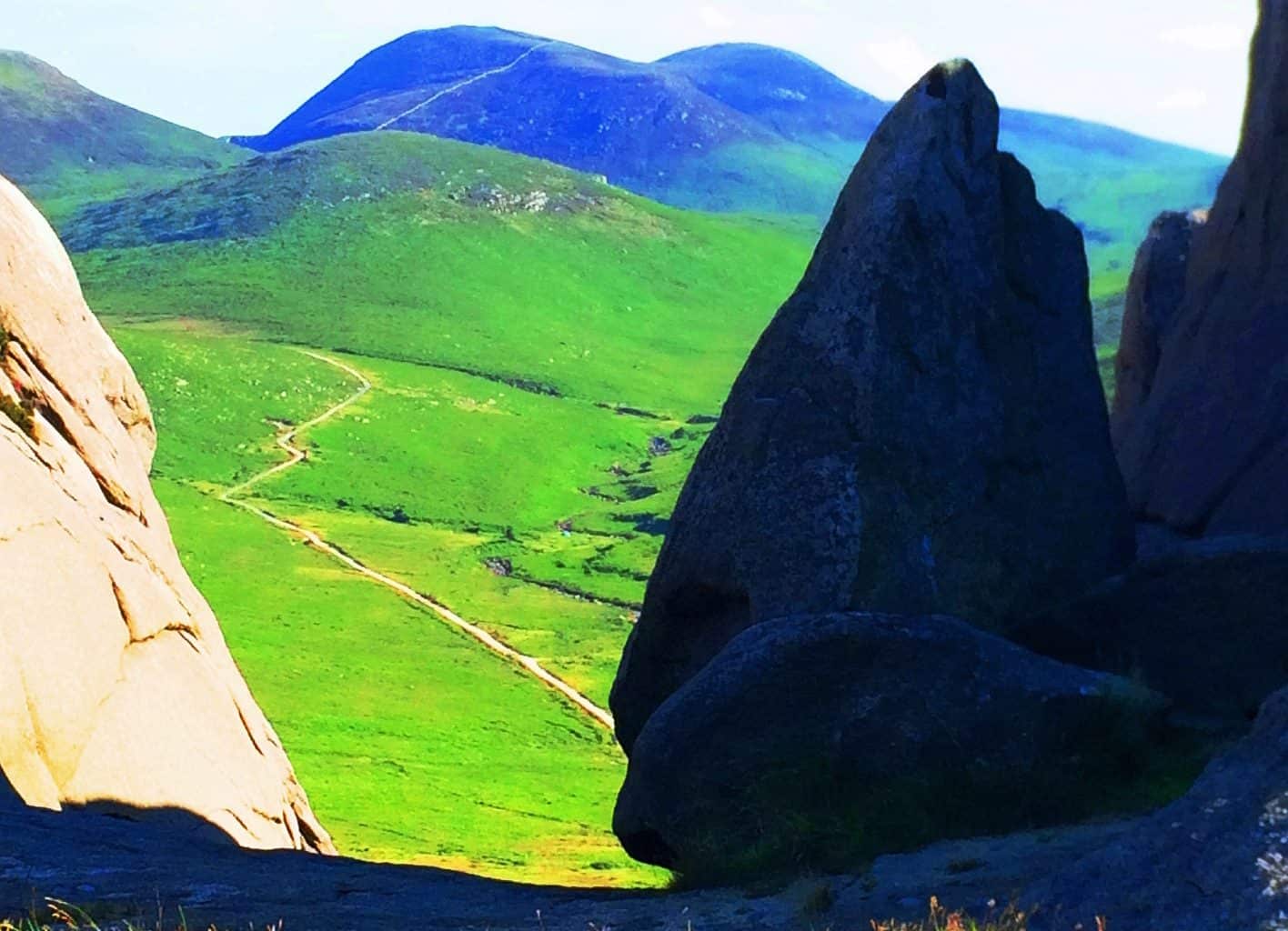 If you ever come to The Mourne Mountains, The Hen’ is a perfect place to either begin, or end your experience, as a ‘gateway’ for the entire range and relatively pleasant climb. As all hikers do, I eventually made my way back down into the valley-village of Hilltown, and simply walked back east along the Sandbank Road. Be careful here, the Irish drive at one speed, fast. On my last day in The Mourne I witnessed a sunset from the eastern edge of Hilltown that sums up the entirety of the potential experience, stunning. Anyone visiting here can experience a waking dream; it is simply a matter of going. And although this particular article was filled with more personal introspection than usual, I would like to reiterate that the soul point of each featured place is to make the hike tangible for you, the reader, so you can picture yourself getting there, above the valleys, to the stone gateways in the clouds. Thanks for reading, and go strong.
If you ever come to The Mourne Mountains, The Hen’ is a perfect place to either begin, or end your experience, as a ‘gateway’ for the entire range and relatively pleasant climb. As all hikers do, I eventually made my way back down into the valley-village of Hilltown, and simply walked back east along the Sandbank Road. Be careful here, the Irish drive at one speed, fast. On my last day in The Mourne I witnessed a sunset from the eastern edge of Hilltown that sums up the entirety of the potential experience, stunning. Anyone visiting here can experience a waking dream; it is simply a matter of going. And although this particular article was filled with more personal introspection than usual, I would like to reiterate that the soul point of each featured place is to make the hike tangible for you, the reader, so you can picture yourself getting there, above the valleys, to the stone gateways in the clouds. Thanks for reading, and go strong.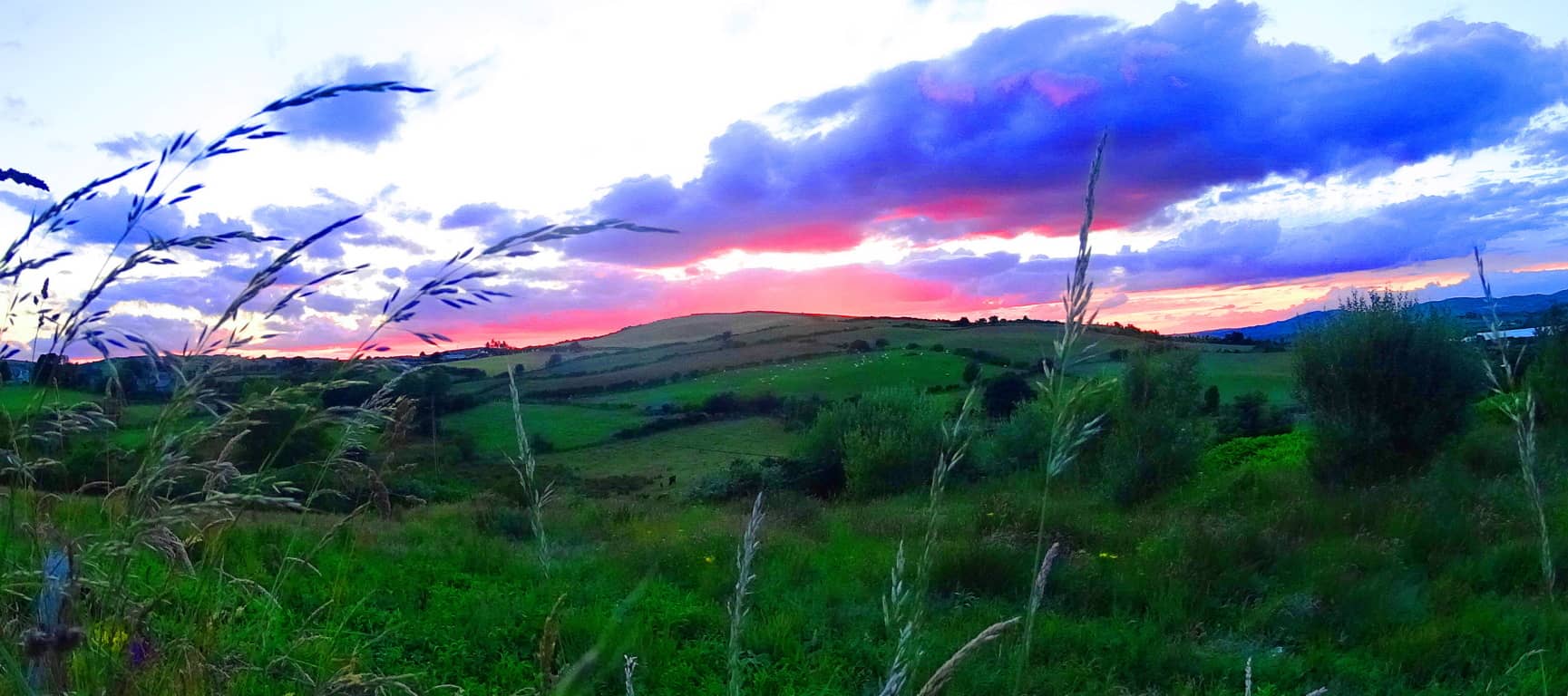
Cavan Burren National Park (Part 2: Wedge Tombs)
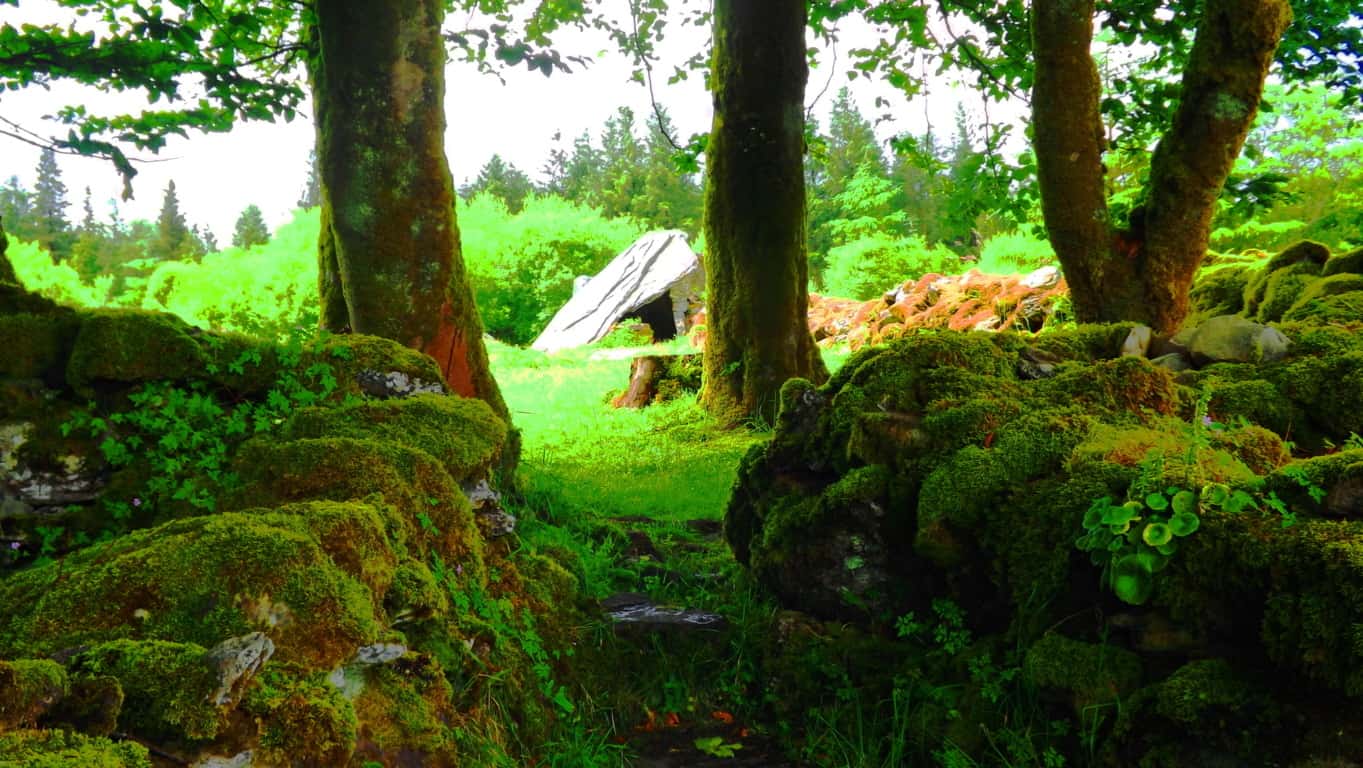 Location: Blacklion/County Cavan Ireland/Cavan Burren National Park
Location: Blacklion/County Cavan Ireland/Cavan Burren National Park
Note: Much like the way the Skellig Islands on the southwest coast of Ireland are represented in the final scene of ‘Star Wars/The Force Awakens’, Cavan Burren National Park feels like the last bastion for recluse Jedi Knights to live out their days in a galaxy, far, far away. 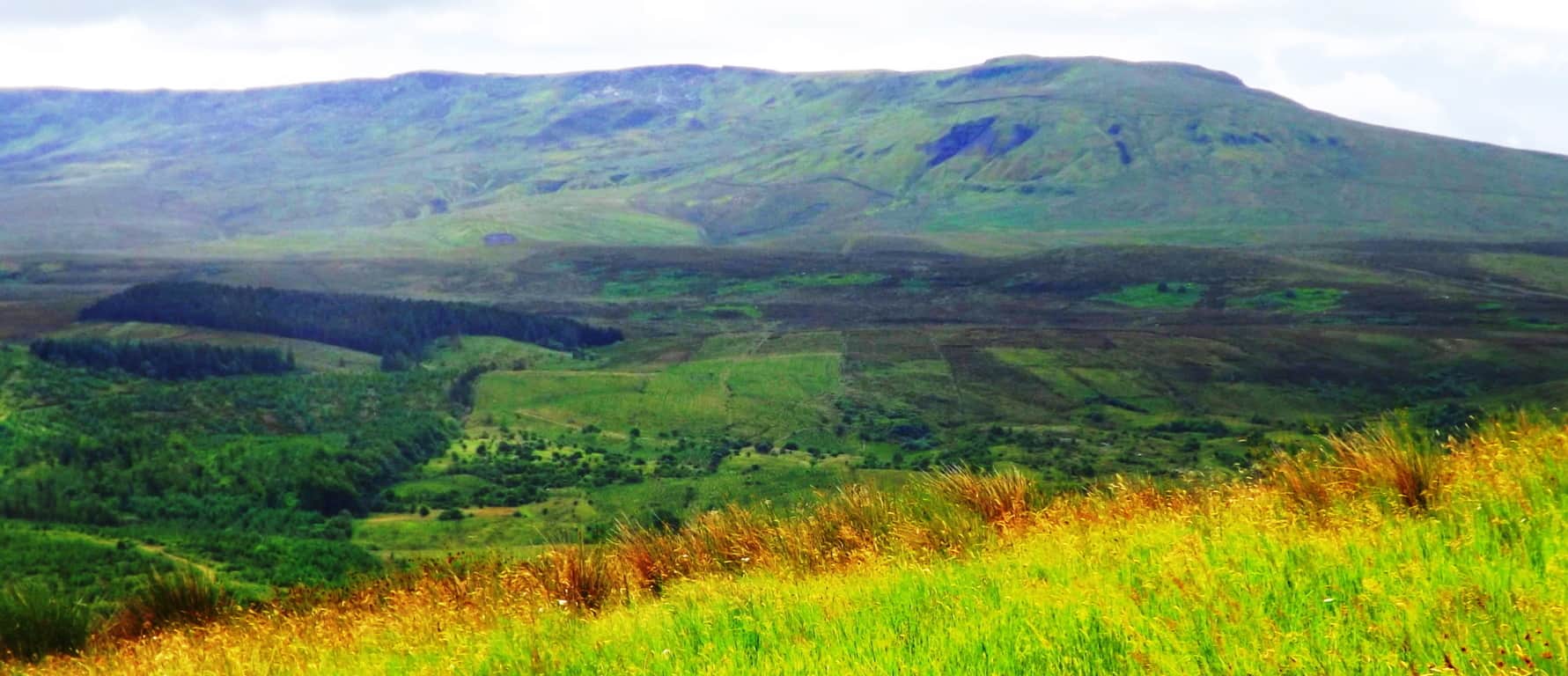 The only way to describe this set of rolling Celtic elevations, the cinematically striking Hawthorn trees vibrating on the horizon,
The only way to describe this set of rolling Celtic elevations, the cinematically striking Hawthorn trees vibrating on the horizon, the ancient stones strewn across the valley like dominos, is complete scintillation.
the ancient stones strewn across the valley like dominos, is complete scintillation.
The rare and strange megalithic ‘calf house’ in the top image above is at the base of a small mountain. The excellently constructed trails here wind down the elevation and diverge along paths which take you into pristine Celtic forest bedded entirely in clover, with ancient megaliths in mysterious rows running straight through the trees. Known as Killykeen Forest, this significant preserve of rare Celtic trees feels like an original fairytale backdrop. Adding to the universe of rolling clover are huge boulders covered in moss; these are giant green monoliths glowing between the roots and branches along the trail.
Known as Killykeen Forest, this significant preserve of rare Celtic trees feels like an original fairytale backdrop. Adding to the universe of rolling clover are huge boulders covered in moss; these are giant green monoliths glowing between the roots and branches along the trail. 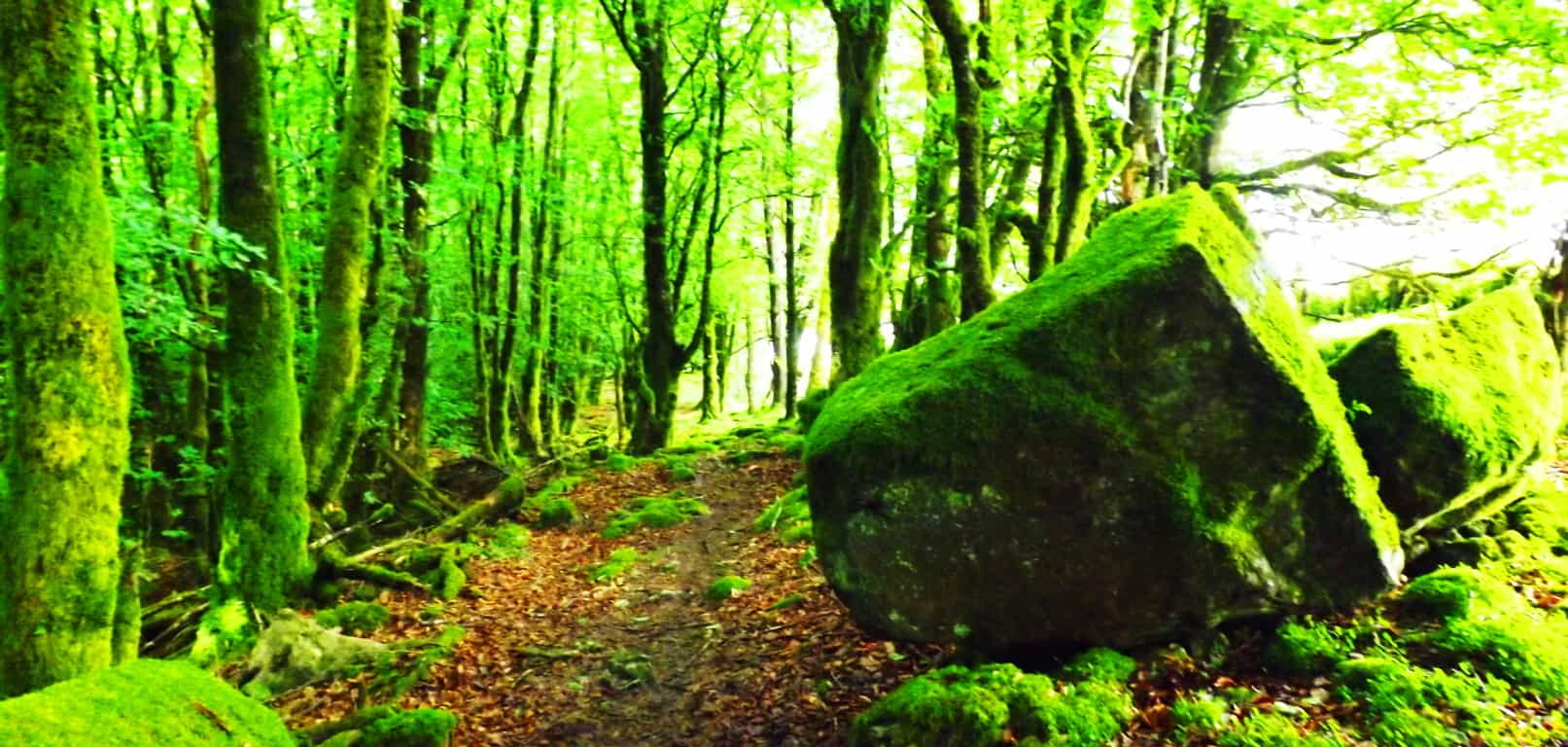
Moving deeper into the woods the sunlight blasts away beyond the hedges, while occasionally unrestricted shafts of light peak through into the inner thickets. When the Sun peaks through the mossy trees and hedges they shimmer with a misty light.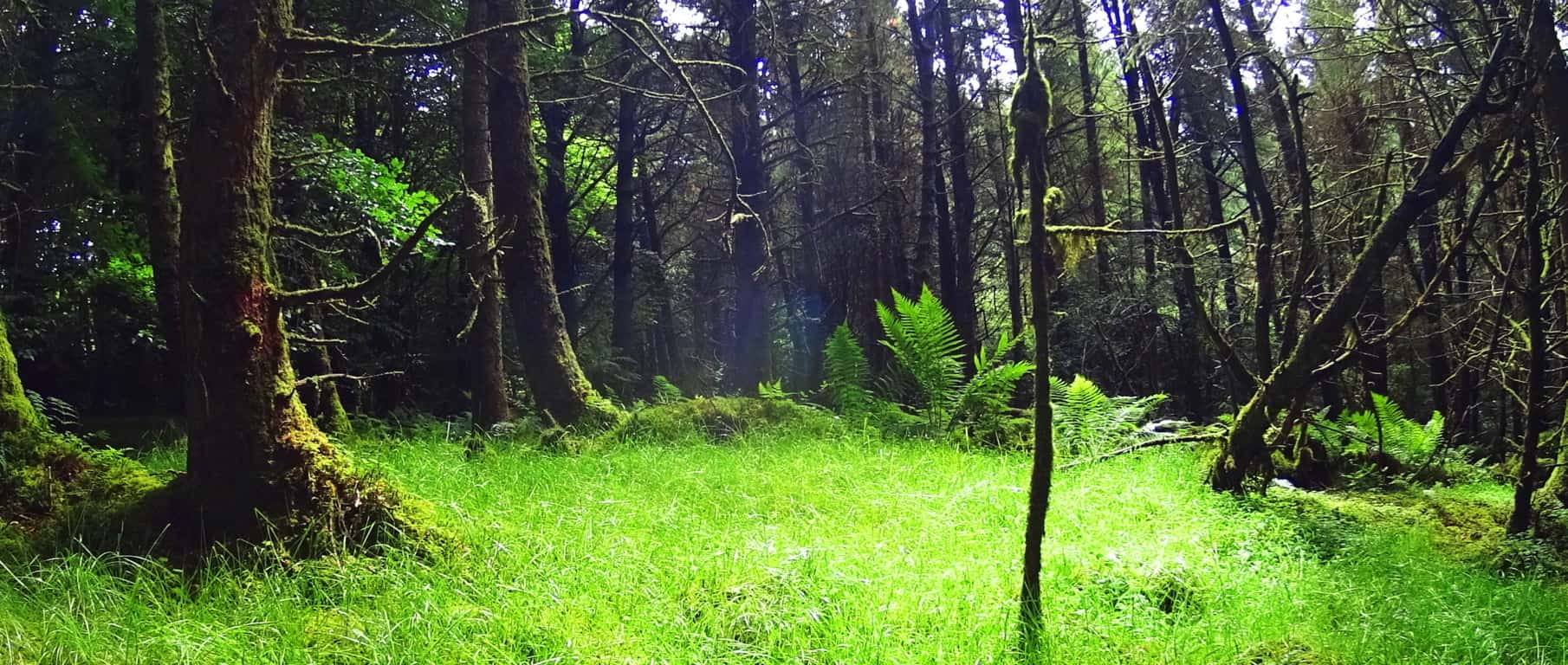 The woods here are like the opening scene for the most classic Celtic myth, at one moment bright and shimmering, and the next, shadowy and dark.
The woods here are like the opening scene for the most classic Celtic myth, at one moment bright and shimmering, and the next, shadowy and dark.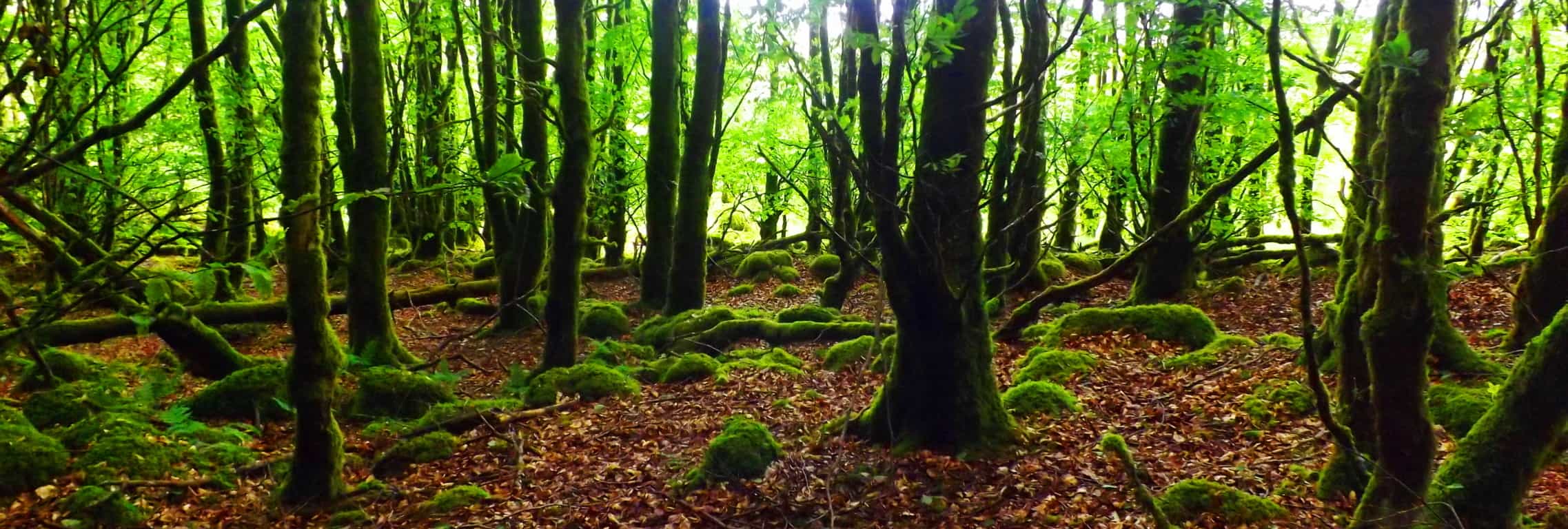 You can take the lower trail away from the forest to caverns and small cliffs where saint Patrick himself may have met with Druid kings. These caves are supported by what look like singular pillars which were carved out of the cliff at some point, either by an ancient culture, or by the wind. It is for you to decide. Before you make your decision about what’s possible and what’s not, consider some of the most amazing megalithic chambers in the world waiting to be viewed nearby…
You can take the lower trail away from the forest to caverns and small cliffs where saint Patrick himself may have met with Druid kings. These caves are supported by what look like singular pillars which were carved out of the cliff at some point, either by an ancient culture, or by the wind. It is for you to decide. Before you make your decision about what’s possible and what’s not, consider some of the most amazing megalithic chambers in the world waiting to be viewed nearby…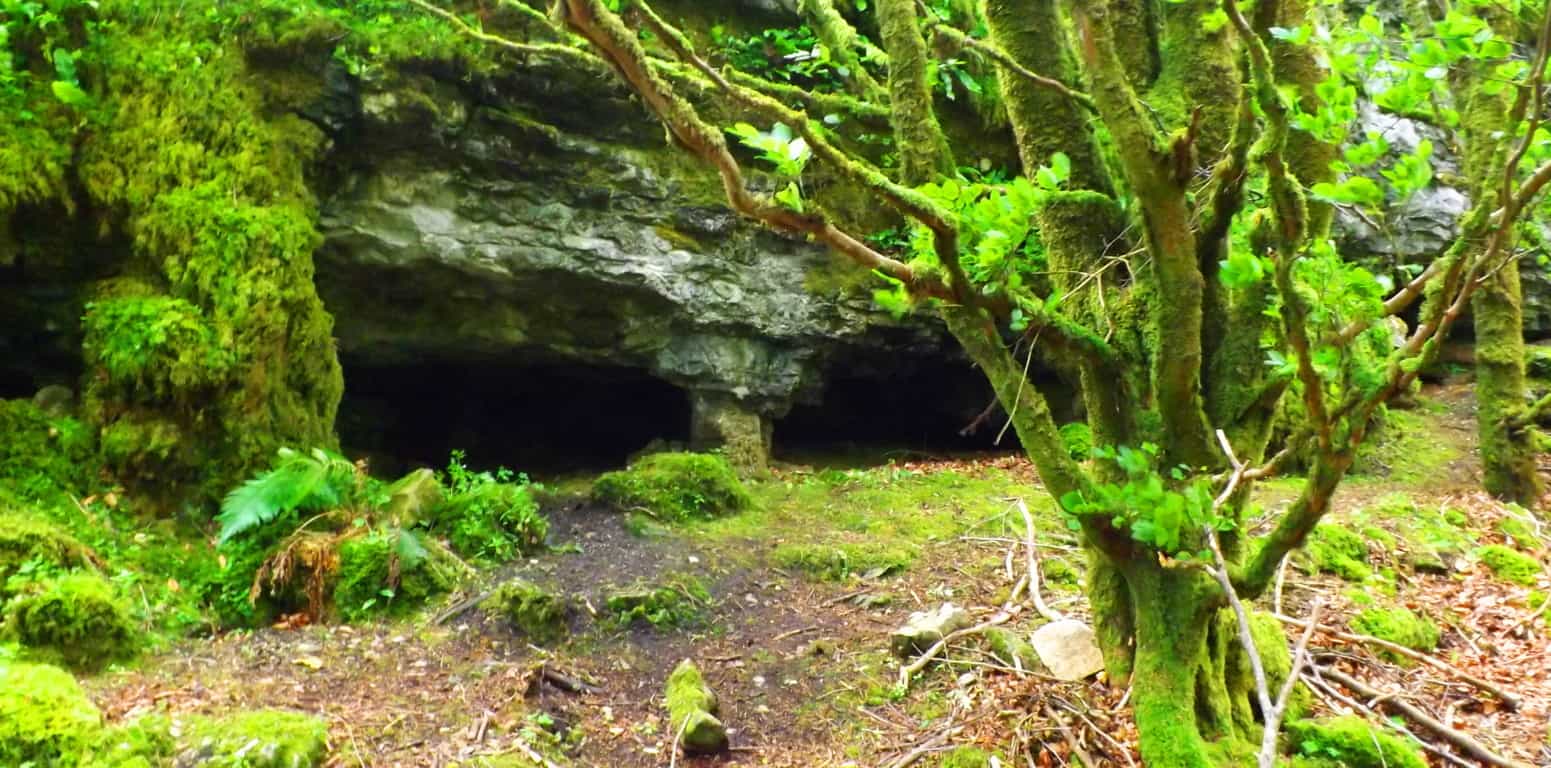 In a grove of ancient mossy stones and trees, set in an otherworldly vision about 1.5 miles into the lower trail, is one of the most amazing and mysterious megalithic chambers in Ireland. In this grove you almost expect a reclusive Jedi Knight to emerge from the mysterious stone chamber, which is clearly the centerpiece of this scene. This of course is an imaginary context, but the actual depth, beauty, and mystery that exists here is not imagined at all.
In a grove of ancient mossy stones and trees, set in an otherworldly vision about 1.5 miles into the lower trail, is one of the most amazing and mysterious megalithic chambers in Ireland. In this grove you almost expect a reclusive Jedi Knight to emerge from the mysterious stone chamber, which is clearly the centerpiece of this scene. This of course is an imaginary context, but the actual depth, beauty, and mystery that exists here is not imagined at all.
This is a 4000 to 6000 year old Celtic megalith. It is a mix of a wedge tomb, cairn, and stone chamber all in one. It should first be understood that the limestone slab that has been placed as a type of panel above the small entranceway looks to weighs at least 10 tons, if not more. This is a four inch thick, rock-strip of 7 by 14 foot wide singular slab, of solid limestone. To quarry and craft this chamber would have taken an immense amount of work, yet there are no markings on it. No chips from a chisel at its edges, or Pic-axe cuts of any kind. The dedication and resources of an entire village would’ve been necessary to quarry and move this stone to this specific spot. This seems like an extremely strange amount of effort for a Neolithic village to produce just to build a “house for a calf”, which is what the archaeologists of this area have actually had the nerve to label this chamber. The idea of a community exerting the resources and risk necessary to transfer this specific monolithic stone in a precise placement and location just to “house a cow” is insultingly absurd, and borders on fraud.
To quarry and craft this chamber would have taken an immense amount of work, yet there are no markings on it. No chips from a chisel at its edges, or Pic-axe cuts of any kind. The dedication and resources of an entire village would’ve been necessary to quarry and move this stone to this specific spot. This seems like an extremely strange amount of effort for a Neolithic village to produce just to build a “house for a calf”, which is what the archaeologists of this area have actually had the nerve to label this chamber. The idea of a community exerting the resources and risk necessary to transfer this specific monolithic stone in a precise placement and location just to “house a cow” is insultingly absurd, and borders on fraud.
A refined consideration of this chamber should first take note of the specific angle of the slab, which, as can be seen by the refractory blast of light glaring off its surface (first image above) is facing directly towards the course of the Sun through the valley. The specific angle of this extremely hard to move megalith indicates that it was intentionally placed in such a fashion in order to absorb as much of the Sun’s energy as possible. Additionally, connected to it, absorbing the Sun’s energy, are three stone-linings. This is a type of energy epicenter. Just as solar panels are angled on rooftops and plugged into an attached house for energy, this slab looks to serve the exact same purpose with the connecting stone-linings. This is a Neolithic solar panel distributing the harnessed energy of the Sun to the stone-linings which act as ‘cables’ transferring energy out to the landscape. Look at the stone-linings (which are a massive megalithic project also) in this image below, they plug-in and diverge in three different directions, which leads us to our next observation about this magical grove where wildflowers bloom like muffins in the grass.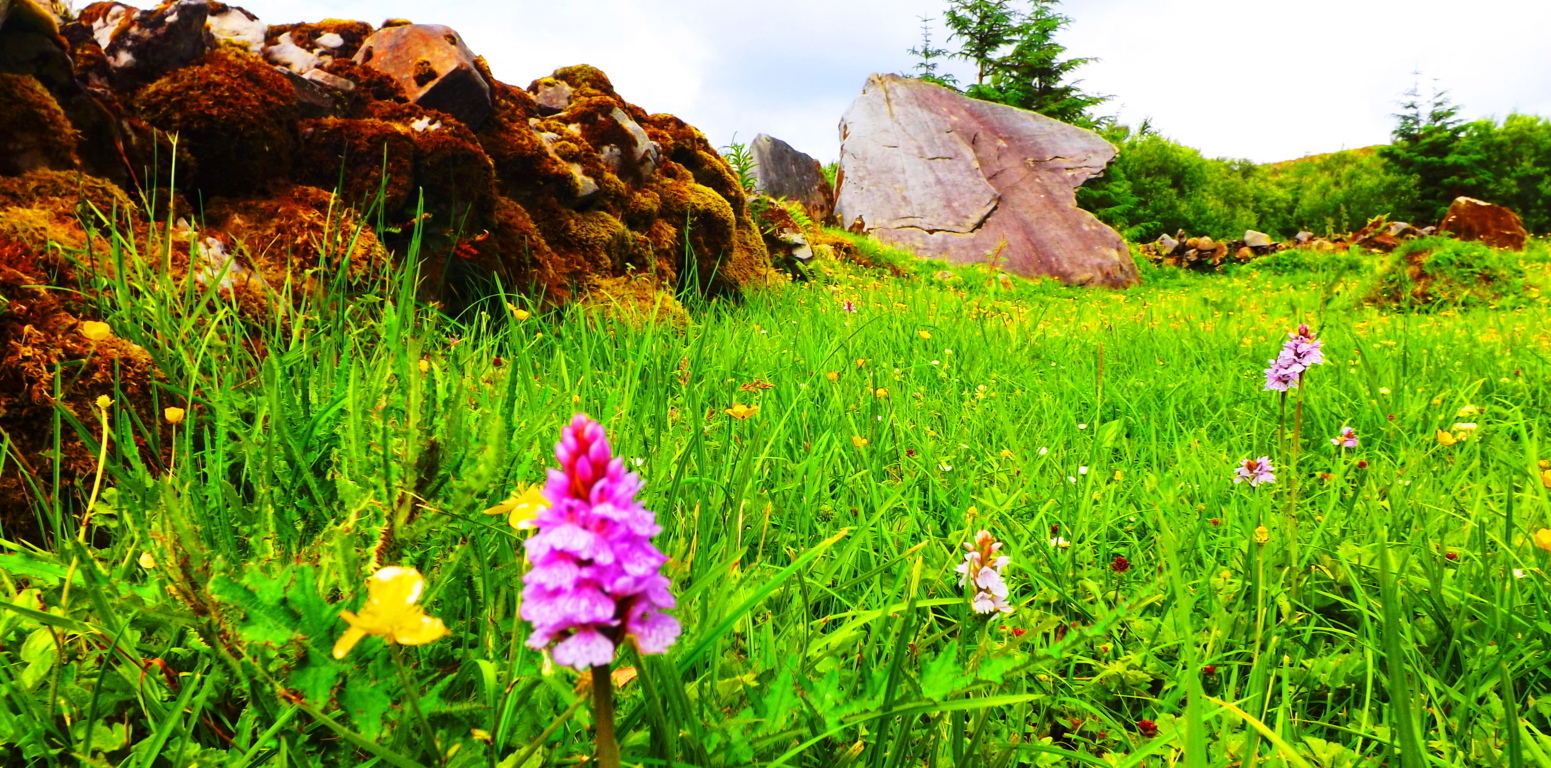 Modern archaeologists have dismissed these stones as primitive objects thrown down without any secondary functional purpose, perhaps other than to restrict the movements of herds. That’s problematic from the start. These stones couldn’t restrict a blind billy goat with three legs. This is a massive amount of effort to build something that doesn’t even perform its assumed functional purpose. This is because it’s not a “wall”. If we truly look at this scene functionally, from an engineering standpoint, it starts to make sense. Stones have energetic properties, transferring and storing energy if harnessed. How do we not acknowledge this in our particular day and age? Distributing harnessed energy is what our modern culture does with miniature ‘microchip landscapes’ every day. How could we not identify this larger model for the exact same concept, which is a landscape with connectors and harnessers of solar power that synergizes the entire area? This is the first engineering culture on earth, fully conscious of the utility properties of the elements in the landscape. Early antiquity was anything but primitive. “Archaeologists” selling people the idea that this priceless monument is a “calf house” are a patronizing disgrace.
Modern archaeologists have dismissed these stones as primitive objects thrown down without any secondary functional purpose, perhaps other than to restrict the movements of herds. That’s problematic from the start. These stones couldn’t restrict a blind billy goat with three legs. This is a massive amount of effort to build something that doesn’t even perform its assumed functional purpose. This is because it’s not a “wall”. If we truly look at this scene functionally, from an engineering standpoint, it starts to make sense. Stones have energetic properties, transferring and storing energy if harnessed. How do we not acknowledge this in our particular day and age? Distributing harnessed energy is what our modern culture does with miniature ‘microchip landscapes’ every day. How could we not identify this larger model for the exact same concept, which is a landscape with connectors and harnessers of solar power that synergizes the entire area? This is the first engineering culture on earth, fully conscious of the utility properties of the elements in the landscape. Early antiquity was anything but primitive. “Archaeologists” selling people the idea that this priceless monument is a “calf house” are a patronizing disgrace.
Just 10 yards from this beautiful chamber is an amazing isolated boulder that sits specifically above another granite foundation. There are no other level granite tables protruding out of the ground anywhere else in the grove. There are perfectly parallel slashes along the side of the free-sitting boulder, which gives the impression more akin to a sculptural statement, or display of decoration, rather than clumsy cracks from random toppling.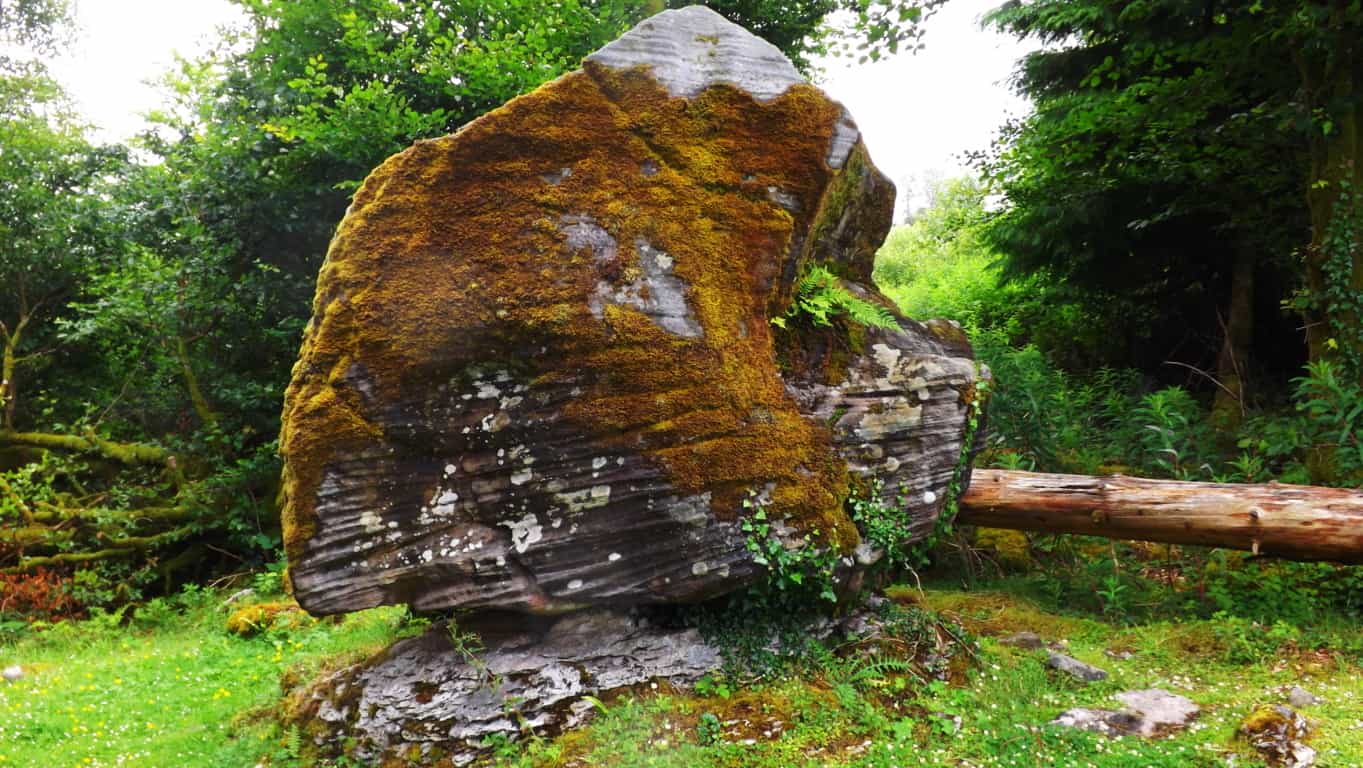 This boulder was specifically place on this exact spot as a marker for anyone approaching the area. It is obviously a statement that displays incredible strength and ingenuity, warning anyone passing through that the region is habituated by an individual(s) capable of this statement. The area is inundated with cultural megalithic statements, and yet, “scientists” somehow have the nerve to isolate this particular statement of megalithic balance and power, as random “glacial activity”. People need to get their heads around the idea of megalithic engineering in antiquity, and the ability to move and utilize massive stones. These engineered stones are in every forest and wildlife reserve from Gortnavern Ireland, to Monument Mountain Massachusetts. We need to stop being afraid of the possibility of a different history that the ‘postmodern era’ has perpetuated. Cultural history, after the last glacial flood period, spans some 12,500 years. In just the last 100 short years of human culture, which is a whopping 8% of the overall Era, ‘modern culture’ has decided to literally theorize everything, just ignoring the other 92% of cultural history along with the various forms of evidence we have inherited but mostly ignored. When defending the the 92% portion of overall history with a “modern scholar” they will dismiss the concrete evidence of engineered megaliths and historical texts with the painful logic that these statements are “just too old to be true”, or ” made-up stories created to manipulate culture”. This makes a practice of dismissing anything outside of the approved of narrative. If cultures just follow narratives and not the scenes themselves, those cultures will forget themselves. These stones are incredible coded puzzles that have been handed down to us from antiquity. They are literally priceless. In all our “modern wisdom” we still have yet to explain the purpose for these wedge tombs. This fact alone is enough to dismiss the assumptions of those who say that todays era is the height of cultural progress and achievement. It simply isn’t true, and the stones prove it. Let’s look closer.
This boulder was specifically place on this exact spot as a marker for anyone approaching the area. It is obviously a statement that displays incredible strength and ingenuity, warning anyone passing through that the region is habituated by an individual(s) capable of this statement. The area is inundated with cultural megalithic statements, and yet, “scientists” somehow have the nerve to isolate this particular statement of megalithic balance and power, as random “glacial activity”. People need to get their heads around the idea of megalithic engineering in antiquity, and the ability to move and utilize massive stones. These engineered stones are in every forest and wildlife reserve from Gortnavern Ireland, to Monument Mountain Massachusetts. We need to stop being afraid of the possibility of a different history that the ‘postmodern era’ has perpetuated. Cultural history, after the last glacial flood period, spans some 12,500 years. In just the last 100 short years of human culture, which is a whopping 8% of the overall Era, ‘modern culture’ has decided to literally theorize everything, just ignoring the other 92% of cultural history along with the various forms of evidence we have inherited but mostly ignored. When defending the the 92% portion of overall history with a “modern scholar” they will dismiss the concrete evidence of engineered megaliths and historical texts with the painful logic that these statements are “just too old to be true”, or ” made-up stories created to manipulate culture”. This makes a practice of dismissing anything outside of the approved of narrative. If cultures just follow narratives and not the scenes themselves, those cultures will forget themselves. These stones are incredible coded puzzles that have been handed down to us from antiquity. They are literally priceless. In all our “modern wisdom” we still have yet to explain the purpose for these wedge tombs. This fact alone is enough to dismiss the assumptions of those who say that todays era is the height of cultural progress and achievement. It simply isn’t true, and the stones prove it. Let’s look closer.
Just 2oo yards further up the trail is yet another priceless megalithic statement. This classic Celtic Wedge Tomb is at the top of a beautiful knoll with a 360 degree view on the Reserve. Placing these stones at this elevation would’ve been a serious endeavor, requiring years of specified labor.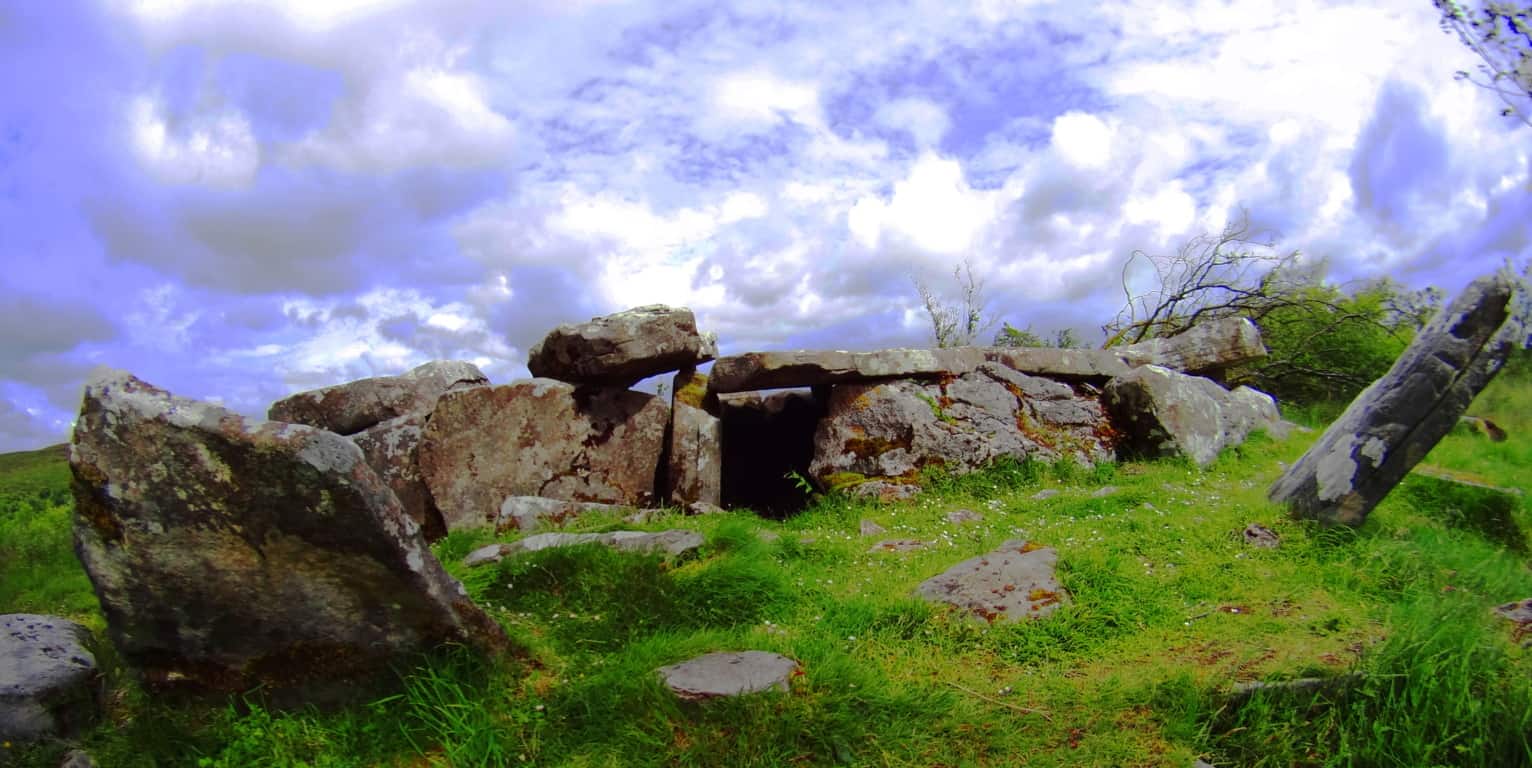
This chamber has several features that are mysterious and fantastic. Roughly measured the chamber reveals a 17 foot long set of fitted and crafted blocks of limestone. There is a captivating symmetry and set-up to these 1000 pound stones, with a centered entranceway. Two ‘pillar stones’ guard the entrance about 7 feet from the immediate left and right of the center entrance. The implementation of symmetry into a grand stone scene indicates dynamic planning and geometric comprehension, even beauty.Their are squarely placed roof and side-stones which are cut and fitted in eloquent styles. Beds of vibrant wildflowers populate the hill all around the chamber. With the clouds rolling swiftly by above the entire scene it truly feels dreamlike and utterly surreal. 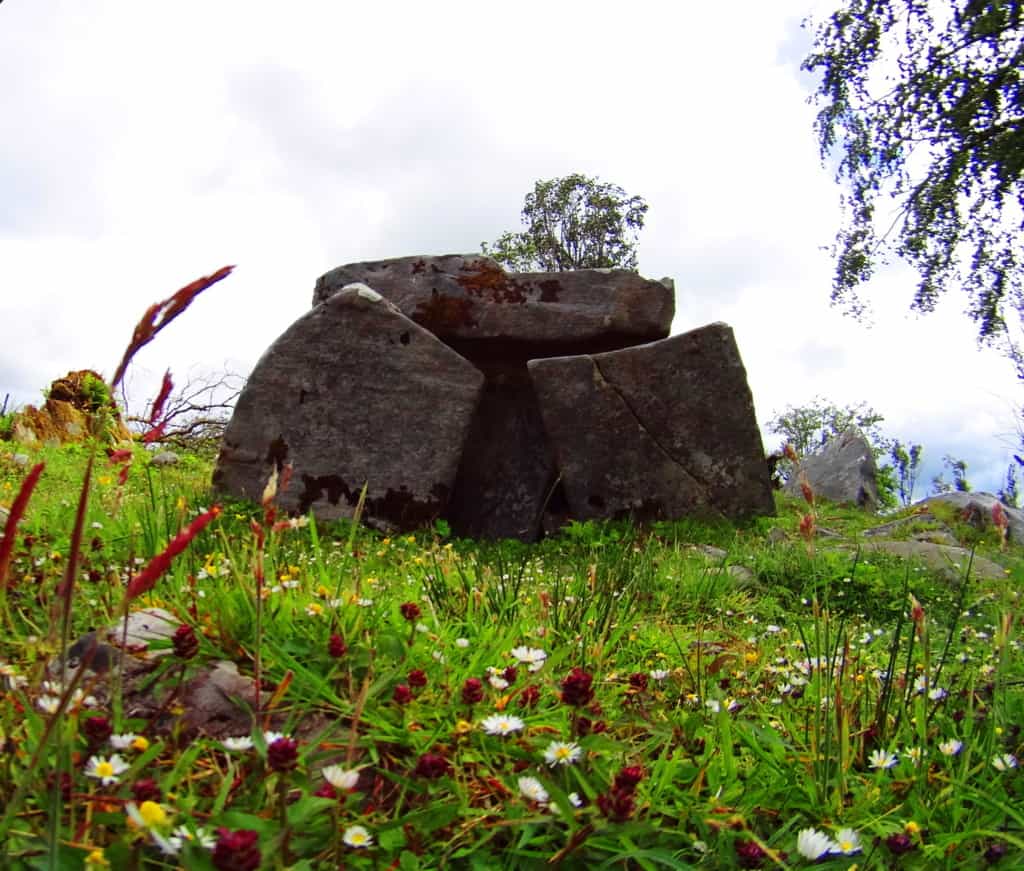 There is another classic wedge tomb on the initial elevation when starting the trail. Unfortunately this chamber is dilapidated, but with the help of the other chambers down the trail, we can make a pretty good guess as to what this scene may have looked like once. There are 1000 pound ceiling stones which have been toppled, while the side stones are no longer standing straight up. It was once a beautiful limestone chamber with an incredible view of the mountain beyond. There’s a good chance that this chamber once mimicked the beautifully distinct Culigagh Mountain in the background, which is a technique found in many of the stones at Mount Bearnagh in the Mourne Mountain Range to the east.
There is another classic wedge tomb on the initial elevation when starting the trail. Unfortunately this chamber is dilapidated, but with the help of the other chambers down the trail, we can make a pretty good guess as to what this scene may have looked like once. There are 1000 pound ceiling stones which have been toppled, while the side stones are no longer standing straight up. It was once a beautiful limestone chamber with an incredible view of the mountain beyond. There’s a good chance that this chamber once mimicked the beautifully distinct Culigagh Mountain in the background, which is a technique found in many of the stones at Mount Bearnagh in the Mourne Mountain Range to the east.
In review, the designated trails here are a short 3 mile loop that take you from megalith to megalith, branching off into the forest as well. The roads and pathways approaching the Reserve run for several miles all their own, and are completely accessible as well. This is a once in a lifetime excursion. The first culture in Ireland once thrived in this region, and found joy in creating impossible engineering spectacles built into the landscape, too grandiose to be removed some 6000 years later. Photography here is an opportunity to capture the beautiful spirit of Ireland’s oldest rural wonderland. These images tell a tale of complete beauty and mystique, of wonder and grandeur. An excursion here can lead you off-trail too, where Celtic stone-linings might be your only guide for miles. If possible, give yourself a chance to discover something away from the path. Wander into the hills to experience the breezy sway of the hillside brushing against your gear. A nearly scriptural level of simplistic beauty can emerge while passing by the flocks in these hills. The realness of witnessing a hallowed ‘rural order’ gives us a primordial reminder that life can hold incredibly simplistic beautiful moments, if we so choose. Cavan Burren National Park is the perfect place to wander into that type of moment. Seek and find.
Hill of Tara
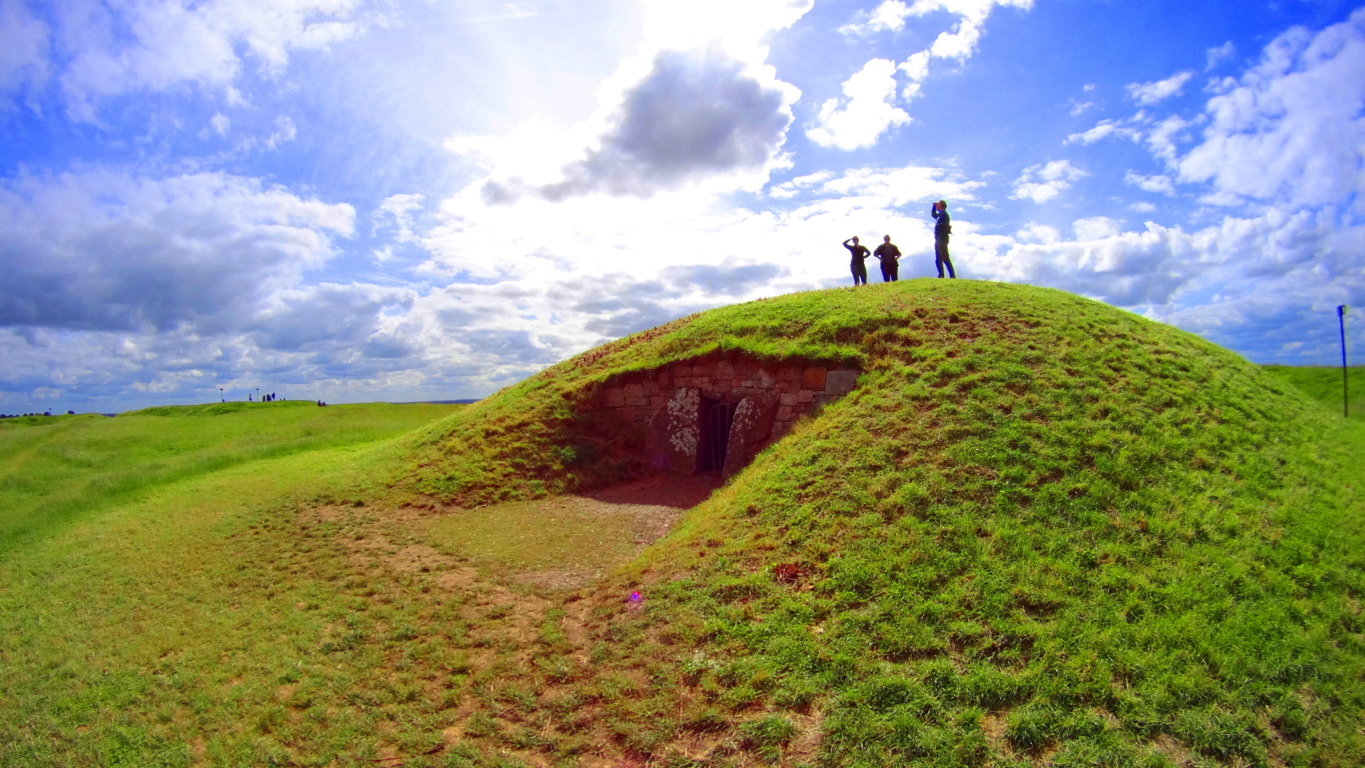
Location: County Meath/Ireland
Elevation: 508 ft
Note: It is fitting that the Hill of Tara, the historic site where it is said the High Kings of Ireland were once crowned, is on a road with no name. This sets the tone for the experience of County Meath, and within it, the enchanting hamlet of Castletown, a place deeply dedicated to preserving the beauty of Celtic life in all its aspects. Castletown is wonderfully lacking in the exacted labels of modernity, with lanes and lands that have names known only by the local farmers and families. It is here that The Hill of Tara is embedded, and without a GPS, or mapping system on your phone, you simply will not find it. Be prepared. The deeply rural aspect of Tara’s location has been challenged by organizations wishing to modernize this area with more expansive highways, and this effort has been met with overwhelming resistance. The people here clearly value a connection to the sacred land over monetary expansion, and this gives us yet another connection between Celtic and Native American culture. The Hill of Tara is the central natural monument for the earliest Celtic identity of the Irish people, while Newgrange is the Megalithic complex with equal stature. It is understood that the High Kings of Ireland were crowned, and kept their High Seat, here. There is a standing stone and stone chamber at the top of the Hill, marking the very spot where the High King was crowned in ancient times. There is a main trail from the car park, and several minor trails that encircle the hill. A full hike of the area is about 4 miles long, if you so choose, rounding the Hill. Perhaps more importantly is the option to sit down and understand the depth of what this place represents, and feel what it exudes. It is not a cliche taking place at Tara’, it is in fact one of the realest connections you can feel to the landscape in all of Ireland.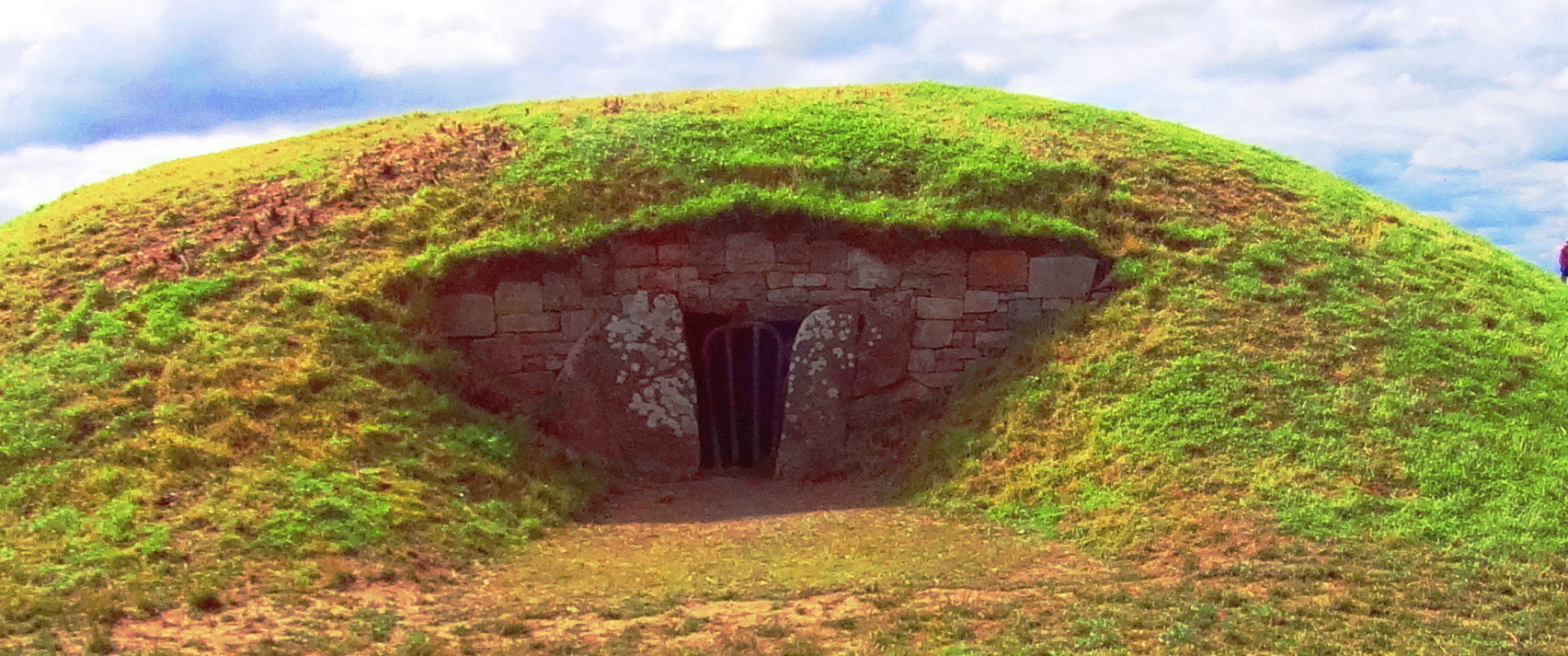 There are several specific monuments that should not be missed here. The stone chamber is a beautiful example of corbel layering in the Celtic style. It is placed specifically at the zenith of the Hill, and built into the ground in order to connect with the earth below. This exact style of stone chamber exists mysteriously in the forests of New England. Below are examples of the stone chambers at Upton and Nashoba Brook, Massachusetts/USA. They are very similar in construction to The Hill of Tara stone chamber, but lack the pinnacle context of the Irish chamber, so obvious with a single glance.
There are several specific monuments that should not be missed here. The stone chamber is a beautiful example of corbel layering in the Celtic style. It is placed specifically at the zenith of the Hill, and built into the ground in order to connect with the earth below. This exact style of stone chamber exists mysteriously in the forests of New England. Below are examples of the stone chambers at Upton and Nashoba Brook, Massachusetts/USA. They are very similar in construction to The Hill of Tara stone chamber, but lack the pinnacle context of the Irish chamber, so obvious with a single glance. 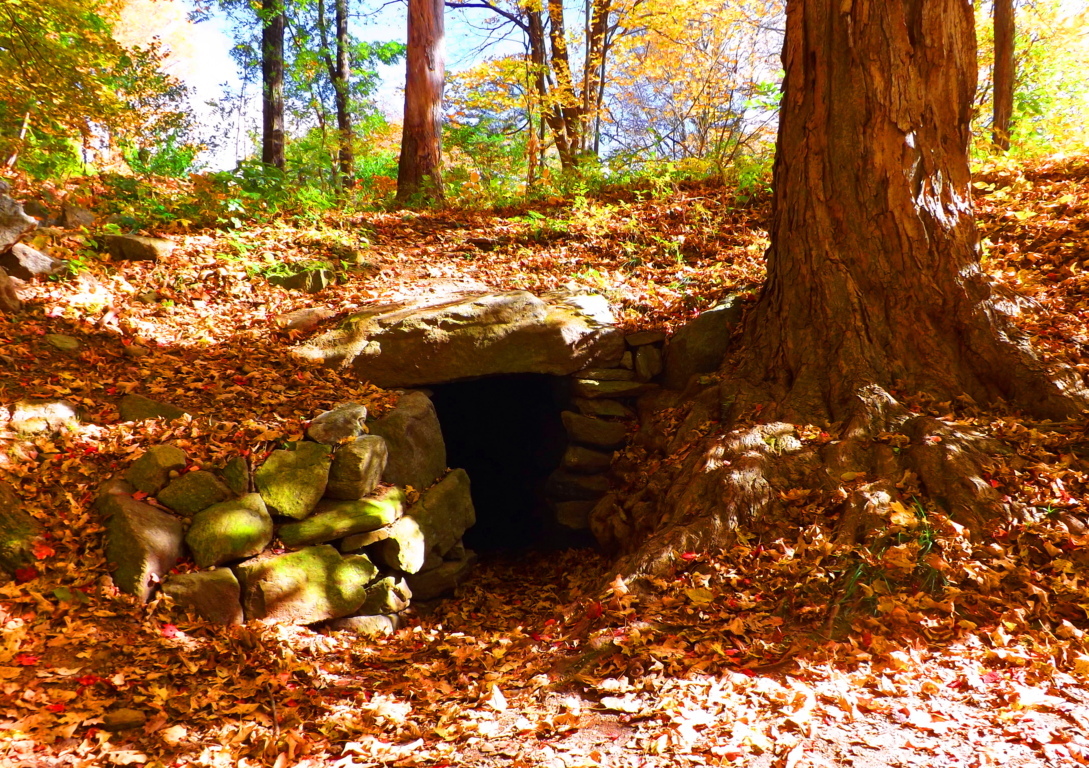
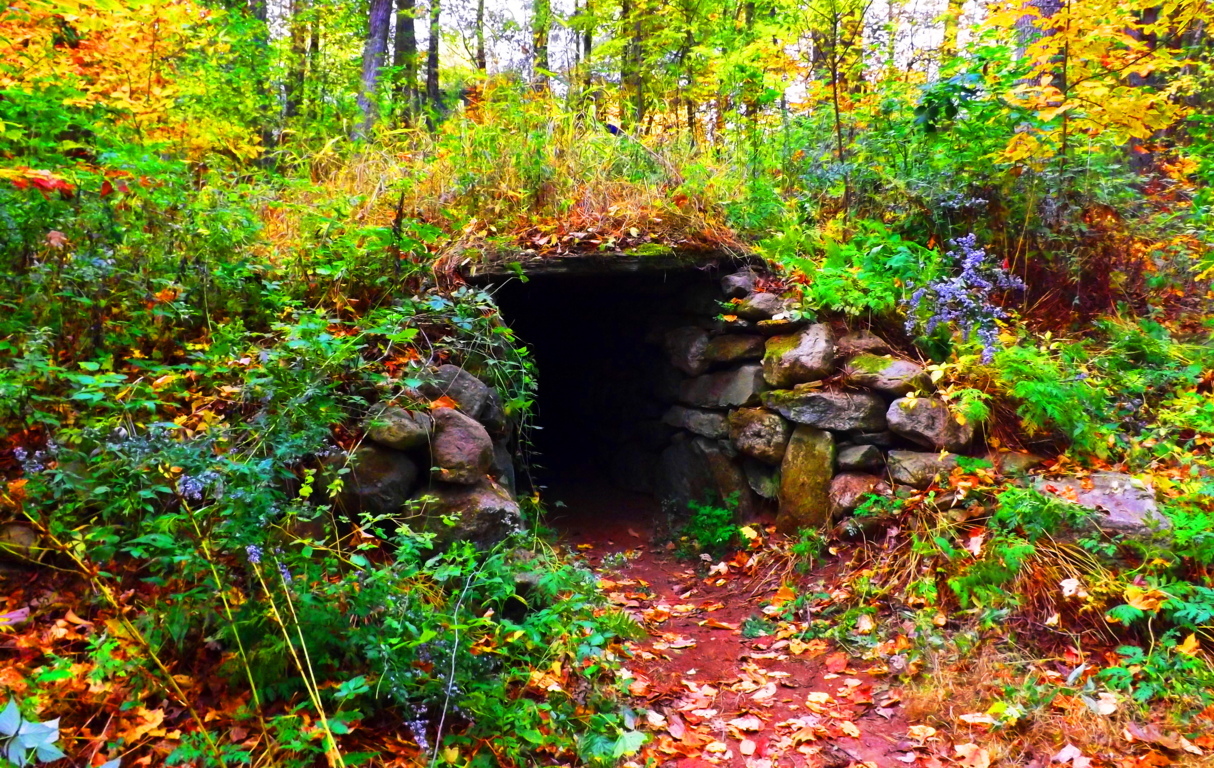 The question arises: What are identically constructed stone chambers doing an ocean apart from each other? A full analysis of the stone chambers, both in Ireland and New England, may reveal astrological, as well as geomorphic significance. While standing inside the Upton Stone Chamber when I took the image below, over two years ago, several small glowing orbs began floating around my camera lens. (image below/left of center, 2 orbs connected) This is a strong indicator for the purpose of harnessing energy in these chambers.
The question arises: What are identically constructed stone chambers doing an ocean apart from each other? A full analysis of the stone chambers, both in Ireland and New England, may reveal astrological, as well as geomorphic significance. While standing inside the Upton Stone Chamber when I took the image below, over two years ago, several small glowing orbs began floating around my camera lens. (image below/left of center, 2 orbs connected) This is a strong indicator for the purpose of harnessing energy in these chambers.
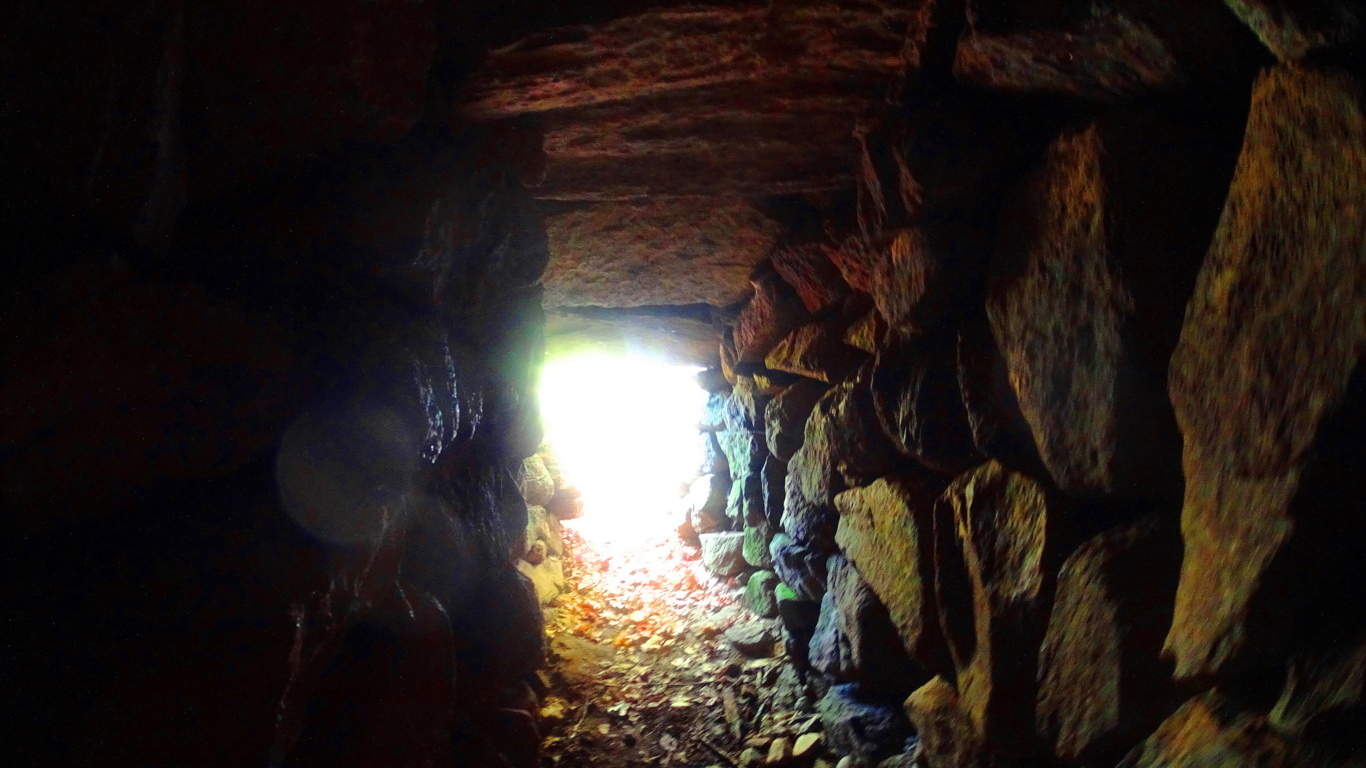 I had never before seen an orb up until that particular moment, or even believed that they existed. It became clear to me that what takes place in the stone chambers is most likely a harnessing of energy. This is very similar to what is done with electrical current and quartzite utilities in today’s era. The stone chamber at Tara’ would very likely have the same energetic benefits, and therefor be a good place for the High King of Ireland to be. After spending some time upon The Hill of Tara, I began to feel that the entire Hill was harnessing energy somehow, and I certainly wasn’t the only one. (Image below/Kings Stone/site of the crowning of the High King)
I had never before seen an orb up until that particular moment, or even believed that they existed. It became clear to me that what takes place in the stone chambers is most likely a harnessing of energy. This is very similar to what is done with electrical current and quartzite utilities in today’s era. The stone chamber at Tara’ would very likely have the same energetic benefits, and therefor be a good place for the High King of Ireland to be. After spending some time upon The Hill of Tara, I began to feel that the entire Hill was harnessing energy somehow, and I certainly wasn’t the only one. (Image below/Kings Stone/site of the crowning of the High King)
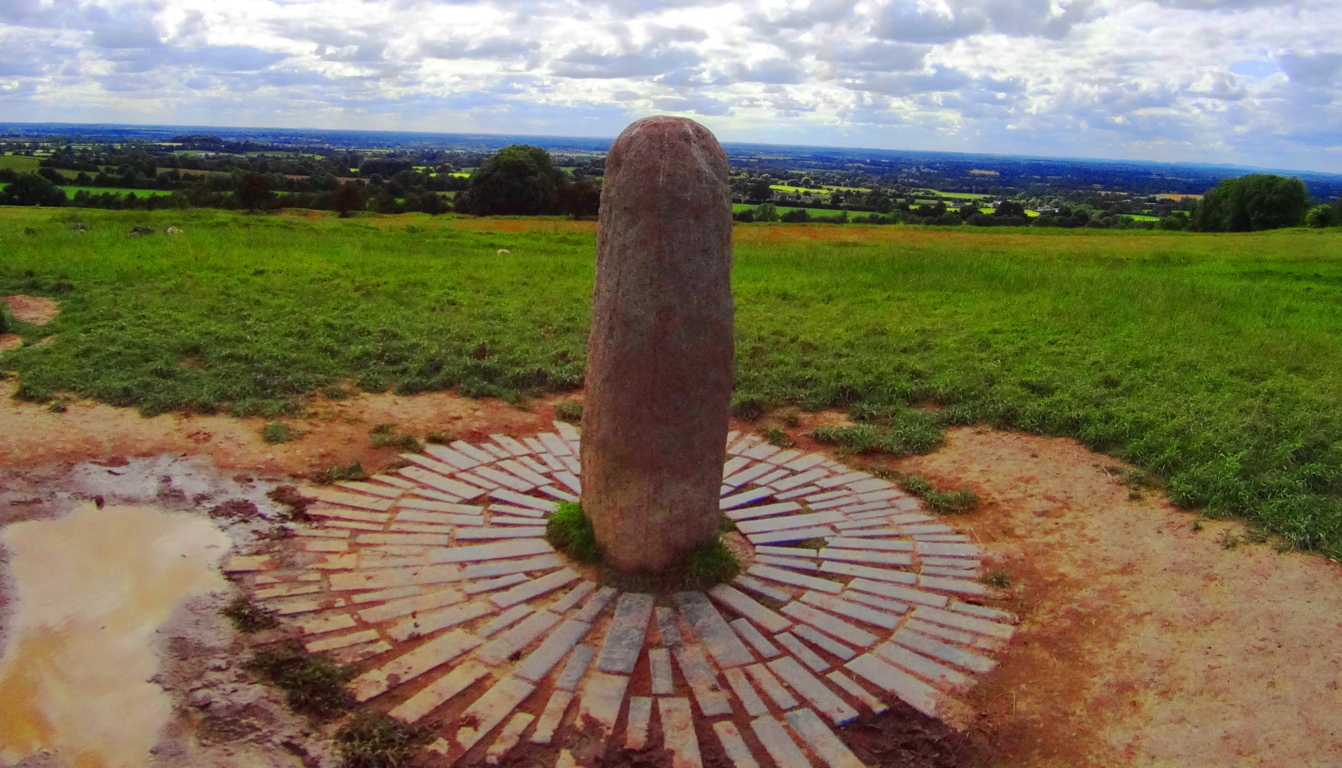 Within the Stone Chamber at Tara’ is a type of “keystone” (image below) which maps out the megalithic works of the entire area. On this day I didn’t see any orbs in the Chamber, but it was abundantly clear that Tara’ is a spiritual center that was designed in a very specific way. This would’ve taken an enormous amount of effort.
Within the Stone Chamber at Tara’ is a type of “keystone” (image below) which maps out the megalithic works of the entire area. On this day I didn’t see any orbs in the Chamber, but it was abundantly clear that Tara’ is a spiritual center that was designed in a very specific way. This would’ve taken an enormous amount of effort.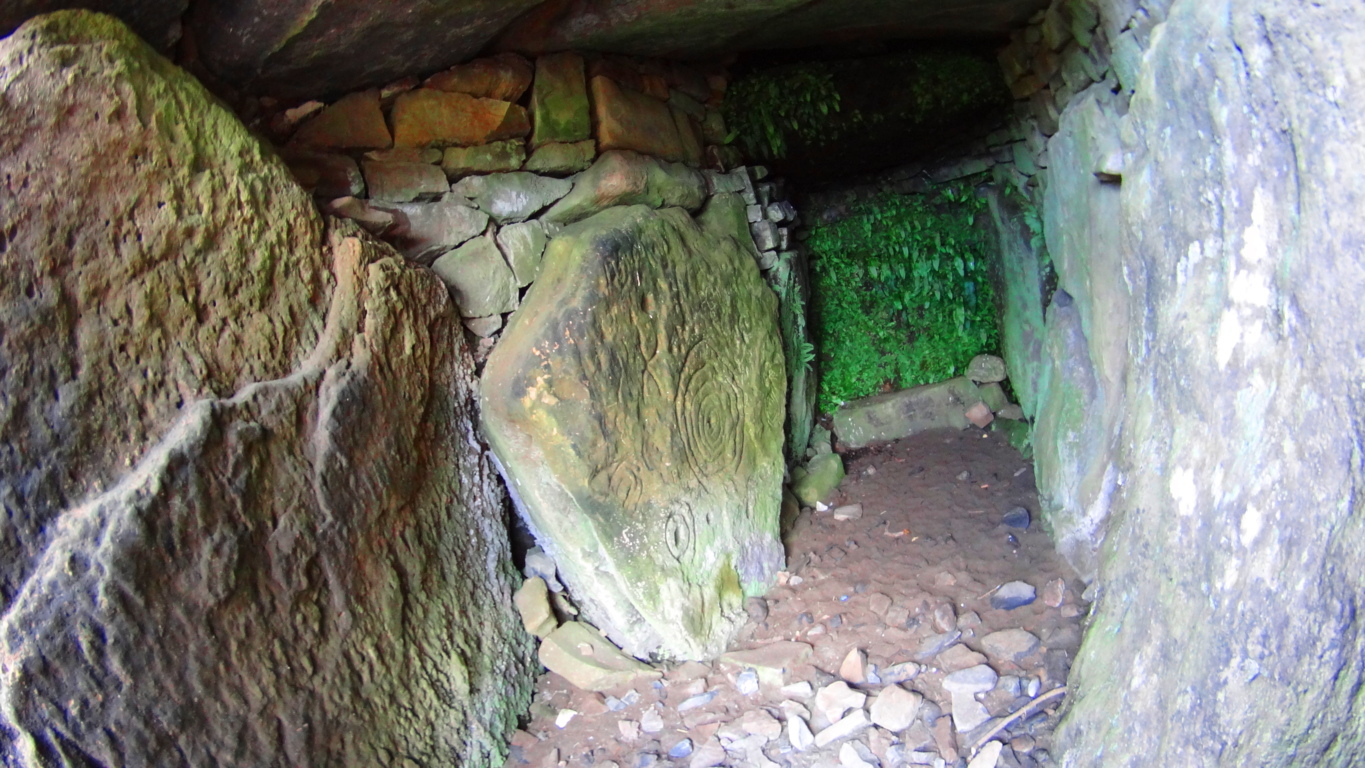 These megalithic monuments date back at least 5000 years. It is very likely that the High Kings chose this place specifically because they knew of an even older megalithic culture that once dwelt upon this Hill, which was a culture capable of harnessing energies through the positioning and aligning of stones with the Sun, Moon, and Stars. The Hill of Tara is a type of energy center, with several large concentric earthworks built into the hillsides. The exact meaning of concentric earthworks is not known, but science is beginning to understand fractal and concentric patterns as extremely useful in the reverberation and harnessing of electric currents.
These megalithic monuments date back at least 5000 years. It is very likely that the High Kings chose this place specifically because they knew of an even older megalithic culture that once dwelt upon this Hill, which was a culture capable of harnessing energies through the positioning and aligning of stones with the Sun, Moon, and Stars. The Hill of Tara is a type of energy center, with several large concentric earthworks built into the hillsides. The exact meaning of concentric earthworks is not known, but science is beginning to understand fractal and concentric patterns as extremely useful in the reverberation and harnessing of electric currents.
The feeling at The Hill of Tara: In J.R.R Tolkien’s masterpiece The Lord of The Rings there are two chapters that take place in an enchanted forest called Lothlorien. Deep within Lothlorien there is a hill named Cerin Amroth, and the description of what happens when the company of travelers from this epic tale first glimpse this ancient Hill is poetically relevant to the Hill of Tara. The passage reads:
“Behold! You are come to Cerin Amroth,” Said Haldir. “For this is the heart of the ancient realm as it was long ago, and here is the mound of Amroth, where in happier days Amroth’s high house was built. Here ever bloom the winter flowers in the unfading grass: the yellow elanor, and the pale niphredil.” The others cast themselves down upon the fragrant grass, but Frodo stood a while still, lost in wonder. It seemed to him that he had stepped through a high window that looked on a vanished world. A light was upon it for which his language had no name…”(pg 350;LOTR)
Here is a picture of high plateau of Tara’s wildflowers from up close. They are delicate and beautiful, colorfully vibrant, rich, and unfading, very much like the description of Cerin Amroth in Tolkien’s Lotlorien.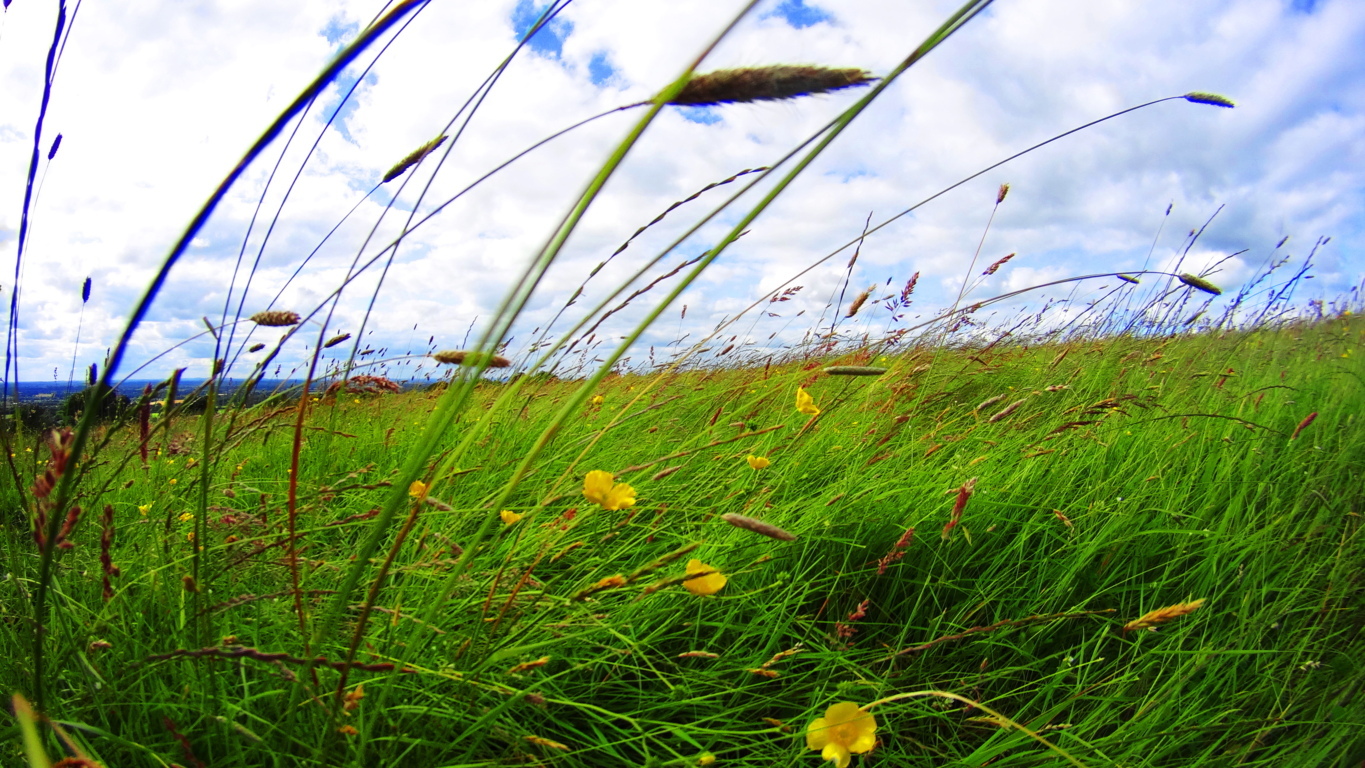 Perhaps it was because the angle of the light on the field was personally different for me; just as the Irish angle on the Sun is different than that of the angle of the Sun in the American northeast where I’m from; but from my foreign perspective the Hill seemed to literally glow in the late-day Sun. It glowed in a way I had never seen before. I could feel a type of electricity all around me, and yet it was a simple landscape on the surface. I truly had to sit down and collect myself for a moment as my head was nearly spinning. I know it sounds strange, but it’s true.
Perhaps it was because the angle of the light on the field was personally different for me; just as the Irish angle on the Sun is different than that of the angle of the Sun in the American northeast where I’m from; but from my foreign perspective the Hill seemed to literally glow in the late-day Sun. It glowed in a way I had never seen before. I could feel a type of electricity all around me, and yet it was a simple landscape on the surface. I truly had to sit down and collect myself for a moment as my head was nearly spinning. I know it sounds strange, but it’s true.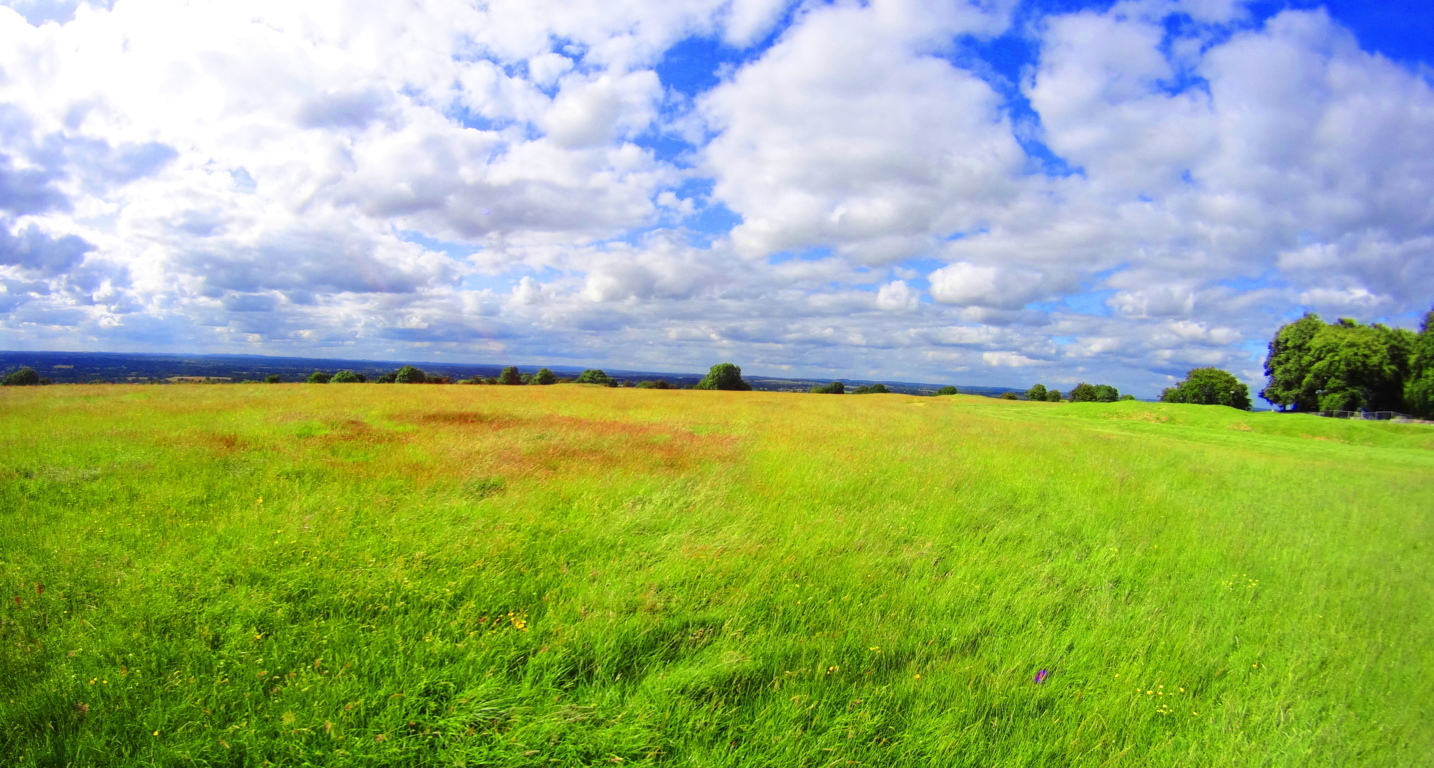 It is very hard to explain, but as I came up the Hill, I began to see that the Irish understood this feeling, completely.
It is very hard to explain, but as I came up the Hill, I began to see that the Irish understood this feeling, completely.
I included the fictional description of The Hill of Cerin Amroth experienced by the characters of The Lord of The Rings above because it was the most relevant passage I could find in all of literature to describe my very real personal experience with The Hill of Tara. When I arrived people were literally sprawled out in the grass, attempting to harness the energy of the Hill. (image/below) I found myself blinking hard at what I was seeing.
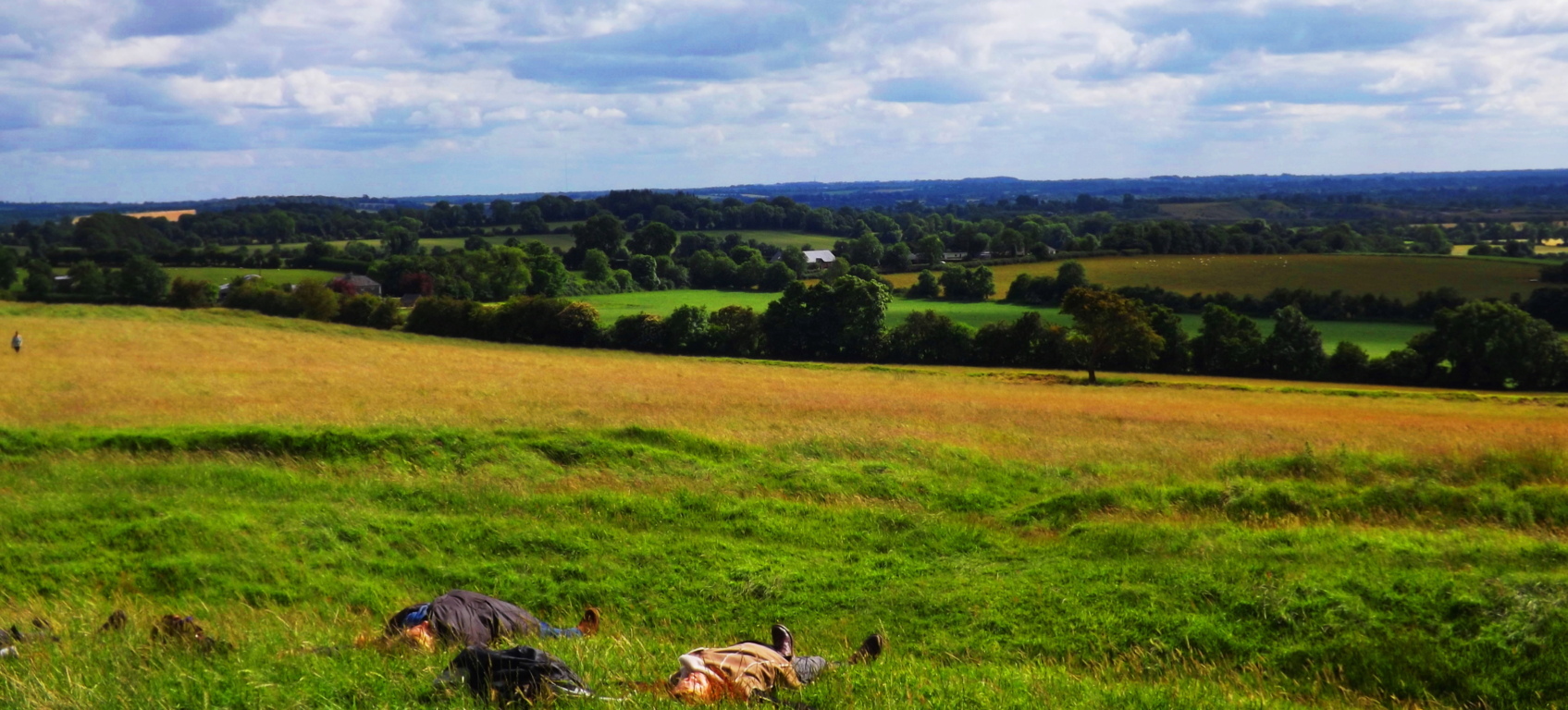
I walked above the stone chamber to get a glimpse from the highest point of the area. Two Irish kids jumped up in front of me and began posing for a picture in the most hilarious way. They were absolutely carefree. With all of Ireland in the backdrop, I suddenly felt as if all my concerns were, at best, ridiculous. 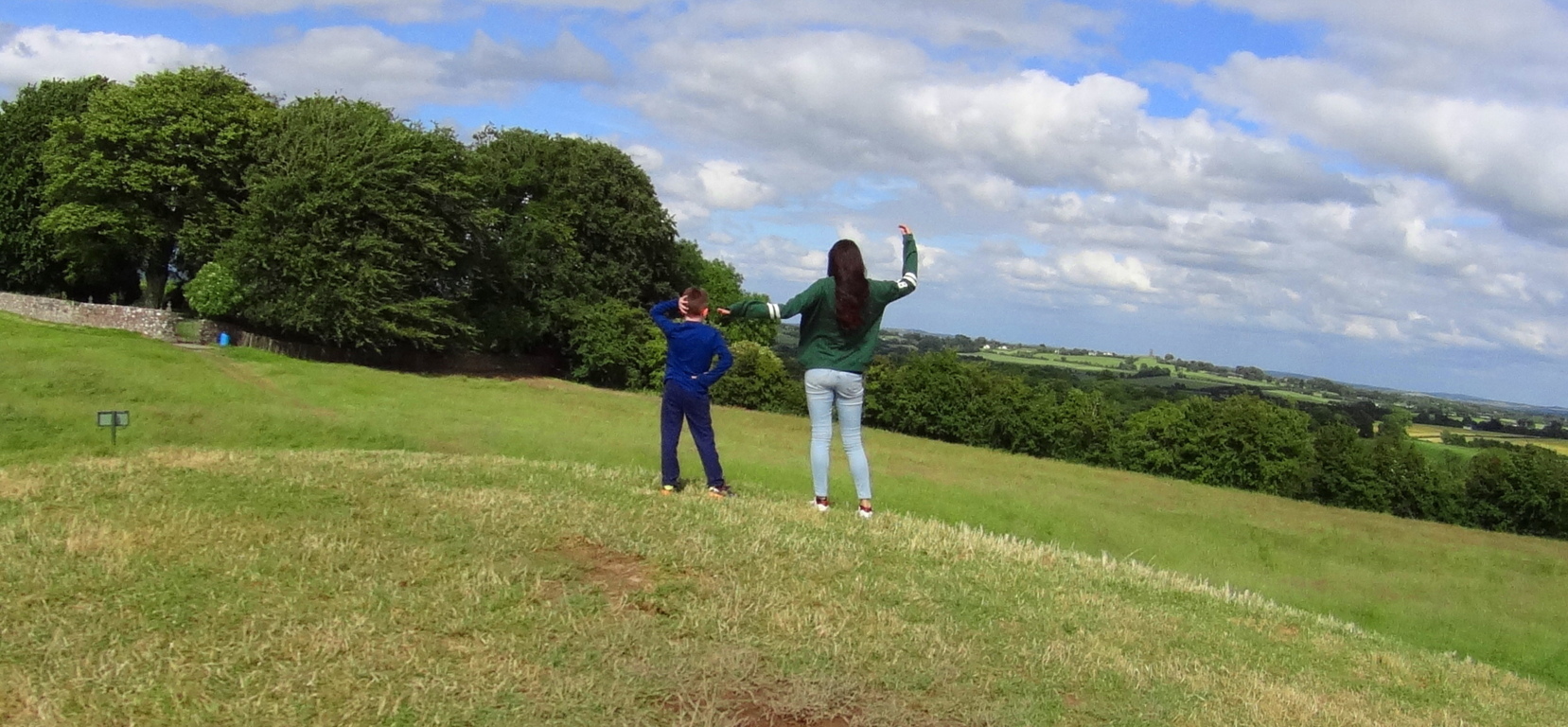 Off in the distance I marked a couple kissing, and then not far from them were college kids sitting and talking softly above the ancient circular rings now covered with earth.
Off in the distance I marked a couple kissing, and then not far from them were college kids sitting and talking softly above the ancient circular rings now covered with earth.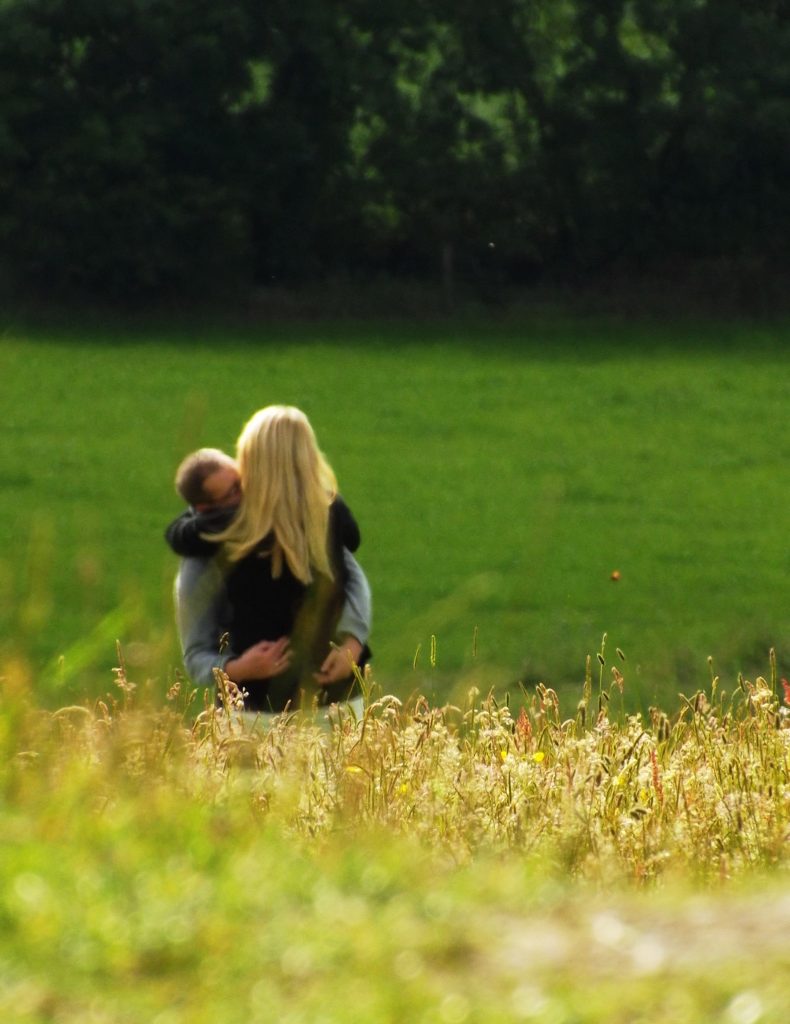 Coming from the America of the last 15 years, I just wasn’t accustomed to this type of uninhibited joy and calm. There was no stress, no observational angst, no fear whatsoever. And you could feel it.
Coming from the America of the last 15 years, I just wasn’t accustomed to this type of uninhibited joy and calm. There was no stress, no observational angst, no fear whatsoever. And you could feel it.
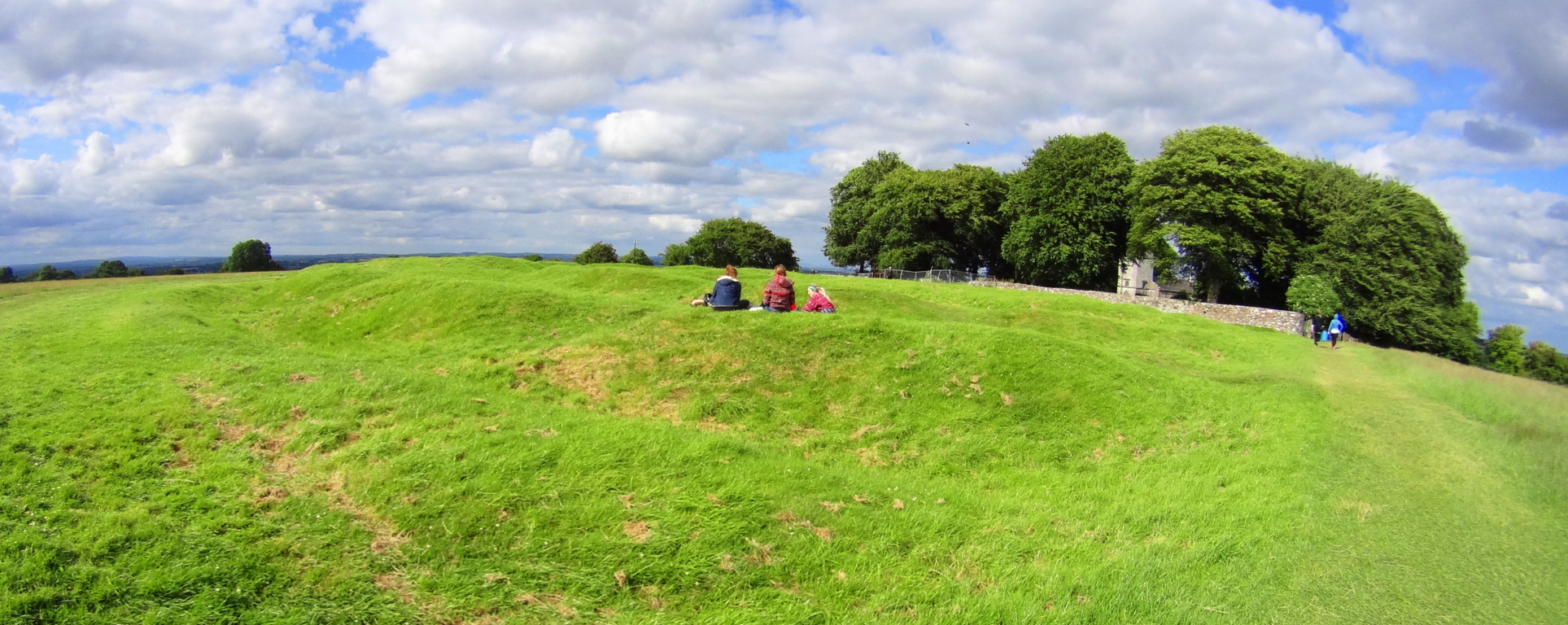
Whatever the original function of Tara’ once was, there is a remnant of it still today. On a sunny day Tara’ feels like the safest place on earth, and this is no exaggeration. In the hills beyond are ruined bell-towers of abbeys long since diminished. It should be appreciated by the readers that these towers, although they look extremely old in their picturesque way, are practically young, comparatively, to the stone chamber and standing stone at Tara’s peak, as well as the stone chambers in New England, for that matter. 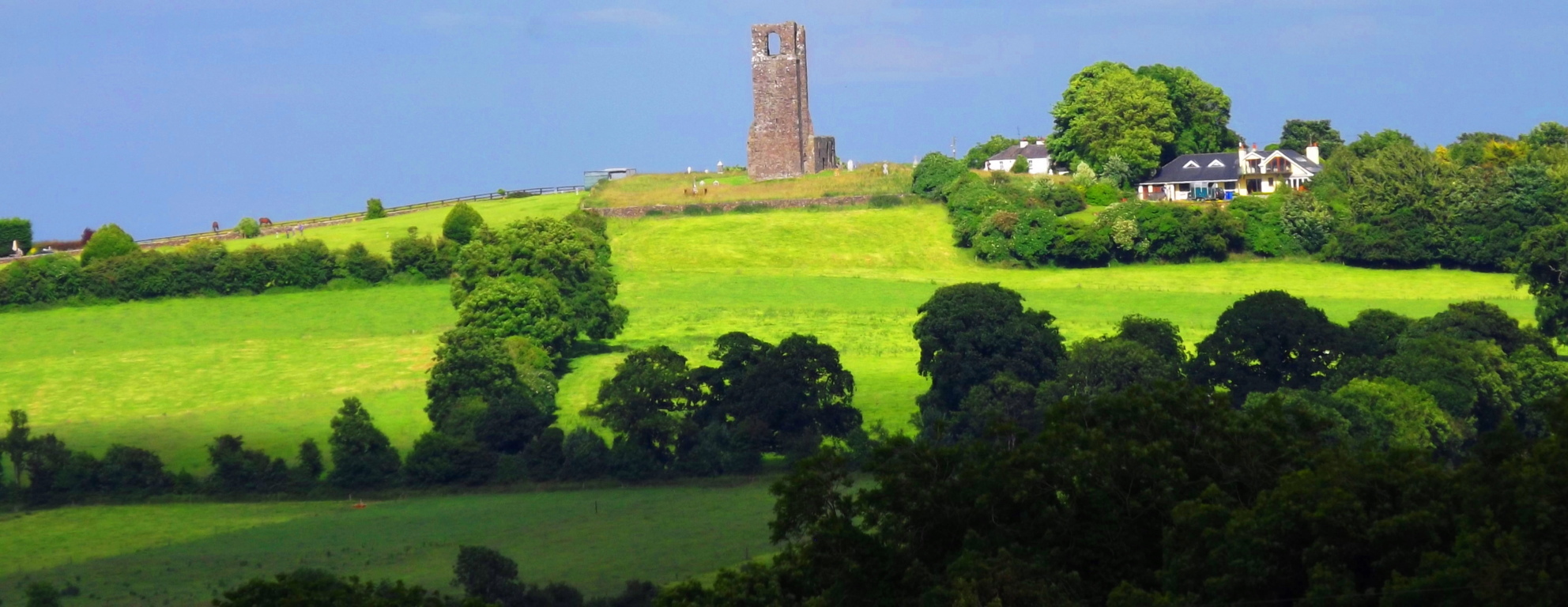 Bective Abbey, a classic Medieval complex, is only 1.5 miles from Tara’, and it is a wonderfully tranquil place. (image below) You can walk the ground and see some beautiful architecture from inside the cells.
Bective Abbey, a classic Medieval complex, is only 1.5 miles from Tara’, and it is a wonderfully tranquil place. (image below) You can walk the ground and see some beautiful architecture from inside the cells. The monks must have known how spiritually potent this area was, with its proximity to Tara’. They would’ve gladly choose to live-out their days in the presence of The Hill, knowing they could certainly do a lot worse. Adding to this energetic feeling of the land and stone-works from the earliest Neolithic period, to Celtic and Medieval, is the oldest element of all, the Boyne River, which cuts North to South through the area.
The monks must have known how spiritually potent this area was, with its proximity to Tara’. They would’ve gladly choose to live-out their days in the presence of The Hill, knowing they could certainly do a lot worse. Adding to this energetic feeling of the land and stone-works from the earliest Neolithic period, to Celtic and Medieval, is the oldest element of all, the Boyne River, which cuts North to South through the area.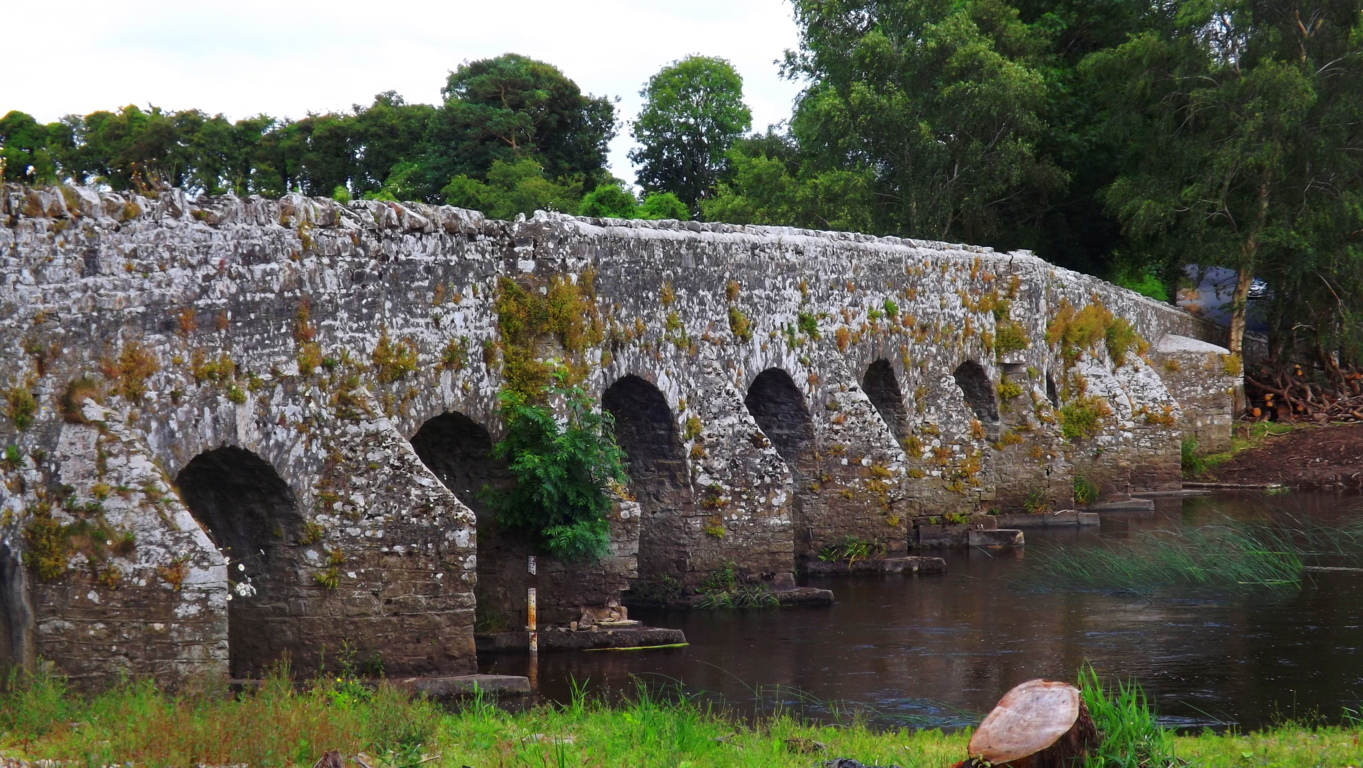 This is the Boyne River Valley, an ancient and sacred landscape filled with stone engineering. “The High Man”, a Celtic complex of astrologically-aligned hill-forts, wedge tombs, and standing stones, is not far from this area. Its monuments are built in precise fashion along the Boyne river in order to be a reflection of the Belt of Orion astrological system actually built into the Irish hills. The entire area is absolutely sacred.
This is the Boyne River Valley, an ancient and sacred landscape filled with stone engineering. “The High Man”, a Celtic complex of astrologically-aligned hill-forts, wedge tombs, and standing stones, is not far from this area. Its monuments are built in precise fashion along the Boyne river in order to be a reflection of the Belt of Orion astrological system actually built into the Irish hills. The entire area is absolutely sacred.
The Hill of Tara has been preserved by the efforts of Irish citizens who have resisted the modern world’s “advances”. They have openly protested any modernization of the area. If you are lucky enough to find the Hill of Tara and walk the grounds; if you come to Castletown and cross the river Boyne; realize it is anything but a simple hike through rustic terrestrial trails that you are taking, but rather, it is a hike into the way things were in the beginning of Time.
Gortnavern
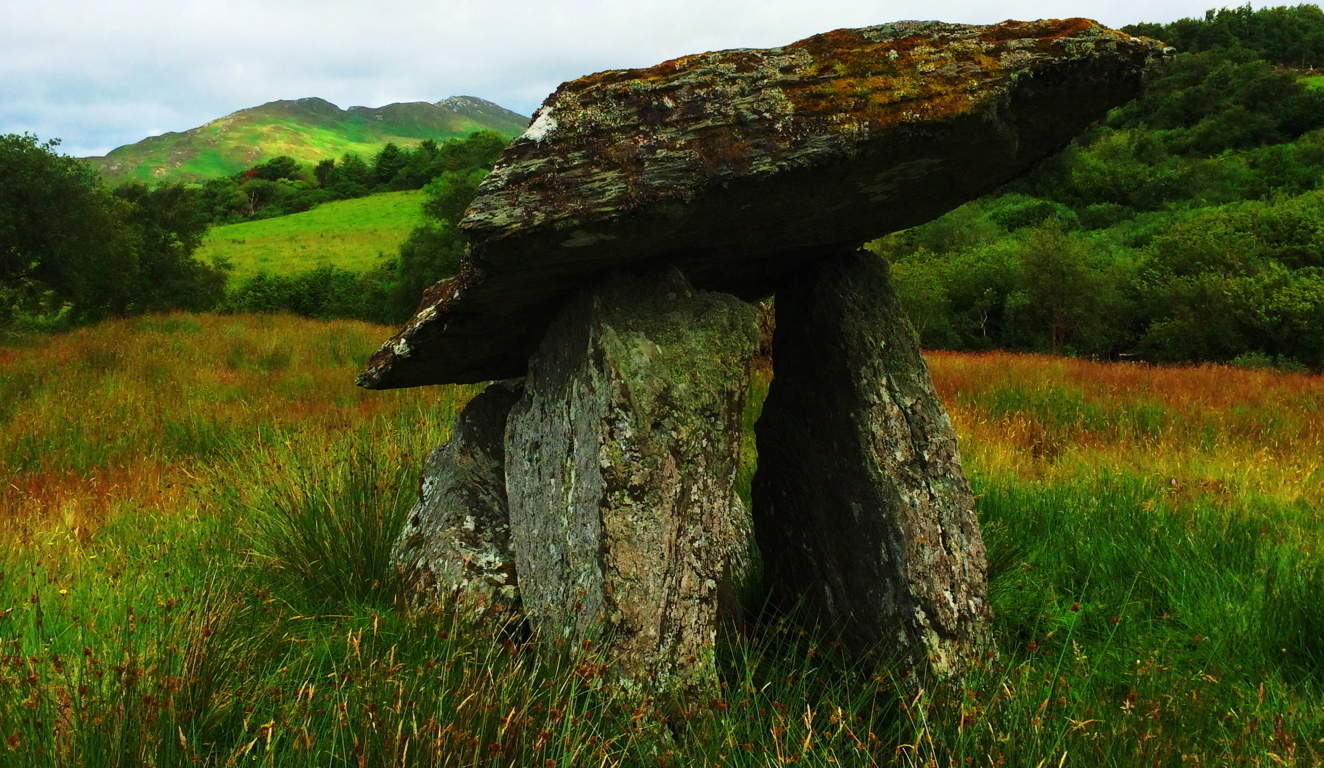 Location: Kerrykeel/Ranny Mountain/Ireland
Location: Kerrykeel/Ranny Mountain/Ireland
Note: It is hard to know how to begin when talking about a place like Gortnavern. It really isn’t a place that you will find in a tourism guidebook. It’s a rugged and cloudy place, with dark oily soil in the heights. Known as ‘Ranny’ to the locals, the small black mountain peak here overlooks Mulroy Bay, an inlet extending out to the stark Atlantic edge of Ireland’s northernmost coastline.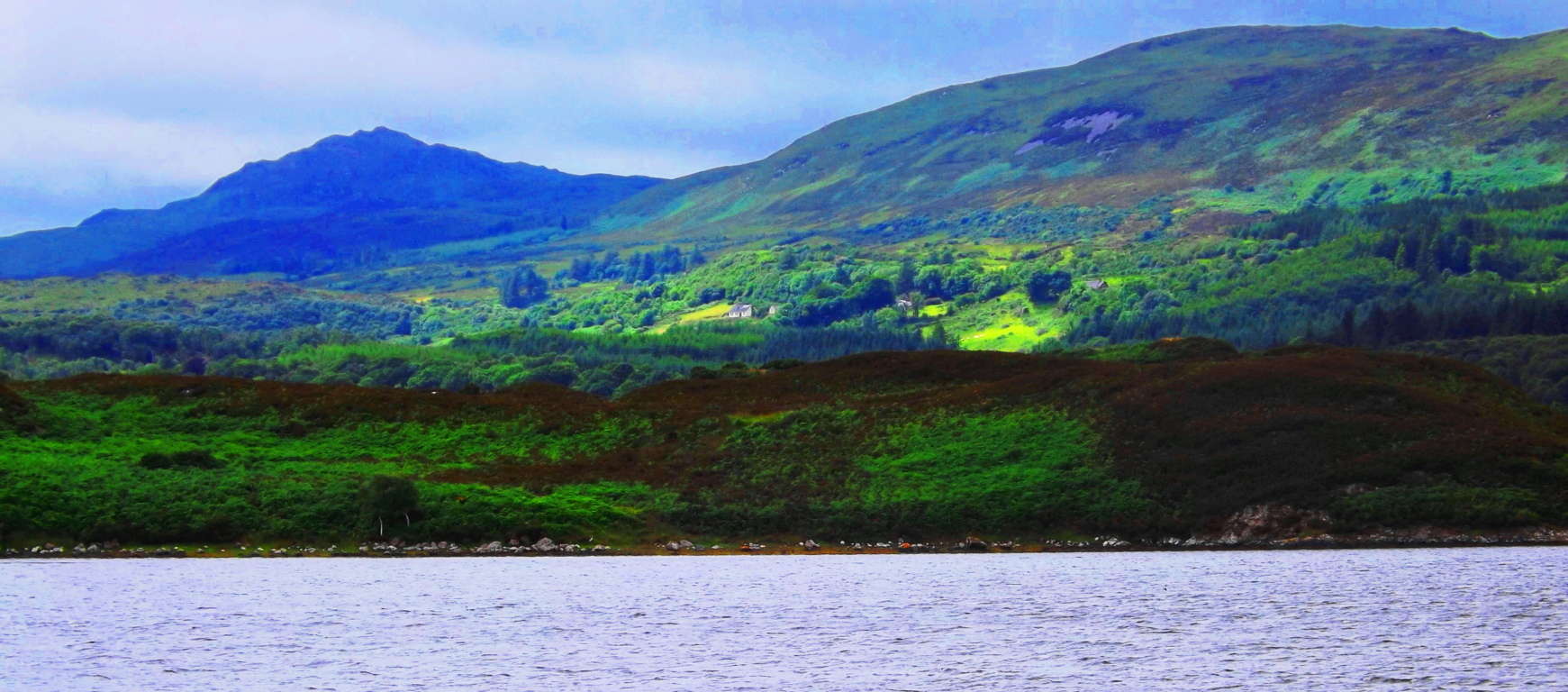 There are no trails here, just farmers roads, and fields upon fields. In the distance to the northeast is a rim of mountains that create a saturated basin of nearly picture perfect rolling hills and streams.
There are no trails here, just farmers roads, and fields upon fields. In the distance to the northeast is a rim of mountains that create a saturated basin of nearly picture perfect rolling hills and streams.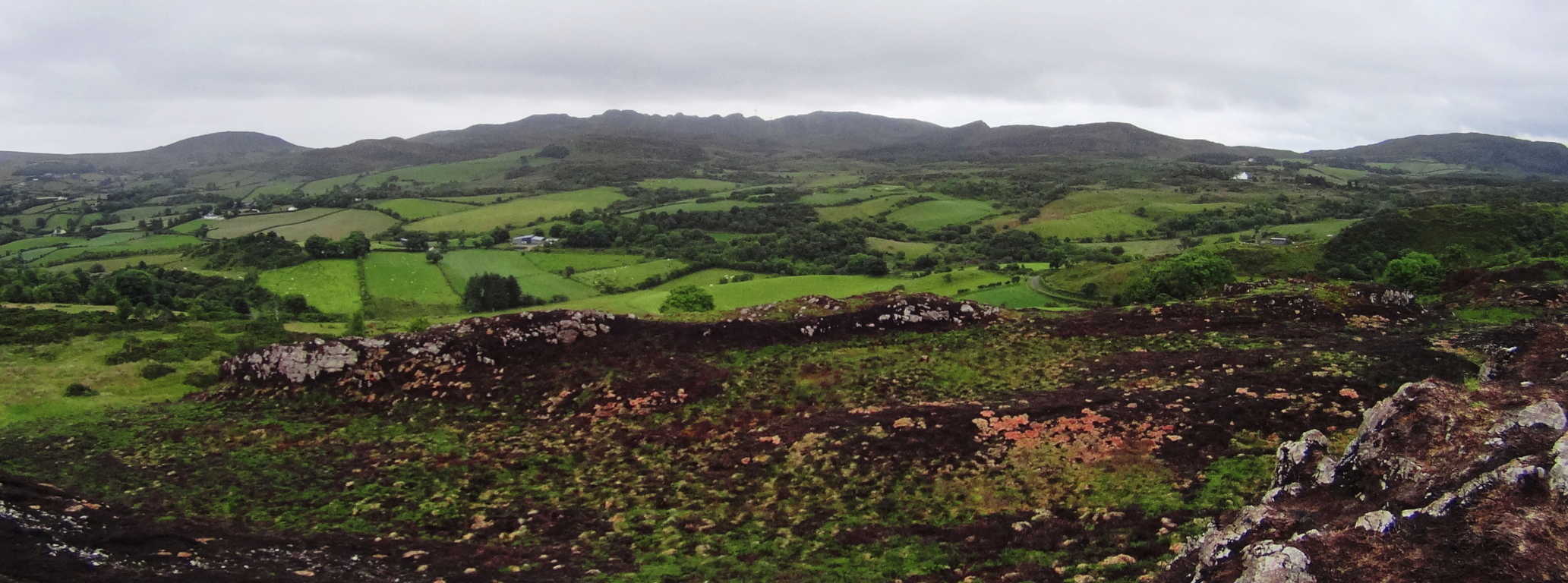 What looks like a simple and approachable climb through these heights is actually a phalanx of thick hedges, stony streams, tall grass, rocky knolls, spongy moss, and tough roots.
What looks like a simple and approachable climb through these heights is actually a phalanx of thick hedges, stony streams, tall grass, rocky knolls, spongy moss, and tough roots.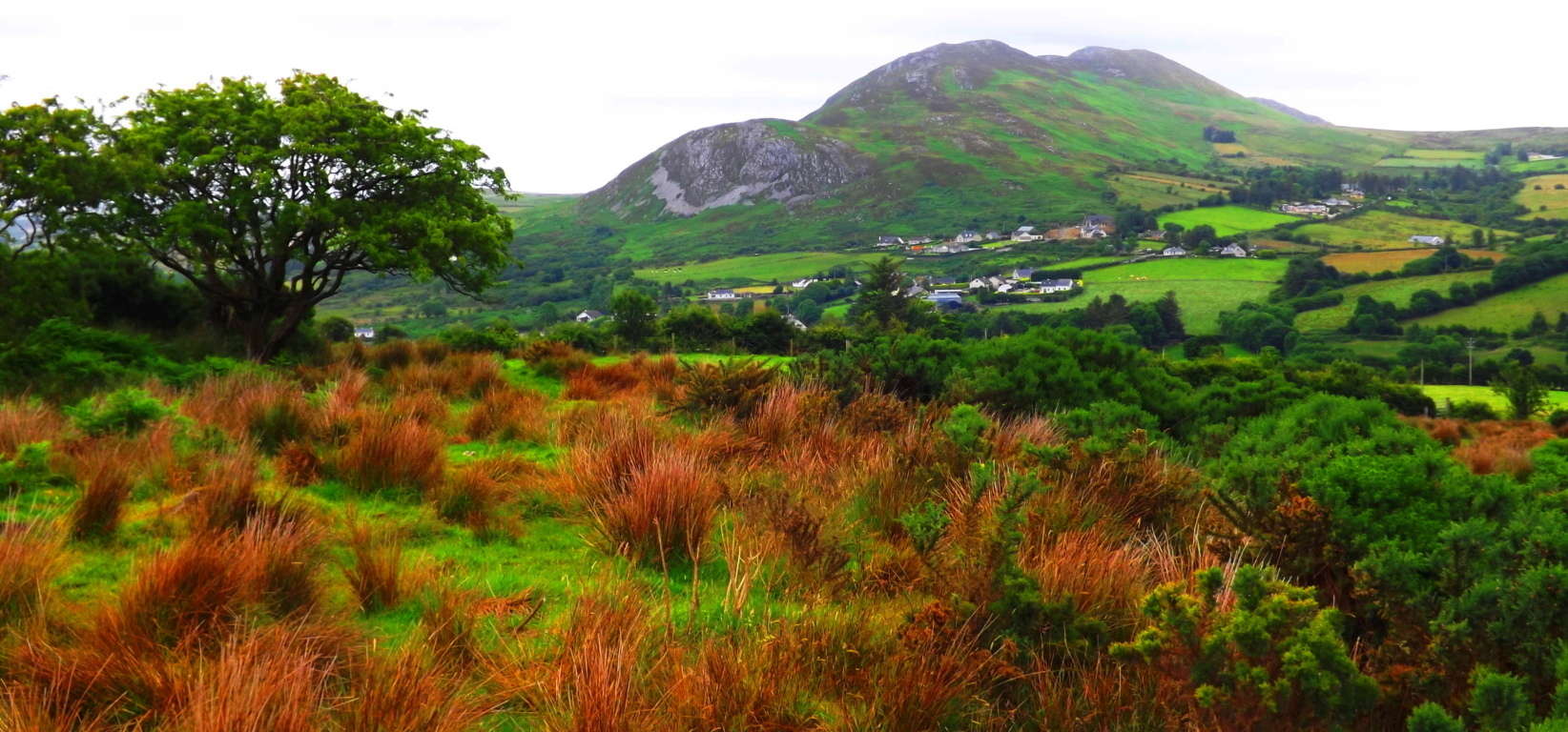 You will need all your gear, tall boots, and rain suit, to hike without fear. At the dark peak of Ranny wild goats graze and look on. It is easy to see that people do not come here often, judging from the looks on their faces.
You will need all your gear, tall boots, and rain suit, to hike without fear. At the dark peak of Ranny wild goats graze and look on. It is easy to see that people do not come here often, judging from the looks on their faces.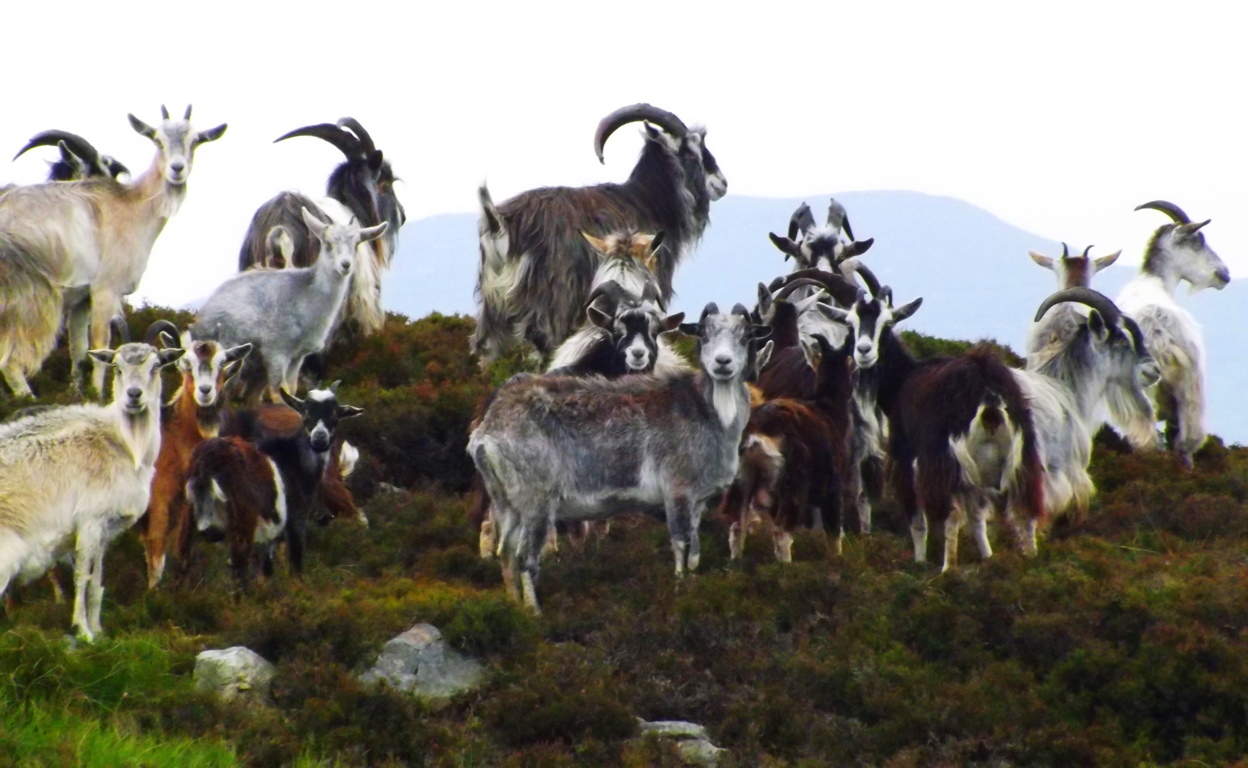 There are plants and fauna here that I have never seen before, with winding undergrowth and tunnels of tough branches. To achieve the peak at Ranny you will have to pass through them.
There are plants and fauna here that I have never seen before, with winding undergrowth and tunnels of tough branches. To achieve the peak at Ranny you will have to pass through them.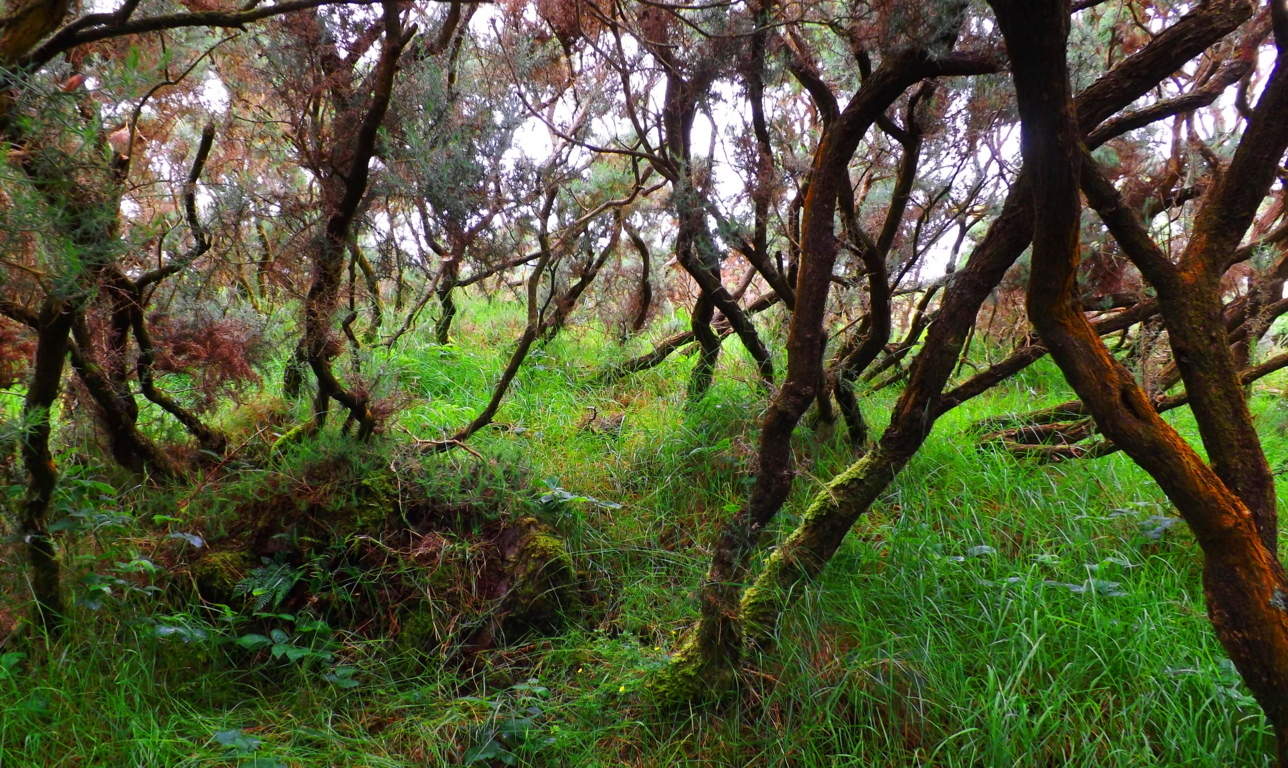 Not only that, but you will have to cross streams, climb fences, and avoid bulls in the fields. At this point you’ll probably want to ask: ” Well then, why the hell would you want to go hiking there?”
Not only that, but you will have to cross streams, climb fences, and avoid bulls in the fields. At this point you’ll probably want to ask: ” Well then, why the hell would you want to go hiking there?”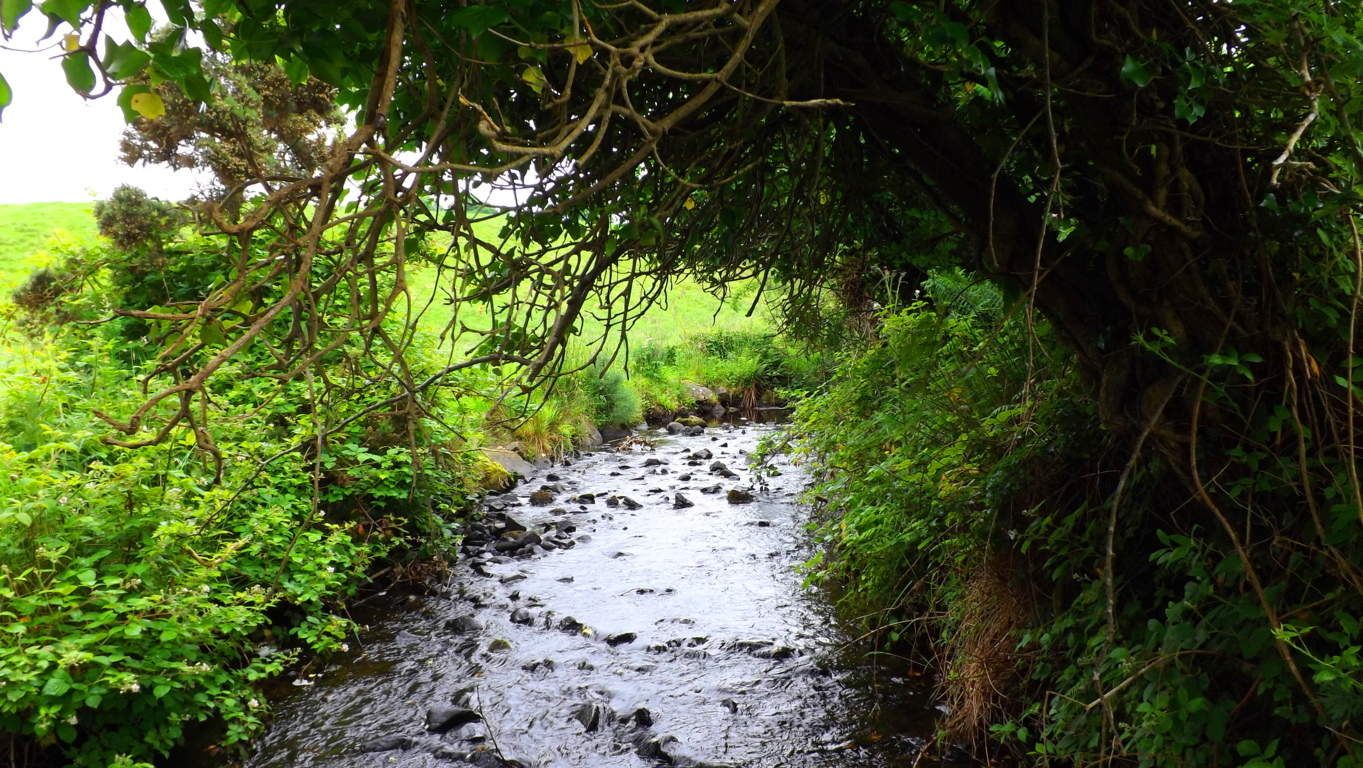 It’s a good question, with a worthy explanation. The Dolmen. The misty heights of Ranny is home to one of the few remaining undisturbed Celtic Dolmens in this part of the world. Other Dolmens remain, but are reinforced, rebuilt, or tampered with, in various ways; But not the Gortnavern Dolmen. It is in situ, in it’s original state; A beyond-priceless expression from an era gone by, built by the first culture that this part of the world had ever seen.
It’s a good question, with a worthy explanation. The Dolmen. The misty heights of Ranny is home to one of the few remaining undisturbed Celtic Dolmens in this part of the world. Other Dolmens remain, but are reinforced, rebuilt, or tampered with, in various ways; But not the Gortnavern Dolmen. It is in situ, in it’s original state; A beyond-priceless expression from an era gone by, built by the first culture that this part of the world had ever seen. Irish archaeologists date the building of most Dolmens somewhere around 4000 to 6000 B.C.E, but in truth, there is really no way of knowing just how old this megalith is. This is an exquisite example of the Portal Tomb, which is a spiritual statement of a crafted, massive, stone satellite, meant for catapulting souls from this world, to the stars. The 10 ton, elevated capstone, supported by five huge pillar pieces beneath, is forever tipping its brim towards the beautiful Gortnatraw Mountain in the distance. If you can get to this spot, it feels as if whoever created this Dolmen, wanted us to see how beautiful they felt this very scene was, which is why, perhaps, they chose to face the capstone in that specific direction. If that is the case, then as you look, you are sharing a moment with someone who lived 6000 years ago.
Irish archaeologists date the building of most Dolmens somewhere around 4000 to 6000 B.C.E, but in truth, there is really no way of knowing just how old this megalith is. This is an exquisite example of the Portal Tomb, which is a spiritual statement of a crafted, massive, stone satellite, meant for catapulting souls from this world, to the stars. The 10 ton, elevated capstone, supported by five huge pillar pieces beneath, is forever tipping its brim towards the beautiful Gortnatraw Mountain in the distance. If you can get to this spot, it feels as if whoever created this Dolmen, wanted us to see how beautiful they felt this very scene was, which is why, perhaps, they chose to face the capstone in that specific direction. If that is the case, then as you look, you are sharing a moment with someone who lived 6000 years ago. What could be a more worth while hiking goal? Whatever you do, stop to appreciate the the strange darkened peaks, of a style i had never seen before, or since. In the end, you will have to decide what your goals in a rustic scene like this will be.
What could be a more worth while hiking goal? Whatever you do, stop to appreciate the the strange darkened peaks, of a style i had never seen before, or since. In the end, you will have to decide what your goals in a rustic scene like this will be.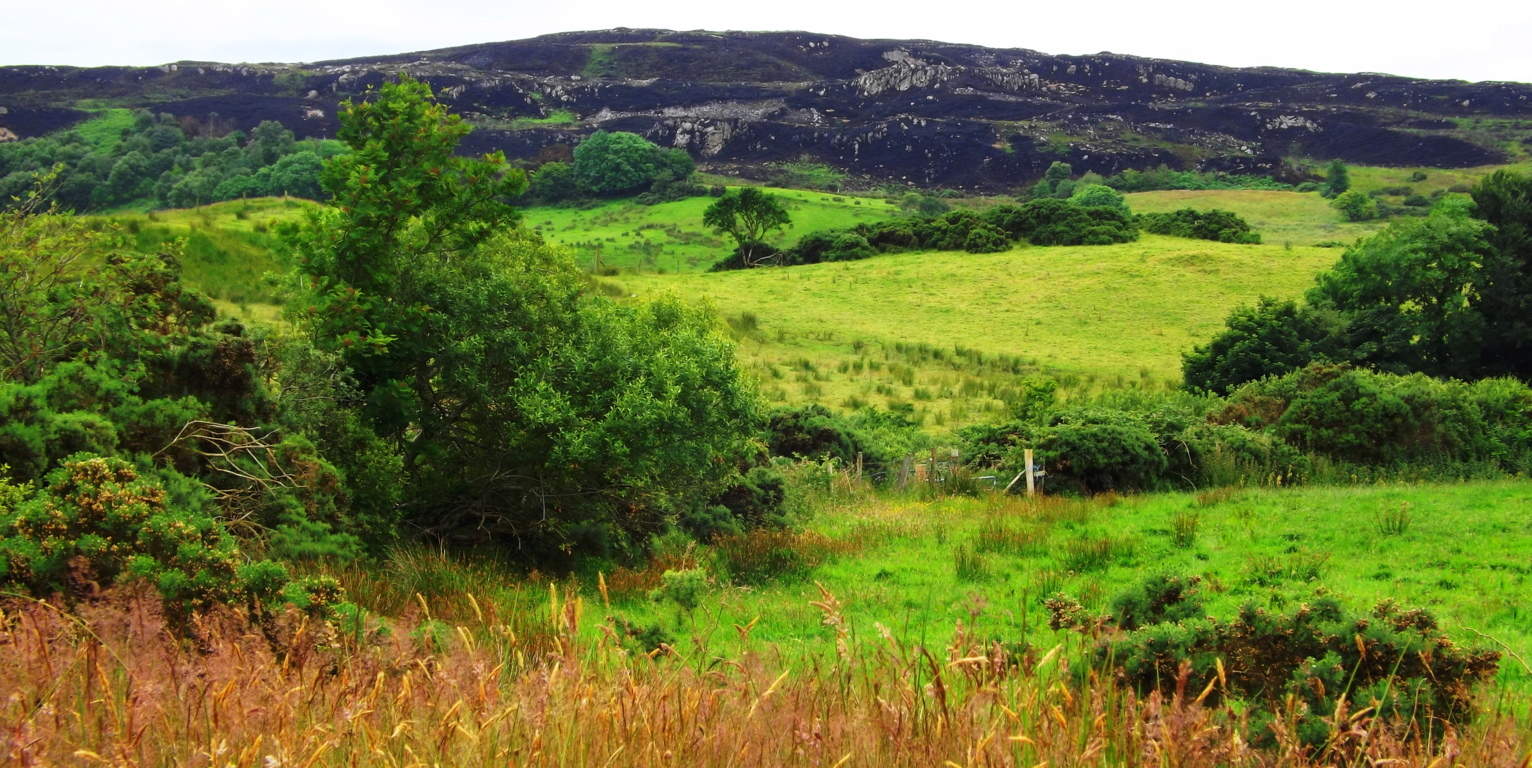 If hiking to the top of Mount Ranny is your goal, be prepared to cross farmers fields, and travail the obstacles, with a tough incline as you go. If finding the Gortnavern Dolmen is your goal, you must find Drumatrumman Road. Pass the farm at the top of Drumatrumman Road, and continue about a half mile further up the hedgy dirt path. You will need to look right; At about 75 yards to the right of the lane, beyond cows in the fields, just to the next gully, beyond the stream, you will see the Dolmen. Beyond the hedges behind the cattle in the image below, the Dolmen is just out of view at this vantage from the road. Keep clear of the bull, follow the hedge to the left.
If hiking to the top of Mount Ranny is your goal, be prepared to cross farmers fields, and travail the obstacles, with a tough incline as you go. If finding the Gortnavern Dolmen is your goal, you must find Drumatrumman Road. Pass the farm at the top of Drumatrumman Road, and continue about a half mile further up the hedgy dirt path. You will need to look right; At about 75 yards to the right of the lane, beyond cows in the fields, just to the next gully, beyond the stream, you will see the Dolmen. Beyond the hedges behind the cattle in the image below, the Dolmen is just out of view at this vantage from the road. Keep clear of the bull, follow the hedge to the left.  More generally, approaching this scene, there is a sign for the ‘Gortnavern Dolmen’ from the main road just outside Kerrykeel center, but from there you should plan to ask for help, and bring your GPS/Phone, you will need it. Many of the roads do not have names, so approach farmers with humble honesty and respect. You are on their land. If you tell them you would like to see the Dolmen, they will gladly show you the way, but DO NOT JUST WAVE AT THEM AND PASS BY. This is a real rural community, with functional farms and generational families at work, be respectful.
More generally, approaching this scene, there is a sign for the ‘Gortnavern Dolmen’ from the main road just outside Kerrykeel center, but from there you should plan to ask for help, and bring your GPS/Phone, you will need it. Many of the roads do not have names, so approach farmers with humble honesty and respect. You are on their land. If you tell them you would like to see the Dolmen, they will gladly show you the way, but DO NOT JUST WAVE AT THEM AND PASS BY. This is a real rural community, with functional farms and generational families at work, be respectful. If you can get to Gortnavern, you have already achieved something which most people, even seasoned hikers, will never do. These are the rare places, the wild unmarked terrains, where you will discover more about yourself in the challenge, than any commercially advertised trek can offer. This is the real Celtic experience. Go strong, bring plenty of water, and may the road rise to meet you.
If you can get to Gortnavern, you have already achieved something which most people, even seasoned hikers, will never do. These are the rare places, the wild unmarked terrains, where you will discover more about yourself in the challenge, than any commercially advertised trek can offer. This is the real Celtic experience. Go strong, bring plenty of water, and may the road rise to meet you.
The Raven Wildlife Preserve
Note: Along the gorgeous south-west coast of Ireland, which runs all the way down to a baby-blue Irish Sea, sits the rare, old-growth, Celtic forest known as The Raven. There are a few reasons why it’s rare; The first being the British incursion of Ireland, which took place from the early Medieval period into the Colonial. The British occupation made it possible to extort vital resources for England, such as timber for the imperial fleet, starting in the mid 1500’s. 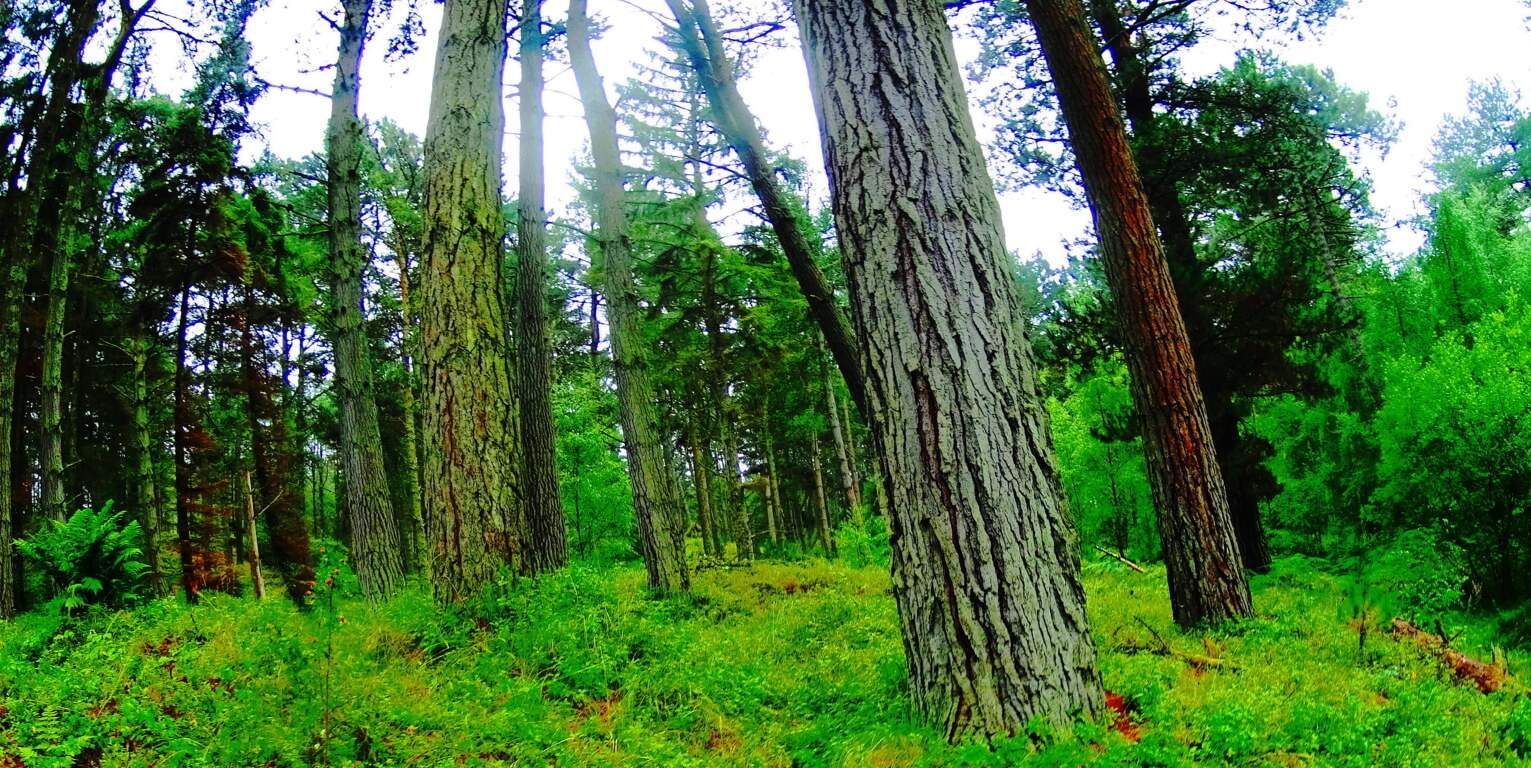 Luckily The Raven survived. The second reason for the rarity of this place is that The Raven has been a protected wildlife Reserve since the 1880’s, making it a priceless time capsule of trees and flowers that have almost vanished. It is the only place left in the country where you can find the wildflower known as Wintergreen, which is mingled among Devil’s-Bits, Foxgloves, and Bluebells in the grassy dunes. This is a place to let your imagination go, and daydream about the feeling of old Celtic regions. It is a natural kingdom of preserved fauna and wildlife that Celtic peoples felt was sacred.
Luckily The Raven survived. The second reason for the rarity of this place is that The Raven has been a protected wildlife Reserve since the 1880’s, making it a priceless time capsule of trees and flowers that have almost vanished. It is the only place left in the country where you can find the wildflower known as Wintergreen, which is mingled among Devil’s-Bits, Foxgloves, and Bluebells in the grassy dunes. This is a place to let your imagination go, and daydream about the feeling of old Celtic regions. It is a natural kingdom of preserved fauna and wildlife that Celtic peoples felt was sacred.
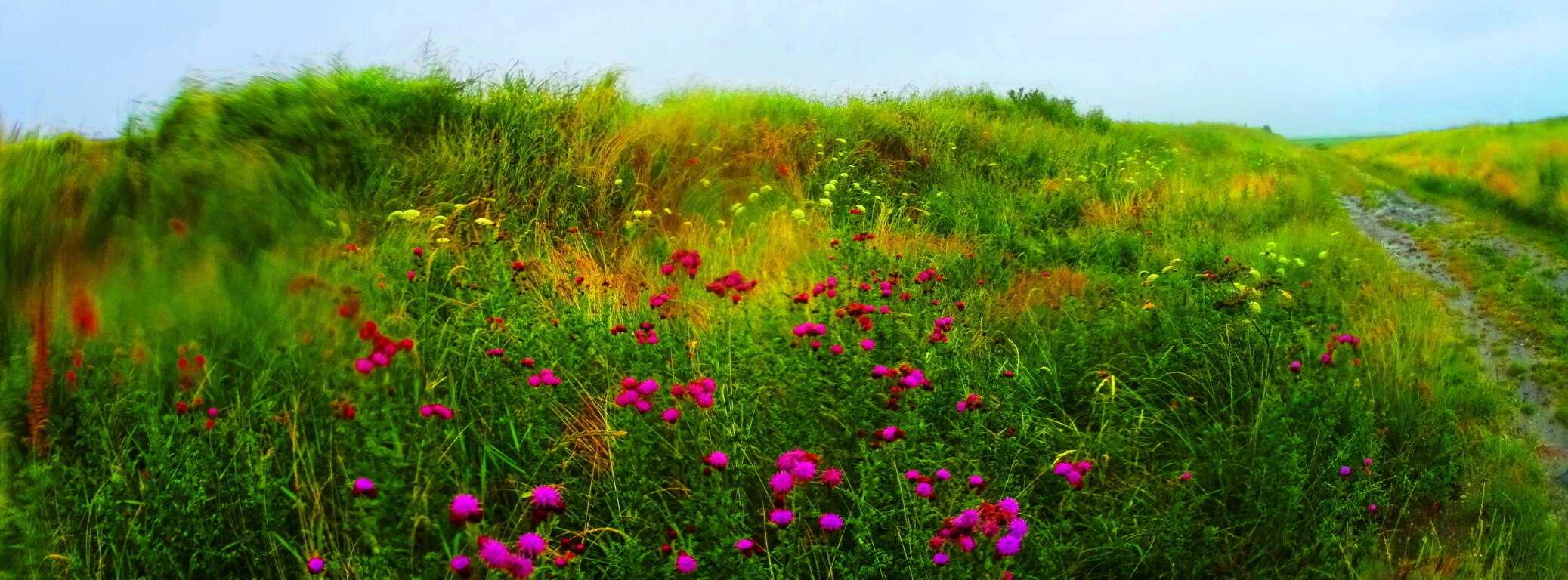 Beautiful trails extend around, and through this forest of towering Irish Pines and Evergreens. One of the trails is a basic circular loop around the edge of the old glades. S0me tree’s are standing over 150 feet tall, above broad beds of rolling clover, tall grass, and shiny white sand.
Beautiful trails extend around, and through this forest of towering Irish Pines and Evergreens. One of the trails is a basic circular loop around the edge of the old glades. S0me tree’s are standing over 150 feet tall, above broad beds of rolling clover, tall grass, and shiny white sand.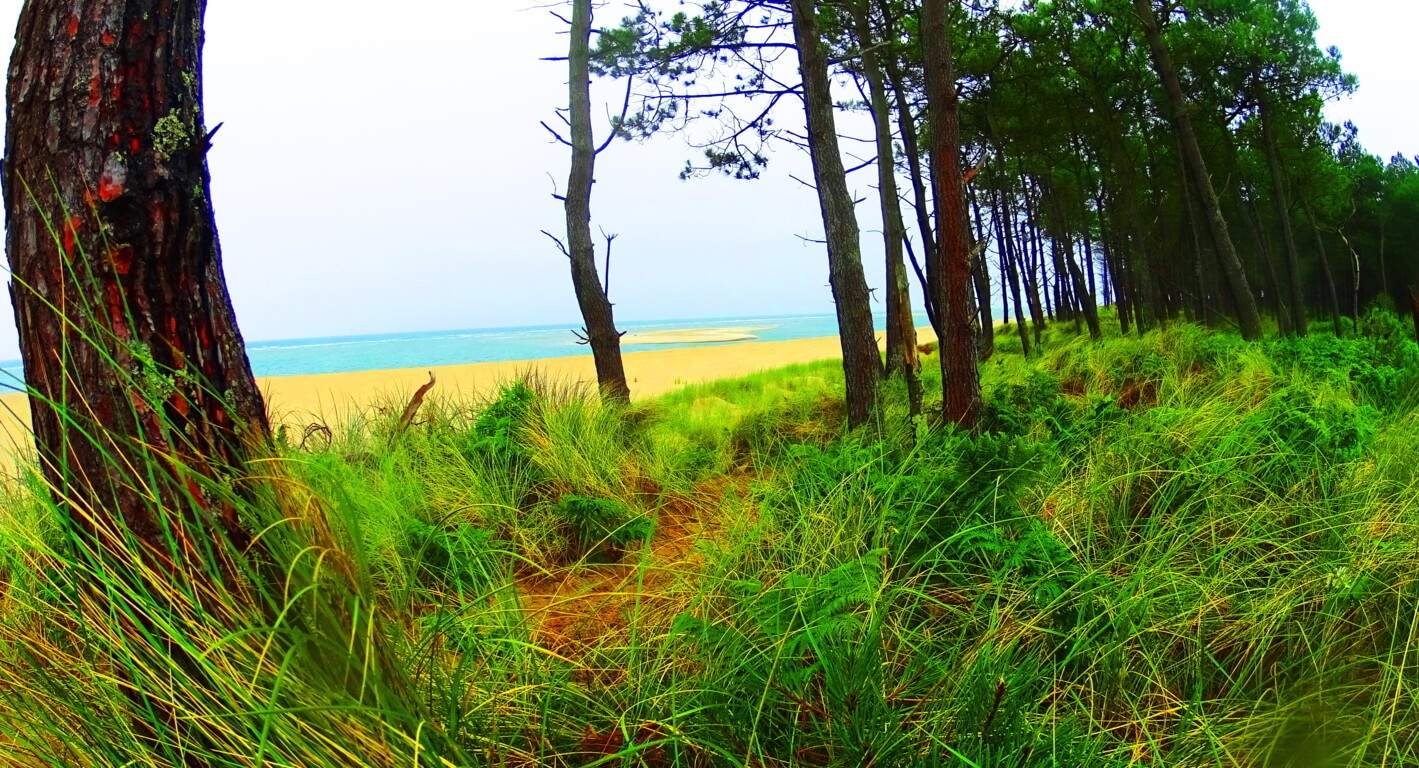 If you add the element of the striking blue-crystaline color of the Irish Sea, the overall scene becomes worthy of wonder. There are fantastic minor trails that branch off into the forest, creating a direct pathway from the beach, about halfway around the larger outer loop.
If you add the element of the striking blue-crystaline color of the Irish Sea, the overall scene becomes worthy of wonder. There are fantastic minor trails that branch off into the forest, creating a direct pathway from the beach, about halfway around the larger outer loop.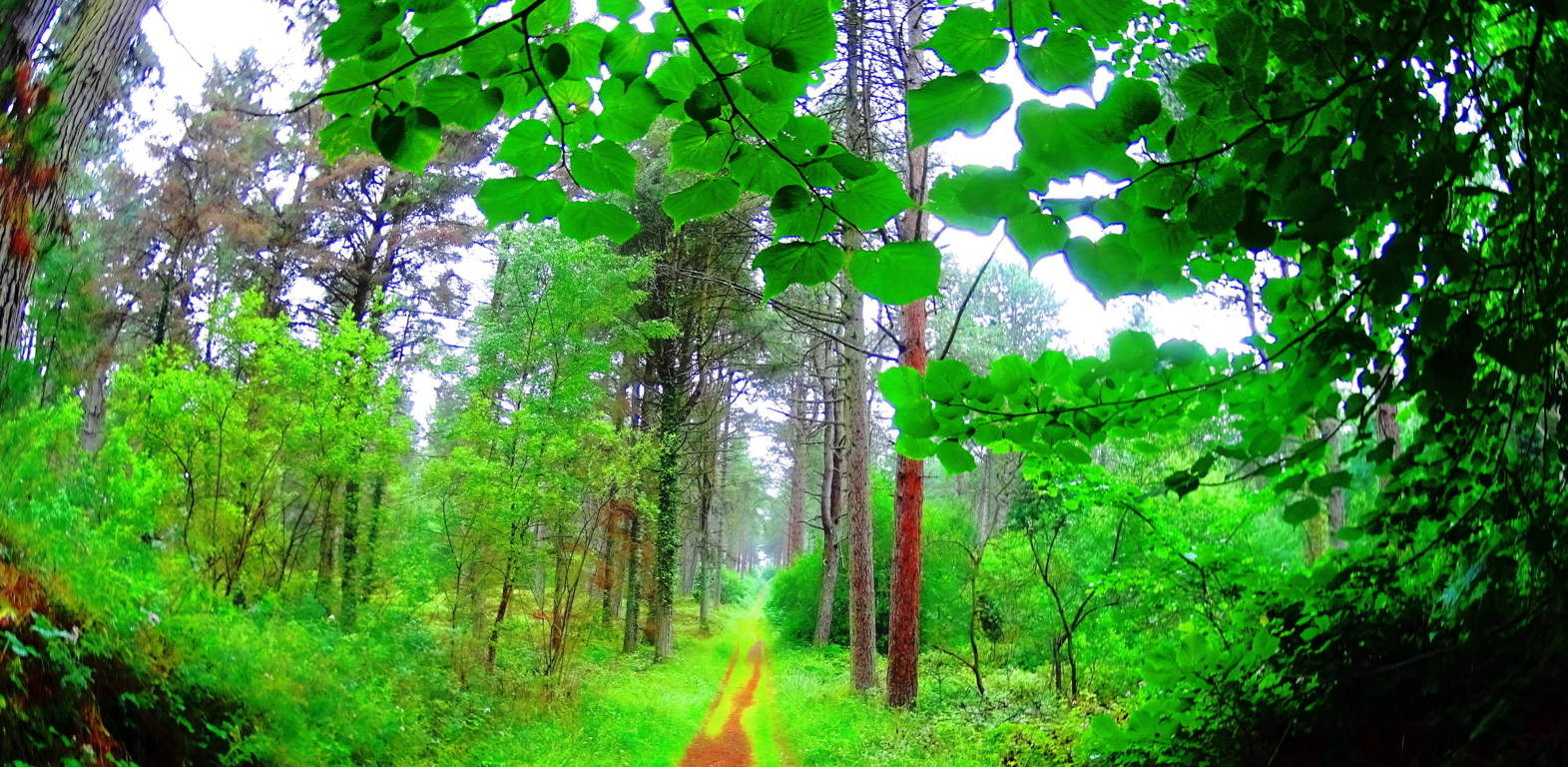 These pathways are nearly perfect for mountain-biking as well. An extended adventure is possible for those who wish to try a more rustic challenge of approaching the Raven from further off. If you park at Adcavan business park, about 3 miles away, you can bike the small dirt road that runs parallel to The Raven in the distance. Riding from the main road, you will need to lift your bike over a simple gate, and ride 2 miles, eventually reaching a dilapidated stone archway. This archway marks the path that runs directly towards the forest.
These pathways are nearly perfect for mountain-biking as well. An extended adventure is possible for those who wish to try a more rustic challenge of approaching the Raven from further off. If you park at Adcavan business park, about 3 miles away, you can bike the small dirt road that runs parallel to The Raven in the distance. Riding from the main road, you will need to lift your bike over a simple gate, and ride 2 miles, eventually reaching a dilapidated stone archway. This archway marks the path that runs directly towards the forest. 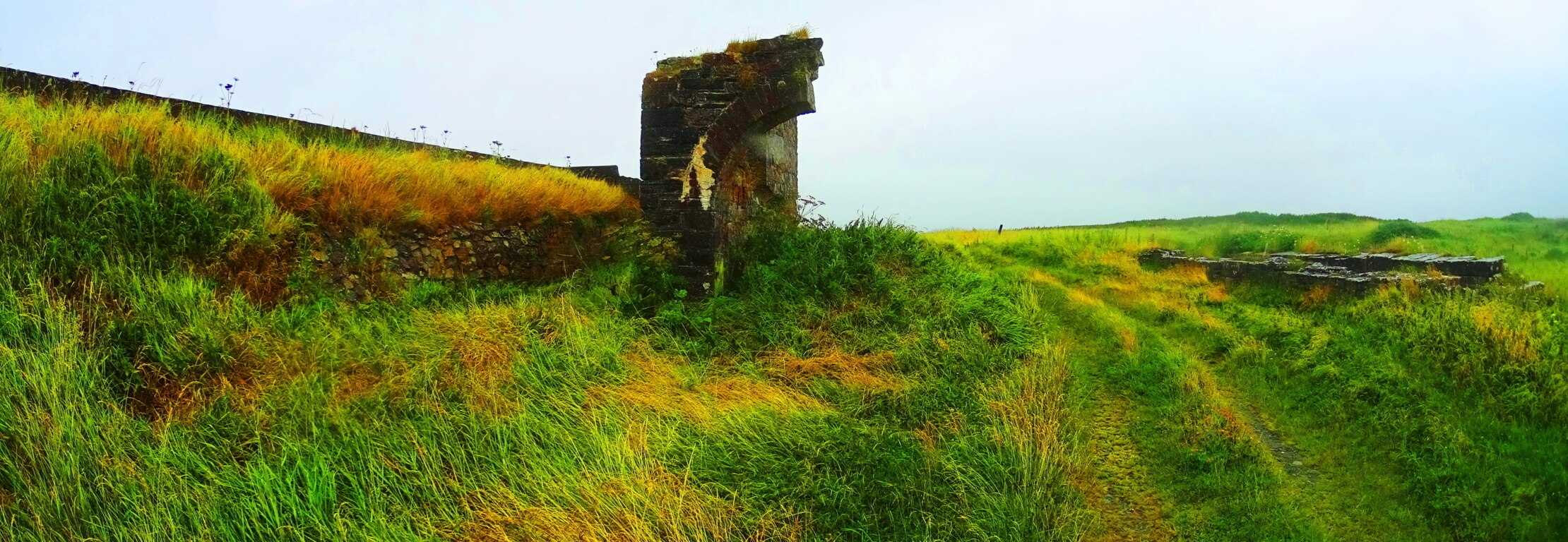 This route is rustic and challenging, with rocky paths that run along a huge ocean channel lined with golden wildflowers while you approach. At times you may need to walk your bike, but it leaves time to get a picture of the channel with The Raven beyond.
This route is rustic and challenging, with rocky paths that run along a huge ocean channel lined with golden wildflowers while you approach. At times you may need to walk your bike, but it leaves time to get a picture of the channel with The Raven beyond.
 Once you reach the forest you may wish to explore the beach before continuing to ride. Lock your bike around a tree and climb over the dunes to get a glimpse of the Irish Sea. Smaller side paths lead through thickets on the edge of the dunes that are tempting to follow.
Once you reach the forest you may wish to explore the beach before continuing to ride. Lock your bike around a tree and climb over the dunes to get a glimpse of the Irish Sea. Smaller side paths lead through thickets on the edge of the dunes that are tempting to follow.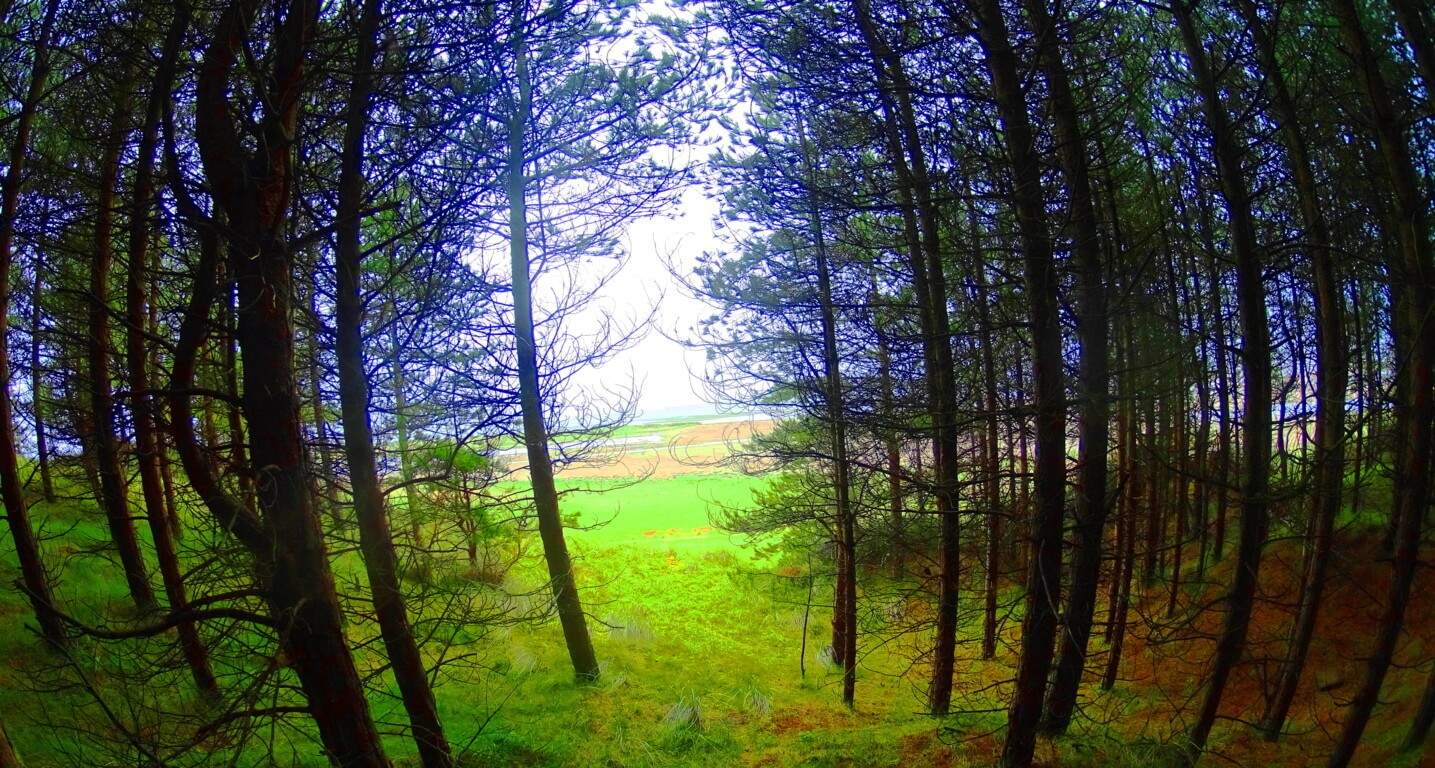 The Pines run to the edge of the dunes, opening up to a spectacular scene, one which the ancient mariners of England, and the Vikings, must have admired while approaching to raid. A view like this is also most likely what a young Saint Patrick must have seen, and had to return to, even after captivity.
The Pines run to the edge of the dunes, opening up to a spectacular scene, one which the ancient mariners of England, and the Vikings, must have admired while approaching to raid. A view like this is also most likely what a young Saint Patrick must have seen, and had to return to, even after captivity.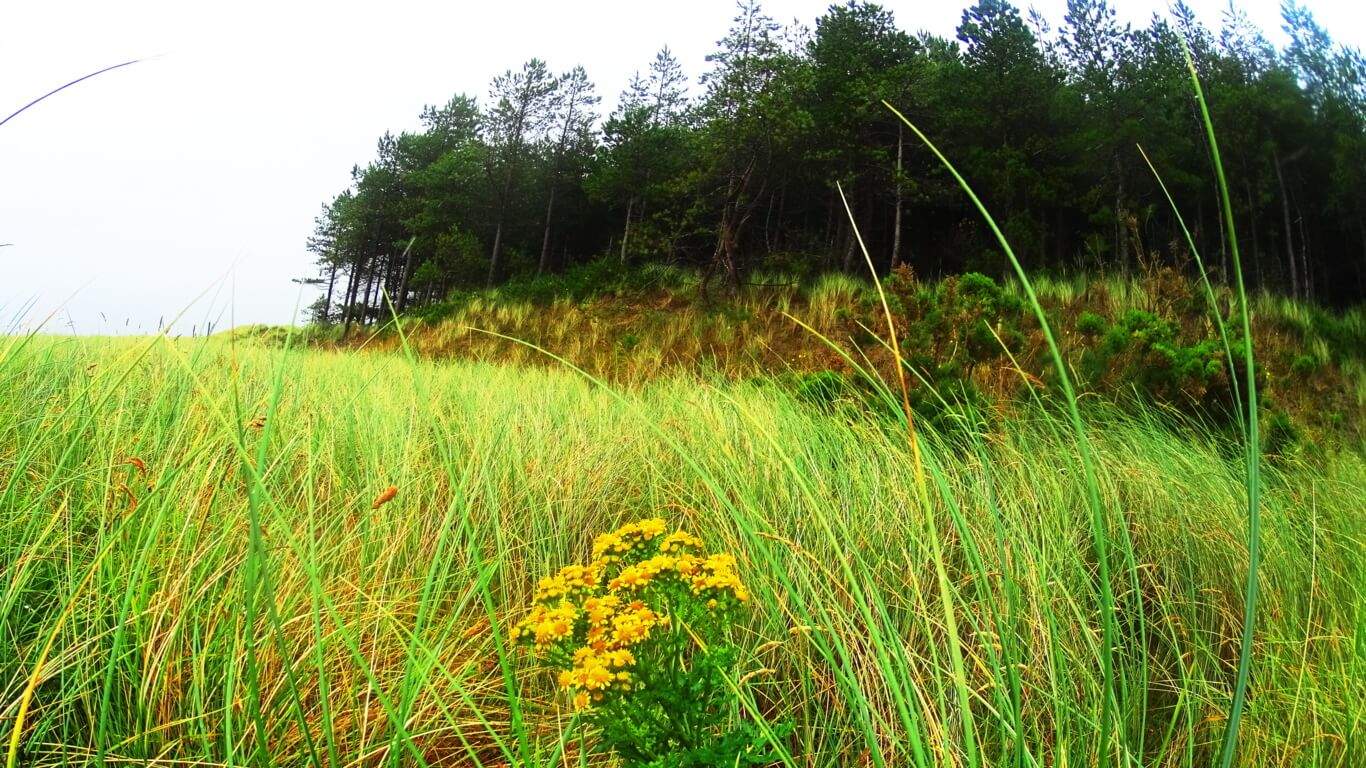 This place is hauntingly beautiful, even on a cloudy day. Enjoy the opportunity to relax and wander in a rare wildlife scene from long ago. All options for exploration are possible at The Raven. Good luck as you go:) Seek and find.
This place is hauntingly beautiful, even on a cloudy day. Enjoy the opportunity to relax and wander in a rare wildlife scene from long ago. All options for exploration are possible at The Raven. Good luck as you go:) Seek and find.
The Burren
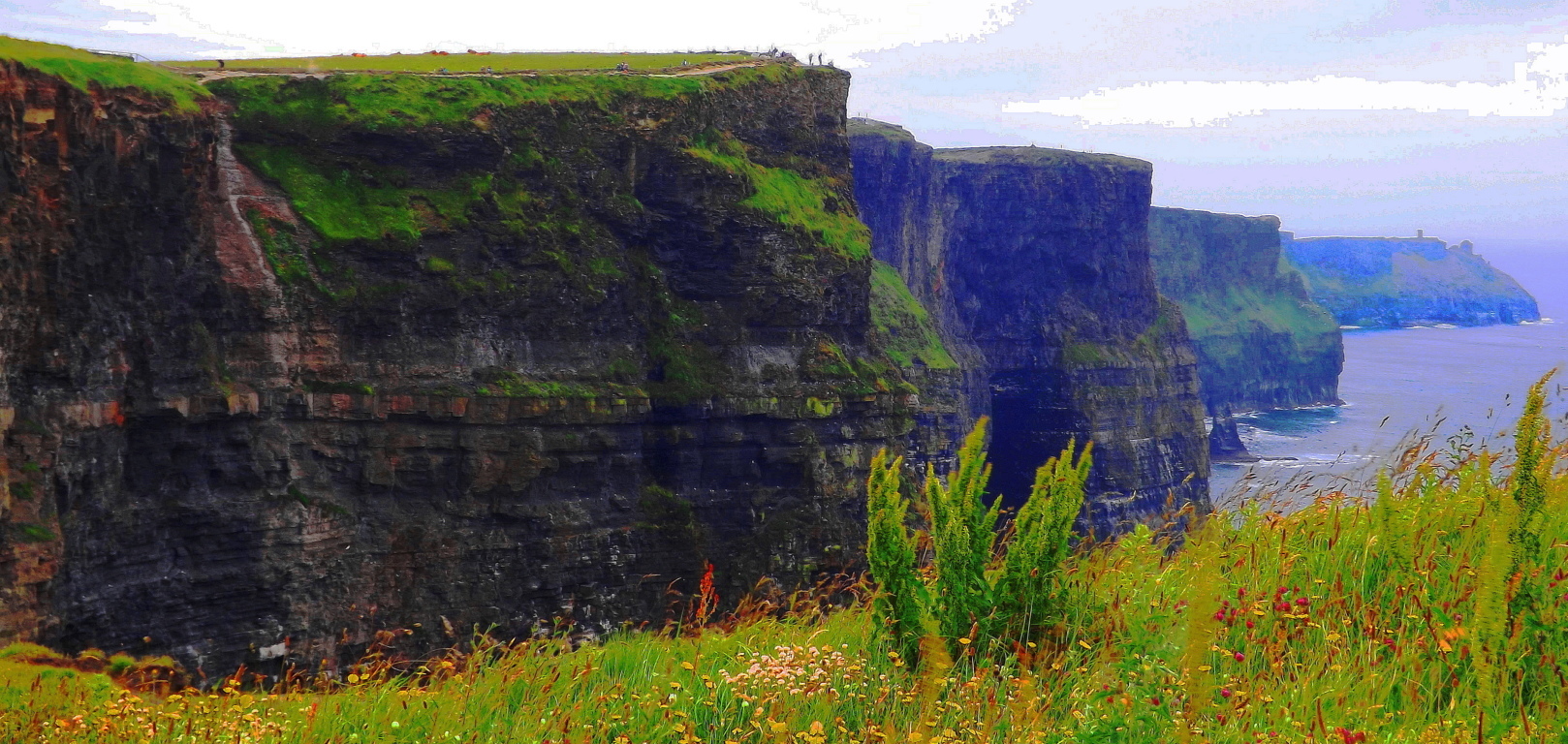 Location: County Clare/Coastline/ Cliffs/Mountains/South of Galway
Location: County Clare/Coastline/ Cliffs/Mountains/South of Galway
Note: It is a beautiful thought that some places in the world are simply known as ‘regions’. The Burren is every bit a national park as any of the existing national parks in Ireland, and yet it is simply a region.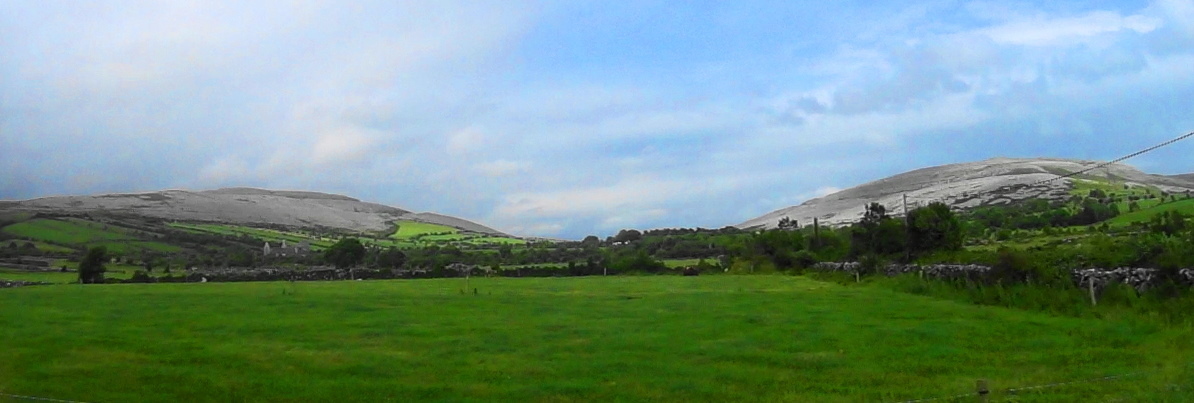 No modern organization monitors this area overall. It is sustained by the endearing love of the Irish generations that have lived here since Celtic times. These are the people that remained through the Medieval-to-Colonial British incursions, and The Famine, and reveal an incredibly deep connection. A single sojourning through this striking landscape is all a hiker needs to understand this connection.
No modern organization monitors this area overall. It is sustained by the endearing love of the Irish generations that have lived here since Celtic times. These are the people that remained through the Medieval-to-Colonial British incursions, and The Famine, and reveal an incredibly deep connection. A single sojourning through this striking landscape is all a hiker needs to understand this connection.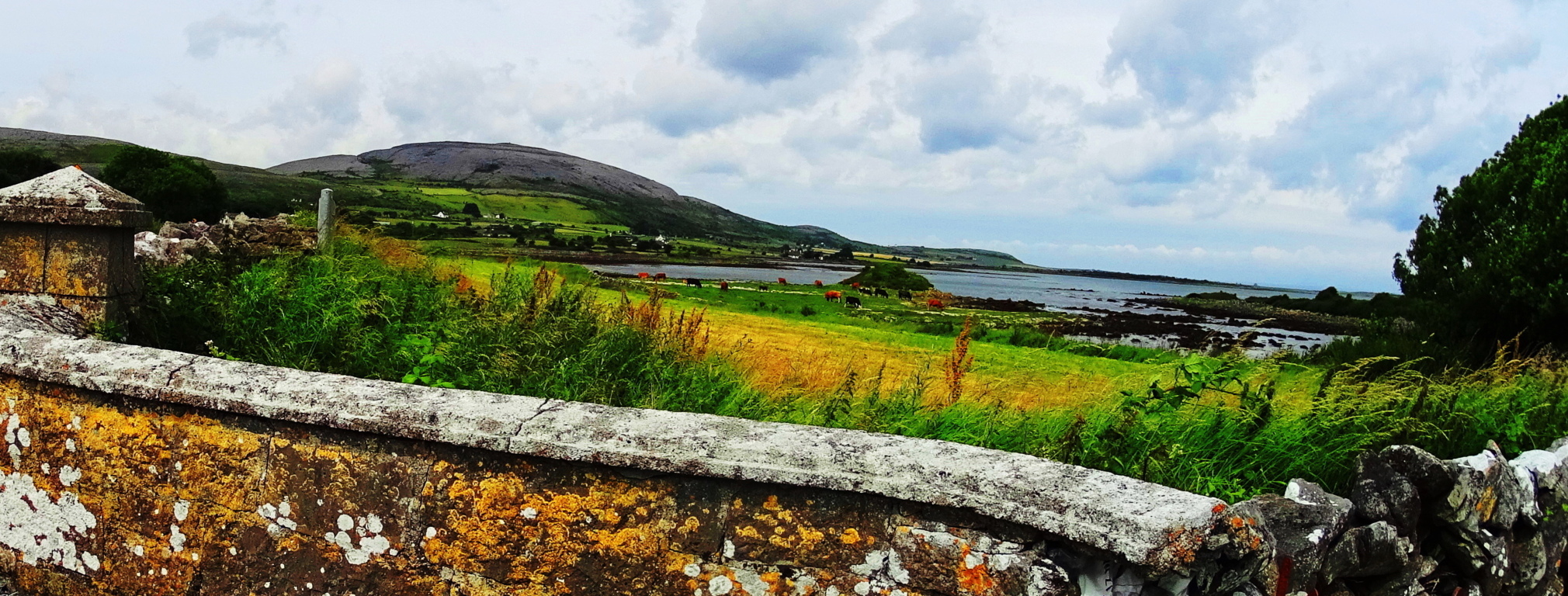 The roads and hills are open to hiking and climbing, as well as designated pathways. Make your way to the entry points as best you can by researching, exploring, and engaging the people of the area. To begin, the N18 highway runs south of Galway and connects to N67, which flows into the dimension that is The Burren. The gateway to this dimension is Dunguire Castle, perhaps the most beautiful in all of Ireland.
The roads and hills are open to hiking and climbing, as well as designated pathways. Make your way to the entry points as best you can by researching, exploring, and engaging the people of the area. To begin, the N18 highway runs south of Galway and connects to N67, which flows into the dimension that is The Burren. The gateway to this dimension is Dunguire Castle, perhaps the most beautiful in all of Ireland.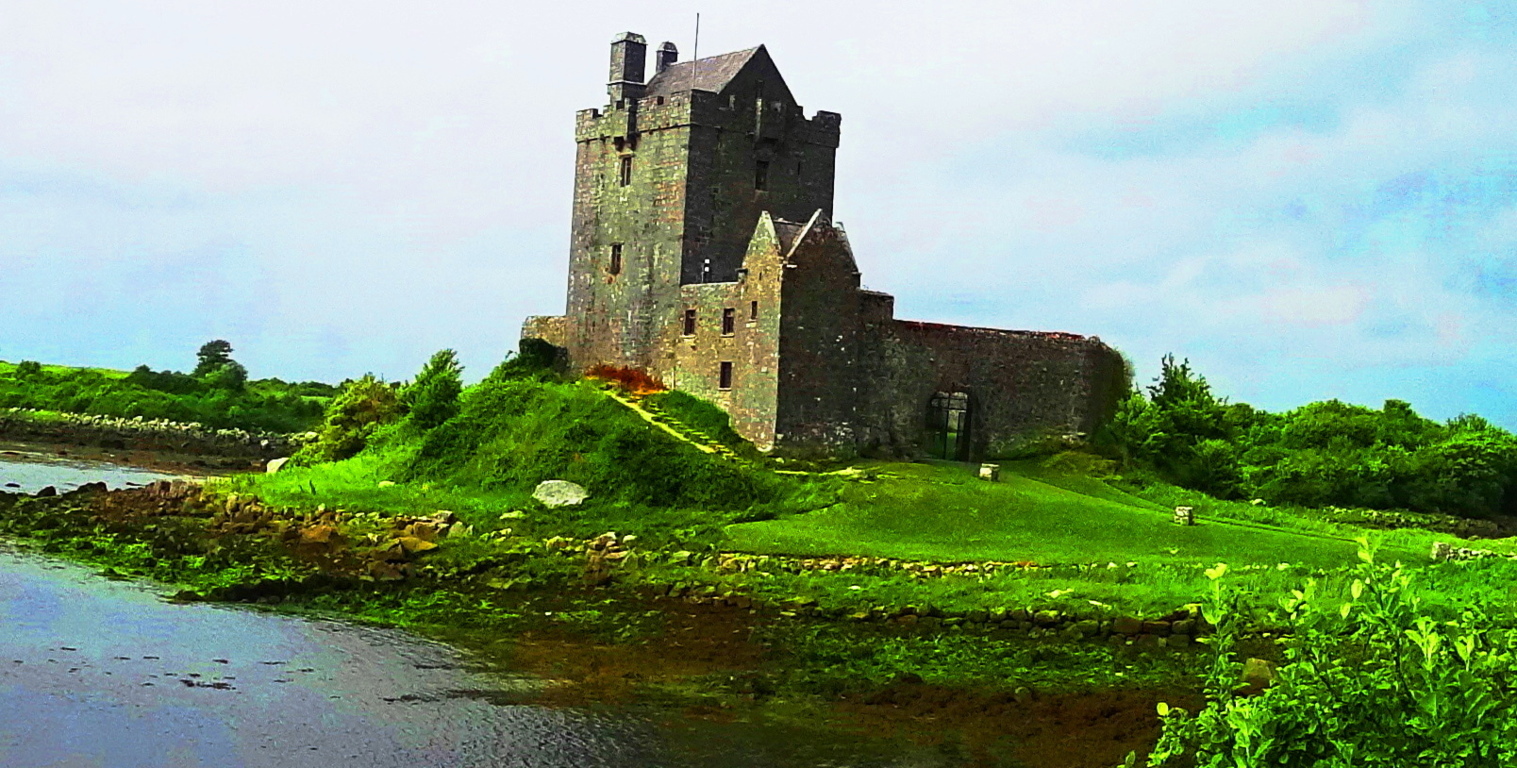 Embraced almost entirely by a bay that runs out of the harbor town of Kinvarra, Dunguire looks to be floating on a small island, slightly separated from reality.Dunguire’s grounds have pathways around the castle, and the courtyard is also accessible. Feel free to park in Kinvarra and walk a scenic mile to Dunguire’s 15th century gates. Kinvarra is the pivot-point for the turn westward, around the edge of the bay, and into the enchanted zones.
Embraced almost entirely by a bay that runs out of the harbor town of Kinvarra, Dunguire looks to be floating on a small island, slightly separated from reality.Dunguire’s grounds have pathways around the castle, and the courtyard is also accessible. Feel free to park in Kinvarra and walk a scenic mile to Dunguire’s 15th century gates. Kinvarra is the pivot-point for the turn westward, around the edge of the bay, and into the enchanted zones. In this place the small caps of the mountains are covered in white stones, with rock-stricken hillsides that are the color of the moon.
In this place the small caps of the mountains are covered in white stones, with rock-stricken hillsides that are the color of the moon.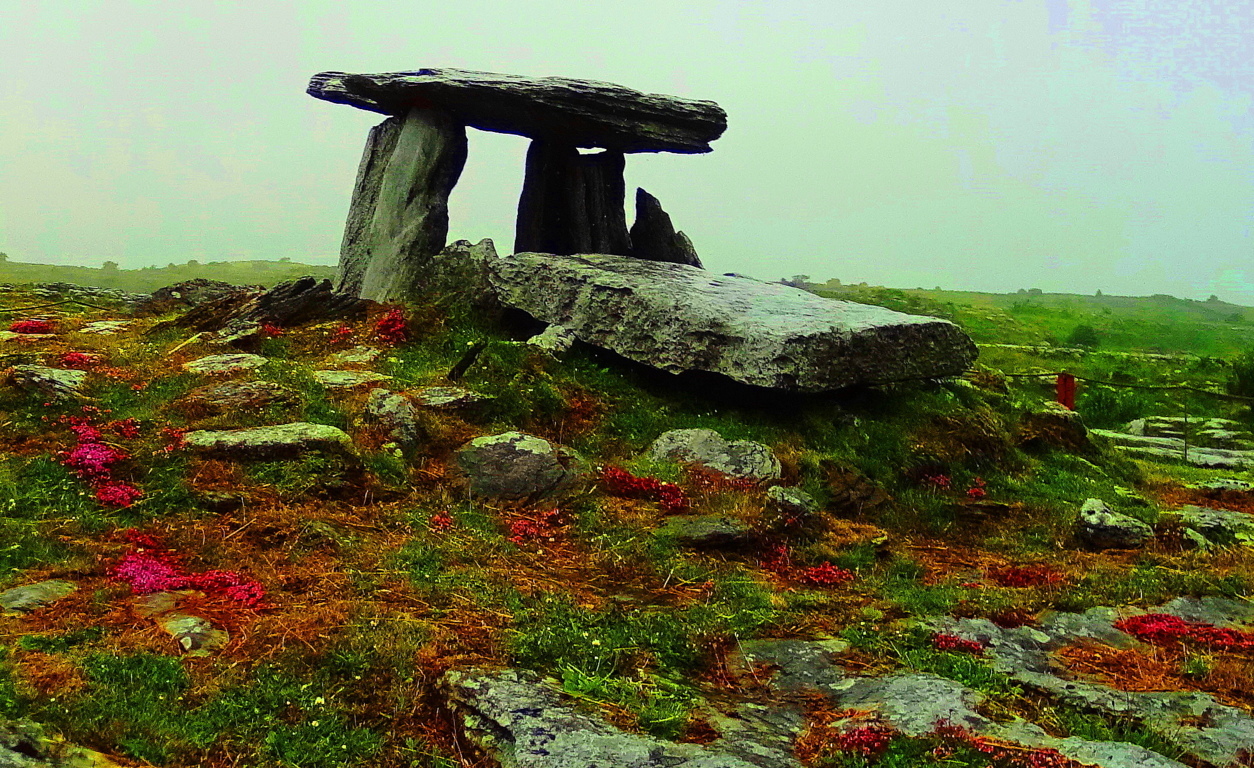 These undulating hills hide incredible monuments intertwined with the stone-walls and hedges. The Poulnabrone Dolmen has sat 17 miles southwest of Kinvarra for over 6000 years, and is the most iconic Dolmen in the world.
These undulating hills hide incredible monuments intertwined with the stone-walls and hedges. The Poulnabrone Dolmen has sat 17 miles southwest of Kinvarra for over 6000 years, and is the most iconic Dolmen in the world. This iconography is due to the otherworldly context of the megalith, surrounded by free-sitting boulders in the peripheral distance, and supported by smoothly grooved rows of rock beneath it. It looks to be the very crossroads of heaven and hell. At a glance, it becomes totally understandable as to why they call these Dolmens “Portal Tombs”, meant to send the spirits of Celts to the stars. The 6 ton capstone, which is placed six feet above the ground, looks like a stone-satellite for receiving messages from the solar system. The Poulnabrone Dolmen has a similar look to the Gortnavern Dolmen in Donegal (Pictured below/left),
This iconography is due to the otherworldly context of the megalith, surrounded by free-sitting boulders in the peripheral distance, and supported by smoothly grooved rows of rock beneath it. It looks to be the very crossroads of heaven and hell. At a glance, it becomes totally understandable as to why they call these Dolmens “Portal Tombs”, meant to send the spirits of Celts to the stars. The 6 ton capstone, which is placed six feet above the ground, looks like a stone-satellite for receiving messages from the solar system. The Poulnabrone Dolmen has a similar look to the Gortnavern Dolmen in Donegal (Pictured below/left),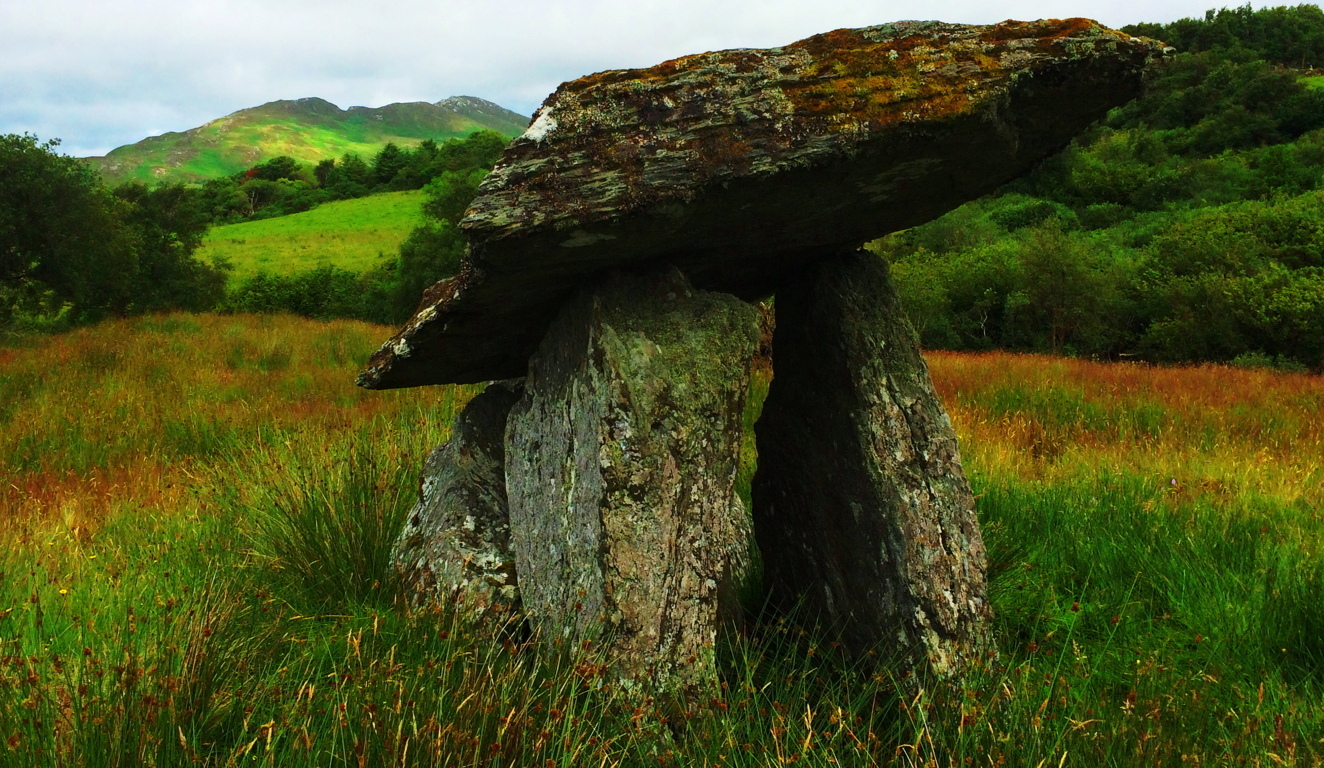 far to the north, with a massive but slim capstone and similar supporting stones. Other Dolmen’s in various Celtic regions abroad sponsor much larger megalithic features, as well as different styles. This Dolmen can be found just off the R480 road, which is a classic country-drive with tunnels of tight green hedges. Be prepared. The best regulated hiking trail of the area is, without any doubt, the Cliffs of Moher. A Medieval tower sits at the northerly edge of the excellent trails that run along the dramatic Atlantic cliff, which drops over 700 feet below. These trails run for about 6 miles along the ledge, so it is just over a half day of hiking if you so choose.
far to the north, with a massive but slim capstone and similar supporting stones. Other Dolmen’s in various Celtic regions abroad sponsor much larger megalithic features, as well as different styles. This Dolmen can be found just off the R480 road, which is a classic country-drive with tunnels of tight green hedges. Be prepared. The best regulated hiking trail of the area is, without any doubt, the Cliffs of Moher. A Medieval tower sits at the northerly edge of the excellent trails that run along the dramatic Atlantic cliff, which drops over 700 feet below. These trails run for about 6 miles along the ledge, so it is just over a half day of hiking if you so choose.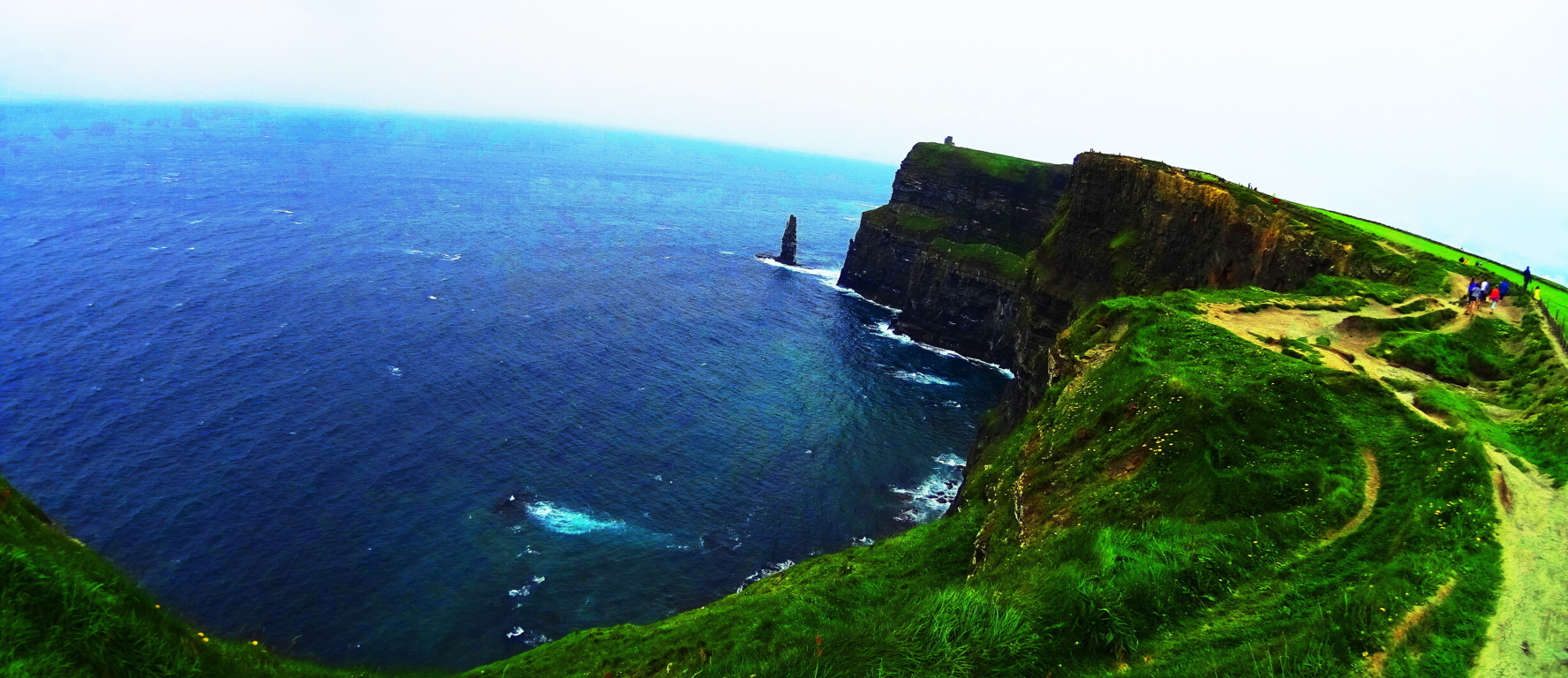 The coastal view and the towns to the south are epic in this area, so take your time on a fairly level trek. All throughout the country side are thatched cottages and ancient abbeys. Perhaps just as haunting as these ancient places are some of the abandoned cottages of families that could not ride-out The Famine, along the country roads.
The coastal view and the towns to the south are epic in this area, so take your time on a fairly level trek. All throughout the country side are thatched cottages and ancient abbeys. Perhaps just as haunting as these ancient places are some of the abandoned cottages of families that could not ride-out The Famine, along the country roads.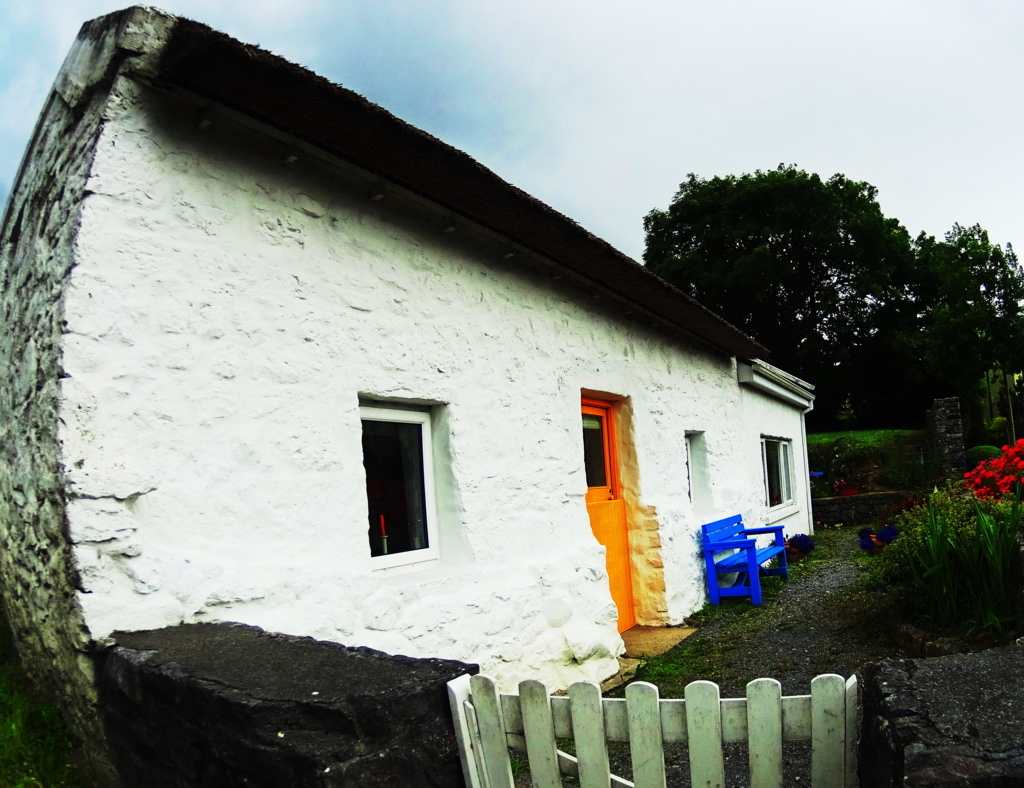
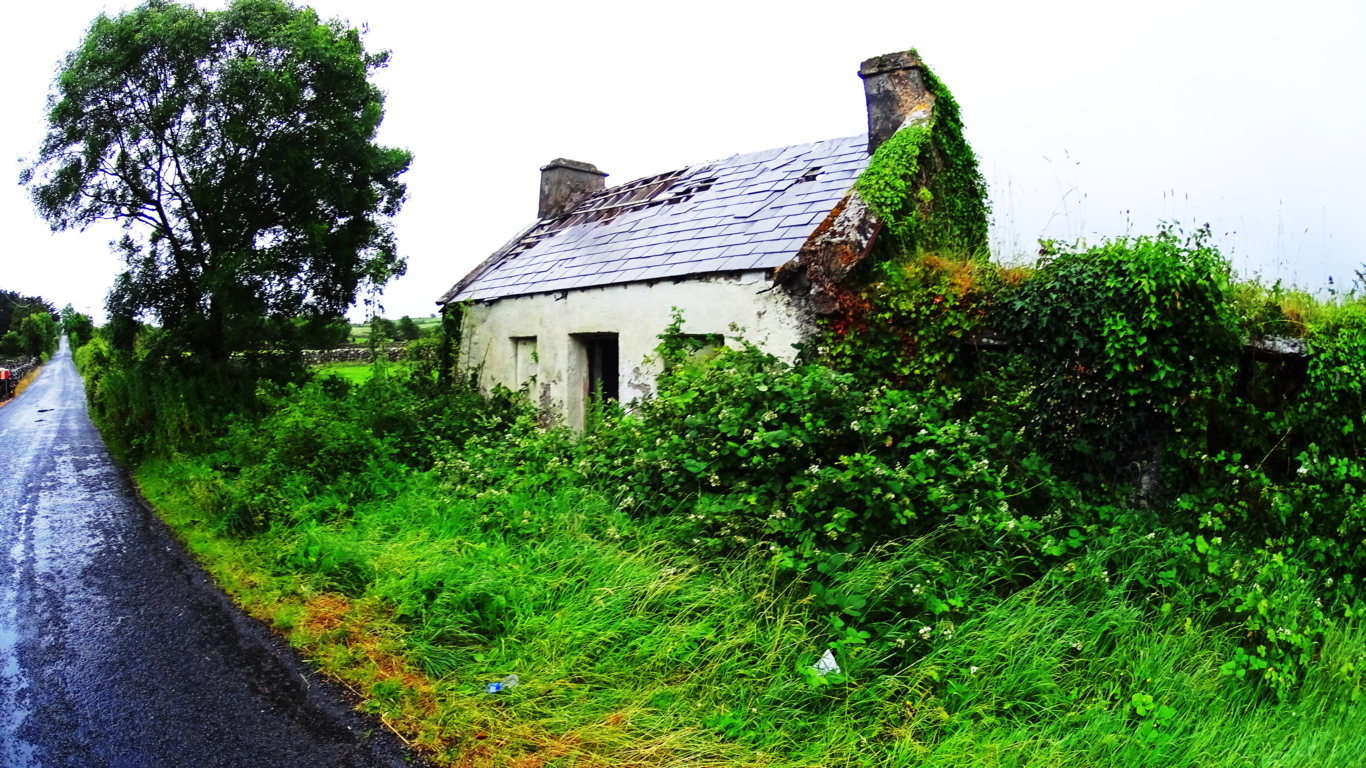 This is a place where hikers and photographers should spend more than a few days. The Burren has that “beyond time” capability to make a traveler forget about the outside world. Legendary author J.R.R Tolkien lived in, and utilized, this landscape at times, along with places in Wales and England, for the inspiration of the descriptions of the magical Shire of his stories. Amazingly, after all this wonder, it is yet, and still, simply a region. This is perhaps the best reasoning as to why seeking and finding is sometimes necessary for true adventurers, where many miles outside of the commonly ‘commercialized experience’ of domesticated parks, real indigenous surprises still exist in the regions of lessor known places.
This is a place where hikers and photographers should spend more than a few days. The Burren has that “beyond time” capability to make a traveler forget about the outside world. Legendary author J.R.R Tolkien lived in, and utilized, this landscape at times, along with places in Wales and England, for the inspiration of the descriptions of the magical Shire of his stories. Amazingly, after all this wonder, it is yet, and still, simply a region. This is perhaps the best reasoning as to why seeking and finding is sometimes necessary for true adventurers, where many miles outside of the commonly ‘commercialized experience’ of domesticated parks, real indigenous surprises still exist in the regions of lessor known places.
